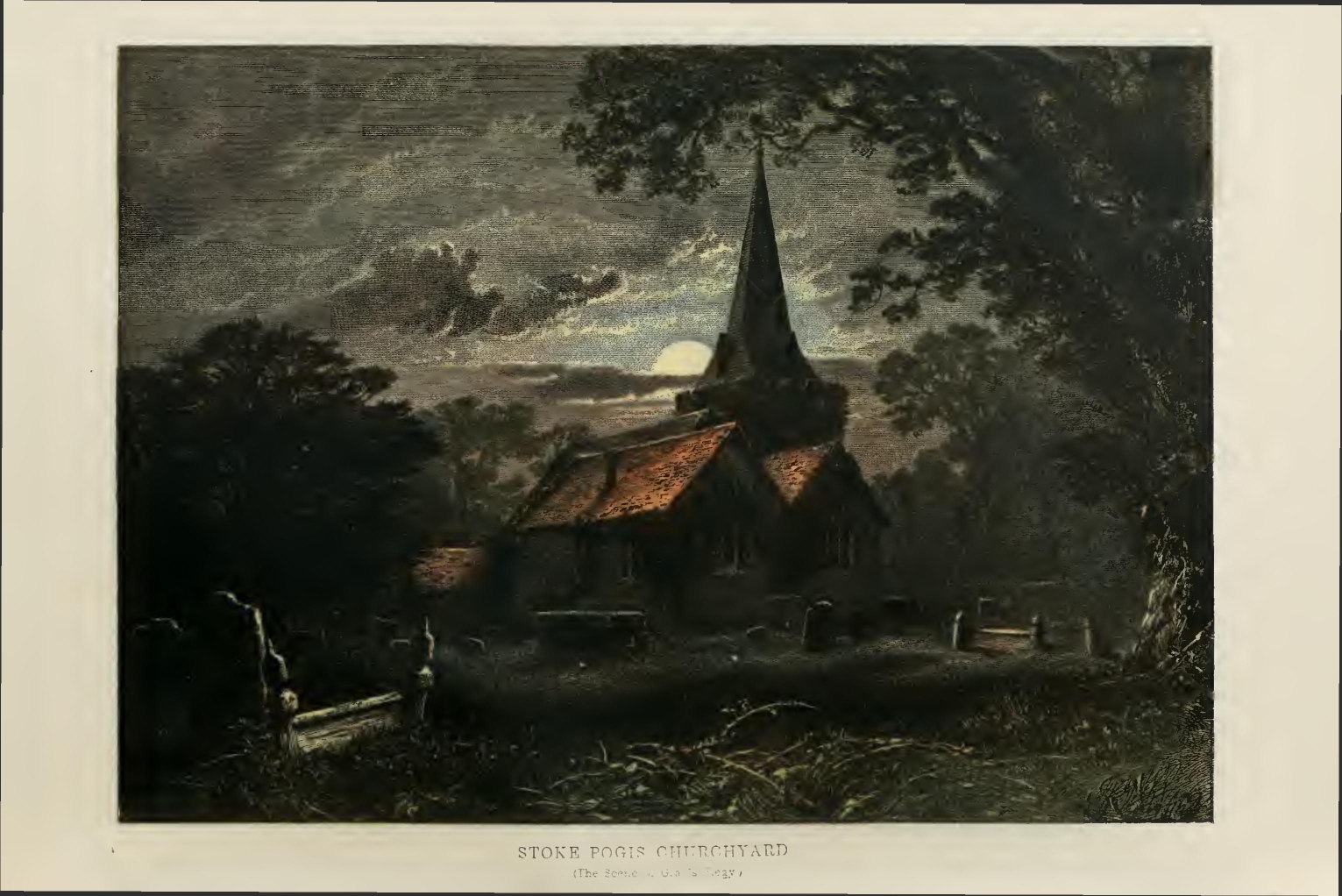
Project Gutenberg's English Pictures, by Samuel Manning and S. G. Green
This eBook is for the use of anyone anywhere at no cost and with
almost no restrictions whatsoever. You may copy it, give it away or
re-use it under the terms of the Project Gutenberg License included
with this eBook or online at www.gutenberg.org
Title: English Pictures
Author: Samuel Manning
S. G. Green
Release Date: March 7, 2014 [EBook #45065]
Language: English
Character set encoding: ISO-8859-1
*** START OF THIS PROJECT GUTENBERG EBOOK ENGLISH PICTURES ***
Produced by David Widger from page images generously
provided by The Internet Archive

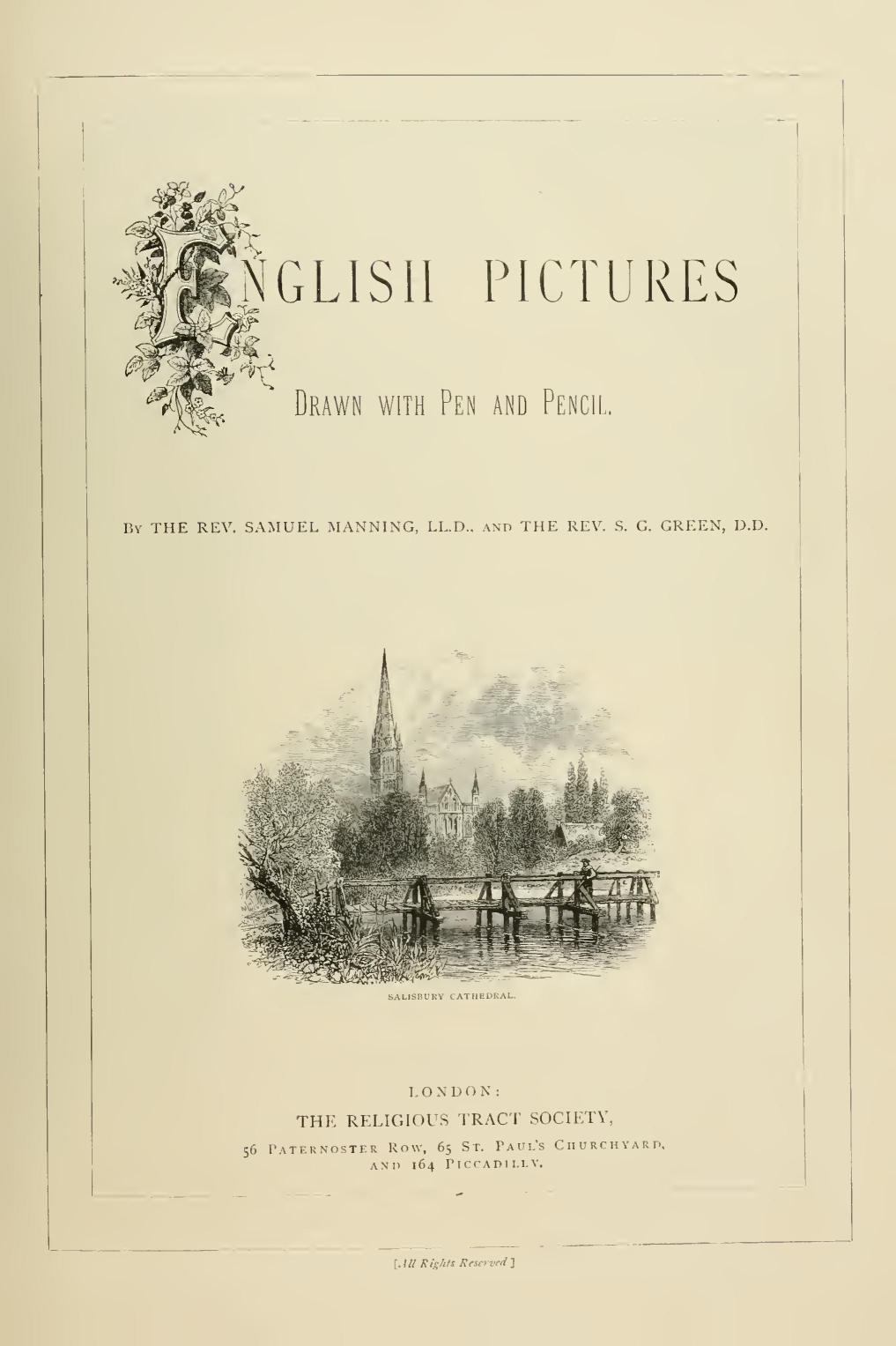
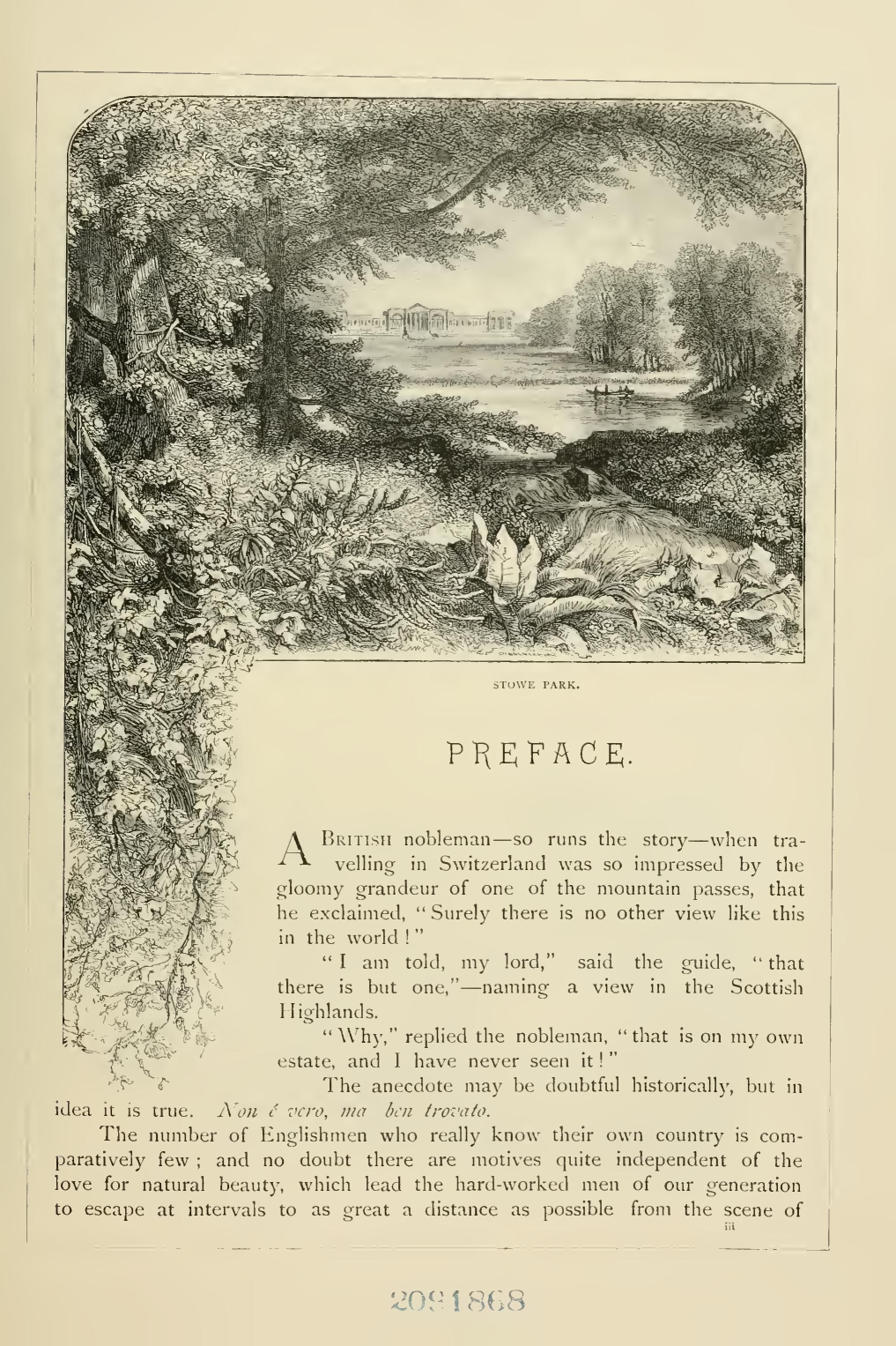
CONTENTS
THE COUNTRY OF BUNYAN AND COWPER.
ROUND ABOUT SOME INDUSTRIAL, CENTRES.
A British nobleman—so runs the story—when travelling in Switzerland was so impressed by the gloomy grandeur of one of the mountain passes, that he exclaimed, "Surely there is no other view like this in the world!"
"I am told, my lord," said the guide, "that there is but one,"—naming a view in the Scottish I lighlands.
"Why," replied the nobleman, "that is on my own estate, and I have never seen it!"
The anecdote may be doubtful historically, but in idea it is true. Non é vero, ma ben trovato.
The number of Englishmen who really know their own country is comparatively few; and no doubt there are motives quite independent of the love for natural beauty, which lead the hard-worked men of our generation to escape at intervals to as great a distance as possible from the scene of their daily occupations. The effort for this, however, often leads to yet more harassing distractions; and many return from the eager excitements of foreign travel more jaded and careworn than when they began their journey. Nor is it so easy to escape after all! The great event of the day at every Continental hotel is the arrival of The Times; and you are at least as likely to meet your next neighbour on a Rhine steamboat or at the Rigi Kulm, as in the valley of the Upper Thames, or at Boscastle or Tintagel.
It is true that our rivers do not flow from glaciers, and our proudest mountain heights may easily be scaled in an afternoon; we have no gloomy grandeur of pine forests or stupendous background of snowy peaks; but there is beauty, and sublimity too, for those who know "how to observe" the earth, and sea, and sky: and in less than a day's journey, the tired dweller in cities may find many a sequestered retreat, where pure air and lovely scenery will bring to his spirit a refreshment all the more welcome because associated with the language, the habits, and the religion of his own home.
The volume now in the reader's hand is intended to recall, by the aid of pen and pencil, some English scenes in which such refreshing influences have in the past been enjoyed. And, as every wanderer over English ground finds himself in the footsteps of the great and good, ample use has been made of the biographical and literary associations which these scenes continually recall.
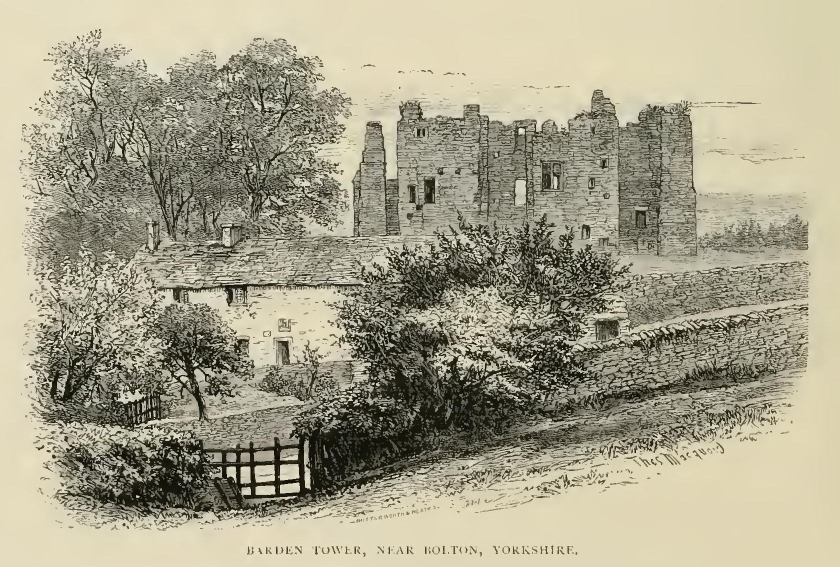
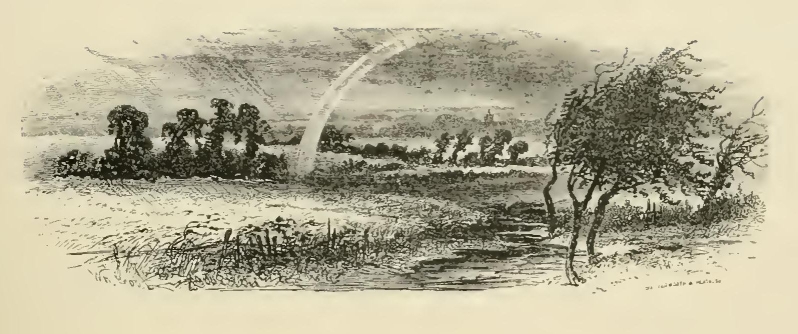
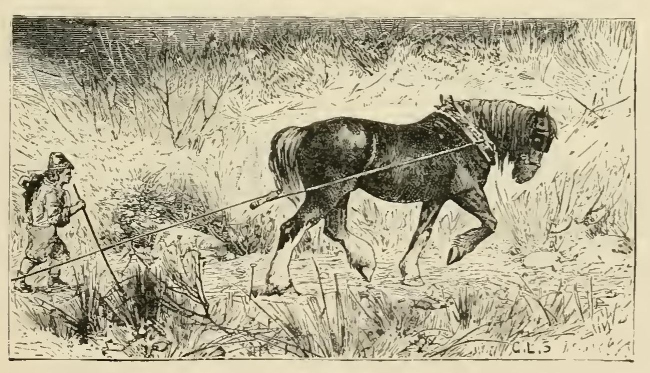
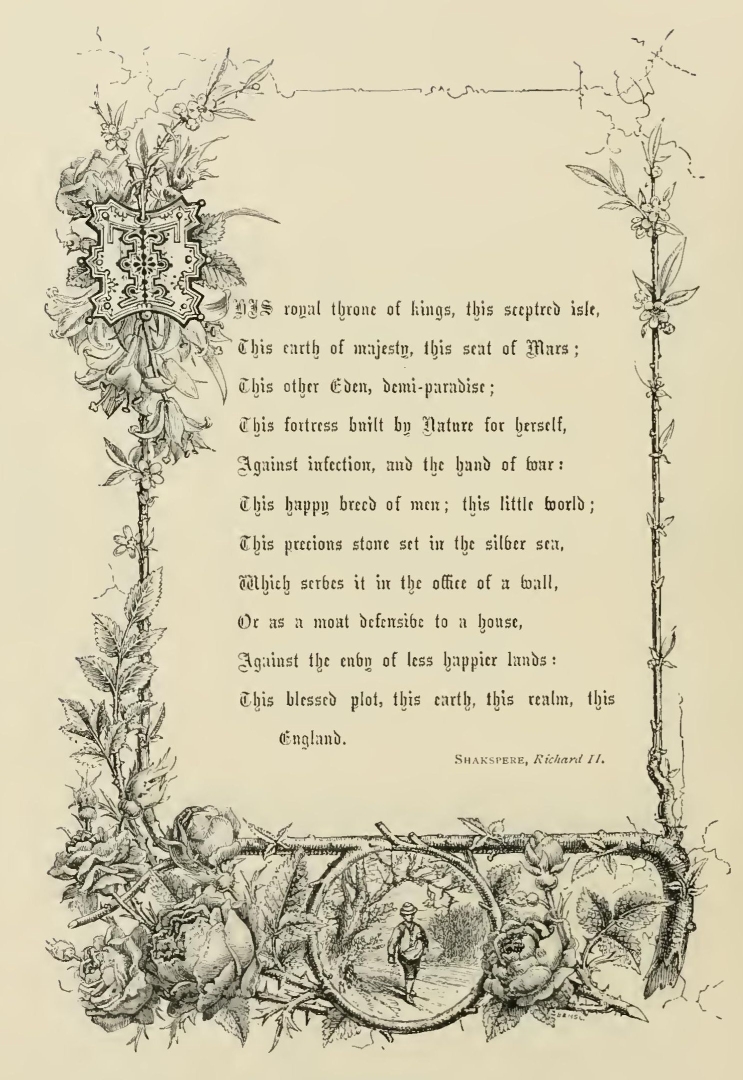
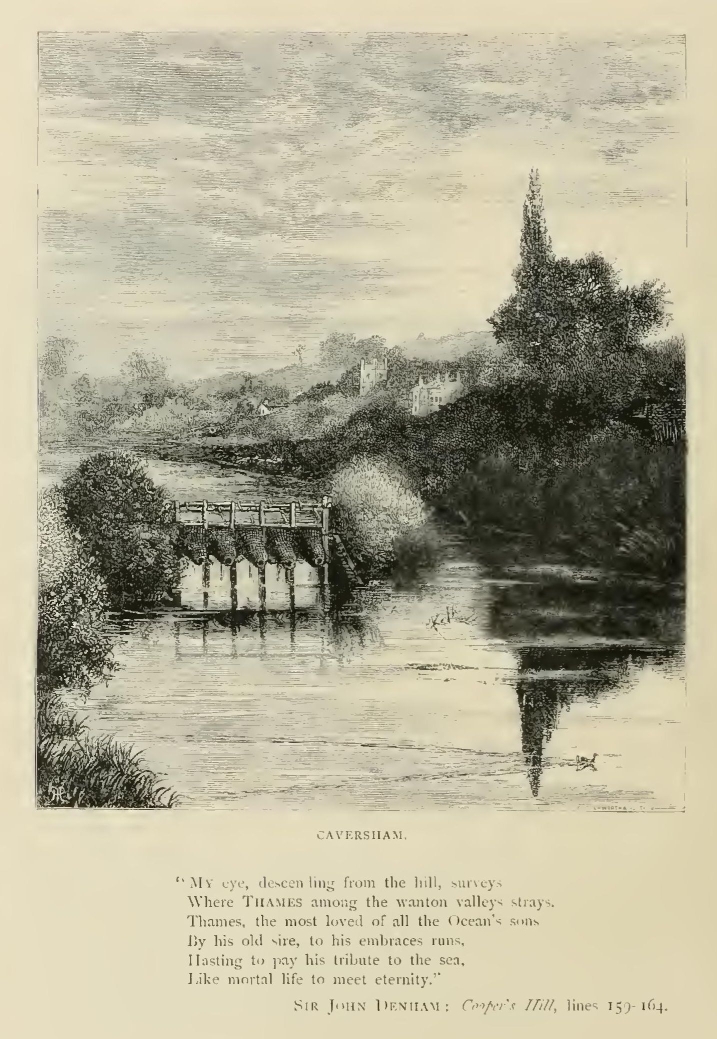
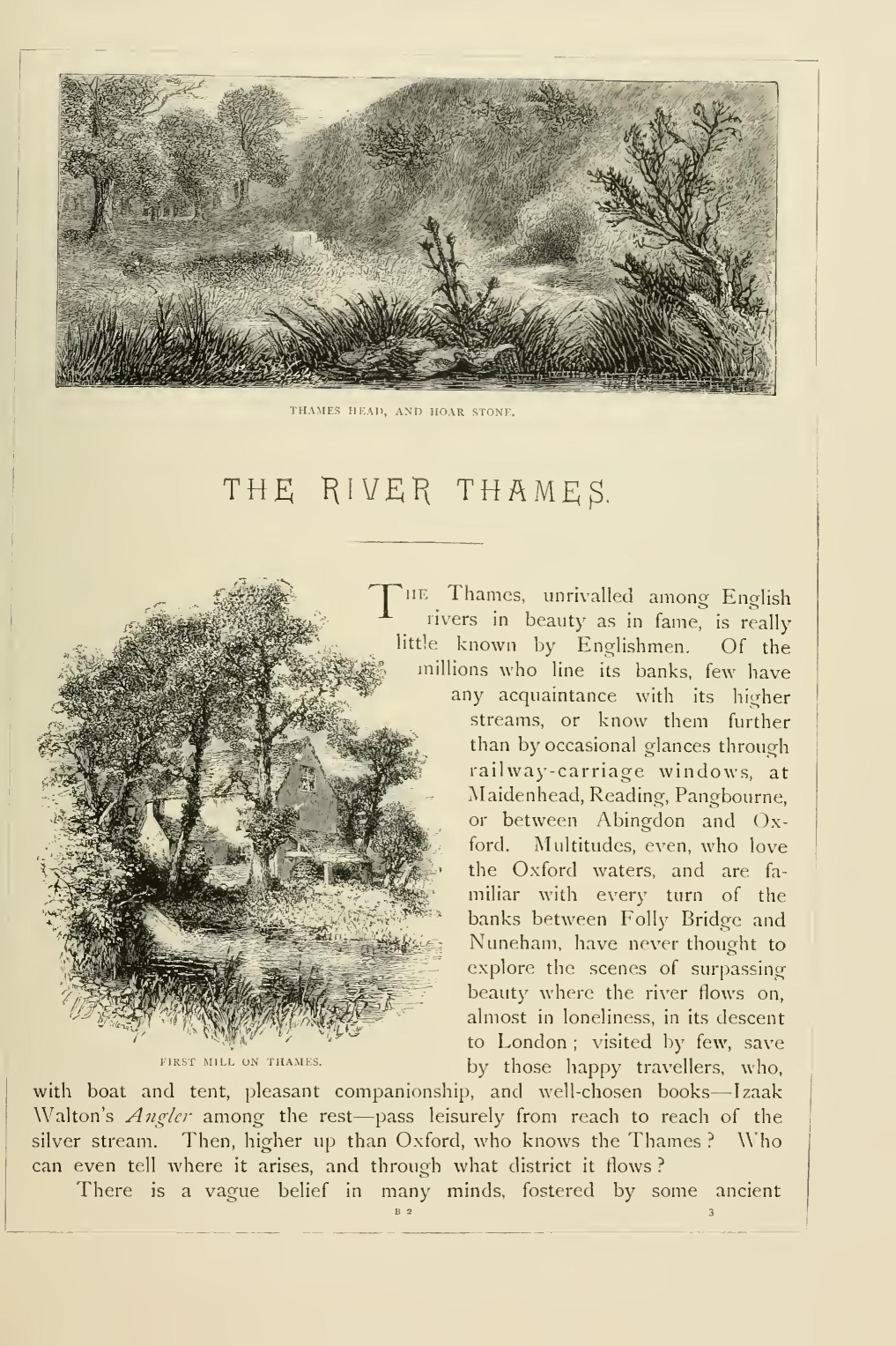
THE Thames, unrivalled among English rivers in beauty as in fame, is really little known by Englishmen. Of the millions who line its banks, few have any acquaintance with its higher streams, or know them further than by occasional glances through rail way-carriage windows, at Maidenhead, Reading, Pangbourne, or between Abingdon and Oxford. Multitudes, even, who love the Oxford waters, and are familiar with every turn of the banks between Folly Bridge and Nuneham, have never thought to explore the scenes of surpassing beauty where the river flows on, almost in loneliness, in its descent to London; visited by few, save by those happy travellers, who, with boat and tent, pleasant companionship, and well-chosen books—Izaak Walton's Angler among the rest—pass leisurely from reach to reach of the silver stream. Then, higher up than Oxford, who knows the Thames? Who can even tell where it arises, and through what district it flows?
There is a vague belief in many minds, fostered by some ancient manuals of geography, that the Thames is originally the Isis, so called until it receives the river Thame, the auspicious union being denoted by the pluralising of the latter word. The whole account is pure invention. No doubt the great river does receive the Thame or Tame, near Wallingford; but a Tame is also tributary to the Trent; and there is a Teme among the affluents of the Severn. The truth appears to be that Teme, Tame, or Thame, is an old Keltic word meaning "smooth," or "broad;" and that Tamesis, of which Thames is merely a contraction, is formed by the addition to this root of the old "Es," water, so familiar to us in "Ouse," * "Esk," "Uiske," "Exe," so that Tam-es means simply the "broad water," and is Latinised into Tamesis. The last two syllables again of this word are fancifully changed into Isis, which is thus taken as a poetic appellation of the river. In point of fact, Isis is used only by the poets, or by those who affect poetic diction. Thus, Warton, in his address to Oxford:
"Lo, your loved Isis, from the bordering vale,
With all a mother's fondness bids you hail."
The name, then, of the Thames is singular, not plural; while yet the river is formed of many confluent streams descending from the Cotswold Hills. Which is the actual source is perhaps a question of words; and yet it is one as keenly contended, and by as many competing localities, as the birthplace of Homer was of old. Of the seven, however, only two can show a plausible case. The traditional Thames Head is in Trewsbury Mead, three miles from Cirencester, not far from the Tetbury Road Station, on the Great Western Railway, and hard by the old Roman road of Akeman Street, one of the four ** that radiate from Cirencester, or, as the Romans called the city, Corinium. Here the infant stream is at once pressed into service, its waters being pumped up into the Thames and Severn Canal, whose high embankment forms the back-ground to the wooded nook which forms the cradle of the river. It is an impressive comment on the reported saying of Brindley the engineer, that "the great use of rivers is to feed canals." Half-a-mile farther down, and when clear of the great pumping-engine, the baby river issues again to light in a secluded dell, and now has room to wander at its own sweet will. The cut on the preceding page delineates its early course, and shows "the Hoar Stone," an ancient boundary, mentioned in a charter of King Ćthelstan, a.d. 931.
The river now receives a succession of tiny rivulets, which augment its volume and force until, near the village of Kemble, it is crossed by a rustic bridge,—"the first bridge over the Thames," as depicted for us in the charming volume of Mr. and Mrs. S. C. Hall, with its three narrow arches, and its sides undefended by a parapet, with the solitary figures of the labourer and his boy, wending their way home after work.
* "The Ouse, whom men do Isis rightly name."—Spenser,
Faerie Queen.
** The other three were the Fossway, or "entrenched road,"
running to the north-east, the Ikenild Street or "road to
the Iceni," nearly due east, and Ermine or Irmin Street,
passing through Cirencester, north-west to Gloucester, and
south-east to Silchester. Akeman Street is a continuance of
the Fossway, and runs south-west to Bath. Its name probably
means, "Oak-man," or Forester.
What a contrast with the last bridge that spans the river, with its mighty sweep of traffic below and above!
But we must dally yet among scenes of rural quietude. A few miles beyond Kemble, the Thames has acquired force sufficient to turn a mill. Hence, leaving the highway, and taking our path through pleasant meadows, we pass by one or two rural villages, and so to Cricklade, the first market-town on the Thames. And here a considerable affluent joins the stream—a river, in fact, that has come down from another part of the Cotswold Hills, with some show of right to be the original stream.
This is the Churn (or Corin; Keltic "The Summit"), which rises at "the Seven Springs," in a rocky hill-side, about three miles from Cheltenham, and runs by Cirencester (Corin-cester) down to Cricklade. I he claim of the Churn is the twofold one, of greater height in its source than the traditional meadows and beside quiet villages: much, to say the truth, like other rivers, or distinguished only by the transparency of its gentle stream. For, issuing from a broad surface of oolite rock, it has brought no mountain débris or dull clay to sully its brightness, no town defilement, nor trace of higher rapids, in turbid waves and hurrying foam. It lingers amid quiet beauties, scarcely veiling from sight the rich herbarium which it fosters in its bed, save where the shadows of trees reflected in the calm water mingle confusedly with the forms of aquatic plants. Meanwhile other streams swell the current. As an unknown poet somewhat loftily sings:
"From various springs divided waters glide,
In different colours roll a different tide;
Murmur along their crooked banks awhile:—
At once they murmur, and enrich the isle,
Awhile distinct, through many channels run,
But meet at last, and sweetly flow in one;
There joy to lose their long distinguished names,
And make one glorious and immortal Thames."
Of the little streams thus loftily described, the most important are the Coln and the Leche; as Drayton has it in his Polyolbion:
"Clere Coin and lovely Leche, so dun from Cotswold's plain."
The confluence of these streams with the Thames at Lechlade makes the river navigable for barges; and from this point it sets up a towingpath. At this point also end may be seen—a distant glimmering circle—from the other. Then the canal pursues a level course for some miles, and descends about 130 feet to the Thames at Lechlade, having traversed in all a distance of rather more than thirty miles.
Below Lechlade the river passes into almost perfect solitude. Few walks in England of the same distance are at once so quietly interesting and so utterly lonely as the walk along the grassy towing-path of the Thames. A constant water-traffic was once maintained between London and Bristol by way of Lechlade and the canal; but this is now superseded by the railway, and the sight of a passing barge is rare.
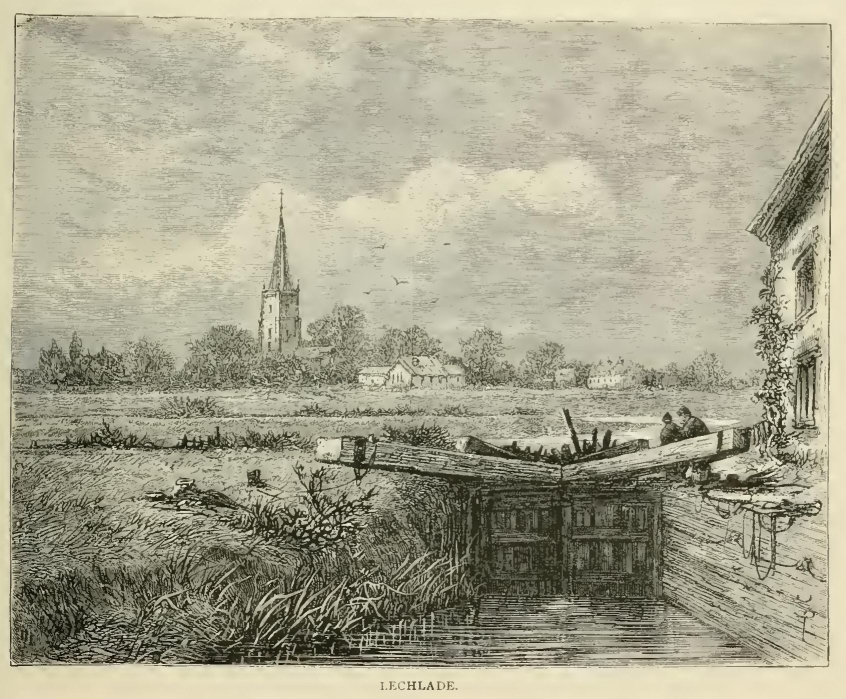
The river after leaving Gloucestershire divides, in many a winding, the counties of Oxford and Berks. The hills of the latter county, with their wood-crowned summits, pleasantly bound the view to the south; Farringdon Hill being for a long distance conspicuous among them. Half-way between Lechlade and Oxford is the hamlet of Siford, or Shifford—one of the great historic spots of England, if rightly considered, although now isolated and unknown. For there, as an ancient chronicler commemorates, King Alfred the Great held Parliament a thousand years ago.
"There sat at Siford many thanes and many bishops,
Learned men, proud earls and awful knights,
There was Karl Ćlfric, learned in the law,
And Ćlfred, England's herdsman, England's darling,
He was King in England.
He began to teach them how they should live."
Not far off is New Bridge, the oldest probably on the Thames. But it was "new" six hundred years ago. Its solid construction shows that it was once a great highway; while its buttresses, pointed up the stream, betoken the power of the floods which the careful draining of later days has done so much to moderate.
A short distance farther, the Windrush flows down from the north, by Bourton-"on-the-water," Burford and Witney, to unite with the broadening river; then the Evenlode, which the traveller by the Oxford, Worcester, and Wolverhampton Railway so often crosses and recrosses in his journey.
Throughout, the river is carefully adapted for the purposes of a navigation now little needed. The occasional locks and the frequent weirs break the level, and the latter especially—sometimes miniature rapids or waterfalls—add picturesqueness to the scene. An expert oarsman may descend them all with safety; but many prefer to lift the boat on to the bank and drag it down to the lower level. These are interruptions to the journey, which, on the whole, is very enjoyable. Should the tourist have time at command, he may diverge to the right hand or to the left, to scenes of rich beauty or historic interest. Cumnor Hall, a name familiar to all readers of Sir Walter Scott from the tragic fate of Amy Robsart, lies a little way to the right of Bablock Hythe Ferry; Stanton Harcourt a short distance to the left. At the latter place Alexander Pope once resided, in a tower of the old mansion, which time or reverence has spared, in the ruin of almost all the rest. A pane of glass, in one of the tower windows, bore an inscription from the poet's own hand. "In the year 1718, Alexander Pope finished here the Fifth Volume of Homer." The pane is now at Nuneham Courtney, the mansion of the Harcourts. At Bablock Hythe Ferry the traveller is scarcely four miles from Oxford by the direct road; but if he keep to his boat, which he will not regret, he will find the distance fully twelve. The detour leads him first past the lovely wooded slopes and glades of Wytham Abbey, then to the scanty ruins of Godstow Nunnery, with its memories of Fair Rosamond. But we must not linger now, though opposite to the ruins a charming country hostelry offers its attractions, and the trout are leaping in the stream; for we are on our way to Oxford.
The impression which the first sight of this fair and ancient city makes upon the stranger is probably unique, in whatever direction he first approaches it, and from whatever point he first descries its spires and towers. True, of late years the accessories of the railway invasion, so long resisted by the University authorities, have given a new aspect to the scene; but nothing can quite destroy the stately dignity and venerable calm. The traveller who approaches by the way we are describing, receives the full impression. As he floats along the quiet surface of the river, the stately domes and towers come suddenly in sight, and the green railway embankment in the foreground scarcely impairs the antique beauty of the picture.
Oxford is probably Ousenford—the ford over the Ouse or "Water." Its waters indeed are many, and almost labyrinthine; but we get clear of the river at Hythe Bridge, and care for awhile only to explore Colleges, Halls, and Libraries; pausing before the Martyrs' Memorial, to breathe the hope that "the candle" once lighted there may still brightly burn, while Keble College, farther on, is a memorial of one, who though of another school of thought from ourselves, has given musical and touching expressions tu the deepest thoughts of devout hearts.
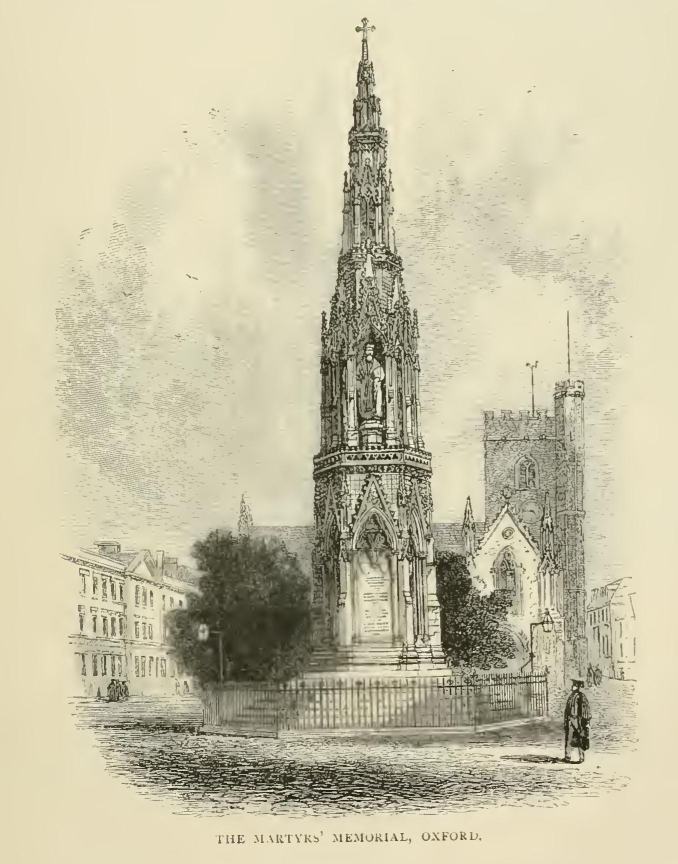
But to describe this wonderful city is beyond our present scope. Let us hurry down to Christ Church Meadows, where the Cherwell sweeps round to join the Thames; then across to the Broad Walk, past Merton Meadow and the Botanical Gardens, to Magdalen Bridge, where a splendid view of the city is again obtained; thence up High Street to the centre of the city, and down St. Aldate's Street to Folly Bridge, where boats of all sizes are in waiting. This bridge may appear strangely named, as a main approach to the renowned seat of learning.
Various stories are told as to the origin of the name. Perhaps it may be from some tradition of Roger Bacon, who had his study and laboratory here, over the ancient gate. There was a saying, that this study would fall when a man more learned than Bacon passed under it; so that the name may be an uncomplimentary reference to the troops of students entering Oxford by this thoroughfare. But such speculations need nut hinder us. We are bound for London—a voyage of some 115 miles, though only 52 by rail. Many boatmen will prefer to take the train for Goring, saving six-and-twenty miles of water travelling, and avoiding the most tedious and on the whole least picturesque part of the journey. Still, in any case Nuneham must be seen, with Iffley Lock and Sandford Lasher—familiar names to boating men!—upon the way.
Nuneham is a charming domain, scene of picnic parties innumerable, yet freshly beautiful to every visitor who can enjoy woodland walks and verdant slopes, with gardens planned by Mason the poet, in which art and taste have, as it were, only improved upon the hints and suggestions of nature; and breezy heights from which the prospect, if less extensive than some other far-famed English views, may surely vie in loveliness with any of them.
The intending visitor must be careful to ascertain the days and conditions of access to the grounds; and in his ramble must be sure to include the old "Carfax" conduit, removed in 1787 from the "four ways" (for the "Car" is evidently quatre, whatever the "fax" may be) in Oxford, and set on a commanding eminence, the distant spires and towers of the city, with Blenheim Woods in the back-ground, being seen in one direction, and the view in another bounded by the line of the Chiltern Hills.
When the oarsman has once left behind the wooded slopes of Nuneham, with the overhanging trees reflected in the silvery waters, he will find the way to Abingdon monotonous. He will perhaps be startled by seeing picnic parties in large boats, towed from the shore by stalwart peasants, harnessed to the rope. Let us hope that the toil is easier than it looks! On the whole, we do not recommend the long détour by Abingdon, although Clifton Hampden is charming, and Dorchester, near the junction of the Thame and the Thames—once a Roman camp, afterwards the see of the first Bishop of Wessex, but now a poor village—is well worth a visit. It is startling to find a minster in a hamlet.
Probably, however, the antiquarian may be more interested in the remains of the Whittenham earthworks, which in British or Saxon times defended the meeting-point of the rivers. The Thame Hows in on the left.
On the hill to the right is Sinodun, a remarkably fine British camp. The whole neighbourhood, so still and peaceful now, tells of bygone greatness, and of many a struggle of which the records have vanished from the page of history. Not far, however, from Dorchester in another direction is Chalgrove Field, where the brave and patriotic Hampden received his death-wound. His name, and that of Falkland, to be noticed farther on, awaken in these scenes now so tranquil the remembrance of the stormy times when, in this Thames Valley, were waged those conflicts out of which in so large a measure sprang the freedom and progress of modern England.
At Dorchester we are still eleven miles by water from Goring; and though the angler may loiter down the stream, we must hasten on, though ancient Wallingford and rustic Cleeve are not unworthy of notice. At Goring the chief beauties of the river begin to disclose themselves.
Ralph Waldo Emerson says of the English landscape, that "it seems to be finished with the pencil instead of the plough." Our fields are cultivated like gardens. Neat, trim hedgerows, picturesque villages, spires peeping from among groves of trees, cottages gay with flowers and evergreens, suggest that the landscape gardener rather than the agriculturist has been everywhere at work. If this be true of England as a whole, it is yet more strikingly true of the district through which we are about to pass. A thousand years of peaceful industry have subdued the wildness of nature; and the river glides between banks radiant with beauty: "The little hills rejoice on every side; the pastures are clothed with Hocks, the valleys are covered over with corn; they shout for joy, they also sing."
Yet there is no lack of variety. The course of the river is broken up by innumerable "aits" ("eyots"), or little islands; some covered with trees which dip their branches into the stream, others with reeds and osier, the haunts of wild fowl; on others, again, a cottage or a summer-house peeps out from amongst the foliage. Sometimes these aits seem to block up the channel, and leave no exit, so that the boat seems to be afloat on a tiny lake, till a stroke or two of the oar discloses a narrow passage into the stream beyond. Sometimes a line of chalk down bounds the view, its delicately curved sides dotted over with juniper bushes, the dark green of which contrasts finely with the light grey of the turf. Then comes a range of hanging beech-wood coming down to the water's edge, or a broad expanse of meadow, where the cattle wade knee-deep in grass, or a mansion whose grounds have been transformed into a paradise by lavish expenditure and fine taste, or a village, the rustic beauty of which might realise the dreams of poet or of painter. The locks, mill-dams, or weirs with their dashing waters, give animation to the scene. Nor is that additional charm often wanting, of which Dr. Johnson used to speak. "The finest landscape in the world," he would say, "is improved by a good inn in the foreground." True, there are no great hotels, after the modern fashion; but a series of comfortable homely village inns will be found, such as Izaak Walton loved, and which are still favourite haunts with the brethren of "the gentle craft." The landlord, learned in all anglers' lore, is delighted to show where the big pike lies in a sedgy pool, where the perch will bite most freely, or to suggest the most killing fly to cast for trout over the mill-pond; and is not too proud, when the day's task is done, to wait upon the oarsman or the angler at his evening meal.
* As we write, the following letter to the Times arrests our
attention; it is too graphic, as well as accurate, to be
lost:—
"I will not tell you where I am, except that I am staying at
an hotel on the banks of the River Thames. I hesitate to
name the place, charming as it is, because I am sure, when
its beauties are known, it will be hopelessly vulgarised.
Mine host, the pleasantest of landlords, his wife, the most
agreeable of her sex, will charge, too, in proportion as the
plutocracy invade us. I am surrounded by the most charming
scenery. Few know, and still fewer appreciate the beauties
of our own River Thames. I have been up and down the Rhine;
but I confess, taking all in all, Oxford to Gravesend
pleases me more. Herc, in addition to what I have described,
I am on the river's brink; I can row about to my heart's
content for a very moderate figure; excellent fishing;
newspapers to be procured, and postal arrangements of a
character not to worry you, and yet sufficient to keep you
au fait with your business arrangements. What do I want
more? Prices are moderate, the village contains houses
suitable to all clashes, and the inhabitants are pleased to
see you. I can wear flannels without being stared at, and I
can see the opposite sex, in the most bewitching and
fascinating of costumes, rowing about (with satisfaction,
too) the so-called lords of creation. As for children, there
is no end of amusement for them—dabbling in the water,
feeding the swans, the fields, and the safety of a punt. We
have both aristocratic and well-to-do people here—names
well known in town; but I must not, nor will I, betray them.
On the towing-path this morning was to be seen the smartest
of our Judges in a straw hat and a tourist suit, equally
becoming to him as it was well cut.
"Let me advise all your readers who are hesitating where to
go not to overlook the natural beauties of our River Thames.
There are one or two steamers that make the journey up and
down the river in three days, stopping at various places,
and giving ample opportunity for passengers both to see and
appreciate the scenery.
"E. C. W."
To describe in detail all the points of beauty that lie before us, would require far more space than we have at disposal; and a dry catalogue of names would interest no one. We have started, as said before, from Goring, where the twin village Streatley—bearing in its name a reminiscence of the old Roman road Ikenild Street,—nestles at the foot of its romantic wooded hill. The comfort of the little hostelry and the charm of the scenery invite a longer stay, but we must press on. Pangbourne and Whitchurch, also twin villages, joined by a pretty wooden bridge, once more invite delay. On the right, the little river Pang flows in between green hills; on the left, or the Whitchurch side, heights clothed with the richest foliage shut in the scene. The cottages are embosomed amid the trees; the clear river catches a thousand reflections from hillside, and sky; the waters of the weir dash merrily down; and the fishermen, each in his punt moored near mid-stream, yielding themselves to the tranquil delight of the perfect scene, are further gladdened by many an encouraging nibble. Surely of all amusements the most restful is fishing from a punt! Most persons would find a day of absolute idleness intolerable. But here we have just that measure of expectation and excitement which enable even a busy and active man to sit all day doing nothing.
Into the question of the cruelty of the sport we do not enter; but its soothing, tranquillising character cannot be denied. For ourselves, our business is not to angle, but to observe. As we row past these grave and solemn men, absorbed in the endeavour to hook a dace or gudgeon, and recognise among them one or two of the hardest workers in London, we feel, at any rate, that the familiar sneer about "a rod with a line at one end, and a fool at the other," may not be altogether just.
Passing a series of verdant lawns, sloping to the river's brink, we reach Mapledurham and Purley, on opposite sides of the river at one of its most exquisite bends. The former place is celebrated by Pope as the retreat of his ladye love Martha Blount; when
"She went to plain-work, and to purling brooks,
Old-fashioned halls, dull aunts, and croaking rooks."
The latter was the residence of Warren Hastings during his trial, and is not to be confounded with the Purley in Surrey, where Horne Tooke wrote his celebrated Diversions, on the origin and history of words.
The next halting-place is Caversham, sometimes magniloquently described as "the port of Reading." Here the Thames widens out, as shown in the view which prefaces the present chapter; the eel-traps, or "bucks," extending half across the river. On the occasion of our visit to the spot, it was our intention to stop for the night at Caversham; but as the inn was crowded and noisy, we resolved to push on to Sonning. The evening was already closing in, and before we reached our destination it had grown dark. The trees stood up solemnly against the sky, from which the twilight had not wholly departed. Their shadows fell mysteriously across the river, rendering the task of steering a difficult one.
At length the welcome lights of the village were descried through the deepening gloom; and we landed, having suffered no more serious mishap than running into an ait, which our steersman mistook for a shadow, in the endeavour to avoid a shadow which he mistook for the bank. Next morning, after a plunge into the clear cool water of the pool at the foot of Sonning Weir, a scamper round the village, a climb to the top of the tower for the magnificent view, and a hearty breakfast, we were ready for an early start, whilst the dew was yet on the grass, and the air had not lost its freshness. Here the Kennet, "for silver eels renowned," as Pope has it, flows in from the southwest, with its memories of the high-minded and chivalrous Falkland, who fell at the battle of Newbury, on the banks of this river. A little lower down the Loddon enters the Thames from the south, between Shiplake and Wargrave. The picturesque churches of these two villages were soon passed, and we entered the fine expanse of Henley Reach, famous in boat-racing annals. Here for many years the University matches were rowed before their removal to Putney. No sheet of water could be better suited to the purpose, and the change is regretted by many boating-men.
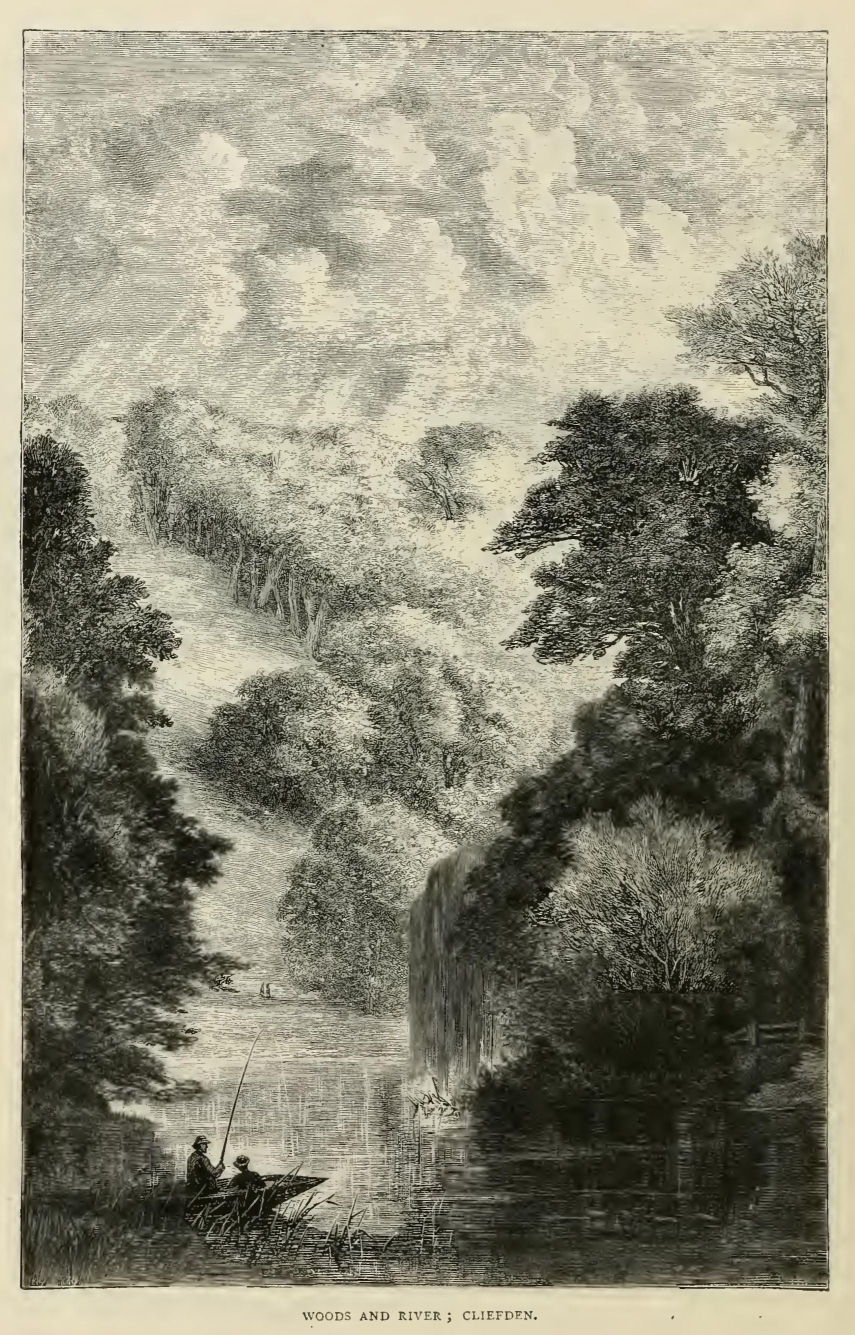
About four miles below Henley, in one of the loveliest spots on the river, are the ruins of Medmenham Abbey, notorious in the latter half of the eighteenth century, as the scene of the foul and blasphemous orgies of the "Franciscans." The club took its name from Sir Francis Dashwood, its founder, and numbered amongst its members many who were conspicuous, not only for rank and station, but for intellectual ability and political influence. Its proceedings were invested with profound secrecy; but enough was known to show that the most degrading vices were practised, and the lowest depths of wickedness reached;—strange profanation of one of Nature's loveliest shrines!
We are now approaching the point at which the beauty of the river culminates. From Marlow, past Cookham, Hedsor and Cliefden, to Maidenhead, a distance of eight or ten miles, we gladly suspend the labour of the oar, and let the boat drift slowly with the stream. As we glide along, even this gentle motion is too rapid, and we linger on the way to feast our eyes with the infinitely varied combination of chalk cliff and swelling hill and luxuriant foliage which every turn of the river brings to view:
Woods, meadows, hamlets, farms,
Spires in the vale and towers upon the hills;
The great chalk quarries glaring through the shade.
The pleasant lanes and hedgerows, and those homes
Which seemed the very dwellings of content and peace and sunshine." *
* Down Stream to London. By the Rev. S. J. Stone.
The "castled crags" of the Rhine and the Moselle,—the "blue rushing of the arrowy Rhone,"—the massive grandeur of the banks of the Danube, are far more imposing and stimulating; but the quiet, tranquil loveliness of this part of the Thames may make good its claim to take rank even with those world-famed rivers. There is something both unique and charming in the dry "combes," or fissures in the chalk ranges, rapidly descending, and garnished with sweeping foliage of untrimmed beech-trees. The branches gracefully bend down to the slope of the rising sward; while, from the steepness of the angle, the tree-tops appear from below as a succession of pinnacles against the sky. Many a roamer through distant lands has come home to give the palm for the perfection of natural beauty to the rocks and hanging woods of Cliefden. That they are within an hour's run of London does not indeed abate their claim to admiration, but may suggest the reason why they are so comparatively little known. The mansion on the height, designed by Sir Charles Barry, is now in the possession of the Duke of Westminster.
Maidenhead is on the other side of the river; Taplow opposite. The bridge between them—one of Brunei's works, will be noted for its enormous span; its elliptical brick arches being, it is said, the widest of the kind in the world. From this point, if the beauty decreases, the historical interest becomes greater at every turn. First we pass the village and church of Bray. The scenery here is of little interest; but it is impossible not to give a thought to the vicar, Symond Symonds, commemorated in song. Let it be noted, however, that the lyrist has used a poetic licence in his dates. The historian, Thomas Fuller, tells the story: "The vivacious vicar, living under King Henry VIII., Edward VI., Oueen Mary, and Oueen Elizabeth, was first a Papist, then a Protestant, then a Papist, then a Protestant again. He had seen some martyrs burnt (two miles off), at Windsor, and found this fire too hot for his tender temper. The vicar being taxed by one for being a turncoat and inconstant changeling. 'Not so,' said he, 'for I always kept my principle, which is this—to live and to die the Vicar of Bray.'" The type is but too true to human nature, and not only in matters ecclesiastical. But instead of staying to moralise, we will notice with interest that in this church is preserved an ancient copy of Fox's Book of Martyrs, chained to the reading-desk, as in the days of Oueen Elizabeth. It is better to be reminded of "the faith and patience of the saints," than of the light conviction and easy apostacy of politic "believers;" and so the old church at Bray has taught us a refreshing and unexpected lesson.
Soon the towers of Windsor are seen rising above the trees; then Eton College comes into view, with its
"distant spires, antique towers
That crown the watery glade."
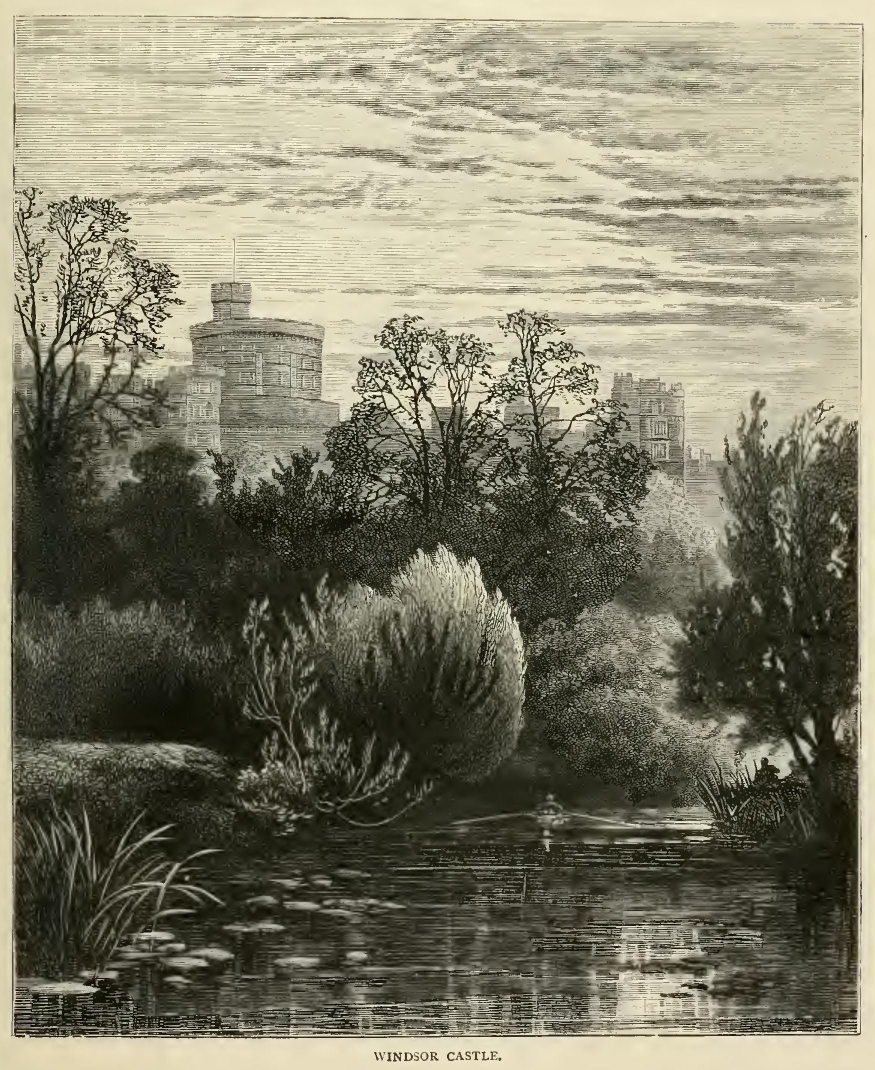
Perhaps the best view of the castle from the Thames is that from a point just beyond the Great Western Railway bridge. When the queen is absent, access is easy. St. George's Chapel, built by Edward IV., is the finest existing specimen of the architecture of that period; and the view from the North Terrace, constructed by Queen Elizabeth, is perhaps the most beautiful on the River Thames.
A little lower down, and we are passing between Runnimede ("Meadow of Council"), where the barons camped, and Magna Charta Island, where the great charter of English liberty was signed; and a temporary struggle between king and nobles laid the broad foundations of English freedom.
As we sweep round the bend beneath the broad meadow and the wooded isle, "while we muse the fire burneth,"—the ardour of grateful love to Him who has shaped the destinies of our beloved land, and has never from that hour withdrawn the trust then committed to the nation, of being the guardians and pioneers of the world's freedom. A multitude of thoughts and questionings throng in upon us, but we must not lose the opportunity of impressing on our memory the outward features of the scene. There is not much to see: if there be time to land upon the island, it will be as well to do so, and enter the pretty modern cottage there erected, containing the very stone—if tradition is to be believed—on which the Charter was laid for the royal signature.
From Runnimede, it is but an easy climb to the brow of Cooper's Hill, with its far-famed view of the river, of Windsor, and its woods. Dr. Johnson speaks of Sir John Denham's poem, of which we have taken some lines as the motto to this chapter, as "the first English specimen of local poetry." Its subject, as well as its style, will preserve it from the oblivion to which the greater number of the poet's works have descended.
Another Coin falls into the river, to the left, a little farther on—suggestive, in its name, of the Roman occupation; the "street" to the west here crossing the Thames by a bridge. "London Stone," a few hundred yards lower down, marks the entrance into Middlesex; then clean and quiet Staines——"Stones," so termed, perhaps, from the piers of the old Roman bridge, or, it may be, from the London Stone itself, comes into view: but if the traveller has time to spare, he will rather pause at Laleham, so well known to every Christian educator as the earliest scene of Arnold's labours.
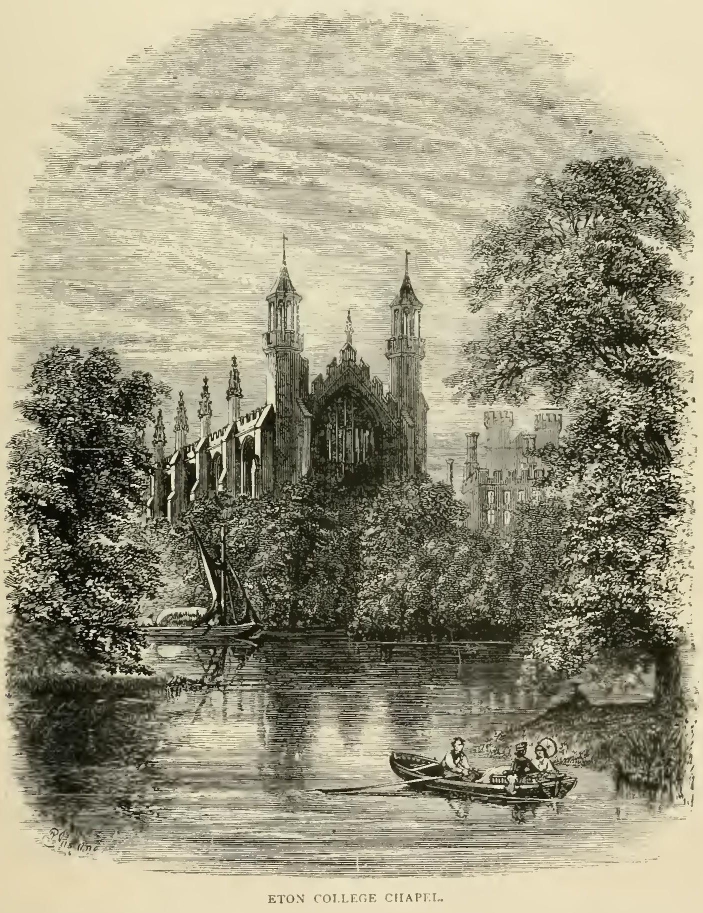
"The first reception of the tidings of his election at Rugby," we are told by his biographer, "was overclouded with deep sorrow at leaving the scene of so much happiness. Years after he had left it, he still retained his early affection for it, and till he had purchased his house in Westmoreland, he entertained a lingering hope that he might return to it in his old age, when he should have retired from Rugby. Often he would revisit it, and delighted in renewing his acquaintance with all the families of the poor whom he had known during his residence; in showing to his children his former haunts; in looking once again on his favourite views of the great plain of Middlesex—the lonely walks along the quiet banks of the Thames—the retired garden with its 'Campus Martins,' and its 'wilderness of trees;' which lay behind the house, and which had been the scenes of so many sportive games and serious conversations." *
Chertsey, on the other side of the river, is next passed, the leisurely traveller having the opportunity, if he so please, of visiting the house of Cowley the poet, or of climbing to St. Anne's Hill, once the residence of the statesman Charles James Fox.
Then, still on the right, the mouth of the Wey is seen, the pretty town of Wey-bridge not being far off. Towns and villages now multiply: the villas of city men begin to dot the banks, and the suburban railway station appears, with its hurrying morning and evening crowds. The chronicle of names now would be like the monotonous cry of the railway porter: "Shepperton; Walton; Sunbury; Hampton." But as yet we need not join with the throng. The "silent highway"—as the river has been called—is also a retreat. Still we can leisurely survey the charm, which, so long as the sky, the water, and the trees remain, no builder can efface, although he may try his best, or worst.
A bend in the river between Shepperton and Walton is of historic interest, as there Julius Cćsar with his legions forced the passage of the Thames, and routed the British General Cassivelaunus. "Cćsar led his army to the territories of Cassivelaunus, to the river Thames, which river can be crossed on foot in one place only, and that with difficulty. On arriving, he perceived that great forces of the enemy were drawn up on the opposite bank, which was moreover fortified by sharp stakes set along the margin, a similar stockade being fixed in the bed of the river, and covered by the stream. Having ascertained these facts from prisoners and deserters, Cćsar sent the cavalry in front, and ordered the legions to follow immediately. The soldiers advanced with such rapidity and impetuosity, although up to their necks in the water, that the enemy could not withstand the onset, but quitted the banks and betook themselves to flight." * The name Cowey, or Coway Stakes, to this day commemorates the event.
* Stanley's Life vol. i. p. 37. One of Arnold's Laleham
pupils, afterwards his colleague at Rugby, writes: "The most
remarkable thing which struck me at once in joining the
Laleham circle, was the wonderful healthiness of tone and
feeling which prevailed in it. Everything about me I
immediately felt to be most real; it was a place where a
new-comer at once felt that a great and earnest work was
going forward. Dr. Arnold's great power as a private tutor
resided in this, that he gave such an intense earnestness to
life. Every pupil was made to feel that there was a work for
him to do—that his happiness as well as his duty lay in
doing that work well. Hence, an indescribable zest was
communicated to a young man's feeling about life; a strange
joy came over him on discovering that he had the means of
being useful, and thus of being happy; and a deep respect
and ardent attachment sprang up towards him who had taught
him thus to value life and his own self, and his work and
mission in this world." September 23, 1872.
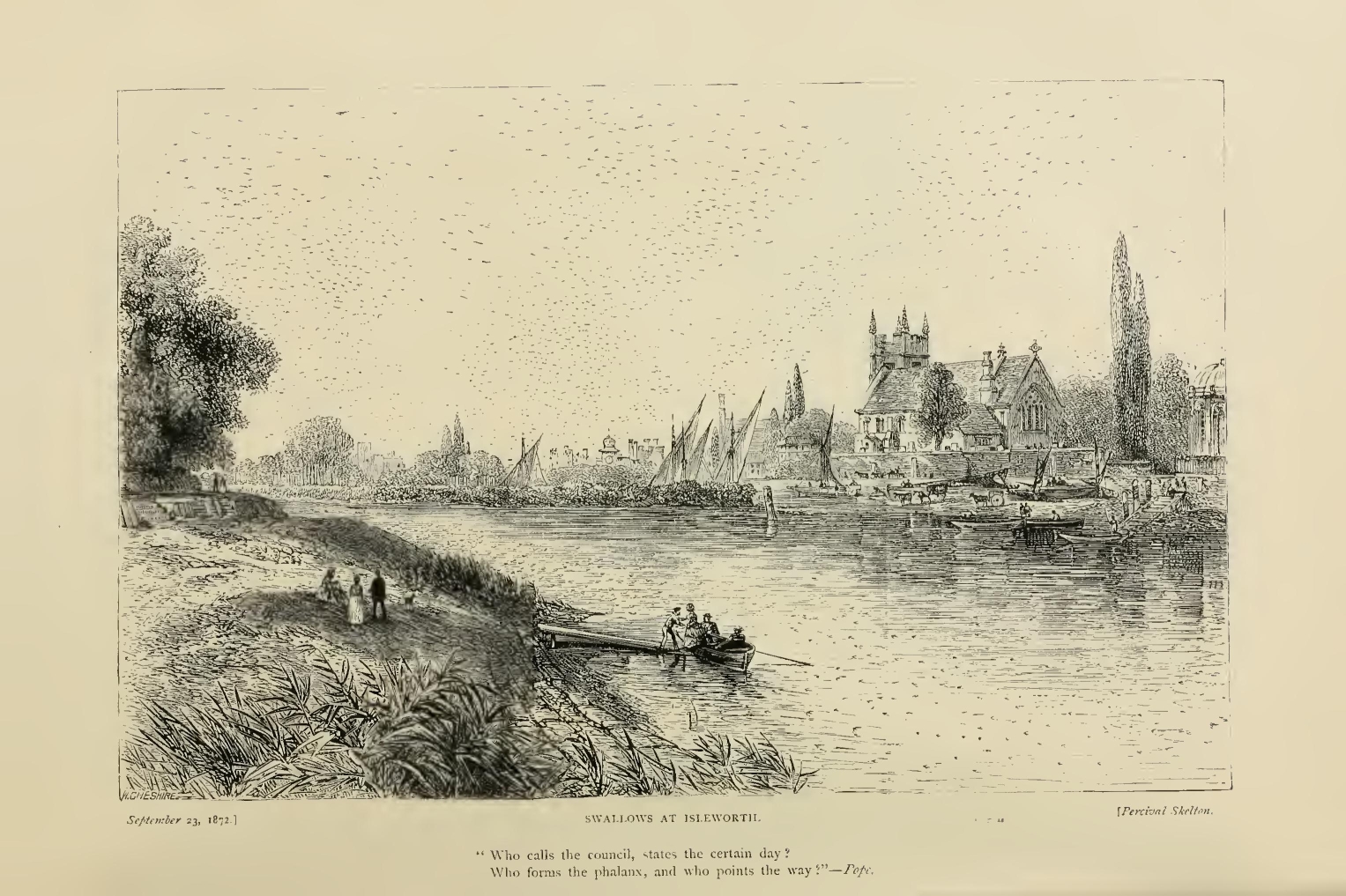
"Who calls the council, states the certain day.
Who forms the phalanx, and who points the way."—Pope
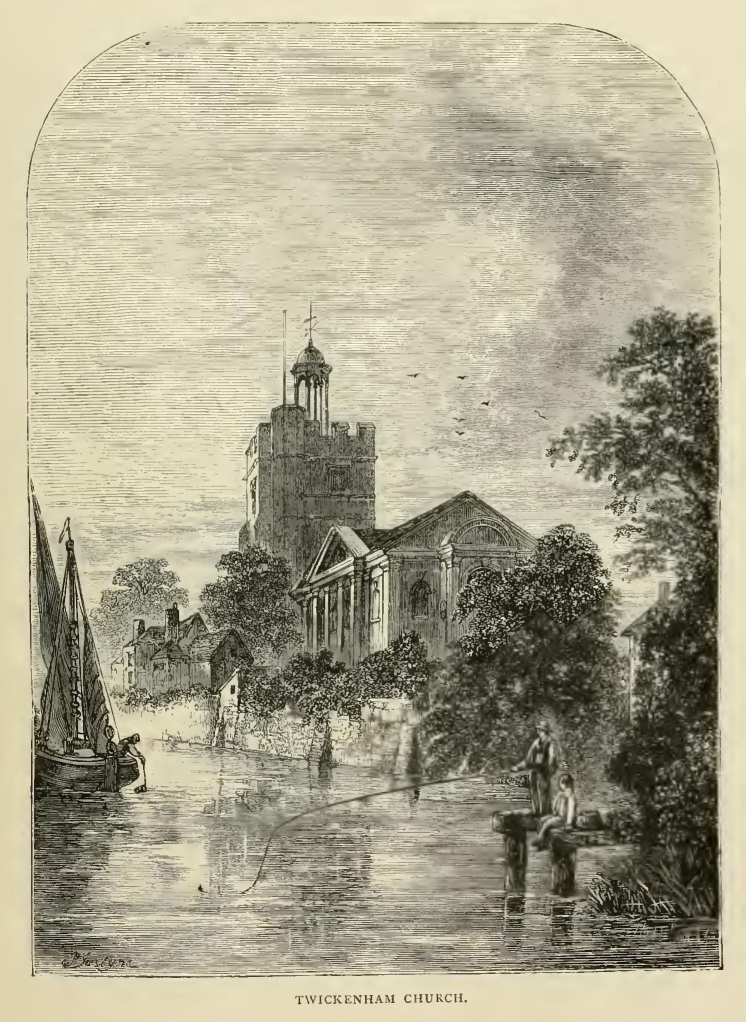
Two or three miles farther, and just past Hampton village, on the left bank, the traveller will notice a little rotunda with a Grecian portico with a mansion of some pretensions in the wooded back-ground. The house was Garrick's residence, and in the rotunda there originally stood Roubiliac's famous statue of Shakspere, now in the British Museum. Bushey Park and Hampton Court next tempt us to the shore. Great names of history again rise to memory—Wolsey, Cromwell, Williams. But the charm of Hampton Court is, that its palace and gardens are free of access to the people; a privilege which, all the summer through, is appreciated by eager, happy throngs. But let us cross the river to the comparative solitude of the two Dittons—"Thames," and "Long." An impromptu of poor Theodore Hook, lively and graceful, according to his wont, has led many a tourist in search of a holiday to this pretty neighbourhood, and the poet's memory is reverenced in the village accordingly. Here are the first and last verses:
"When sultry suns and dusty streets proclaim town's 'winter season,' And rural scenes and cool retreats sound something like high treason— I steal away to shades serene which yet no bard has hit on, And change the bustling, heartless scene for quietude and Ditlon. Here, in a placid waking dream, I'm free from worldly troubles, Calm as the rippling silver stream that in the sunshine bubbles; And when sweet Eden's blissful bowers, some abler bard has writ on. Despairing to transcend his powers, I'll-ditto-say for Ditton."
Then comes trim Surbiton with its villas, and Kingston—once, as its name imports, a town of kings. Por here were crowned several Saxon monarchs; is there not the coronation-stone in the market-place, engraven with their names? Teddington Lock, a little lower down, is the last upon the Thames; and here too the anglers of the river put forth their chief and almost their final strength. The mile from Teddington to Eel-pie Island off Twickenham will be a quiet one indeed, if the voyager interfere not with the sport of one or other of these gentry, and draw down their resentment accordingly. Strawberry Hill reminds us of Horace Walpole, literary idleness, sham Gothic, and bric-ŕ-brac. We glance and pass on. Pope's Villa no longer exists; only a relic of his famous grotto remains; but a monument to the poet is in Twickenham Church, with an inscription by Warburton, setting forth that Pope "would not be buried in Westminster Abbey."
Past wood-fringed meadows on either hand, the "Broadwater," now rightly named—sweeps on to Richmond, where we must ascend the far-famed hill, to gaze once more upon the finest river-view in Europe. A little farther down, on autumn days, off lsleworth, may be descried flights of swallows, preparing for their outward journey. "They arrive," writes the artist who has depicted the scene, "in a mass, at the same hour, without confusion, as it were in regiments, and in some of their oblique evolutions resemble a drift of black snow. At dusk they all sink down into the island or 'ait' opposite the church of Isleworth, where a large bed of osiers affords them in its slender wands a settling-place for the night."
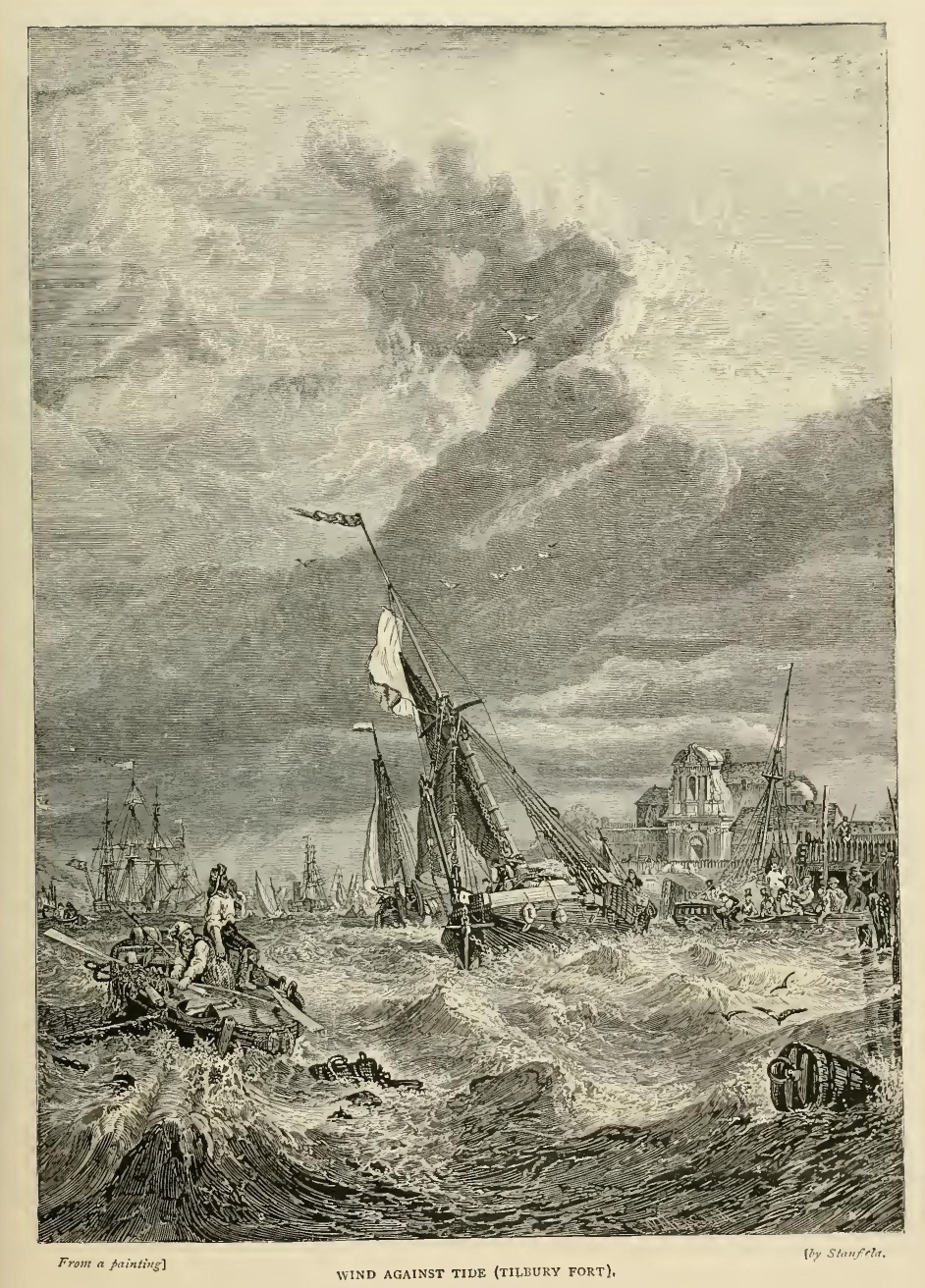
From this point, all Londoners know their river. The beauty of nature is no longer present, but a new sentiment of wonder and interest takes possession of us. We feel the stir and hear the roar of the great Babel. What were once quiet suburban villages are now but a part of the metropolis. Still, however, they retain something of the quaint picturesqueness of the last century. In many a nook and corner we come upon solid comfortable houses of red brick, where our great-grandmothers, over a "dish of tea," may have discussed the "poems of a person of quality," or "the writings of the ingenious Mr. Addison."
These relics of the last century are rapidly disappearing.
Cheyne Walk at Chelsea, which now forms so striking an object from the river, can hardly hold out much longer against the march of modern improvement, and will probably ere long share the fate of the Lord Mayor's barge, and disappear from view.
The noble embankments which now skirt so large a portion of the London river, and the bridges old and new, afford every facility for the full study of the Thames in all its aspects. Yet those who only cross with the hurrying crowd miss half the picturesqueness of what many who have travelled far feel to be among the most picturesque city views in Europe. Wordsworth's sonnet, beginning—
"Earth has not anything to show more fair,"
was written on Westminster Bridge! But then it was on an early summer morning, when the "mighty heart" of the city was "lying still," and the "very houses seemed asleep." The blue sky, unobscured by smoke, hung in the freshness of the dawn over the dwellings of men and the heaven-pointing spires. The night airs had swept away every city taint, and the atmosphere was pure as among the mountains or by the sea. The experiment is worth making still at the cost of an hour or two's earlier rising, to prove how exhilarating, fresh, and delightful the London air may be.
Or perhaps the charm of the scene may be more deeply felt amid the mystery of night, when the clouds have dispersed, and but for some rare footfalls there is silence, and the countless lights stretch in long lines, reflected by the gently rippling waters, while even the bright glare of the railway lamps aloft only add colour and splendour to the gleaming array, and the steadfast stars hang overhead. By night or in early morning, perhaps through force of contrast, the full beauty of these London river scenes are felt. Or, to vary the impression, we may take boat, as did our fathers, from bridge to bridge, "from Westminster to Rotherhithe," or farther down the broadening stream, with the wealth of the world, as it almost seems, ranged on either hand in the close-crowded vessels or the stupendous warehouses. Every such excursion is a new revelation, even to minds accustomed to the scene, of what is meant by English commerce, and of the ties which connect us with all mankind. Yet there is much to remind us that the universal reign of peace has not as yet set in. Grim preparations for defence and war bespeak a nation prepared, if needs be, for strife. And as at length we reach Tilbury Fort, and glow under the influence of the invigorating sea-breeze, great memories rush in upon us of armaments once gathered here; to lead, as it seemed, the forlorn hope;—to attain, as by God's great mercy it proved, the triumphant victory, of British Protestantism and liberty.
When King James I. threatened the recalcitrant corporation of London with the removal of the court to Oxford, the Lord Mayor, with scarcely veiled sarcasm, replied, "May it please your Majesty, of your grace, not to take away the Thames too!" If the Upper Thames awakens our admiration by its loveliness, the Lower Thames inspires us with wonder and almost awe at the boundless wealth and world-wide commerce which it bears upon its ample bosom. Other rivers may vie with it in beauty. In far-reaching influence it stands alone. As we sail through its forest of masts, or follow its course down to the sea, we feel that we are surrounded by influences which stretch to the very ends of the earth. The stream whose course we have traced from the tiny rivulet in Trewsbury Mead has become the channel of communications which, for good or evil, are affecting every nation under heaven. May He who has endowed us with such wealth and power lead us to hold them both under a deep sense of responsibility to Him who gave them!—"Then shall our peace flow like a river, and our righteousness as the waves of the sea."
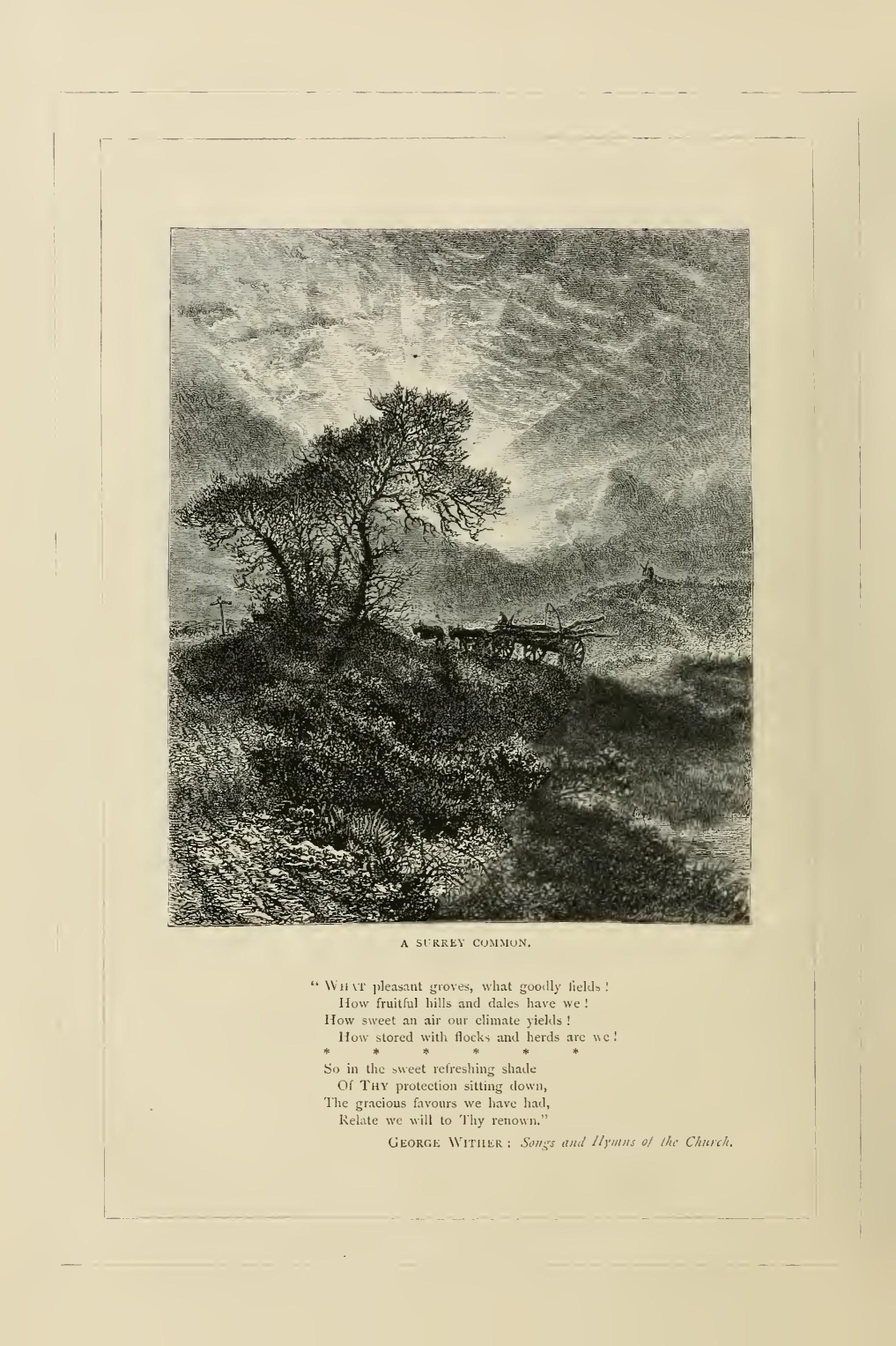
HE is a benefactor to his species who makes two blades of corn grow where only one grew before." The substantial truth of the aphorism none will question; vet it would be a doubtful benefit if all our waste lands were reclaimed and brought under the plough. Enclosure Acts, by extending the area of our productive soil, have increased the resources of the country and the food of the people. But the total absorption into cultivated farms of heath, forest, and woodland would be to purchase the utilitarian advantage at too high a price.
The open commons of Surrey and the rolling downs of Sussex are, in their way, of a beauty unsurpassed. Both are chiefly due to the great chalk formation, which comes down in a south-westerly direction from the eastern counties, breaks into the Chiltern Hills, extends over the greater part of Wiltshire, Dorsetshire, and Hampshire; and in the east of the last-named county becomes separated into two branches; one, the "North Downs," running almost due east to the North Foreland and Shakespere's Cliff; the other, the "South Downs," pursuing a south-easterly direction to Beachy Head. In their long and undulating course, they form innumerable combinations of picturesque beauty. Places elsewhere, well known and deservedly famous, are rivalled in loveliness by many a sequestered scene in the line of the lower chalk country, of which few but the thinly-scattered inhabitants, and now and then an unconventional tourist, have ever heard.
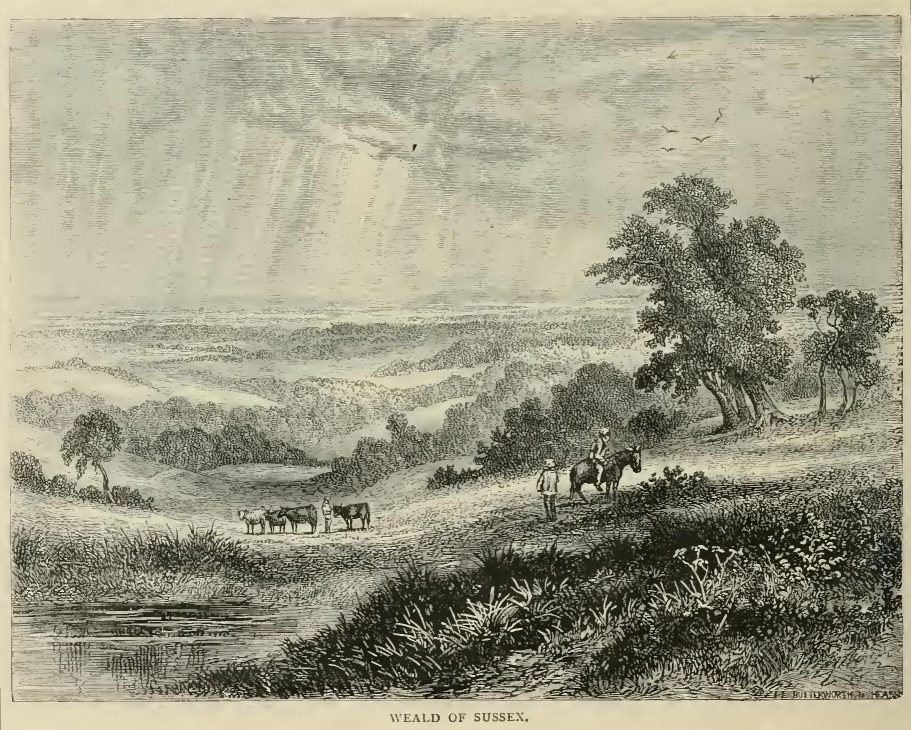
The charm of these lines of rolling upland is much enhanced by the great rough plain which they inclose—"the Weald" (i.e. Forest), as it is termed—extending in an irregular triangle from the point where the Downs diverge to the British Channel. Geologists have framed many theories as to the formation of the Weald. It belongs to the Oolite formation below the chalk; it is the uppermost member of that formation, and was a deposit of sands and clays in a tropical climate, as is abundantly evident from animal and vegetable remains found there. These prove the existence of islands, banks and forests, forming the shores of a vast estuary, the embouchure of some great river from the west. At one time, the deep chalk deposit extended all over it; but this was disturbed by a line of elevation running along its east and west axis, the superincumbent chalk being broken up and washed away; hence the cliff-like aspect of the Downs in many places, where they descend precipitously to the sandy and gravelly edge of the valley, as to a beach. The remains of the huge land lizards and iguanodons of the Weald, collected by the late Dr. Mantell, form one of the most conspicuous exhibitions of fossil bones in the British Museum. The pretty little fossil ferns, Lonchopteris and Sphenopteris, found nature-printed on the sandstones, are, on the other hand, the very counterparts, in size and delicacy, of their present successors.
In early times, as every local historian tells, the Weald was a chief seat of the iron manufacture in Great Britain. The ironstone found here was certainly wrought by the Romans and Saxons, if not by the ancient Britons; and down to the seventeenth century the trade was prosperous. Many an old manor-house, to the present day, attests this former prosperity, while its memories linger also in such local names as Furnace Place, Cinder Hill, and Hammer Ponds. The balustrades round St. Paul's Cathedral are a relic of the Sussex ironworks. Want of fuel, and the more abundant and rich ironstone of the Coal-measures, caused the decay of the industry, after whole forests had been destroyed to feed the furnaces. The old-fashioned cottages, here and there remaining, speak of days of former prosperity among the working-classes; nor are they even yet devoid of comfort, although the transition has been great—ironworkers then, chicken-fatteners now!
The ridge that runs through the centre of the Weald is called the Forest Ridge and Ashdown. It is here that the chief beauties of the district are concentrated, while the whole plain lies open to view from the heights. Starting from East Grinstead, near to which is the source of the Medway, a walk of extraordinary interest and sylvan beauty leads by Forest Row and the ruins of Brambletye House up to High Beeches; from which spot a pleasant excursion may be made to Horsted Keynes, where the gentle and saintly Archbishop Leighton lies buried. His grave is in the chancel; his tomb outside the church. Thence, bearing to the east, the traveller may work his way to Crowborough Beacon, near the road from Tunbridge Wells to Lewes, where, with a foreground of moss and fern, dotted here and there by fir trees, he may look over the whole rolling surface of the Weald, rich with the flowers of spring, the blossoms of summer, or the golden fruitage and yellow corn of the autumn; while the purple downs on either hand close in the prospect, with just one gleam, beyond Beachy Head, of the distant sea. Then, if desirous of prolonging his ramble to other points of view, he may cross the hills to Heathfield, resting on the way at Mayfield, an old-world Wealden town, once a residence of archbishops, and the traditional scene of the renowned combat between Dunstan and the Devil. Here the traveller may find a temporary resting-place in some rustic hostelry, where, if luxuries are not obtainable, the eggs and bacon are wholesome and abundant; the sheets are fragrant with lavender, and though perhaps a little wondered at by the rustic children, he will have a home-like welcome.
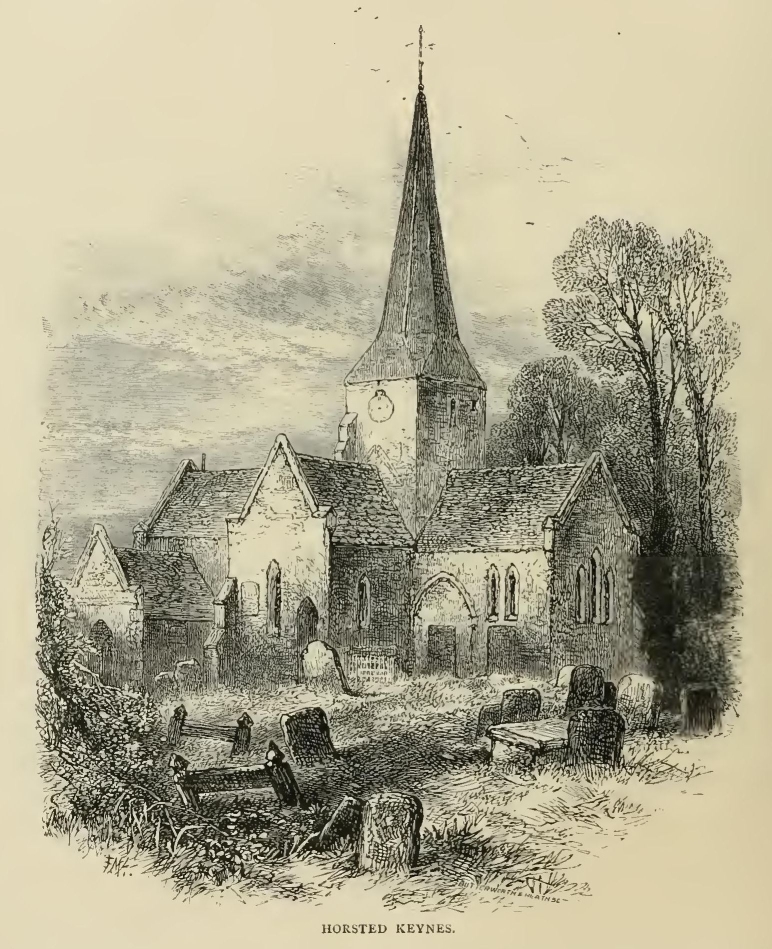
Again we leave the beaten track, and push on through the vale of Heathfield to the south; for a walk of seven or eight miles will bring us to Hurstmonceux, inseparably connected with the name and work of Archdeacon Hare, the philosophic theologian and devout Christian, whose books on the Victory of Faith and the Mission of the Comforter have done so much to elevate the religious thought of the age; and who, by his Vindication of Luther, has made it impossible for any man of competent knowledge and fair judgment to repeat old calumnies against the great Reformer.
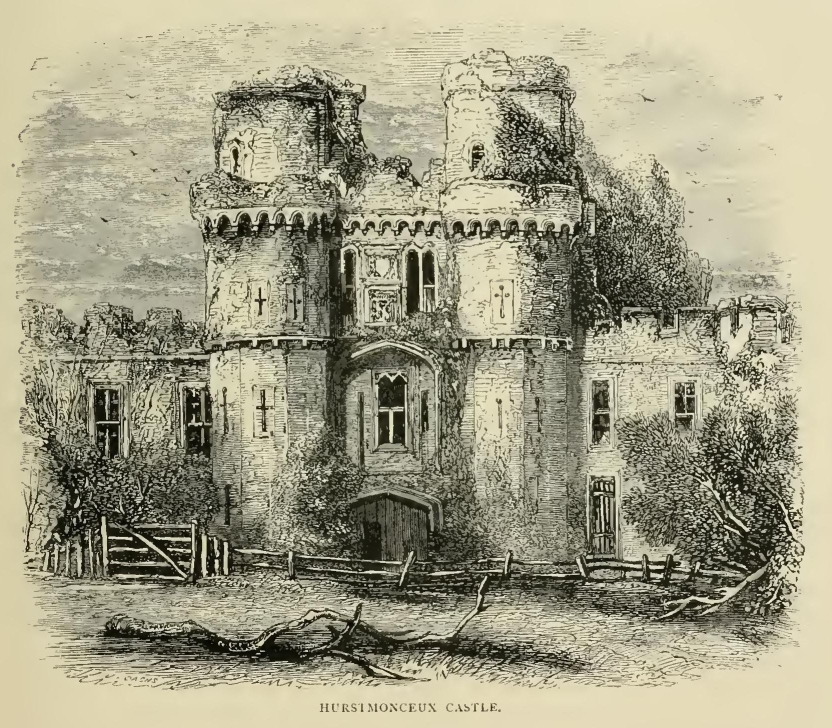
We visit the castle—one of the finest remains of the later feudalism—fortress and mansion in one. "Persons who have visited Rome," writes Archdeacon Hare, "on entering the Castle-court, and seeing the piles of brickwork strewn about, have been reminded of the Baths of Caracalla, though of course on a miniature scale; the illusion being perhaps fostered by the deep blue of the Sussex sky, which, when compared with that in more northerly parts of England, has almost an Italian character." After exploring the great ruddy-tinted ruins, we may ascend to the church, taking a glance at the rectory, the home of so much piety and genius, seeing once again in thought the archdeacon's friend and curate, poor John Sterling, as described by Hare, with his tall form rapidly advancing across the lawn to the study window; or more pensively may pass to the churchyard, where so many members of the parted family band sleep as "one in Christ."
Before turning northwards, let us make our way to Beachy Mead, grandest of the English chalk headlands in the south; or, resting for a while at Eastbourne, that bright modern watering-place, between the sea and the hills, with the quaint Sussex village in the background, we may prepare for a long, health-giving, inspiring ramble over the South Downs, "that chain of majestic mountains," as White of Selborne calls them—for the most part bare treeless hills, sweeping in many a grand curve, broken by shadowed "coombes," or wooded flowery "deans." On the way to Lewes, Firle Beacon, one of the highest points of the Downs, may be ascended, after which the traveller may take the rail to Brighton and Shoreham, and strike up hill again into what is perhaps the finest part of the range, where, from Chanctonbury Ring, he will be able to command at one view all its most characteristic features. The height itself is conspicuous far and wide, from its dark crown of fir trees. Probably the "Ring" denotes here the ancient entrenchment, British or Roman, which is circular, or it may be a reminiscence of the time when fairies were believed in; "fairy rings" being a common feature of the Downs; caused really by the growth of mushrooms, the grass, by the decay of the latter, becoming of a deeper green.
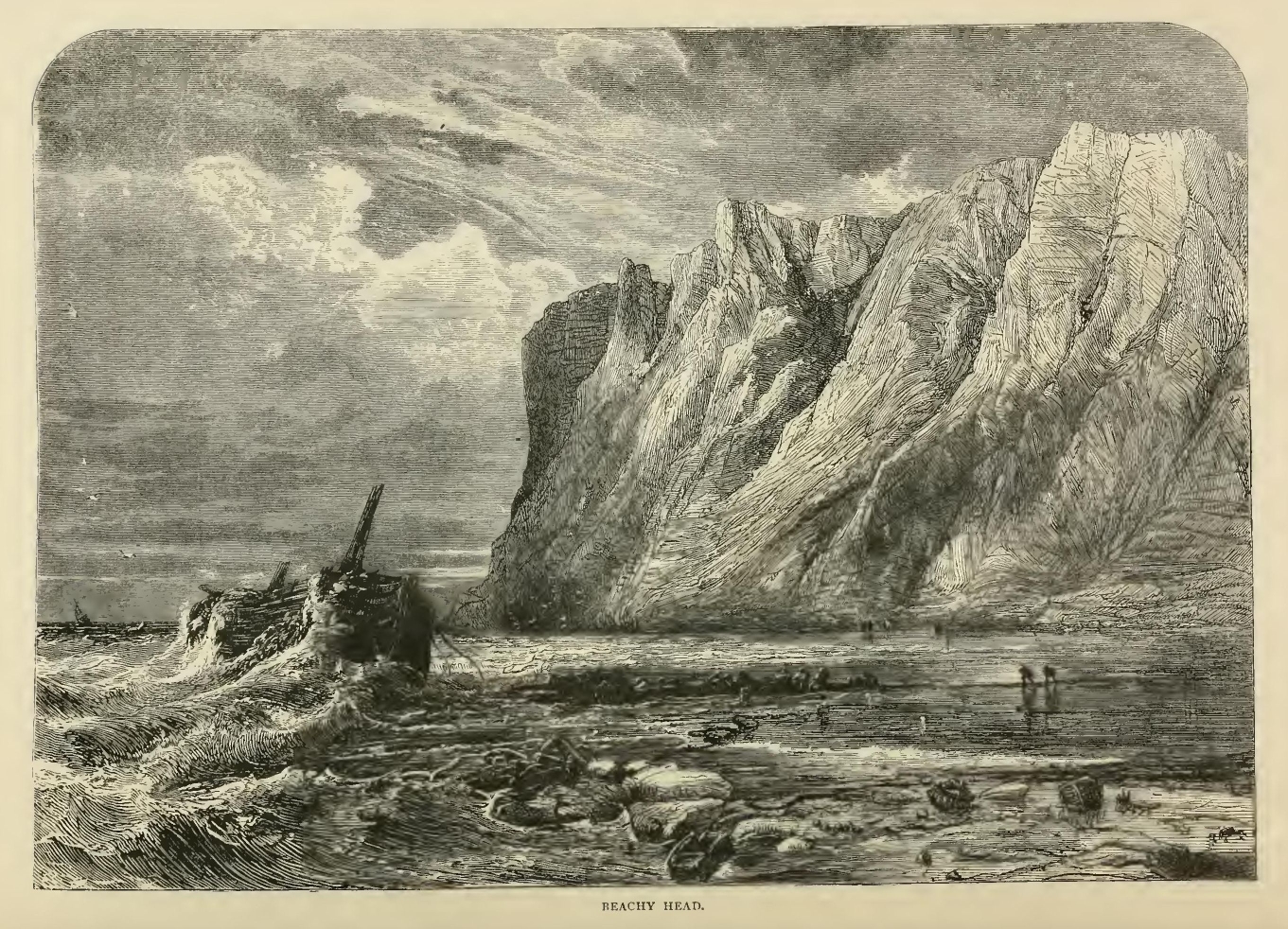
Steyning is the nearest station to Chanctonbury, and we would advise the tourist to take train there for the North Downs, or better still, to proceed in the opposite direction to Arundel, famous for its picturesque castle and park, with its fair historic pastures: but in either case the Weald will be crossed via Horsham. About half way between Arundel and Horsham, many a traveller will be disposed to turn off to the little Sussex town of Midhurst, on the edge of the Weald, where Richard Cobden was born, and where the old "Schola Grammaticalis," the most prominent building in the town, has the twin honour of the great Free Trader's early education, as well as that of Sir Charles Lyell, the geologist. Between this town and Dorking, whither the traveller is bound, he may see to his left the wooded slopes and imposing tower-crowned summit of Leith Hill, the loftiest elevation in southeastern England. If he can leave the rail, say at the little roadside station of Capel, and climb the hill from the south-east by Ockley and Tanhurst, he will not only be richly rewarded, but may perhaps express his astonishment that such views and such a walk should be found within a short afternoon's journey of London. From the summit of Leith Hill, it is said that ten counties are visible; not only Kent, Sussex, and Surrey, but Hampshire, Berkshire, Oxfordshire, Buckinghamshire, Middlesex. Hertfordshire, and Essex. The eye ranges, in short, from a height of just less than 1000 feet over a circumference of 200 miles of fair and various landscape; valley and upland; broad meadows and wooded slopes, with many an open ridge against the sky. Only the charm of river or lake is wanting; but we are in no mood to be critical. Downwards, the walk is full of interest, through wooded lanes to Anstiebury, where there is a fine Roman encampment, and on to romantic Holmwood, with its pine woods and breezy common; past Deepdene, the wonderfully beautiful seat of the Hope family, and so to Dorking, where the wearied pedestrian will find a pleasant rest, with nothing to excite him, save the remembrances of his little excursion.
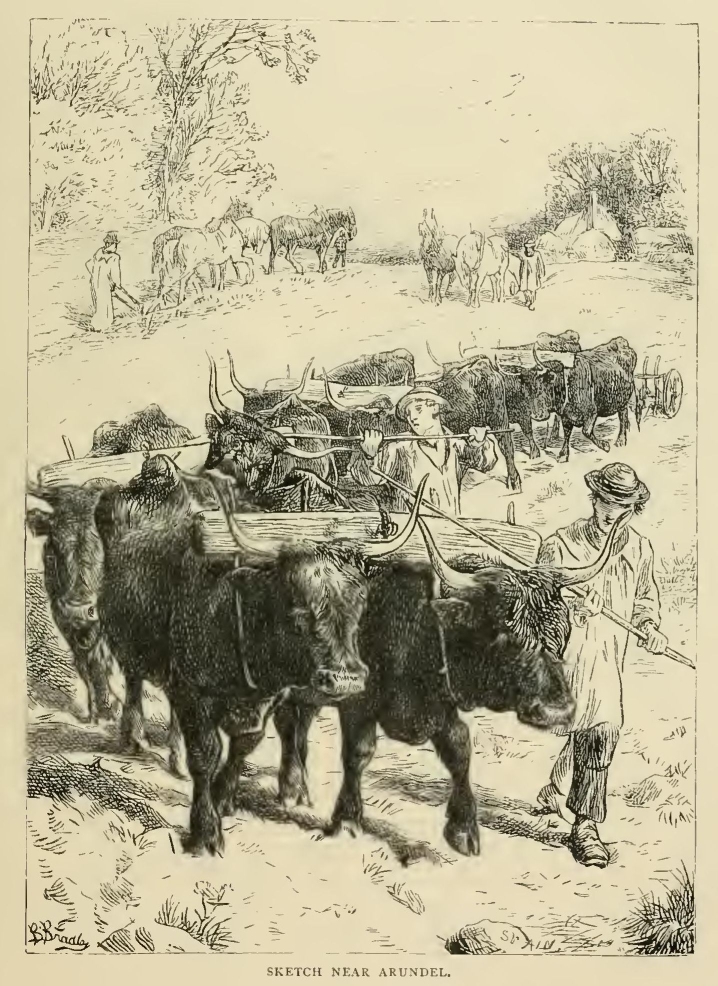
If he were not well prepared for its exceeding loveliness beforehand, it must have been to him a surprise as well as a delight. Comparisons are proverbially distasteful, but we can understand, if we can not wholly endorse, the rapturous verdict of John Dennis, who gives it as his opinion that the prospect from Leith Hill "surpasses at once in rural charm, pomp, and magnificence" the view of the Val d'Arno from the Apennines, or of the Campagna from Tivoli.
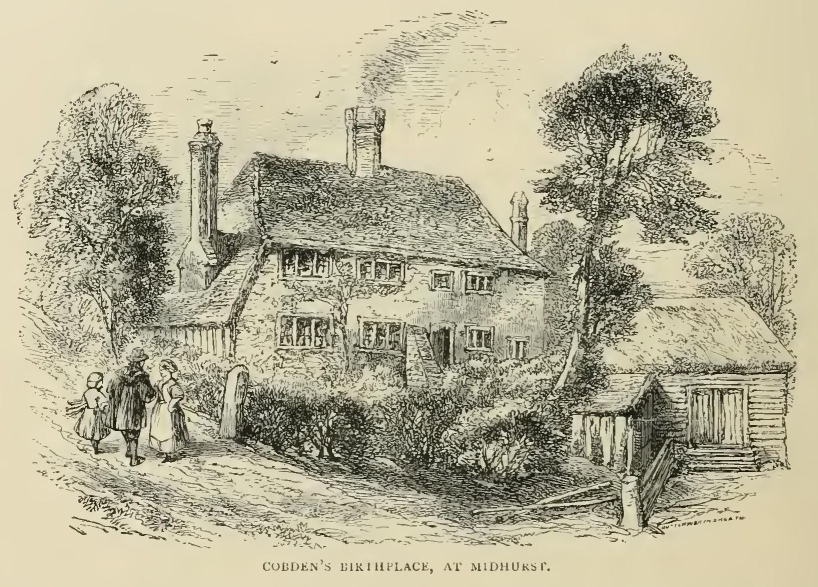
We are now fairly in the Surrey Hills, and may put what some will think the very crown to these south-eastern excursions by a walk from Dorking to Farnham. Ascending by one of many lanes, shadowed (at the time of our visit) by hedges bright with hawthorn berries, and stately trees just touched with the russet and gold of early autumn, we are soon upon an upland stretch of heath and forest, still remaining in all the wildness of nature. Sometimes the path leads us between venerable trees—oak and beech and yew, whose branches form an impenetrable roof overhead, then traverses a sweep of bare hill, bright with gorse and heather, then plunges into some fairy dell, carpeted with softest moss. Many of the "stately homes of England," with their embowering trees upon the lower slopes, add a charm to the scene by their reminiscences as well as by their beauty. To the left is Wotton; made famous by the name and genius of John Evelyn, author of Sylva and the Diary—the scholar, gentleman, and Christian—pure-minded in an age of corruption, and the admiration of dissolute courtiers, who could respect what they would not imitate. It is to him that Cowley says:
"Happy art thou, whom God does bless
With the full choice of thine own happiness;
And happier yet, because thou'rt blest
With wisdom how to choose the best."
That the choice was made, for life and death, appears by the inscription which Evelyn directed to be placed on his tombstone at Wotton. "That living in an age of extraordinary events and revolution, he had learned from thence this truth, which he desired might be thus communicated to posterity: that all is vanity which is not honest, and that there is no solid wisdom but real piety."
Two or three miles further Albury is reached, with its lovely gardens designed by Evelyn. The curious traveller may here inspect the sumptuous church erected by the late Mr. Drummond, the owner of Albury, for the followers of Edward Irving. The worth of Mr. Drummond's character, with the shrewd sense and caustic wit by which he was wont to enliven the debates of the House of Commons, laid a deeper hold upon his contemporaries than his theological peculiarities; and the special views of which this temple is the costly memorial have proved of insufficient power to sway the minds and hearts of men. Still ascending, we reach again the summit of steep downs, and advancing by noble yew-trees gain at Newland's Corner another magnificent view. The hill of the "Holy Martyrs'" Chapel, now corrupted to "Saint Martha's," may next be climbed, and a short rest at the fine old town of Guildford will be welcome. The castle, the churches with their monuments, and Archbishop Abbot's Hospital, are all worthy of a visit; but, unless we have a day to spare, we must be content with but a hurried glance, for we have still the "Hog's Back" to traverse, a ten miles' walk to Farnham.
Climbing from the station at Guildford through pleasant lanes, the traveller emerges upon a narrow chalk-ridge, half-a-mile wide, and nearly level, which etymologists tell us was called by the Anglo-Saxons Hoga, a hill, whence the ridge received its name. Possibly, however, a simpler derivation, as the more obvious, is also the more correct. The long upland unbroken line might not unaptly have been compared with one of those long, lean, narrow-backed swine with which early English illuminations make us familiar; and the homeliness of the name would quite accord with the habit of early topographers. The walk is interesting, but, after the varied beauties of the way from Dorking to Guildford, may appear at first slightly monotonous. On either side the fair, fertile champaign of Surrey stretches to the horizon, broken here and there by low wood-crowned hills, and at one point especially, between Puttenham on the left, and Wanborough on the right, the combinations of view are very striking. Puttenham church-tower, and the manor-house, formerly the Priory, peep out from amongst the foliage of some grand old trees. A few cottages and farmhouses lie scattered about picturesquely, forming the very ideal of an old English village; while pine-covered Crooksbury Hill, with the Devil's Jumps and Hindhead in the farther distance, make a striking background to the view. "Wan" is evidently "Woden," and here there was no doubt a shrine of the ancient Saxon deity.
We must not omit in passing to drink of the Wanborough spring, among the freshest and purest in England; never known, it is said, to freeze.
Pursuing our journey, we presently look down upon Moor Park and Waverley, which we may either visit now, descending by the little, village of Seale, or reserve for an excursion from Farnham. Waverley contains the picturesque remains of an old Cistercian Abbey, built as the Cistercians always did build, in a charming valley, embosomed in hills, irrigated by a clear running stream, abounding in fish, and with current enough to turn the mill of the monastery. The annals of this great establishment, extending over two hundred and thirty years, were published towards the close of the seventeenth century; and Sir Walter Scott took from them the name now so familiar wherever the English language is spoken.
Divided from Waverley by a winding lane, whose high banks and profuse undergrowth remind us of Devonshire, lies Moor Park. Hither Sir William Temple retired from the toils of State, to occupy his leisure by gardening, planting, and in writing memoirs. A trim garden, with stiff-clipped hedges, and watered by a straight canal which runs through it, is doubtless a reminiscence of Temple's residence as our ambassador at the Hague. "But," says Lord Macaulay, "there were other inmates of Moor Park to whom a higher interest belongs. An eccentric, uncouth, disagreeable young Irishman, who had narrowly escaped plucking at Dublin, attended Sir William as an amanuensis for board and twenty pounds a year; dined at the second table, wrote bad verses in praise of his employer, and made love to a very pretty dark-eyed young girl, who waited on Lady Giffard. Little did Temple imagine that the coarse exterior of his dependant concealed a genius equally suited to politics and to letters, a genius destined to shake great kingdoms, to stir the laughter and the rage of millions, and to leave to posterity memorials which can only perish with the English language. Little did he think that the flirtation in his servants' hall, which he, perhaps, scarcely deigned to make the subject of a jest, was the beginning of a long, unprosperous love, which was to be as widely famed as the passion of Petrarch or Abelard. Sir William's secretary was Jonathan Swift. Lady Giffard's waiting-maid was poor Stella."
Just outside the lodge gate, at the end of the park furthest from the mansion, is a small house covered with roses and evergreens. It is known to the peasantry as Dame Swift's cottage. Our rustic guide pointed it out by this name, but who Dame Swift was he did not know. He had never heard of Stella and her sad history. An object of far greater interest to him was a large fox-earth, a couple of hundred yards away, in which some years ago "a miser" had lived and died. A whole crop of legends have already sprung up about the mysterious inmate of the cave. He was a nobleman, so said our informant, who had been crossed in love: he had made a vow that no human being should see his face, and accordingly never came out till after nightfall, even then being closely wrapped up in his cloak. After his death a party of ladies and gentlemen came down from London in a post-chaise and four; and having buried the body carried away "a cartload of golden guineas and fine dresses, which he had hid in the cave."
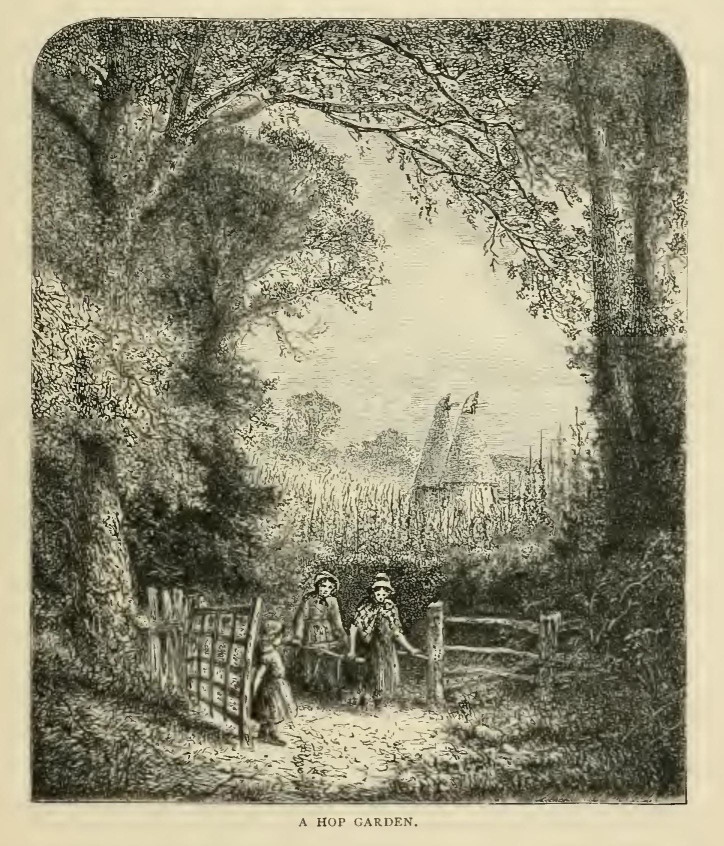
The picturesqueness of the approach to Farnham, whether over the last ridge of the Hog's Back, or through the lanes from Seale, Moor Park, and Waverley, is much enhanced by the hop-gardens, which occupy about a thousand acres in the neighbourhood. For excellence the Farnham hops are considered to bear the palm, although the chief field of this peculiar branch of cultivation is in Kent. No south-eastern rambles, especially in the early autumn, would be complete without a visit to the gardens where the hop-picking is in full operation. It is the great holiday for thousands of the humbler class of Londoners, as well as the chosen resort of thousands of the "finest pisantry" from the Emerald Isle. Costermongers, watermen, sempstresses, factory girls, labourers of all descriptions, young and old, bear a hand at the work. The air is invigorating, the task to the industrious is easy, and the pay is not bad. The hop-pickers, who are in such numbers that they cannot obtain even humble lodgings in the villages, sleep in barns, sheds, stables, and booths, or even under the hedges in the lanes. A rough kind of order is maintained among themselves; although outbreaks of violence and debauchery sometimes happen. On the whole the work is not unhealthy, and the opportunity of engaging in it is as real a boon to the hop-pickers as the journey to Scarborough or Biarritz to those of another class. Besides which, the great gathering of people gives opportunities of which Christian activity avails itself; and the evening visit to the encampment, the homely address, the quiet talk, and the well-chosen tract, have been instrumental of lasting good to those whom religious agencies elsewhere had failed to reach.
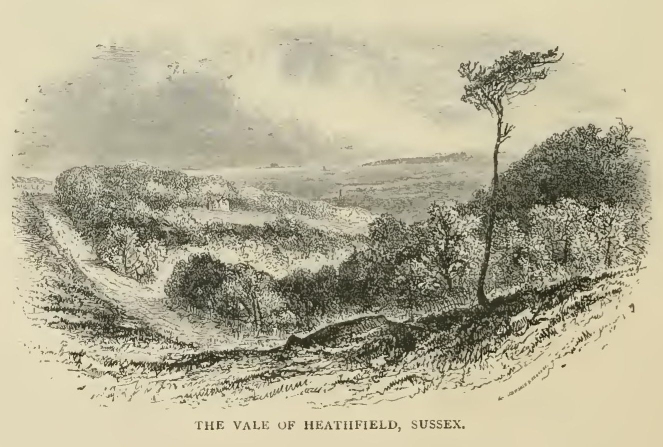
Farnham has special associations with both the Church and the Army; and the impartial visitor will no doubt take an opportunity of seeing the stately moated castle, the abode of the Bishops of Winchester, and of visiting the neighbouring camp of Aldershot. The politician will recal the name of William Cobbett, who was born in this neighbourhood, and in his own direct and homely style, often dwells on his boyish recollections of its charms. Some will not forget another name associated with this little Surrey town. One among the sweetest singers of our modern Israel, Augustus Toplady, was born at Farnham. He died at the age of thirty-eight, but he lived long enough to write "Rock of Ages, cleft for me and none need covet a nobler earthly immortality."
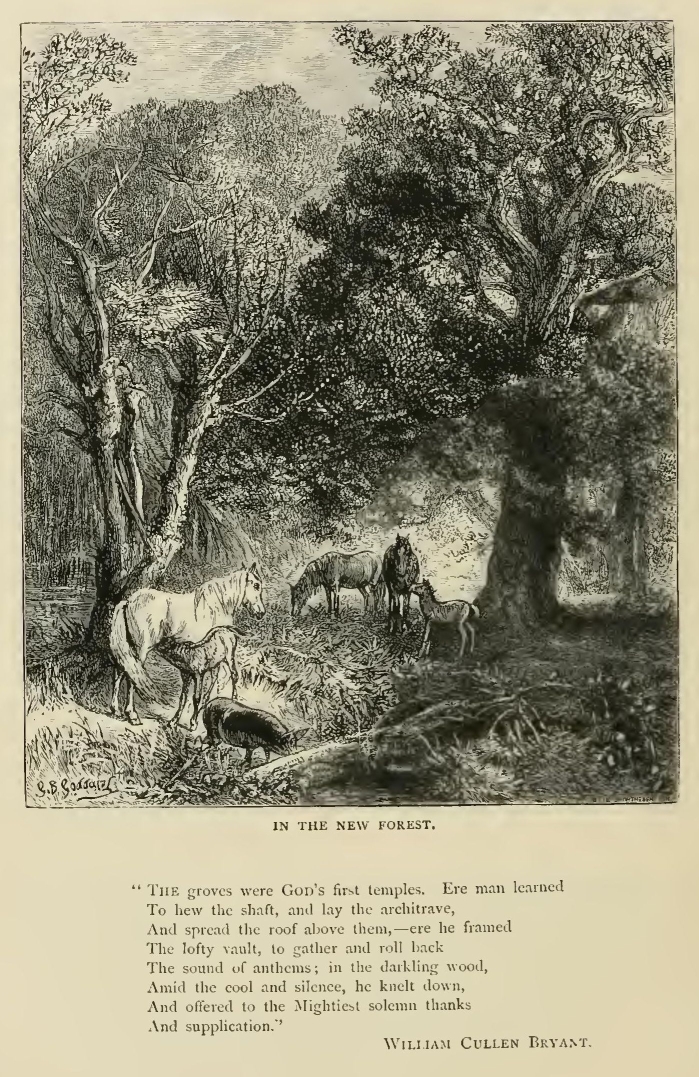
WHEN Britain was first brought by Roman ambition within the knowledge of Southern Europe, the interior of our Island was one vast forest. Cćsar and Strabo agree in describing its towns as being nothing more than spaces cleared of trees—"royds," or "thwaites" in North of England phrase—where a few huts were placed and defended by ditch or rampart. Somersetshire and the adjacent counties were covered by the Coit Mawr, or Great Wood. Asser tells us that Berkshire was so called from the Wood of Berroc, where the box-tree grew most abundantly. Buckinghamshire was so called from the great forests of beech (boc), of which the remnants still survive. The Cotswold Hills, and the Wolds of Yorkshire, are shown by their names to have been once far-spreading woodlands; and the same may be said of the Weald of Sussex, the subject, in part, of the preceding chapter. "In the district of the Weald," writes the Rev. Isaac Taylor, "almost every local name, for miles and miles, terminates in hurst, ley, den, or field. The hursts were the dense portions of the forests; the leys are the open forest-glades where the cattle love to lie; the dens are the deep wooded valleys, and the fields were little patches of 'felled' or cleared land in the midst of the surrounding forest. From Petersfield and Midhurst, by Billinghurst, Cuckfield, Wadhurst, and Lamberhurst, as far as Hawkshurst and Tenterden, these names stretch in an uninterrupted string." And, again, "A line of names ending in den testifies to the existence of the forest tract in Hertfordshire, Bedfordshire, and Huntingdon, which formed the western boundary of the East Saxon and East Anglican Kingdoms. Henley in Arden and Hampton in Arden are vestiges of the great Warwickshire forest of Arden, which stretched from the Forest of Dean to Sherwood Forest." * Hampshire was already a forest in the time of William the Conqueror: all he did was to sweep away the towns and villages which had sprung up within its precincts. Epping and Hainault are but fragments of the ancient forest of Essex, which extended as far as Colchester. Lancashire, Cheshire, Yorkshire, and the other northern counties, were the haunts of the wolf, the wild boar, and the red deer, which roamed at will over moorland and forest, and have given their names here and there to a bold upland or sequestered nook.
Even down to the time of Oueen Elizabeth immense tracts of primeval forest remained unreclaimed. Sir Henry Spelman ** gives the following list of those which were still in existence.
* Words and Places, pp. 381-3.
** Quoted in English Forests and Forest Trees.
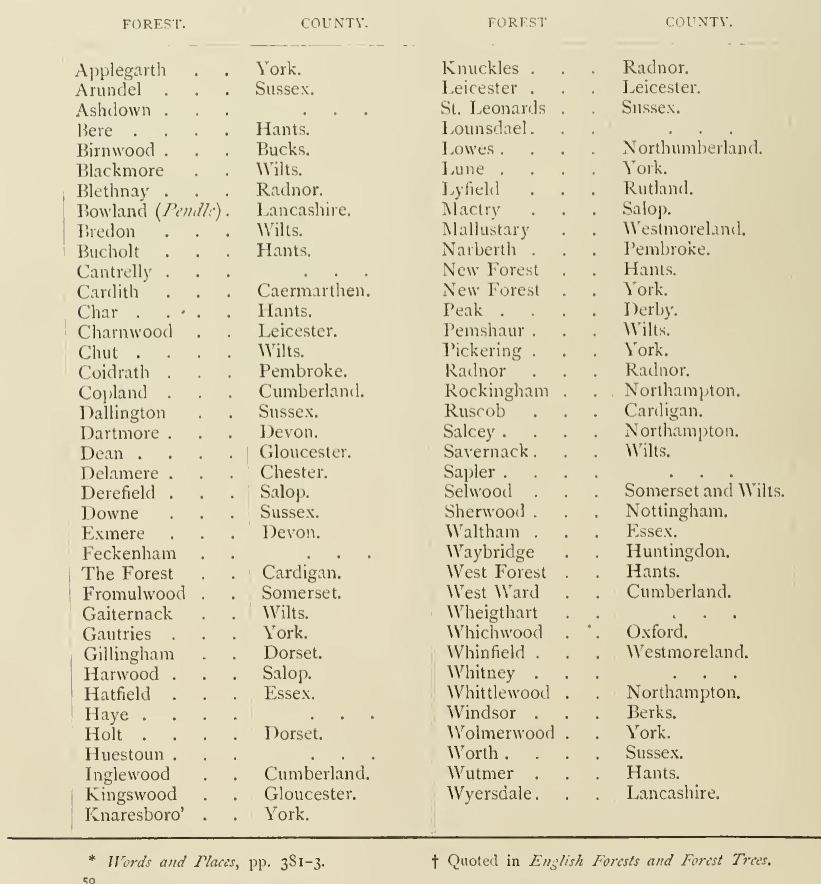
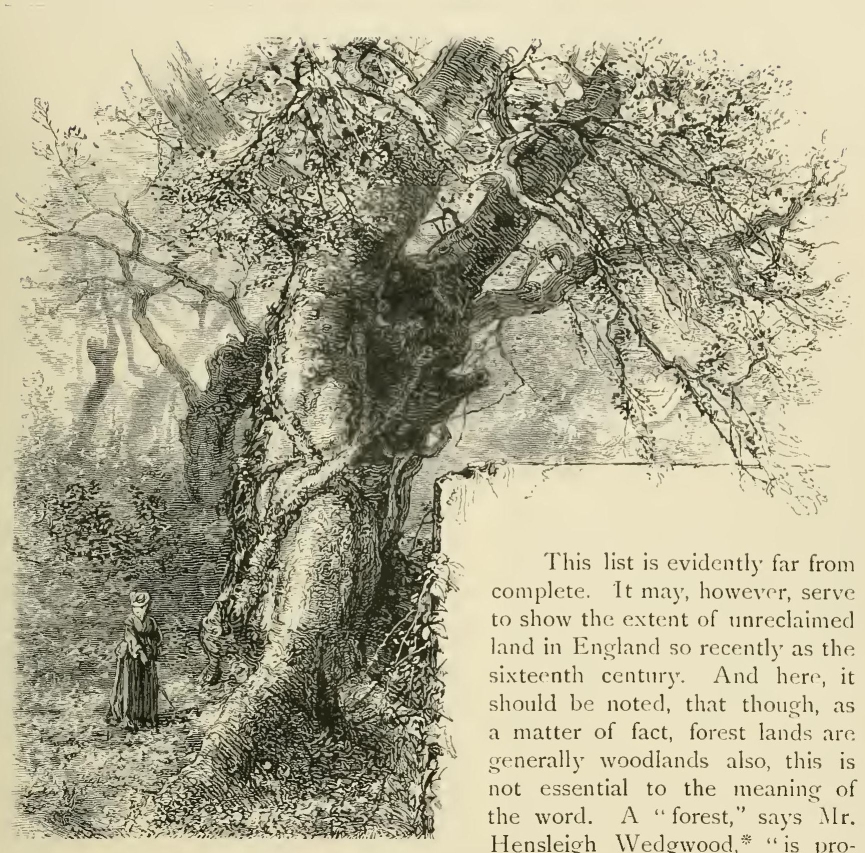
This list is evidently far from complete. It may, however, serve to show the extent of unreclaimed land in England so recently as the sixteenth century. And here, it should be noted, that though, as a matter of fact, forest lands are generally woodlands also, this is not essential to the meaning of the word. A "forest," says Mr. Hensleigh Wedgwood, * "is properly a wilderness, or uncultivated tract of country; but, as such were commonly overgrown with trees, the word took the meaning of a large wood. We have many forests in England without a stick of timber upon them." It is especially so in Scotland, as many a traveller who has ridden all the long day by the treeless "Forest of Breadalbane" will well remember.
* Dictionary of English Etymology.
The question has been recently much discussed whether our forests ought to be retained in their present extent. Economists have shown by calculation that forests do not pay. It is said that they encourage idleness and poaching, and thus lead to crime. Estimates have been made of the amount of corn which might be raised if the soil were brought under the plough. Yet few persons who have wandered through the glades of our glorious woodlands would be willing to part with them. Admit that the cost of maintenance is in excess of their return to the national exchequer; yet England is rich enough to bear the loss; and it is a poor economy which reduces everything to a pecuniary estimate. "Man shall not live by bread alone." In God's world beauty has its place as well as utility. "Consider the lilies."
"God might have made enough—enough
For every want of ours,
For temperance, medicine, and use,
And yet have made no flowers."
"He hath made everything beautiful in his time;" and means that we should rejoice in His works as well as feed upon His bounty and learn from His wisdom. While by no means insensible to the charm of a richly cultivated district, where "the pastures are clothed with flocks, the valleys also are covered over with corn," yet let us trust that the day is far distant when our few remaining forests shall have disappeared before modern improvements and scientific husbandry.
To the lover of nature, forest scenery is beautiful at all seasons. How pleasant is it, in the hot summer noon, to lie beneath the "leafy screen," through which the sunlight flickers like golden rain; to watch the multitudenous life around us—the squirrel flashing from bough to bough, the rabbit darting past with quick, jerky movements, the birds flitting hither and thither in busy idleness, the columns of insects in ceaseless, aimless gliding motion—and to listen to the mysterious undertone of sound which pervades rather than disturbs the silence! Beautiful, too, are the woods when autumn has touched their greenery with its own variety of hue. From the old Speech House of the Forest of Dean we have looked out as on a billowy, far extending sea of glory—elm, oak, beech, ash, maple, all with their own peculiar tints, yet blending into one harmonious chord of colour in the light of the westering sun; whilst from among them the holly and the yew stood out like green islands set in an ocean of gold.
A little later in the year, and we tread among the rustling leaves, whilst over us interlaces in intricate tracery a network of branches, twigs, and sprays:—
"The ruined choirs where late the sweet birds sang."
Return a few weeks afterwards, and surely it will be felt that forest scenery is never more fairy-like than when the bare boughs are feathered with snowflakes, or sparkle with icicles, that flash like diamonds in the wintry sunlight, or faintly tinkle overhead as they sway to and fro in the icy breeze. Never is the forest more solemn than when, with a sound like thunder or the raging sea, the wind tosses the giant branches in wild commotion. We cannot wonder that Schiller delighted to wander alone in the stormy midnight through the woods, listening to the tempest which raged aloft, or that much of his grandest poetry was composed amid scenes like these.
Nor must we forget the aspect of the woods in early spring, when Nature is just awaking from her winter's sleep. It needs a quick eye to trace the delicate shades of colour which then succeed each other—the dull brown first brightening into a reddish hue, as the glossy leaf-cases begin to expand, then a faint hint of tender green as the pale leaves burst from their enclosure one after another, tinging with colour the skeleton branches which they are soon to clothe with their beautiful mantle.
"Mysterious round! What skill, what force divine,
Deep felt, in these appear! A simple train,
Yet so delightful, mixed with such kind art,
Such beauty and beneficence combined,
Shade unperceived so softening into shade.
And all so forming an harmonious whole,
That, as they still succeed, they ravish still."
The New Forest claims precedence over all others, from its extent, its picturesque beauty, and its historical associations. Though greatly encroached upon since the time that the Conqueror "loved its red deer as if he were their father," and the Red King fell beneath the arrow of Sir Walter Tyrrell, it still contains long stretches of wild moorland, and mighty oaks which may have been venerable in the days of the Plantagenets. The red deer have entirely disappeared. About a hundred fallow-deer yet remain. They are very shy, hiding themselves in the least visited recesses of the Forest, and are rarely seen except during the annual hunt, which takes place every spring. In 1874 a pack of bloodhounds was brought down by Lord Londesborough, who owns a beautiful park near Lyndhurst. The sport, however, is said not to have been very good. Numerous droves of forest ponies run wild, and with the herds of swine feeding upon the acorns and beech-mast give animation to the scene. Amid the forest glades even pigs become picturesque.
Charming excursions may be made into the Forest from the towns on its borders, Southampton, Lymington, Christchurch, or Ringwood. But he who would fully appreciate its beauties must take up his quarters at Lyndhurst, in the very heart of its finest scenery. From this centre, walks or drives may be taken in every direction, and in almost endless variety. One of these, describing a circuit of about twelve miles, past the Rufus Stone and Boldrewood, claims especial mention. The road leads for a short distance through a richly-wooded and highly cultivated district. On a knoll to the left is a farm-house occupying the site of the Keep of Malwood, where William Rufus slept the night before his death. From this point vistas, locally known as "peeps," are cut through the trees, commanding noble views over the Forest, and extending southwards to Southampton Water, the Channel and the Isle of Wight. The soil now becomes more barren, and the trees more sparse and stunted. At the bottom of a steep descent stood a pyramidal stone, marking the spot where the king was slain, bearing on its three sides a record of the event. This has now been cased by an iron cylinder, with the original inscriptions in bold relief. To the left stretches a long bare ridge of moorland, from the summit of which the eye ranges over grand sweeps of fern, gorse, and heather, bounded by woodlands to the verge of the horizon.
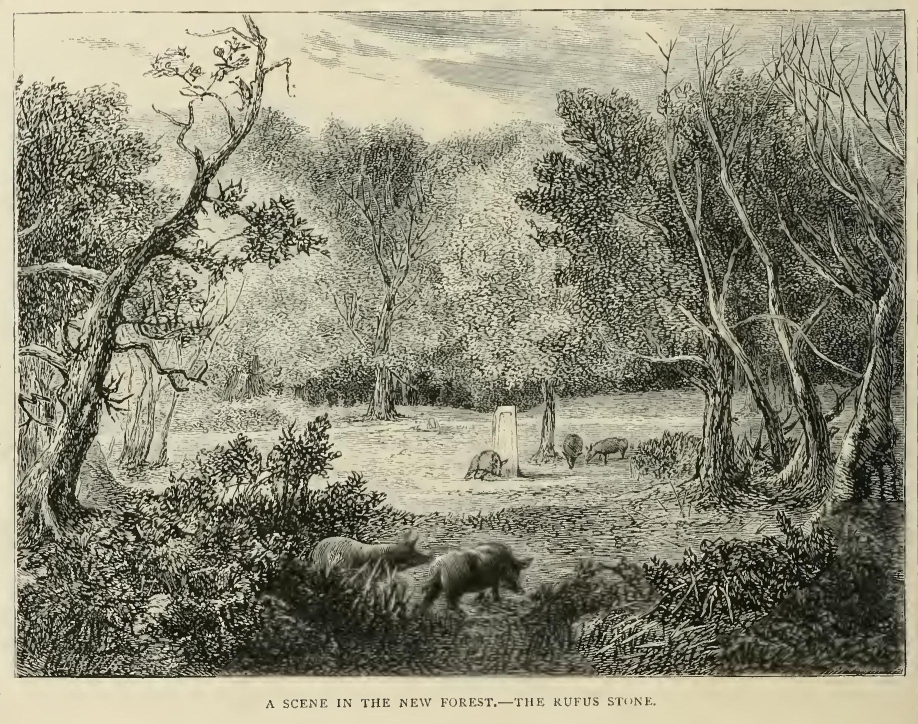
The road now passes through a succession of forest glades, over smooth green turf, beneath arches of beech and oak, with a luxuriant undergrowth of holly and yew. At Burley Lodge we reach some of the finest and oldest timber in the Forest. Here formerly stood twelve magnificent oaks, known as the "Twelve Apostles." Most of these have, disappeared, but two yet remain, which for size, beauty, and venerable antiquity are perhaps unequalled. A little farther on, a grove of beeches arrests the traveller by the grandeur and beauty of their forms, and is a favourite halting-place. Enthusiastic lovers of sylvan scenery, artists and others, not infrequently encamp here for days together, screened from wind and weather not only by the canvas of their tent, but by the impenetrable roof of foliage overhead. Bearing to the south, along an intricate labyrinth of woodpaths, through modern plantations alternated with clumps of primeval forest, we reach& the cultivated district, with smiling farms, stately mansions, and picturesque villages, returning thus to Lyndhurst.
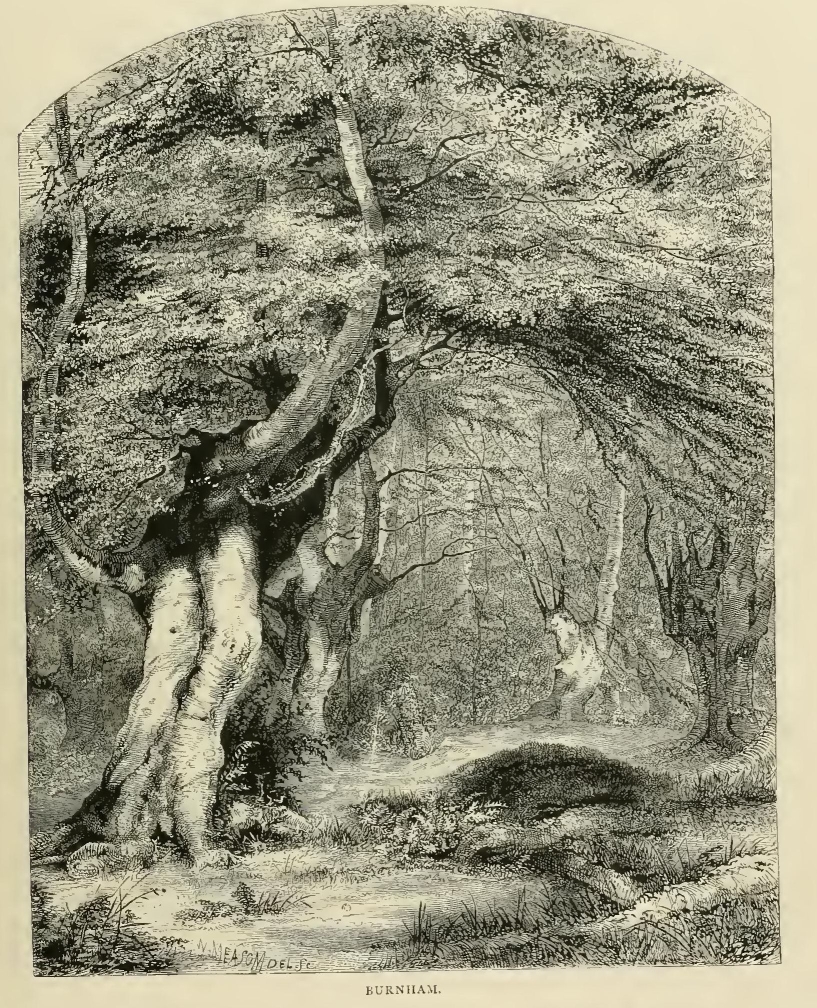
Before we bid a regretful adieu to this little forest town, we must by all means visit the new church. The noble fresco of the Ten Virgins by Leighton which forms the altar-piece, is understood to be the munificent gift of the artist. The look of sullen or of wild despair on the faces of the foolish virgins as they are rejected, and the expression of sternness blended with pity in that of the angel who repels them, may well awaken solemn thought:
"Too late! too late! ye cannot enter now!"
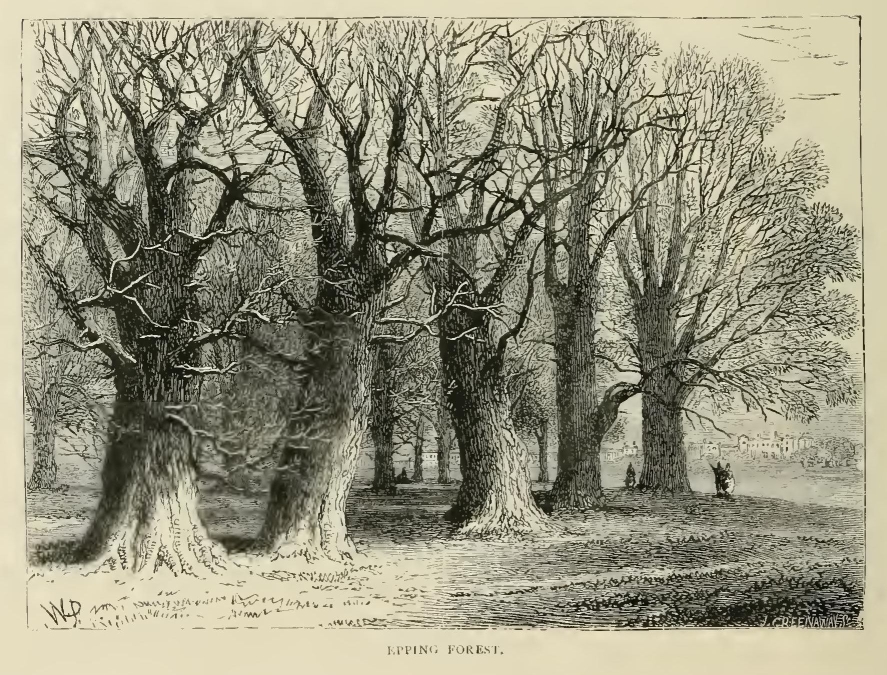
The Forest of Dean, though less extensive than the New Forest, is hardly less beautiful;—
"The queen of forests all that west of Severn lie."—Drayton.
It occupies the high ground between the valleys of the Severn and the Wye. What Lyndhurst is to the one, the Speech House is to the other. The Foresters' Courts have been held here for centuries, in a large hall panelled with dark oak and hung round with deer's antlers. Here the "verderers," foresters, "gavellers," miners, and Crown agents meet to discuss in open court their various claims in a sort of local parliament. Originally the King's Lodge, it is now a comfortable inn, affording good accommodation for the lovers of sylvan scenery. The deer with which the forest once abounded diminished in numbers up to 1850, when they were removed. But, as in the New Forest, droves of ponies and herds of swine roam at large among the trees, giving animation and interest to the landscape. A different feeling is aroused by the sight of furnaces and coal-pits in different directions, indicative of the mineral treasures hidden beneath the fair surface of this forest. Ironworks have in fact existed here from very early times; the forest-trees having, as in the Weald of Sussex, afforded an abundant supply of fuel, though (thanks to the coal-beds beneath) without the same result in denuding the district of its leafy glories.
Savernake Forest, in Wiltshire, the property of the Marquis of Ailesbury, is the only English forest belonging to a subject, and is especially remarkable for its avenues of trees. One, of magnificent beeches, is nearly four miles in length, and is intersected at one point of its course by three separate "walks" or forest vistas, placed at such angles as with the avenue itself to command eight points of the compass. The effect is unique and beautiful, the artificial character of the arrangement being amply compensated by the exceeding luxuriance of the thick-set trees, and the soft loveliness of the verdant flowery glades which they enclose. The smooth bright foliage of the beech is interspersed with the darker shade of the fir, while towering elms and majestic wide-spreading oaks diversify the line of view in endless, beautiful variety. At one point, a clump of trees will be reached—the veterans of the forest, with moss-clad trunks and gnarled half-leafless branches; the chief being known as the King Oak, but sometimes called the Duke's, from the Lord Protector Somerset, with whom this tree was a favourite. The railway from Hungerford to Marlborough skirts this forest, the southern portion of which is known as Tottenham Park. An obelisk, erected on one of its highest points, in 1781, to commemorate the recovery of George III., forms an easily-recognisable landmark, and may also guide the wanderer in the forest glades, who might else be bewildered by the very uniformity of the lone lines of foliage. On the whole, if this Forest of Savernake has not the vast extent, or the wild natural beauty of some other forests, it has all the charm that the richest luxuriance can give, while some of its noblest I trees will be found away from the great avenues, on the gentle slopes or in the mossy dells, which diversify the surface of this most beautiful domain. Nor will the visitor in spring-time fail to be delighted by the great banks of rhododendron and azalea, which at many parts add colour and splendour to the scene.
Among our smaller woodlands, Burnham Beeches claim special notice. They are reached by a charming drive of five or six miles from Maidenhead. The road leads at first through one of the most highly cultivated and fertile districts in England, and then enters Dropmore Park, with its stately avenues of cedar and pine, and some of the finest araucarias in Europe. The Beeches occupy a knoll which rises from the plain, over which it commands splendid views, Windsor Castle and the valley of the Thames being conspicuous objects in the landscape. The trees are many of them of immense girth; but having been pollarded—tradition says by Cromwell's troopers—they do not attain a great height. They are thus wanting in the feathery grace and sweep which form the characteristic beauty of the beech; but, in exchange for this, the gnarled, twisted branches are in the very highest degree picturesque, and to the wearied Londoner few ways of spending a summer's day can be more enjoyable than a ramble over the Burnham Knoll, with its turfy slopes and shaded dells, or better still, a picnic with some chosen friends in the shadow of one or other of these stupendous trees.
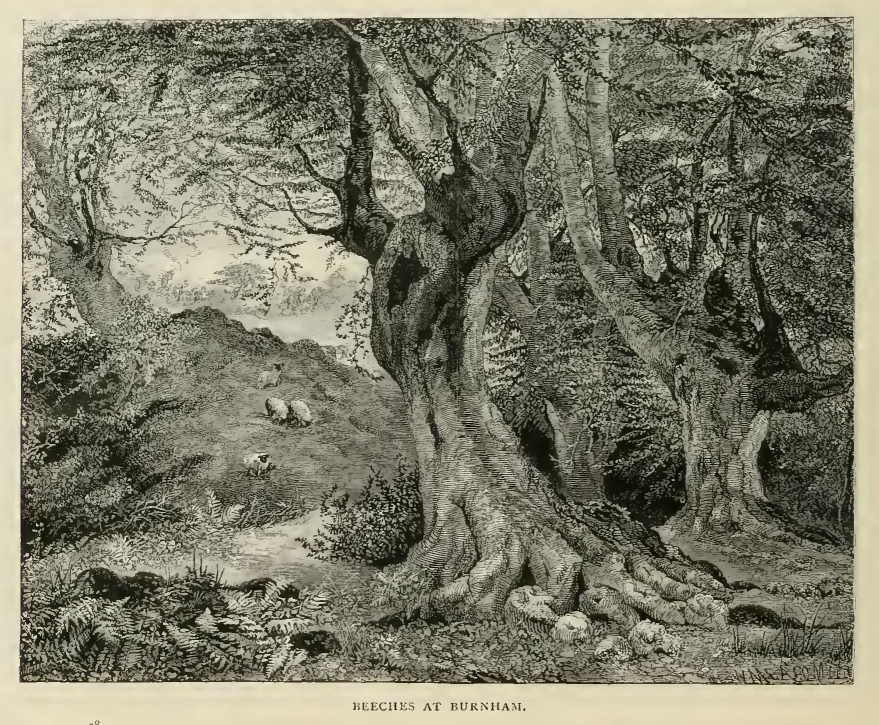
Space will not allow us to do more than refer to the forests of Epping and Hainault, Sherwood and Charnwood, Whittlebury and Delamere, with many others. The names recal the memories of happy days spent beneath their leafy screen, or in wandering over the wild moorlands on which they stand, with grateful thoughts, too, of—
"That unwearied love
Which planned and built, and still upholds this world,
So clothed with beauty for rebellious man."
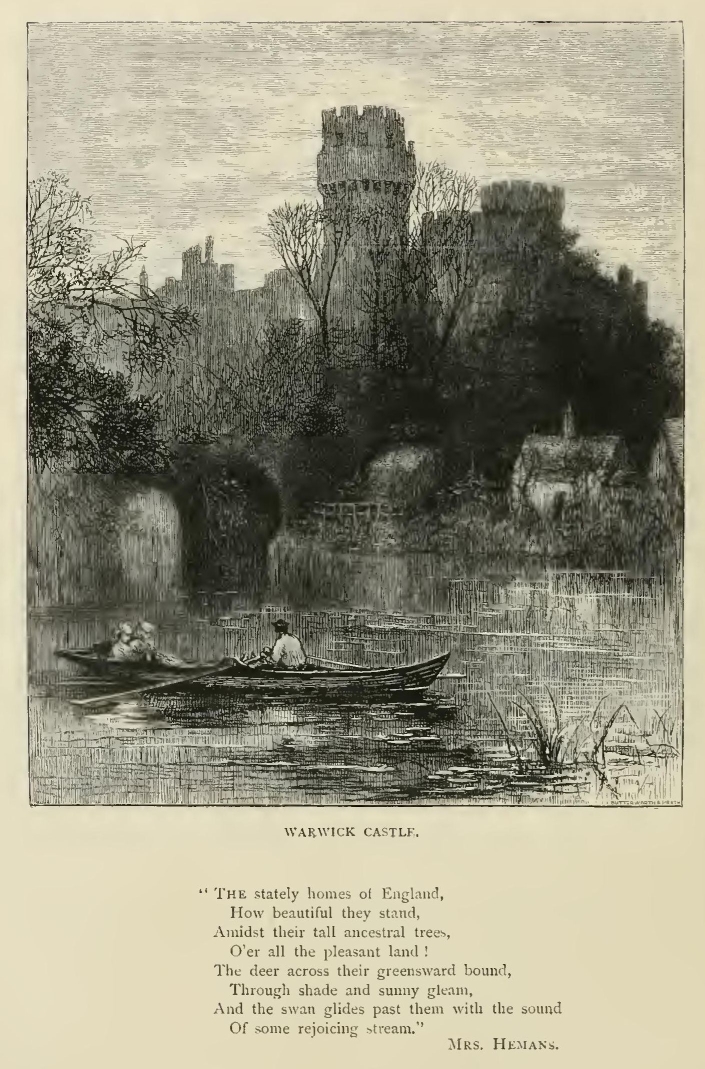
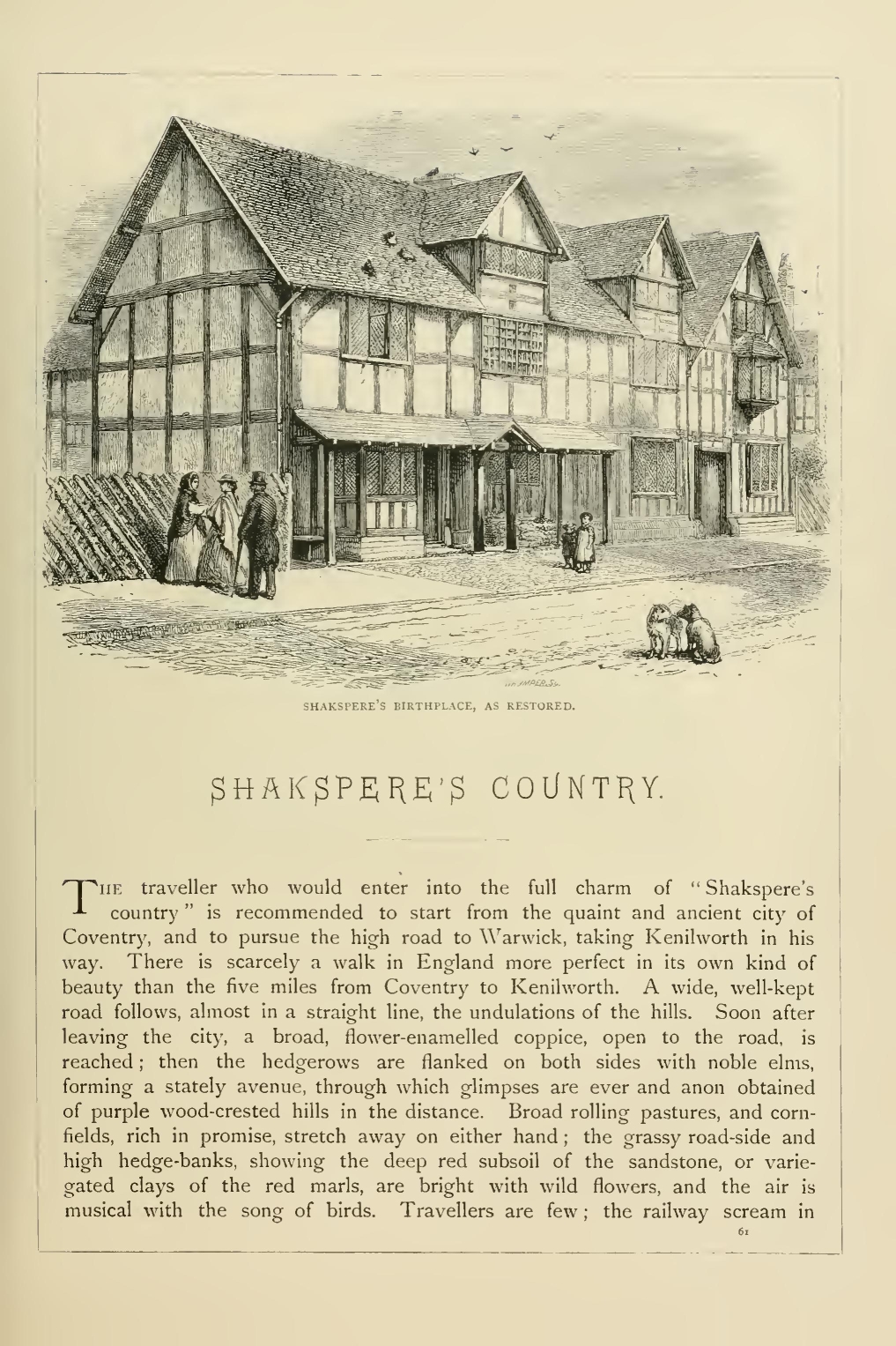
THE traveller who would enter into the full charm of "Shakspere's country" is recommended to start from the quaint and ancient city of Coventry, and to pursue the high road to Warwick, taking Kenilworth in his way. There is scarcely a walk in England more perfect in its own kind of beauty than the five miles from Coventry to Kenilworth. A wide, well-kept road follows, almost in a straight line, the undulations of the hills. Soon after leaving the city, a broad, flower-enamelled coppice, open to the road, is reached; then the hedgerows are flanked on both sides with noble elms, forming a stately avenue, through which glimpses are ever and anon obtained of purple wood-crested hills in the distance. Broad rolling pastures, and cornfields, rich in promise, stretch away on either hand; the grassy road-side and high hedge-banks, showing the deep red subsoil of the sandstone, or variegated clays of the red marls, are bright with wild flowers, and the air is musical with the song of birds. Travellers are few; the railway scream in the distance, to the left, suggests that all who are in a hurry to reach their destination have taken another route; if it be holiday time, parties of young men on Coventry bicycles are sure to flash past; but it is our delight to linger and enjoy. We are, as Thomas Fuller says, in the "Medi-terranean" part of England; and English scenery nowhere displays a more characteristic charm.
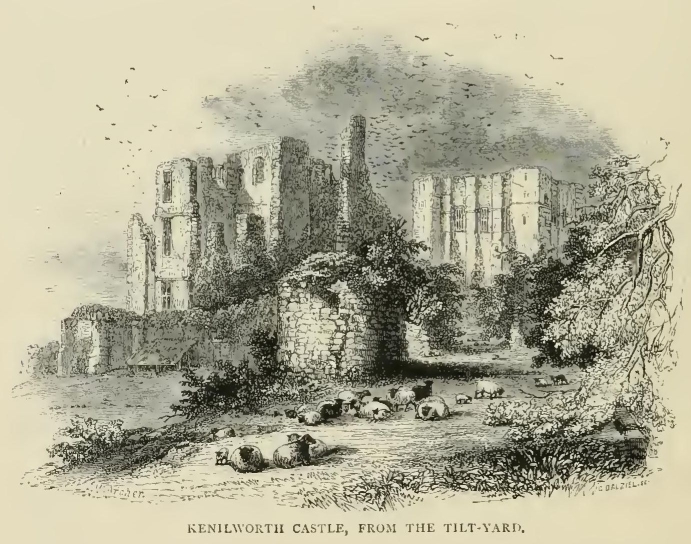
Kenilworth old church and the castle at length are reached; the latter, a stately ruin. The visitor will duly note Cćsar's Tower, the original keep, with its walls, in some parts, sixteen feet thick; then the remains of the magnificent banqueting hall, built by John of Gaunt, and, lastly, the dilapidated towers erected by Robert Dudley, Earl of Leicester, one part of which bears the name of poor Amy Robsart. No officious cicerone is likely to offer his services; a trifling gate-fee opens the place freely to all, either to rest on the greensward, or to climb the battered ramparts; to survey, at one view, the ancient moat, the castle garden, the tilt-yard, where knights met in mimic battle; the bed of the lake, where sea-fights were imitated for a monarch's sport—in short, the impressive memorials of a fashion in life and act that have long since yielded to nobler things. "The massy ruins," says Sir Walter Scott, "only serve to show what their splendour once was, and to impress on the musing visitor the transitory value of human possessions, and the happiness of those who enjoy a humble lot in industrious contentment." There are other lessons, too, national, as well as individual; and we turn away from old Kenilworth with thankfulness that the ruins of the nineteenth century will at least tell to our descendants no tales of feudal tyranny, of royal murders, or of sanguinary civil strife.
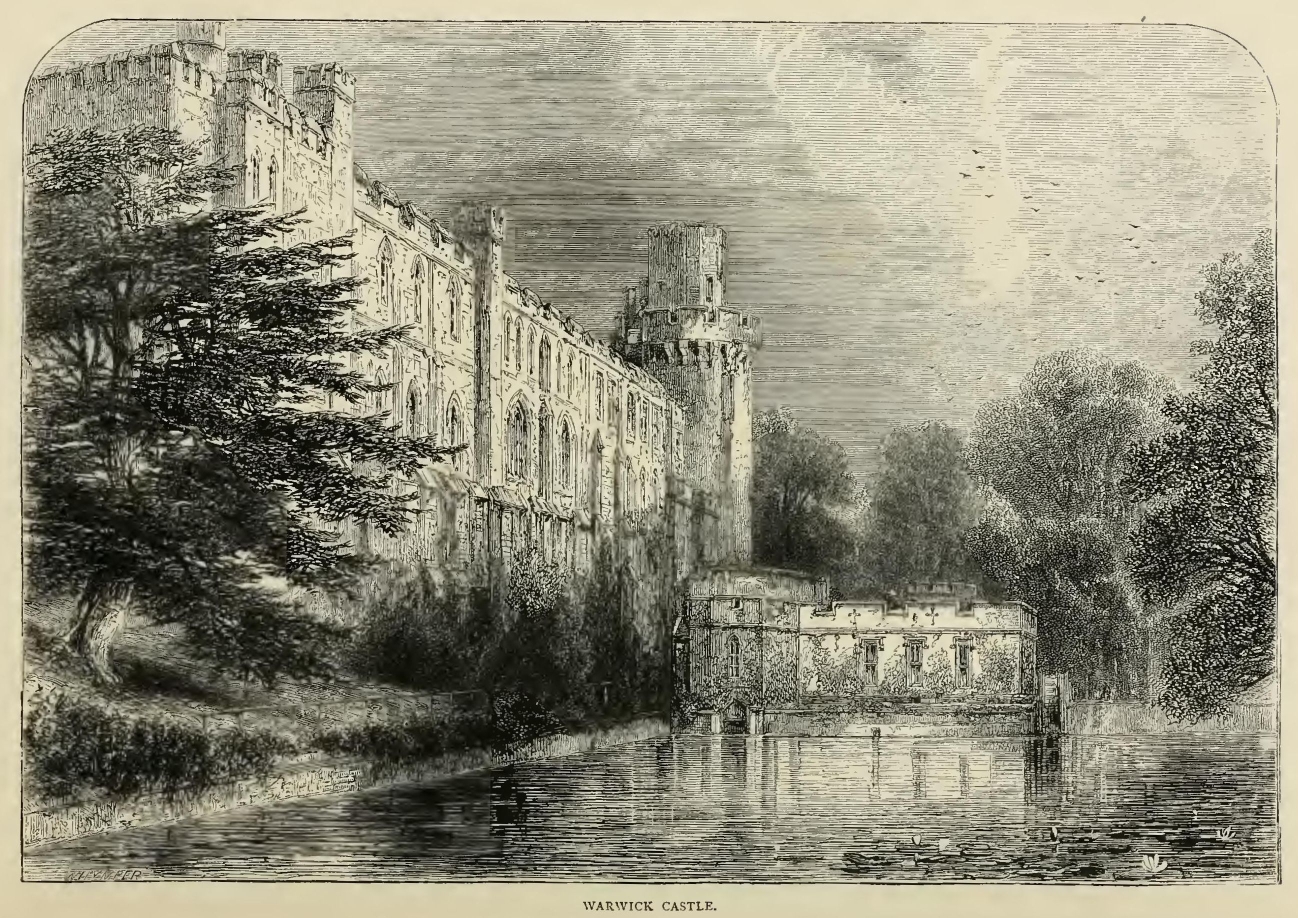
The town of Kenilworth is of considerable size, containing, at the last census, more than 3,000 inhabitants. The traveller may rest here, or in a quaint little hostelry close to the castle gates, not forgetting to visit the ancient church—that at the other end of the town is modern, and need not detain him. After due refreshment, he will probably be in the humour for another five miles' walk, or drive, along a road almost equal in beauty to that by which he came, to Warwick, calling at Guy's Cliff by the way. He had better make up his mind, for the time at least, to believe in Guy, "the Saxon giant who slew the dun cow," and, after a life of doughty deeds, retired to a hermitage, here where the Avon opens into a lake-like transparent pool, at the foot of the exquisitely-wooded cliff. The cave of the giant's retreat may be seen; and the traveller will be charmed by the fair mansion on the one side overhanging the Avon, and on the other opening down a long avenue, flowery and verdant, to the high road.
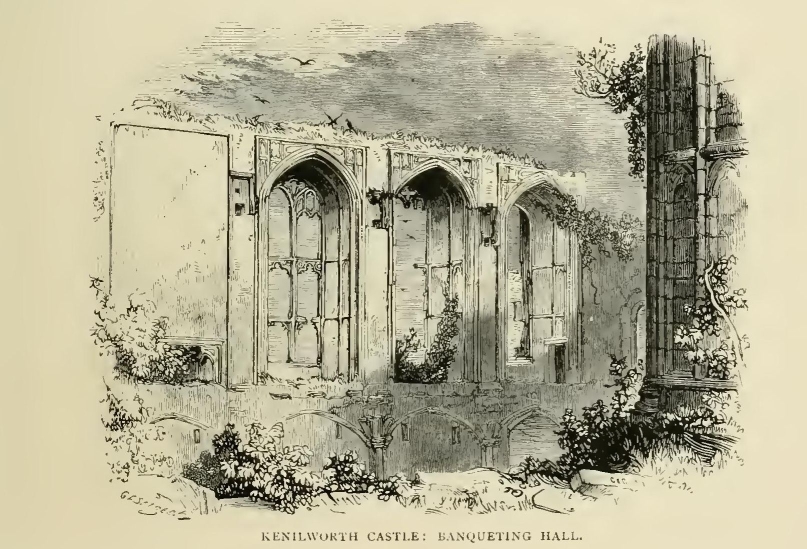
Warwick Castle is so frequently visited, that it needs little description. The winding road, cut out of the solid rock from the lodge to the castle gate, is a fitting approach to the stately fortress-palace, and well prepares the visitor for what is to follow. Some will prefer to roam the gardens, so far as watchful custodians permit, turning aside to the solid-looking Gothic conservatory to see the great Warwick vase, brought from fair Tivoli; others will follow the courteous housekeeper down the long suite of castle halls, poting the glorious views from the deep embayed windows, duly admiring the bed in which Queen Anne once slept, with the portrait of her majesty, plump and rubicund, on the opposite wall. The logs heaped up, as logs have been for centuries, in readiness for the great hall-fire, carry the mind back to olden fashions; the inlaid table of precious stones, said to be "worth" ten thousand pounds, excites a languid curiosity; the helmet of Oliver Cromwell, an authentic relic, suggests many a thought of the great brain which it once enclosed; and, while other items in the antique show pass as phantasmagoria before the bewildered attention, there are some portraits on the walls, to have seen which is a lasting pleasure of memory. It is a happy thing that these were spared by the fire of 1871; justly counted as a national calamity rather than a family misfortune. The traces of the conflagration are now almost wholly removed, although some priceless treasures have been irrecoverably lost.
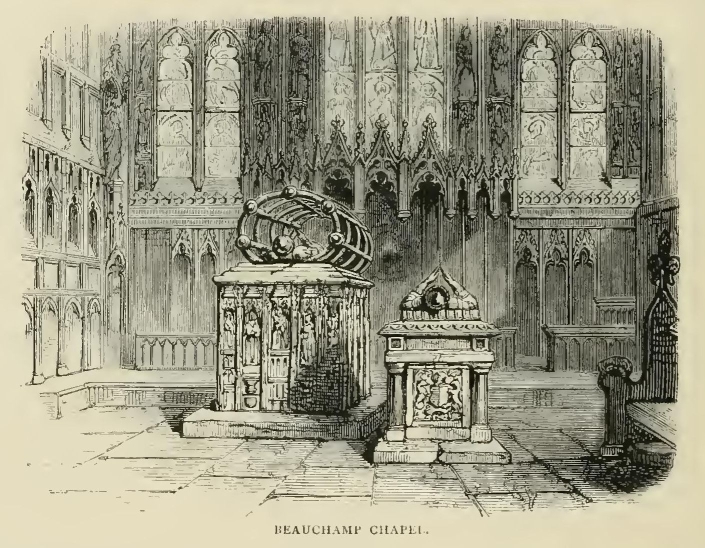
At the lodge, by the castle gate, there is a museum of curiosities, which will interest the believers in the great "Guy," and will amuse others. For there is the giant's "porridge pot" of bell-metal, vast in circumference and resonant in ring; with his staff, his horse's armour, and, to crown all, some ribs of the "dun cow" herself! What if, in sober truth, some last lingerer of a species now extinct roamed over the great forest of Arden, the terror of the country, until Sir Guy wrought deliverance?
Warwick itself need not detain us long; the church, however, demands a visit; and the Beauchamp Chapel, with its monuments, is one of the finest in England. But the pedestrian will probably elect to spend the night at Leamington, close by, before continuing his pilgrimage. A visit to the ever beautiful Jephson Gardens, with their wealth of evergreen oaks, soft turfy lawn, and broad fair water, will afford him a pleasant evening, and the next morning will see him en route for Stratford-upon-Avon.
Again let him take the road, drinking in the influence of the pleasant Warwickshire scene; quiet, rural loveliness varying with every mile, and glimpses of the silver Avon at intervals enhancing the charm. A slight détour will lead to Hampton Lucy, and Charlecote House and Park, memorable for the exploits of Shakspere's youth, and for the worshipful dignity of Sir Thomas Lucy, the presumed original of Mr. Justice Shallow. The park having been skirted, or crossed, the tourist proceeds three or four miles further by a good road, and enters Stratford-upon-Avon by a stone bridge of great length, crossing the Avon and adjacent low-lying meadows.
The bridge, which dates from the reign of Henry VII., has been widened on an ingenious plan, by a footpath, supported on a kind of iron balcony.
It is easy, however, to imagine its exact appearance when Shakspere paced its narrow roadway, or hung over its parapet to watch the skimming swallow or the darting trout and minnow.
This Warwickshire town has been so often and so exhaustively described, that we may well forbear from any minute detail. Every visitor knows, with tolerable accuracy, what he has to expect. He finds, as he had anticipated, a quiet country town, very much like other towns; neither obtrusively modern, nor quaintly antique—in one word, common-place, save for the all-pervading presence and memory of Shakspere. The house in Henley Street, where he is said to have been born, will be first visited, of course; then the tourist will walk along the High Street, noting the Shakspere memorials in the shop-windows, looking up as he passes to the fine statue of the poet, placed by Garrick in front of the Town Hall.
At the site of New Place, now an open, well-kept garden, with here and there some of the shattered foundations of the poet's house, protected by wire-work, on the greensward, the visitor will add his tribute of wonder, if not of contempt, to the twin memories of Sir Hugh Clopton, who pulled down Shakspere's house in one generation, and of the Rev. Francis Gastrell, who cut down Shakspere's mulberry-tree in another. Just opposite are the guild chapel, the guild hall, with the grammar-school where the poet, no doubt, received his education; and, after some further walking, the extremity of the town will be reached, where a little gate opens to a charming avenue of over-arching lime-trees, leading to the church.
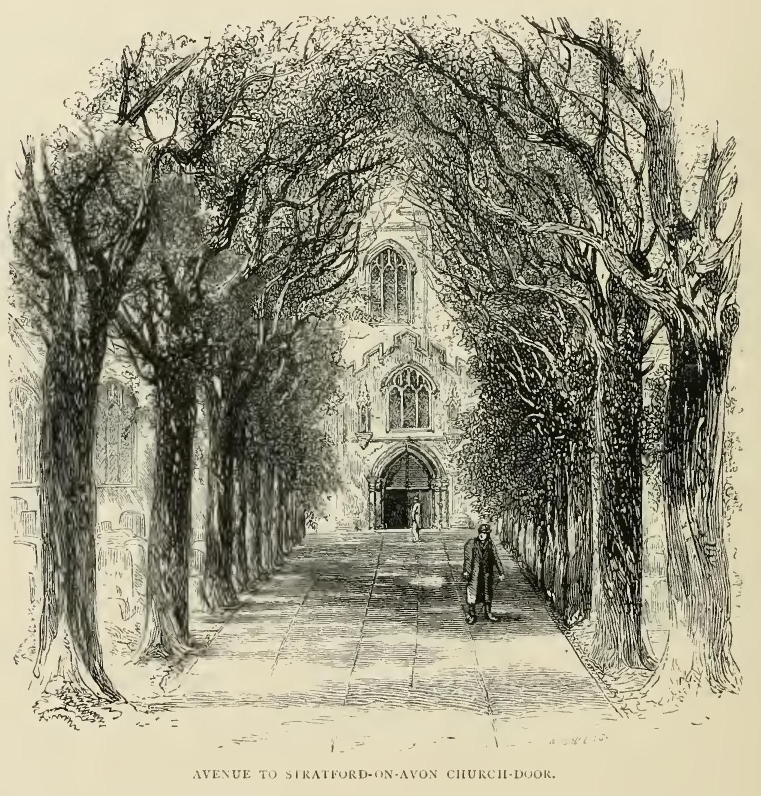
Before he enters, let him pass round to the other side, where the churchyard gently slopes to the Avon, and drink in the tranquillity and beauty of the rustic scene. Then, after gaining admission, he will go straight to the chancel and gaze upon those which, after all, are the only memorials of the poet which possess a really satisfying value, the monument and the tomb.
As all the world knows, the tomb is a dark slab, lying in the chancel, the inscription turned to the east. No name is given, only the lines here copied from a photograph:
"Good Frend for Jesvs sake forbeare
To DIGG THE DVST ENCLOASED HEAEE:
Blest be ye man v'spares thes stones,
And cvrst be he yl moves mv bones.
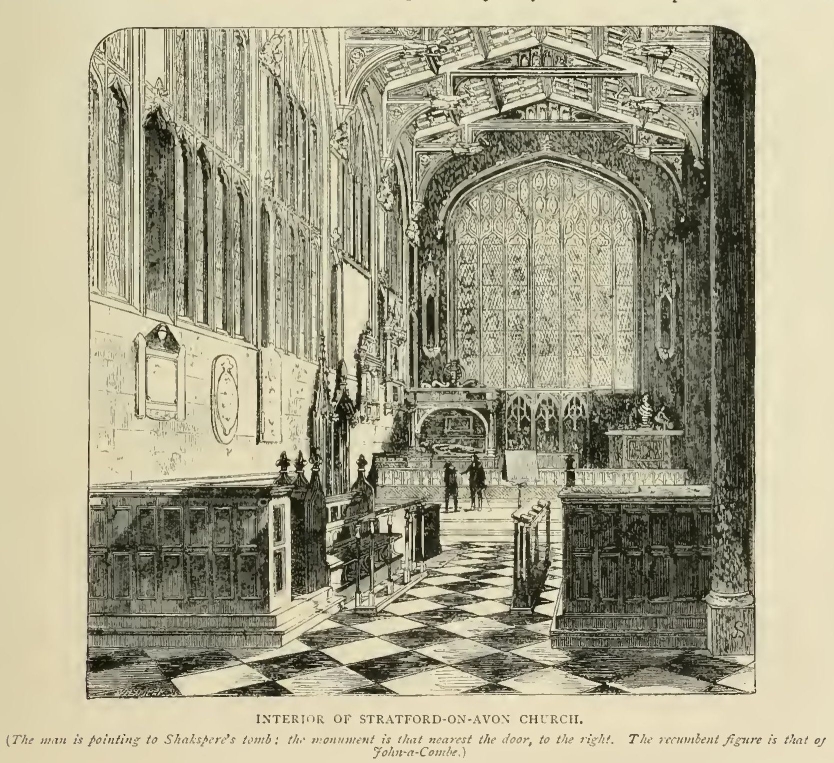
To suppose these lines written by Shakspere himself, seems absurd. They are not, indeed, the only doggrel unjustly fathered upon him. The prostrate figure on a tomb in the east wall of the chancel, representing Shakspere's contemporary and intimate, John-a-Combe, suggests another stanza, even inferior in taste and diction. But we have no room now for such thoughts. Above us, on the left, is the monument of the poet, coloured; not content with "improving" the plays, caused the bust also to be improved by a coating of white paint, how the barbarism was removed in 1861, and the statue restored, is a tale often told. The effigy certainly existed within seven years of Shakspere's death, so that, in all probability, we have a faithful representation of the poet as his contemporaries knew him.
The inscription is clumsy enough, but proves that the poet's greatness was not, as sometimes alleged, unrecognised in his own generation. The epitaph on Mistress Susanna Hall, a higher note. Thus it began
"Witty above her sex—but that's not all—
Wise to salvation, was good Mistress Hall.
Something of Shakspere was in that; but this
Wholly of Him with Whom she's now in bliss."
It is to be regretted that this inscription has been effaced, to make room for the epitaph of some obscure descendant. That to Shakespere's widow, the wife of his youth, Anne Hathaway however remains placed over Her grave by her son; there is something in it pathetically and nobly Christian. It is in Latin, and may be rendered freely: "My mother: thou gavest me milk and life: alas, for me, that I can but repay thee with a sepulchre! Would that some good angel might roll the stone away, and thy form come forth in the Saviour's likeness! But my prayers avail not. Come quickly, O Christ! then shall my mother, though enclosed in the tomb, arise and mount to heaven!"
Before leaving the church we may note some monuments worth attention, at least in any other place; as well as a stained glass window, not yet complete, but intended to illustrate from Scripture Shakspere's Seven Ages of Man. Moses the infant, Jacob the lover, Deborah the Judge, and one or two other representations are finished, but the observer feels that the types of character are not Shakspere's.
The day's explorations are not yet over. The epitaph on Anne Hathaway's tomb, if nothing else, has quickened our desire to know something more of her surroundings in those days when Shakspere won and wooed her in her rustic home. Retracing our steps through the town, we are directed to a field-path bearing straight for Shottery, a village but a mile distant. It is not difficult to picture the youthful lover, perhaps, out here in the fair open country, among the wild flowers which line the walk, and which he has so well described, for there are few traditions of Stratford-upon-Avon better authenticated than that which represents this as Shakspere's walk in the clays when he "went courting." The village is a straggling one, with a look of comfort about its farmsteads and cottages; and, at the furthest extremity from Stratford, in a pleasant dell, opposite a willow-shaded stream, we find the cottage, not much altered, it may be, in externals, since the poet, then a lad of eighteen, there found his bride. The capacious chimney-corner, where no doubt the lovers sat, is genuine; and other antique relics, from a carved bed to an old Bible, carry the mind back, at least, to the era of the poet; while the garden and orchard, with the well of pure spring water, must be much as Shakspere saw them.
And now having returned to our comfortable hotel—where almost every room, by the way, is named after one of the dramas, ours being "All's well that ends well"—what was the net result of the visit in regard to the personality and history of the great poet? It may seem a strange thing to confess, but the effect of the whole was to put Shakspere himself further from us, and to deepen the mystery which every student of his life and works finds so perplexing. For, save the monument and the tomb, there was absolutely nothing to tell of the poet's life; no scrap of his writing, no book known to have been his, no original authentic record of his words and deeds, no contemporary portrait, no object, whether article of furniture, pen, inkstand, or other implement of daily use, associated with his name. Strange that a generation, which, as we have seen, so honoured his genius and character, should not have preserved the poorest or smallest memorial of his life among them! True, there is an old, worm-eaten desk in the birth-place, at which he may have, sat in the grammar-school; in a room in the town above the seed-shop there is a rude piece of carving, representing David and Goliath, which once ornamented a room of the house in Henley Street, and bears an inscription, "said to have been composed by Shakspere," A.D. 1606. Let our readers judge:
"Goliath comes with sword and spear,
And David with his sling:
Although Goliath rage and swear
Down David doth him bring."
For the rest, the relics are evidently imported: an ancient bedstead, old-fashioned chairs, and the like; interesting in their way, but with nothing to tell us of the poet. He remains to the most zealous relic-hunter as great a mystery as Homer himself. Or if in anything here we see the poet, it is in those scenes of external nature which he has so vividly pictured. We find him among the flowers: beside the
"bank whereon the wild thyme blows,
Where oxlips and the nodding violet grows,
Quite over-canopied with luscious woodbine,
With sweet musk-roses and with eglantine."

By a happy ingenuity the garden of the house in Henley Street, now prettily and daintily kept, has been planted to a great extent with Shakspere's flowers; "pansies for thoughts," "rosemary for remembrance," with "columbines," the "blue-veined violets," the wild thyme, woodbine, musk-rose, and many more. His works are his true monument; and of these there is, in the same house, a very large and noble collection, with a whole library of literature bearing upon them, gathered with admirable care. Yet how few autobiographical details do the volumes contain! How hopeless the task of constructing, even from the sonnets, a connected picture of his life and career! And of the half-dozen anecdotes which have in one way or other descended to us of his words and ways, who can say that any detail is true?
It is, perhaps, from the portraits, after all, that we may gain the most trustworthy impression of the poet's individuality. That on the tomb is for obvious reasons the most valuable. There it has been, in the sight of all men, from the very days of Shakspere. The eyes of his widow and of their children must often have rested upon it; and there can be no doubt that it presents the true aspect of the man. The engravings of the bust, and even the photographs, seem to us to exaggerate the calm, serene expression of the countenance. Partly, it may be, from the effect of the colouring on the full and shapely cheeks, there is an air almost of joviality about the face. It is quite as easy to recognise the Warwickshire squire of New Place, as to feel the presence of the poet of all time. There is, in the Henley Street house, a portrait of extraordinary history; lately discovered. The antiquity of this portrait seems indubitable; but the face seems a copy, and, so far as we could judge without seeing the two side by side, of that on the monument. For the we naturally associate with Shakspere, we must go rather to the "Chandos portrait," now in the National Portrait Gallery, or to the terra-cotta bust, disinterred in 1845, from the site of the old theatre in Lincoln's Inn Fields, and presented by the Duke of Devonshire to the Garrick Club. In a somewhat rough fashion, the Droeshout portrait, prefixed to the first folio edition of the plays, in 1623, gives a similar impression of power; and Ben Jonson, who knew Shakspere personally, testifies strongly to its correctness:
"This figure that thou here seest put,
It was for gentle Shakspere cut;
Wherein the graver had a strife
With Nature, to outdo the Life."
But most of all is the greatness of Shakspere brought home to us by the simple record of the names of those who, from all quarters of the world, have come to this little Warwickshire town, to do homage to his memory. In all the world there is no shrine of pilgrimage like this, not only in the number of the visitants, but in their wonderful variety in character, temperament, and belief.
The power of the spell shows the magician. The fading pencilled inscriptions which cover the walls of the chamber in Henley Street; the pages of the autograph books; the words in which visitors have recorded their impressions, attest the strange attractiveness and power of this one genius. Perhaps the most interesting of the autograph books is that which was removed from the house in Henley Street many years ago, and is now to be seen in the room over the seed-room, to which we have referred already. It seems to have been purchased and presented by an American gentleman, Mr. T. H. Perkins, of Boston, in 1812; and its pages contain the autographs of Sir Walter Scott, Lord Byron, Miss Edge-a Baillie, James Professors Sedgarence," "Arthur, Duke of Wellington," with a host beside. A thoughtful hour may well be spent in turning the well-worn pages, and in meditating on "the vanity and glory of literature."
For there was one point in which even Shakspere failed, and the admiring reverence with which we join the throng of pilgrims to the shrine never passes into worship. We mean, of course, such "worship" as a merely human being may supposably claim; and, in view of the highest possibilities of our nature, we mark in Shakspere a certain limitation on the heavenward side of his genius. The point at which intellectual sympathy and admiring affection pass into adoration, is the point at which we are raised beyond ourselves, and made conscious of the infinite. Never will our moral nature consent to unite with our reason and our heart in yielding its deepest worth, reverence, until it is uplifted into that sphere in which we can only walk by faith, and from which we can look down upon earthly things dwarfed and humbled by the comparison with the illimitable beyond.
Now Shakspere's genius belongs essentially to the lower sphere. On earth he is the master. Every phase of nature, every subtilty of the intellect, every winding of the heart, is familiar to him. To use the comparison, often repeated because always felt to be so true, his wonderful mind was the mirror of all earthly shapes and various human energies. His own idiosyncracy never appears; the mirror is absolutely colourless and true. His genius is universal: in reading him we are but surveying the face of nature. To many a subtle criticism, the answer has been given, Shakspere surely never meant this! The reply may be, perhaps not, but nature meant it; and, therefore, we have a right to find it there! Such is the highest achievement of literature, whose business it is to reflect the facts of the world, of society, of the human heart—plentifully to declare the thing as it is, and compendiously to reduce this round world into the microcosm of a book. Here is Shakspere's transcendent power, and the secret of his supremacy among writers. He is simply the greatest literary man that ever lived. The transparency of the mirror, to return to the illustration, is maintained, not only by the absence of intrusive individuality, but by his perfect mastery over the instrument of expression. It is worth while to read his dramas over again, as a study of language alone. No writer has ever approached Shakspere in the precision, picturesqueness, and the finished, yet seemingly careless, beauty of his diction. His prose is even more marvellous than his poetry. In the sense in which we use the word "classic," his works may truly be called the foremost classic of the world.
What, then, is the defect which will for ever prevent Shakspere from receiving the entire homage of the heart of man? In a sentence, the mirror is turned towards earth alone, and in its very completeness hides heaven from the view. "It would be impossible," says a contemporary writer, "to find a more remarkable example of a genius wide as the world, yet not in any sense above the world, than our great English poet's." And again, "it would be almost impossible to find any great Christian poet whose type of imagination is so entirely and singularly contrasted with that of the Bible, or in whom that peculiar faculty which, for want of a better term, we are forced to call the thirst for the supernatural, is more remarkably absent."
This statement we accept, in full remembrance of the morals manifold, the theological references, and Scriptural parallels, which are scattered through the poet's writings. Bishop Wordsworth, of St. Andrew's, and others, have spent much labour, not altogether unprofitably, in showing that Shakspere knew his Bible: while, oddly enough, among the passages expunged by the estimable Bowdler, the Biblical references occupy a considerable place, as though it had been profanity to introduce them in such a connexion! The most is made of Shakspere's religiousness by the present Archbishop of Dublin, in a sermon preached at Stratford-upon-Avon at the Shakspere Tercentenary, in 1864.
He knew the deep corruption of our fallen nature, the desperate wickedness of the heart of man; else he would never have put into the mouth of a prince of stainless life such a confession as this: 'I am myself indifferently honest: but yet I could accuse one of such things that it were better my mother had not borne me.... with more offences at my beck than I have thoughts to put them in, imagination to give them shape, or time to act them in.' He has set forth the scheme of our redemption in words as lovely as have ever flowed from the lips of uninspired man:—
'Why, all the souls that live were forfeit once,
And He that might the vantage best have Look,
Found out the remedy.'
He has put home to the holiest here their need of an infinite forgiveness from Him who requires truth in the inward parts:
'How would you be,
If He, which is the top of judgment, should
But judge you as you are?'
"He was one who was well aware what a stewardship was his own in those marvellous gifts which had been entrusted to him, for he has himself told us:—
'Heaven does with us as we with torches do,
Not light them for themselves: for if our virtues
Did not go forth of us,'twere all alike
As if we had them not.'
And again he has told us that
'Spirits are not finely touched
But for fine issues:'
Assuredly not ignorant how finely his own had been touched, and what would be demanded from him in return. He was one who certainly knew that there is none so wise that he can 'circumvent God;' and that for a man, whether he be called early or late,
'Ripeness is all.'
Who shall persuade us that he abode outside of that holy temple of our faith, whereof he has uttered such glorious things—admiring its beauty, but not himself entering to worship there?
To the same effect, we may quote the preliminary sentence of Shakspere's will: "I commend my soul into the hands of God, my Creator, hoping, and assuredly believing, through the only merits of Jesus Christ, my Saviour, to be made partaker of life everlasting." With such a master of words, this avowal would be no mere formality. During Shakspere's last residence at Stratford, moreover, the town was under strong religious influences. Many a "great man in Israel," in fraternal visits to the Rev. Richard Byfield, the vicar, is said to have been hospitably entertained at New Place; and memorable evenings must have been spent in converse on the highest themes. In addition to all this, the following sonnet furnishes an interesting proof that the heart of Shakspere, at an earlier period, had not been unsusceptible to religious sentiments and aspirations:—
"Poor soul, the centre of my sinful earth,
Fooled by those rebel powers that thee array,
Why dost thou pine within, and suffer dearth,
Painting thy outward walls so costly gay?
Why so large cost, having so short a lease,
Dost thou upon thy fading mansion spend?
Shall worms, inheritors of thine excess,
Eat up thy charge? Is this thy body's end?
Then, soul, live thou upon thy body's loss,
And let that pine to aggravate thy store;
Buy terms divine in selling hours of dross;
Within be fed, without be rich no more:
So shalt thou feed on death, that feeds on men,
And, death once dead, there's no more dying then."
—Sonnet 146.
All that such words suggest we gladly admit among the probabilities of Shakspere's unknown life. But in his dramas themselves we find no assured grasp of the highest spiritual truth, nothing to show that such truth controlled his views of life with imperial sway; little or nothing to uplift the reader from the play of human passions and the entanglement of human interests to the higher realms of Faith. It is the same Shakspere who reveals the depths of human corruption, and the nobleness of human excellence. But in portraying the latter, he stops short, and fails exactly where the higher light of faith would have enabled him to complete the delineation. His best and greatest characters are a law unto themselves: his men are passionate and strong; his women are beautiful, with a loveliness that scarcely ever reminds us of heaven: he has neither "raised the mortal to the skies," nor "brought the angel down."
We turn, then, from Stratford-upon-Avon, feeling, as we have said, more deeply than ever the mystery that overhangs the career of the man, admiring, if possible, more heartily than ever the genius of the poet, and acknowledging, not without mournfulness, how much greater Shakspere might have been. For there was an inspiration within his reach that would have made him chief among the witnesses of God to men; and his magnificent endowments would then have been the richest offering ever placed by human hand upon that Altar which "sanctifieth both the giver and the gift."
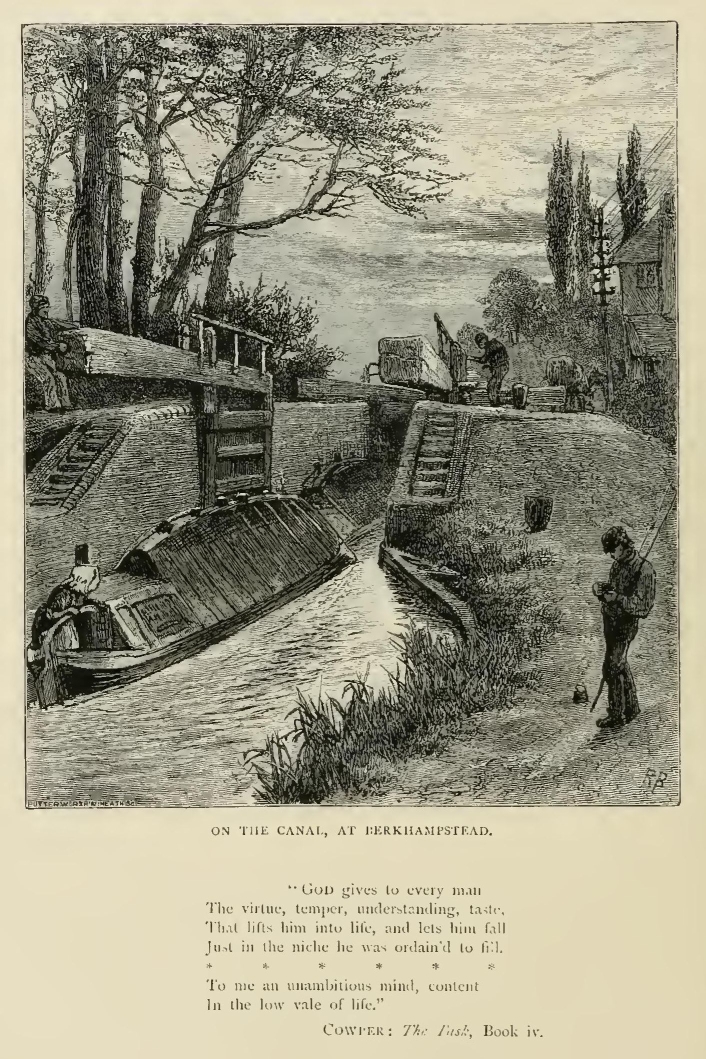
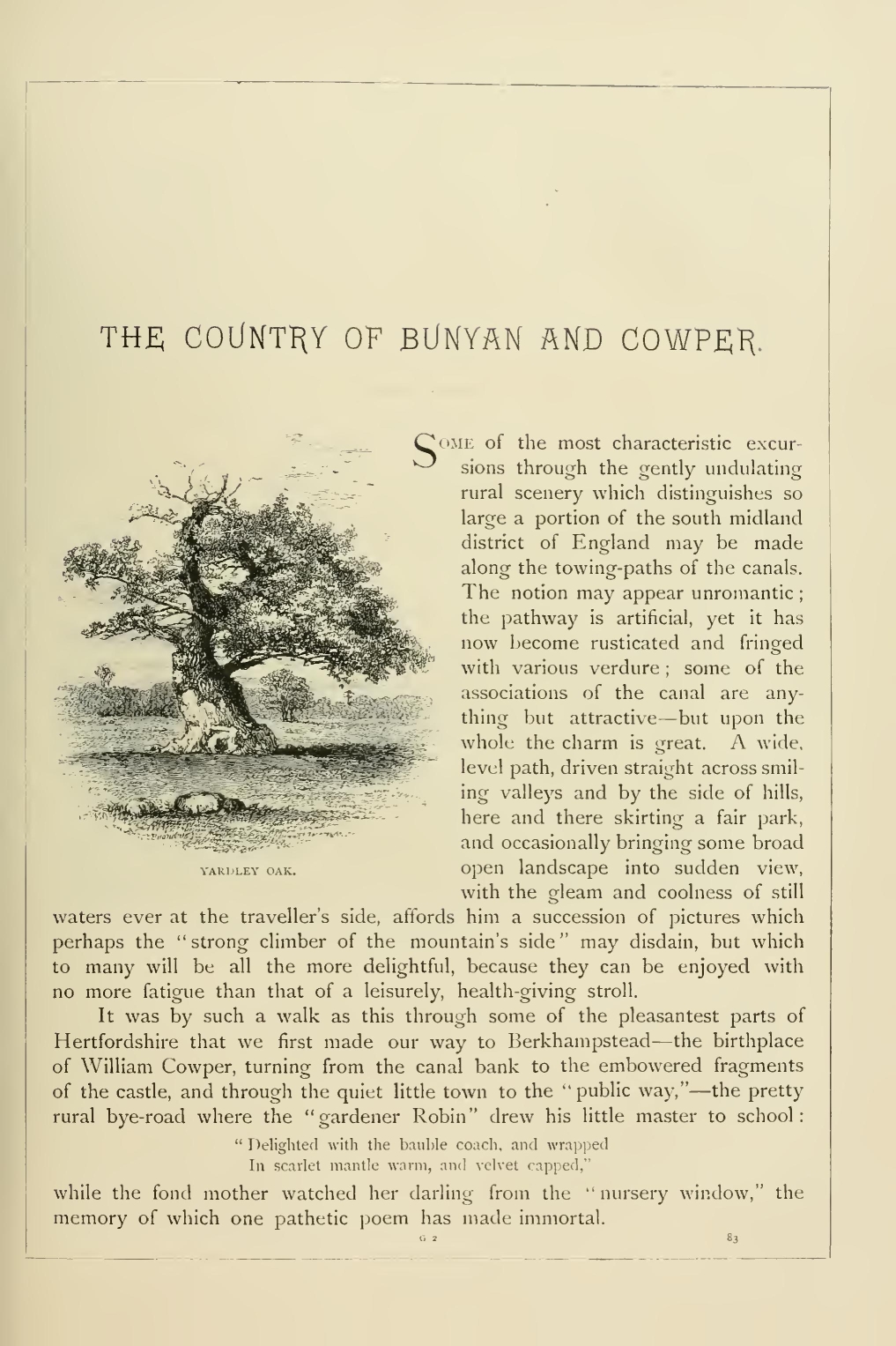
SOME of the most characteristic excursions through the gently undulating rural scenery which distinguishes so large a portion of the south midland district of England may be made along the towing-paths of the canals. The notion may appear unromantic; the pathway is artificial, yet it has now become rusticated and fringed with various verdure; some of the associations of the canal are anything but attractive—but upon the whole the charm is great. A wide, level path, driven straight across smiling valleys and by the side of hills, here and there skirting a fair park, and occasionally bringing some broad open landscape into sudden view, with the gleam and coolness of still waters ever at the traveller's side, affords him a succession of pictures which perhaps the "strong climber of the mountain's side" may disdain, but which to many will be all the more delightful, because they can be enjoyed with no more fatigue than that of a leisurely, health-giving stroll.
It was by such a walk as this through some of the pleasantest parts of Hertfordshire that we first made our way to Berkhampstead—the birthplace of William Cowper, turning from the canal bank to the embowered fragments of the castle, and through the quiet little town to the "public way,"—the pretty rural bye-road where the "gardener Robin" drew his little master to school:
"Delighted with the bauble coach, and wrapped
In scarlet mantle warm, and velvet capped,"
while the fond mother watched her darling from the "nursery window," the memory of which one pathetic poem has made immortal.
In a well-known sentence, Lord Macaulay affirms in reference to the seventeenth century, "We are not afraid to say, that though there were many clever men in England during the latter half of that century, there were only two minds which possessed the imaginative faculty in a very eminent degree. One of these minds produced the Paradise Lost; the other, the Pilgrim's Progress." Similarly, with regard to the brilliant literary period which began towards the close of the eighteenth century, "we are not afraid to say," that although there were many poets in England of no mean order, there were but two to whom it was given to view nature simply and sincerely, so as adequately to express "the delight of man in the works of God." One of these poets produced the Task, the other the Exclusion.
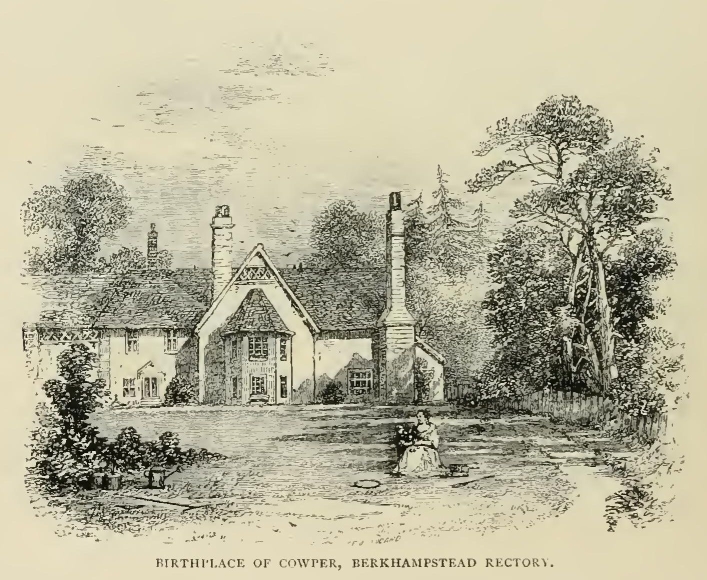
When Macaulay wrote, the place of Bunyan in literature was still held a little doubtful; the place of Cowper among poets is not wholly unquestioned now. Some are impatient of his simplicity, others scorn his piety, many cannot escape, as they read, from the shadow of the darkness in which he wrote. But we cannot doubt that, when the coming reaction from feverishness and heathenism in poetry shall have set in, the name of Cowper will win increasing honour; men will search for themselves into the source of those bright phrases, happy allusions, "jewels five words long, that on the stretched forefinger of all time sparkle for ever," for which the world is often unconsciously indebted to his poems; while his incomparable letters will remain as the finest and most brilliant specimens of an art which penny-postage, telegrams, and post-cards have rendered almost extinct in England.
No one at any rate will wonder now that we should turn awhile from more outwardly striking or enchanting scenes to the ground made classic and sacred to the English Christian by the memories of Bunyan and Cowper. We may associate their names, not only from their brotherhood in faith and teaching, but from the coincidence which identifies their respective homes with one and the same river, and blends their memories with the fair still landscapes through which it steals.
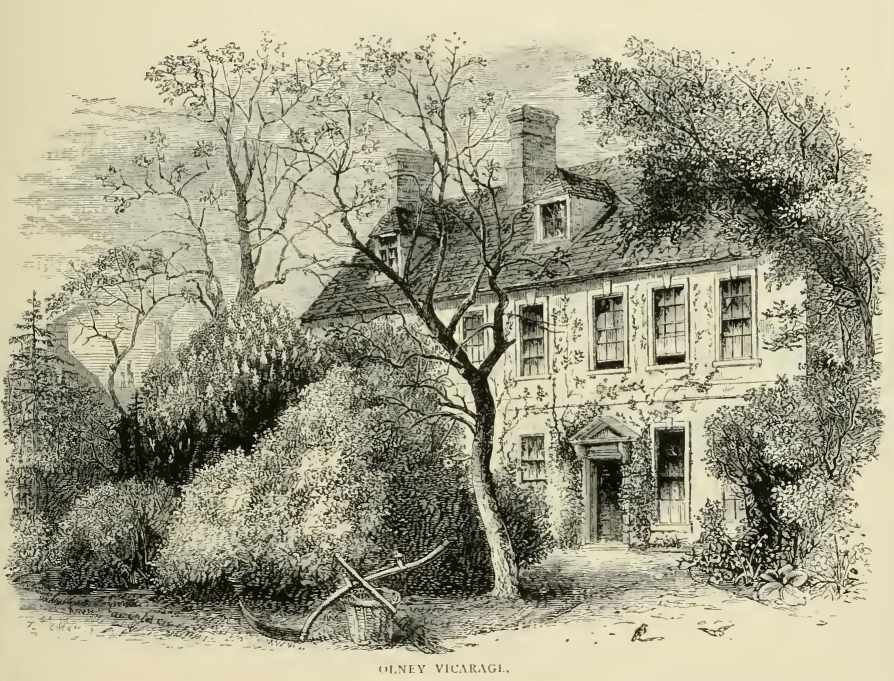
The Ouse, most meandering of English streams, waters a country almost perfectly level throughout, though here and there fringed by the undulations of the receding Chilterns;—with a picturesqueness derived from rich meadows, broad pastures with flowery hedgerows, and tall stately trees; while in many places the still river expands into a miniature lake, with water lilies floating upon its bosom. Among scenes like these the great dreamer passed his youth, in his village home at Elstow; often visiting the neighbouring town of Bedford, where we may picture him as leaning in many a musing fit over the old Ouse Bridge, on which the town prison then stood. How little, did John Bunyan then think what those prison walls would become to him and to the world! The bridge is gone, the town has become a thriving modern bustling place; only the river remains, and the country walk to Elstow is little changed. There is the cottage which tradition identifies with Bunyan: with the church and the belfry, so memorable in the record of his experiences, the village green on which in his thoughtless youth he used to play at "tip-cat:" there is nothing more to see, but it is impossible to pace through those homely ways without remembering how once the place was luminous to his awe-stricken spirit with "the light that never was on sea or shore," and the landscape on which his inward eye was fixed was that which was closed in by the great white throne.
It is remarkable that there is in Bunyan's writings so little of local colouring. His fields, hills and valleys are not of earth. The "wilderness of this world" through which he wandered was something quite apart from the Bedfordshire flats, although indeed "the den" on which he lighted is but too truthful a representation of the prison on the old Ouse Bridge. Even where familiar scenes may have supplied the groundwork of the picture, incidental touches show that his soul was beyond them. His hillsides are covered with "vineyards;" the meadows by the riverside are fair with "lilies;" the fruits in the orchard have mystic healing virtue. The scenery of Palestine rather than of Bedfordshire is present to his view, and his well-loved Bible has contributed as much to his descriptions as any reminiscences of his excursions around his native place. *
* It has recently been argued, with some plausibility, that
Bunyan may have derived some of his pictures of scenery from
his preaching excursions to the Surrey hills and the Sussex
Weald (see pp. 33-35), where he would often cross the track
of "the Canterbury pilgrims." "It is said that he frequently
selected the hilly districts of South Surrey as his hiding-
place; two houses, one on Quarry Hill, Guildford, and the
other known as Horn Hatch, on Shalford Common, being pointed
out as among those he occupied.".... "The struggles of the
pedestrian through the Shalford swamp might have given
Bunyan the original idea of the Slough of Despond; the
Surrey Hills he loved so well might be called the
Delectable Mountains; St. Martha's Hill would answer
perfectly his description of the Hill Difficulty; the Vale
of Albury, amid the picturesque scenery of which he passed
so many days of true humiliation, might be considered the
Valley of Humiliation; and lastly, the name Doubting
Castle actually exists to this day, near the Pilgrims' Way,
being approached, as its namesake was supposed lo be, by a
path near Box Hill. It is right, however, to state that the
antiquity of the last name quoted is not verified."—Notes
on the Pilgrims' Way in West Surrey; by Captain E. Renouard
James, R.E. Stanford, 1871.
But it was after all in no earthly walks or haunts of men that he found the prototypes of his immortal pictures. They are idealised experiences, and from the Wicket gate to the Land of Beulah they all represent what he had seen and felt only in his soul.* No doubt the people are in many cases less abstract. A very remarkable edition of the Pilgrim's Progress, published some years ago by an artist of rare promise, since deceased, portrayed the personages of the allegory in the very guise in which Bunyan must often have met their originals up and down in Bedfordshire. Such faces may be seen to-day. We ourselves thought we saw Mr. Honesty, in a brown coat, looking at some bullocks in the Bedford market-place. Ignorance tried to entice us into a theological discussion at the little country-side inn where we rested for the night: the next morning, as we passed along, Mercy was knitting at a farmhouse door, while young Mr. Brisk, driving by in his gig, made her an elaborate bow, of which we were glad to see she took the slightest possible notice.
* The impression made upon a passing traveller through
Bunyan's Country is well expressed in some verses entitled
Bedford is now at least rich in memorials of its illustrious citizen and prisoner for conscience' sake. The Bunyan Statue, presented by the Duke of Bedford, was erected in 1874, and is one of the noblest and most characteristic out-of-door monuments in England. It has indeed been suggested that Bunyan might more appropriately have been represented in the attitude of writing than in that of preaching; but it should be remembered that the latter was the work he chose and loved, and that his greatest works were penned during the period of enforced silence. It is therefore with a fine appropriateness that he is represented as standing, as if in the presence of some vast congregation, the Bible in his hand, his eyes uplifted to heaven, while upon the pedestal are carved his own words, expressive of his own highest ideal.
"THROUGH BEDFORDSHIRE BY RAIL.
"Far behind we leave the clangour of the smoky northern town;
Now' we hurry through a country all brown-green and sweet grey-brown:
Landscapes gently undulating where light shadows softly pass,
Quiet rivers silent flowing through the rarely-trodden grass.
Here and there a few sheep grazing 'neath the hedgerow poplars tall.
Here and there a brown-thatched homestead or a rustic cottage small;
As we rush on road or iron through the fields on either hand,
In the autumn twilight gravely smiles John Bunyan's land.
More than all the fells and mountains we have passed upon our way,
More than e'en that giant city we shall greet ere close of day,
Touches us the tender beauty, soft, harmonious, simple, quaint,
Of these fields and winding bye-lanes where yet linger, sweet and faint,
Echoes of long-vanished ages, rustic homes one might have seen
In the old days when John Bunyan played at cat on Elstow Green,
Meadows still as when he wandered seeking God; while on each hand,
Gravely smiling in the twilight, lay John Bunyan's land.
Tender as the closing music of the Mighty Dreamer's lay,
Lies the country gently round us, all brown-green and soft brown-grey.
Tender are our thoughts towards it, as we ponder o'er the book
That has travelled through the wide world from this homely, rural nook.
Tenderly we name John Bunyan, martyr, poet, hero, saint,
Faithful pastor, strong and loving, like his Bedford, simple, quaint.
Ah! the happy tears half blind us as we gaze on either hand
O'er the gravely smiling beauty of John Bunyan's land."—Lizzie Aldridge.
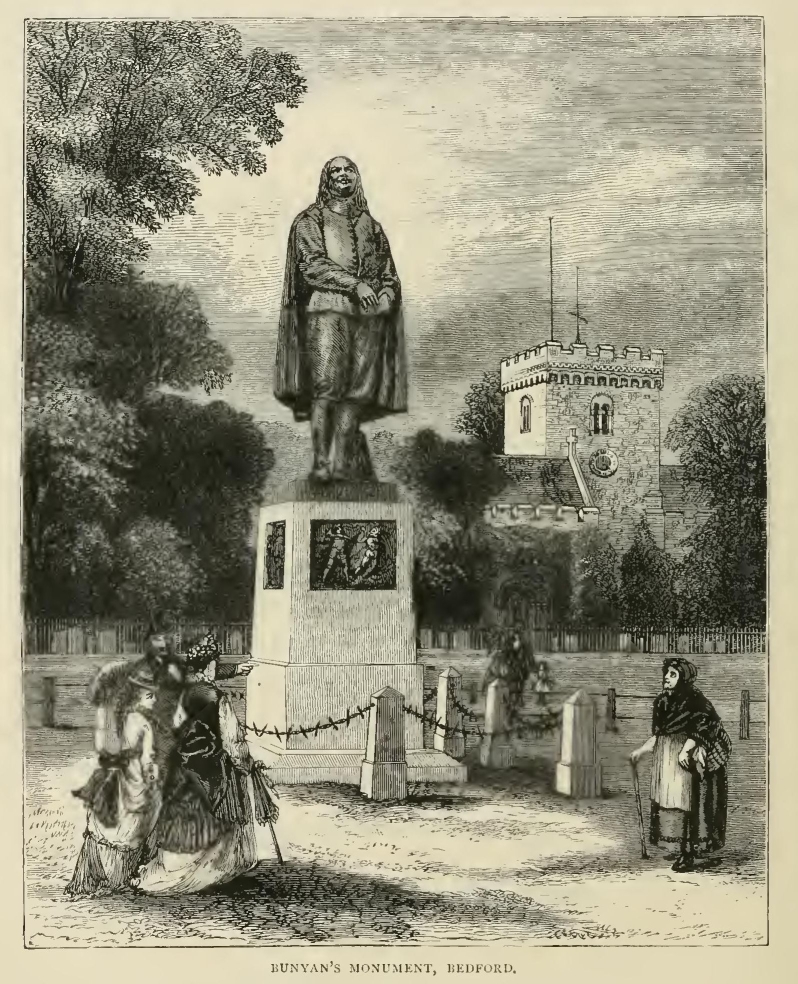
No visitor to Bedford will neglect the rapidly accumulating Bunyan Museum, comprising not only some simple relics of his lifetime, as his staff, jug, and the like, with books bearing his autograph—his priceless Bible and Foxes Martyrs—but the various editions of his works, and in particular a collection of the illustrations of the Pilgrim's Progress, from the first rude designs to the latest products of artistic skill. These are stored with reverent care, in connexion with the place of worship occupied by the Christian Church to which he ministered, and now known as Bunyan Meeting. To this edifice, likewise, a pair of massive bronze gates have been contributed by the Duke of Bedford, with panels illustrative of scenes from the allegory.

Altogether, if we have found in the neighbourhood of Bedford no Delectable Mountains, nor Valley of Humiliation, nor Land of Beulah, we have at least seen much pleasant English scenery, a fertile, well-cultivated country, and in the very absence of more outwardly exciting prospects, have had the more "leisure of thought" to dwell in the ideal world which Bunyan has made as familiar to us as our own home.
From Bedford to Olney the distance by rail is between ten and eleven miles; by "the sinuous Ouse" probably between thirty and forty.
Few travellers, therefore, will care to ascend by the river banks, and the frequent shallows preclude the thought of a boating excursion, which otherwise would by its leisurely length be some preparation for our exchange of the associations of the seventeenth century for those of the eighteenth. One hundred and three years separated the birthday of Bunyan from that of Cowper.
The interval marks the greatest advance that had ever been made in the history of English thought and freedom. But in the essentials of faith and teaching the two men were one; nor in some of their experiences were they very dissimilar. Both were sensitive, conscientious, and often in the midst of their holiest longings after God were most terror-stricken by thoughts of the wrath to come. Some pages of Bunyan's Autobiography may compare in their passionate anxiety with the annals of Cowper's despair. The great dreamer soon escaped from Doubting Castle to the Delectable Mountains; but for the poet, the dungeon bars remained unloosed until the final summons came to the everlasting hills. *
* "From the moment of Cowper's death, till the coffin was
closed," writes his friend and relative Mr. Johnson, "the
expression with which his countenance had settled was that
of calmness and composure, mingled, as it were, with holy
surprise."—Southey's Life.
The sensitiveness of Cowper to external influences was so great, as to raise the doubt whether other scenes and a different atmosphere might not have prevented many of his sorrows.
On the death of his father, when the poet had reached the age of twenty-five, he touchingly and expressively tells us that it had never till then occurred to him "that a parson has no fee-simple in the house and glebe he occupies. There was," he says, "neither tree, nor gate, nor stile in all that country to which I did not feel a relation, and the house itself I preferred to a palace." To Huntingdon, where he first made acquaintance with the Ouse, and became an inmate with the Unwins, he clung very lovingly, although he does not rate the charms of the neighbourhood very highly. "My lot is cast in a country where we have neither woods nor commons nor pleasant prospects: all flat and insipid; in the summer adorned only winter covered with a flood." But it was at Olney that Cowper found such scenery as he could appreciate and love. "He does not," in the words of Sir James Mackintosh, "describe the most beautiful scenes in nature; he discovers what is most beautiful in ordinary scenes."
In fact, Cowper saw very few beautiful scenes, but his poetical eye, and his moral heart, detected beauty in the sandy flats of Buckinghamshire." The walk, especially, from the quiet little town to the village of Weston Underwood, he has made classic among English scenes by the description in the first book of the Task.
Leaving Olney, where, in truth, there is not much to detain us, save the poet's home—the same in outward aspect, at least, as during the twenty years spent by him within its walls,—and the summer-house in the garden where he sat and wrote, while Mrs. Unwin knitted, and Puss, Tiny, and Bess sported upon the grass—we may climb the little eminence above the river, and with an admiration like that of the poet ninety years ago, "dwell upon the scene." "Here is the "distant plough slow moving," and
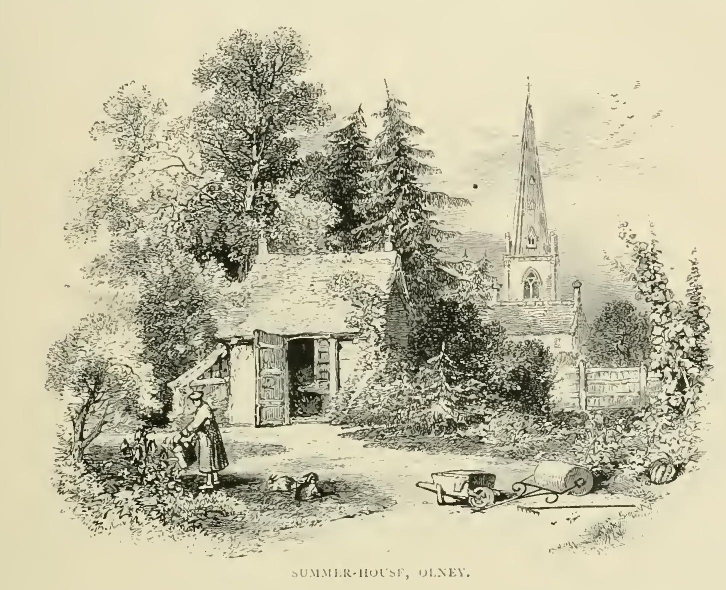
"Here Ouse, slow winding through a level plain
Of spacious meads, with cattle sprinkled o'er,
Conducts the eye along his sinuous course Delighted.
There, fast rooted in their bank,
Stand, never overlooked, our favourite elms.
That screen the herdsman's solitary hut;
While far beyond, and overthwart the stream,
That, as with molten glass, inlays the vale,
The sloping land recedes into the clouds;
Displaying on its varied side the grace
Of hedgerow beauties numberless, square tower,
Tall spire, from which the sound of cheerful bells
Just undulates upon the listening ear;
Groves, heathes and smoking villages remote."
We are now at the upper corner of the Throckmorton Park. Pursuing our way, we listen to the music of "nature inanimate," of rippling brook or sighing wind, and of "nature animate," of "ten thousand warblers" that so soothed the poet's soul. A dip in the walk from where the elms enclose the upper park, and the chestnuts spread their shade, brings us into a grassy dell where by "a rustic bridge" we cross to the opposite slope, reascend to the "alcove," survey from the "speculative height" the pasture with its "fleecy tenants," the "sunburnt hayfield," the "woodland scene," the trees, each with its own hue, as so exquisitely depicted by the poet, while Ouse in the distance "glitters in the sun." At length the great avenue is reached.
"How airy and how light the graceful arch,
Yet awful as the consecrated roof
Re-echoing pious anthems! while beneath,
The chequered earth seems restless as a flood
Brushed by the wind.
So sportive is the light
Shot through the boughs, it dances as they dance,
Shadow and sunshine intermingling quick,
And darkening and enlightening, as the leaves
Play wanton, every moment, every spot.
Such were the scenes dearest to Cowper, and dear to many still for his sake. T rue, they are not unlike others. A thousand scenes are as beautiful, and many an avenue up and down in English parks is of a nobler stateliness. Yet may this be visited with a special delight, for its own sake and for Cowper's. It is something to be able to look with a poet's eye, to have his thoughts and words so familiar to memory as to blend with the current of our own, as if spontaneously. We learn anew how to observe, and our emotions become almost unconsciously ennobled and refined.
It is characteristic of Cowper's mind that scenery of a loftier and more exciting order had a disquieting effect upon him. Of his journey to Eastham, in Sussex, to visit his friend Hayley, he writes: "I indeed myself was a little daunted by the tremendous height of the Sussex hills, in comparison with which all that I had seen elsewhere are dwarfs. But I only was alarmed; Mrs. Unwin had no such sensations, but was always cheerful from the beginning of our expedition to the end of it." And again: "The charms of the place, uncommon as they are, have not in the least alienated my affections from Weston. The genius of that place, suits me better; it has an air of snug concealment, in which a disposition like mine feels peculiarly gratified, whereas here, I see from every window woods like forests, and hills like mountains—a wildness, in short, that rather increases my natural melancholy." A little while before, on Mr. Newton's return from the glories of Cheddar, Cowper writes: "I would that I could see some of the mountains which you have seen, especially because Dr. Johnson has pronounced that no man is qualified to be a poet who has never seen a mountain. But mountains I shall never see, unless perhaps in a dream, or unless there are such in heaven. Nor those," the poor, heart-stricken poet makes haste to add, "unless I receive twice as much mercy as ever yet was shown to any man."
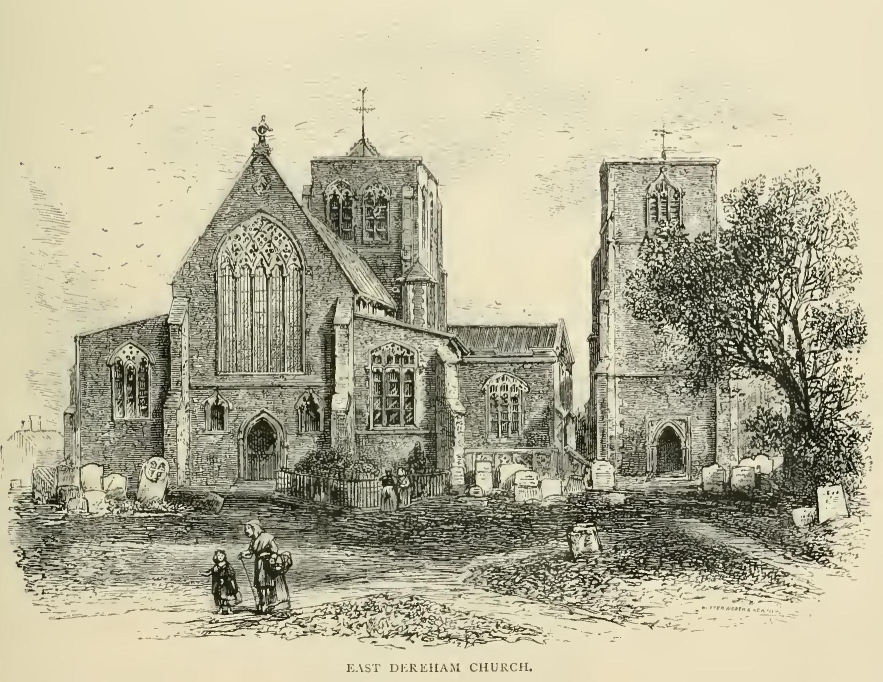
The last sentence prepares us for East Dereham, with its sad associations. But even from these we need not shrink. The homely Norfolk town brought to the troubled soul deliverance. Few, it may be, would turn aside to visit the place for its own sake; but the remembrance of the poet may well attract. The house in which he died has been replaced by a Congregational Church bearing his name—twin brother, so to speak, though with scarcely the same appropriateness, to Bunyan Chapel in Bedford. But it is in the church where he lies buried, and in the tomb raised to his memory, that the true interest lies. Never was death more an angel of mercy than to this darkly-shadowed spirit. We all know the words in which the most gifted of poetesses, at "Cowper's Grave," has set the thoughts of many Christian hearts to words that deserve to be immortal:
"Like a sick child that knoweth not his mother while she blesses,
And drops upon his burning brow the coolness of her kisses:
That turns his fevered eyes around—My mother! where's my mother?
As if such tender words and looks could come from any other!
The fever gone, with leaps of heart he sees her bending o'er him,
Her face all pale from watchful love, the unweary love she bore him!
Thus woke the poet from the dream his life's long fever gave him,
Beneath those deep pathetic eyes, which closed in death to save him!
Thus? oh, not thus! no type of earth could image that awaking,
Wherein he scarcely heard the chant of seraphs round him breaking,
Or felt the new immortal throb of soul from body parted,
But fell those eyes alone, and knew. My Saviour! not deserted!"
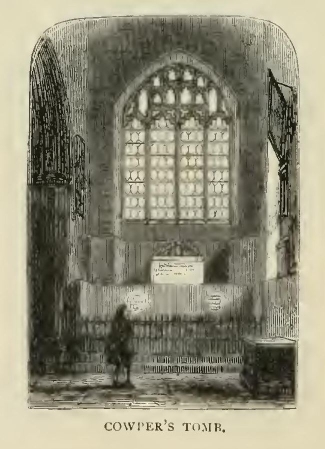
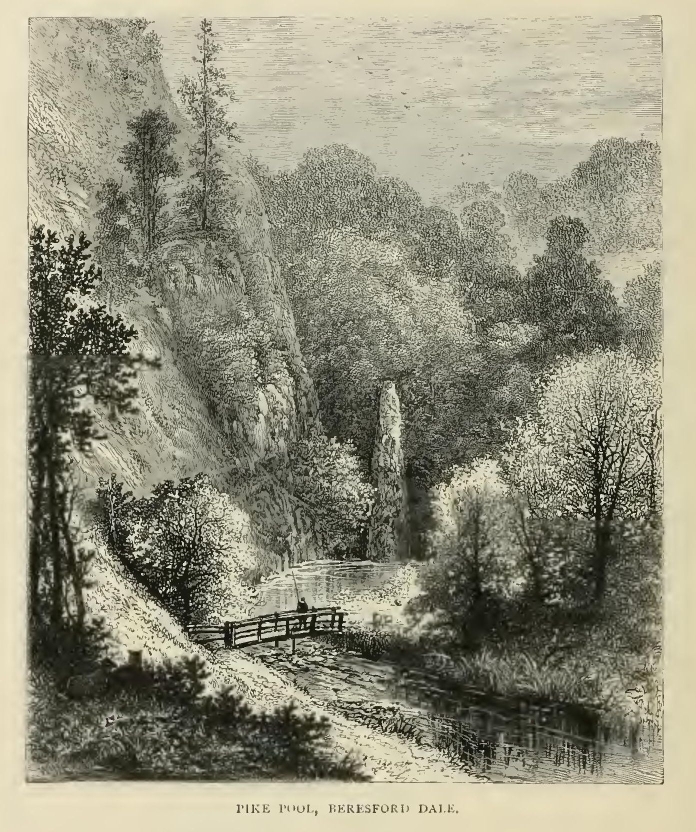
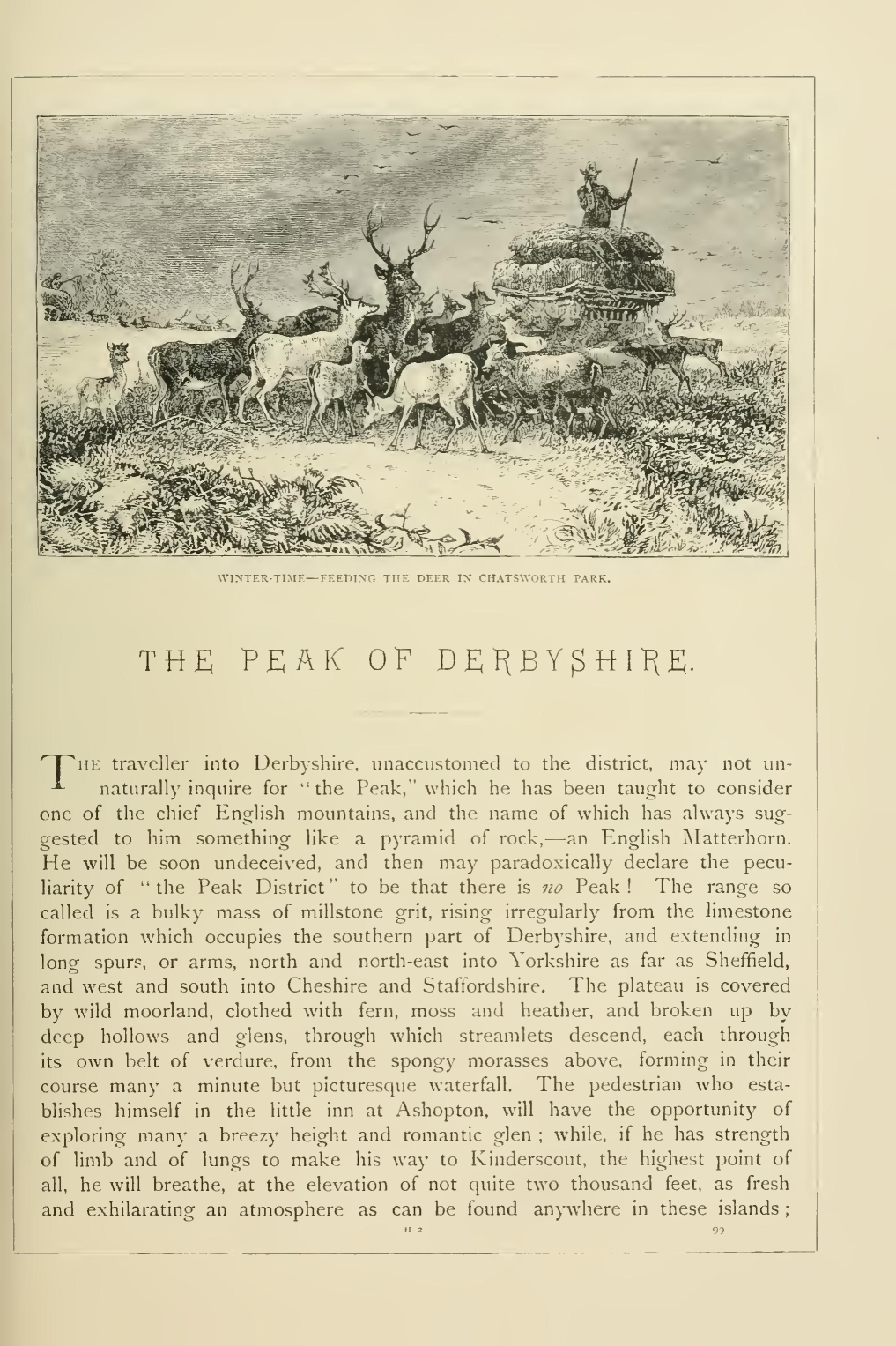
THE traveller into Derbyshire, unaccustomed to the district, may not unnaturally inquire for "the Peak," which he has been taught to consider one of the chief English mountains, and the name of which has always suggested to him something like a pyramid of rock,—an English Matterhorn. He will be soon undeceived, and then may paradoxically declare the peculiarity of "the Peak District" to be that there is no Peak! The range so called is a bulky mass of millstone grit, rising irregularly from the limestone | formation which occupies the southern part of Derbyshire, and extending in long spurs, or arms, north and north-east into Yorkshire as far as Sheffield, and west and south into Cheshire and Staffordshire. The plateau is covered by wild moorland, clothed with fern, moss and heather, and broken up by deep hollows and glens, through which streamlets descend, each through its own belt of verdure, from the spongy morasses above, forming in their course many a minute but picturesque waterfall. The pedestrian who establishes himself in the little inn at Ashopton, will have the opportunity of exploring many a breezy height and romantic glen; while, if he has strength of limb and of lungs to make his way to Kinderscout, the highest point of all, he will breathe, at the elevation of not quite two thousand feet, as fresh and exhilarating an atmosphere as can be found anywhere in these islands; the busy smoky city of Manchester being at a distance, "as the crow flies," of little more than fifteen miles! It is no wonder that a select company of hard-worked men, who have lighted on this nook among the hills, having a taste for natural history, resort hither year after year, finding a refreshment in the repeated visit equal at least to that which their fellow-citizens enjoy, at greater cost, in the terraces of Buxton, or on the gigantic slope of Matlock Bank.
Where the limestone emerges from under the mass of grit, the scenery altogether changes. For roughly-rounded, dark-coloured rocks, covered with ling and bracken, now appear narrow glens, bold escarped edges, cliffs splintered into pinnacles and pierced by wonderful caves traversed by hidden streams. Of these caves the "Peak Cavern" at Castleton is the largest, that of the "Blue John Mine" the most beautiful, from its veins of Derbyshire spar.
The tourist, however, who confines himself to the Peak District proper, with its immediately outlying scenery, will have a very inadequate view of the charms of Derbyshire. He can scarcely do better than begin at the other extremity, ascending the Dove through its limestone valley as far as Buxton, thence taking rail to Chapel-en-le-Frith, expatiating over the Peak moorlands according to time and inclination, descending to the limestone region again at Castleton, and following the Derwent in its downward course to Ambergate, pausing in his way to visit Chatsworth and Haddon Hall, and to stay awhile at Matlock.
Having thus planned our own journey, our starting-point was Ashbourne, a quiet, pretty little town at the extremity of a branch railway. There was not much in the town itself to detain us: we could only pay a hurried visit to the church, whose beautiful spire, 212 feet high, is sometimes called the Pride of the Peak. There are some striking monuments; and among them one with an inscription of almost unequalled mournfulness. It is to an only child, a daughter: "She was in form and intellect most exquisite. The unfortunate parents ventured their all on this frail bark, and the wreck was total." Never was plaint of sorrowing despair more touching. Let us hope, both that the parents' darling was a lamb in the Good Shepherd's fold, and that the sorrowing father and mother found at length that there can be no total wreck to those whose treasure is in heaven!
A night's refreshing rest at the inn, where several nationalities oddly combine to make up one complex sign—the fierce Saracen, the thick-lipped negro, the English huntsman in his coat of Lincoln green!—and we sallied forth on a glorious day of early autumn to make our first acquaintance with Dovedale. Leaving the town at the extremity furthest from the railway station, we found ourselves on a well-kept, undulating road, skirted by fair pastures on either hand; the absence of cornfields being a very marked feature in the landscape. Turning into pleasant country lanes to the left, we soon reached the garden gate of a finely-situated rural inn, the "Peveril ut' the Peak," whence a short cut would have led us over the brow of the hill into Dovedale; but we were anxious to visit Ilam, and therefore made a détour as far as the "Izaak Walton," so well known to brothers of the "gentle craft." A little farther, and we were in the identical Happy Valley of Rasselas, where we found a charming little village, with schoolhouse and drinking-fountain, park and hall and church, and every cottage a picture.
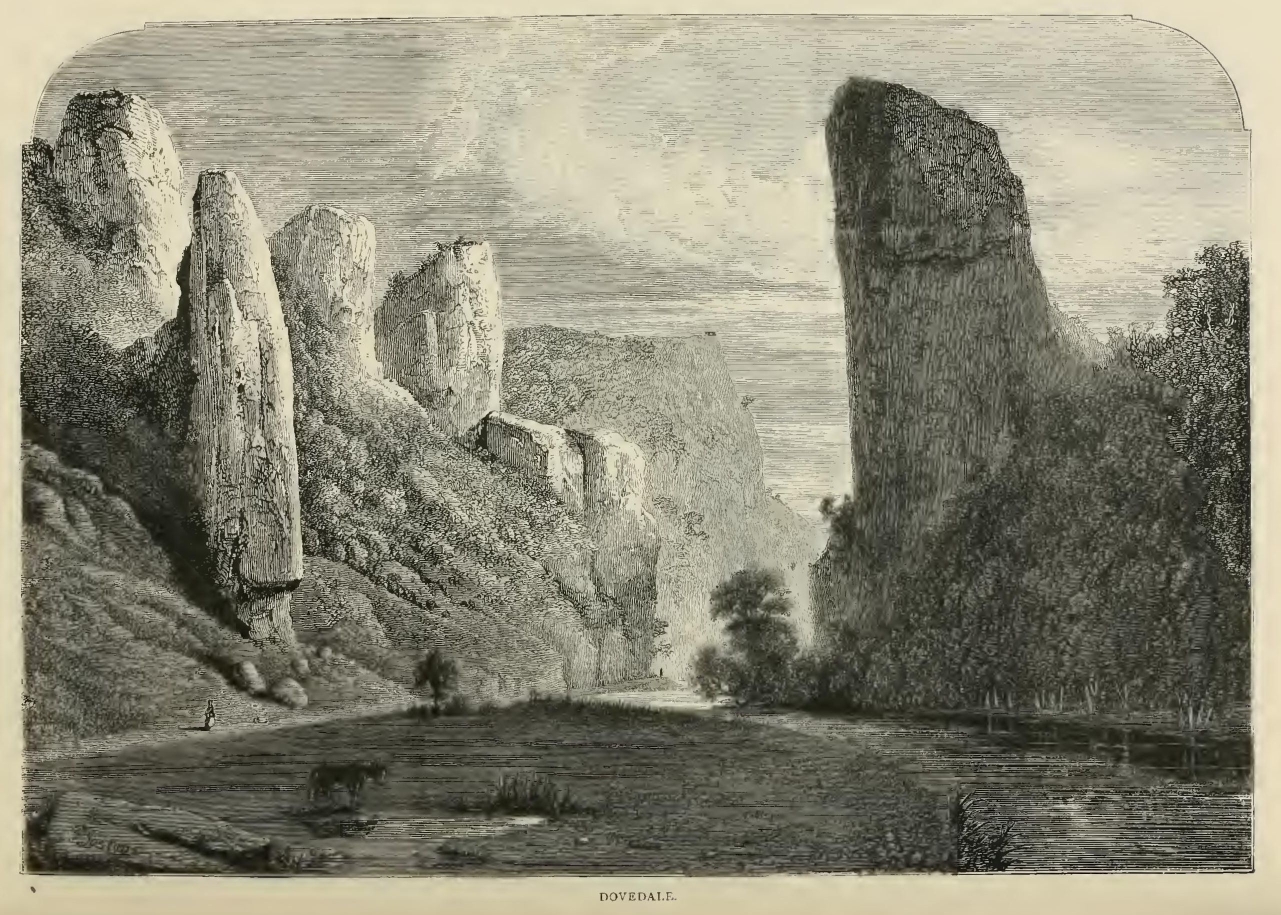
Two little rivers meet here, one of them the Manifold, the other and larger the Dove; and after a hurried view of the lovely vale, we lost no time in making our way to the entrance of the far-famed Dale. As most of our readers will know, the Dove divides Staffordshire from Derbyshire: we took the Derbyshire side, entering at a little gate on the river bank, and leisurely and with many a pause pursued a walk with which surely in England there are few to compare. The river is a shallow, sparkling stream, with many a pool dear to the angler, and hurrying down, babbling over pebbles, and broken in its course by many a tiny waterfall. On both sides rise tall limestone cliffs, splintered into countless fantastic forms—rocky walls, towers, and pinnacles, and in one place a natural archway near the summit, leading to the uplands beyond. And all up the sloping sides, and wherever root-hold could be obtained on pinnacle and crag, were clustered shrubs and trees of every shade of foliage, with the first touch of autumn to heighten the exquisite variety by tints which as yet suggested only afar off the thought of decay. The solitude of the scene served but to enhance its loveliness. For that road by the river side is no broad well-beaten track. No vehicle can pass, and even the pedestrian has sometimes to pick his way with difficulty. The stillness, on the day of our visit, was unbroken save for the murmur of the water, the twitter of the birds, and the rustling of the branches in the gentle breeze. The blue sky overhead, and the sunlight casting shadows upon the cliffs and the stream, completed the picture; and if the memory of Izaak Walton and Charles Cotton haunted their favourite stream, it so happened that we encountered none of their disciples.
Many travellers leave the glen at Mill Dale, where a pleasant country lane to the right enables them to gain the high road between Ashbourne and Buxton. Time and strength permitting, however, we would strongly advise the tourist to make his way by the river banks to Hartington, passing through Beresford Dale, where at Pike Pool, represented in the frontispiece to this chapter, all the beauties of the Dove Valley are concentrated at one view. A limestone obelisk stands in the middle of the river, with a background of rich foliage, just touched, at the time of our visit, with autumnal hues, while the clear water eddied and sparkled around its base. This pool was the favourite resort of Walton and his friend Cotton. Many allusions to the spot will be found in The Complete Angler; and the comfortable inn at Hartington, reached from Beresford Dale by a walk for about a mile through pleasant meadows, bears Charles Cotton's name.
At Hartington, the high road to Buxton may be taken; or, far better, the traveller may make his way to the famous watering-place by the plateau which divides the valley of the Dove from that of its tributary Manifold; he will then descend to the former valley near Longnor, and thence may climb to Axe Edge, a great outlying southerly branch or spur of the gritstone, from which the Dove has its rise. Parting with this lovely river at its very fountain-head, we find it difficult to believe that so much beauty and even grandeur can have been included in the twenty miles' course of a little English stream, and are ready to endorse the enthusiastic tribute of Cotton:
"The rapid Garonne and the winding Seine
Are both too mean.
Beloved Dove, with thee
To claim priority:
Nay, Thame and Isis, when conjoined, submit
And lay their trophies at thy silver feet."
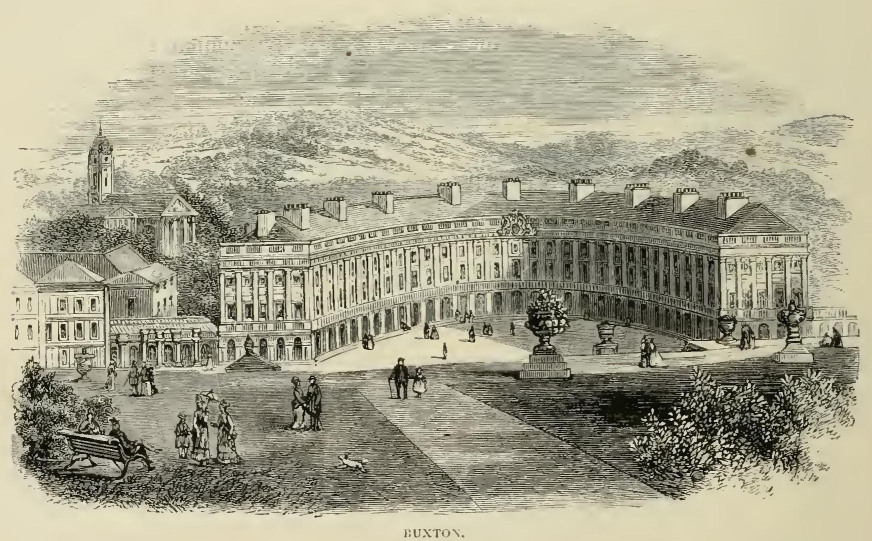
At Buxton, easily reached from Axe Edge, we found every variety of excursion and other enjoyments open to us, "for a consideration." The Derbyshire dales that may be easily explored from this point are very fine; and the whole of the Peak is open to the tourist. We could give, however, but a hurried glance to these manifold beauties, being bent upon descending the Derwent in some such leisurely fashion as that in which we had ascended the Dove. We had, indeed, the railway now to facilitate the latter half of our journey—no slight matter! and yet this had the effect of bringing multitudes of travellers like ourselves, so that the end of the Derbyshire tour was taken in company with a crowd. For a time, however, we were comparatively alone to Castleton, by Mam Tor, the wonderful "Shivering Mountain," where the sandstone and mountain limestone meet;—so called from the loose shale which is constantly descending its side, and which, in popular belief, does not diminish the mountain's bulk: thence down through the Winnyats or Windgates, a picturesque pass between lofty cliffs, taking its name from the winds which are said to rage almost ceaselessly through the narrow defile, although at the time of our visit the air was calm, while the lights and shadows of a perfect autumn day beautified the grey limestone crags.
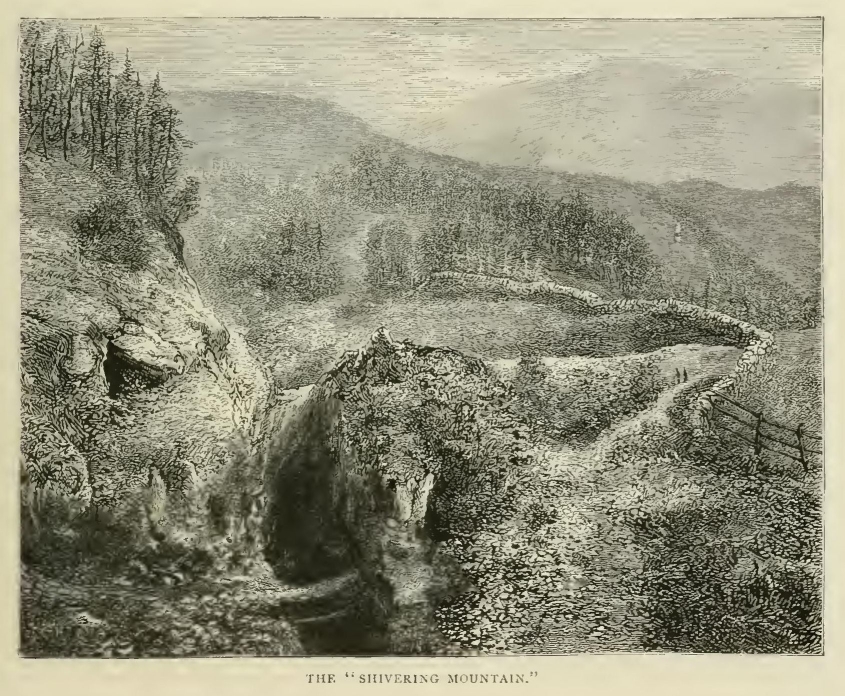
The ruins of Peveril's Castle, and the gloomy caves of Castleton, of course were visited. Then began the journey down the Derwent, embracing pretty Hather-sage, with its ancient camps, tumuli, and other remains whose origin can only be conjectured. Here is the traditionary grave of Robin Hood's gigantic comrade, "Little John." A "Gospel Stone" in this village, once used as a pulpit, perpetuates the memory of the open-air harvest and thanksgiving services of past generations; while in the village of Eyam, three or four miles lower down, the "Pulpit Rock," in a natural dell still called a "church," brings to mind the heroism of a devoted pastor, who during the plague of 1665, when it would have been dangerous to meet in any building, daily assembled his parishioners in this place to pray with them, to teach and to console.
The traveller will not regret the slight détour from the road by the river to visit this most interesting spot; and he may return to the Derwent by Middleton Dale, another magnificent pass through limestone cliffs. Hence he will soon reach Edensor, the "model village," and Chatsworth, "the Palace of the Peak." The splendours of the park and mansion are so familiar to thousands,—to whom in fact "the Peak of Derbyshire" is a name suggestive only of Chatsworth and Haddon Hall,—that we need attempt no description here. The visitor may follow his own bent, whether to wander in the stately park, or to join the hourly procession along the silken-roped avenue through the corridors and apartments of the Hall, with due admiration of the pictures, the statuary and the wonderful carving; thence passing out into the conservatory and the gardens, where nature has done so much, and art so much more. Truly days at Chatsworth are among the bright days of life, especially if there be time and opportunity also to visit Haddon Hall, that almost unique specimen of an old baronial English home, empty and dismantled now, but carefully preserved and beautiful for situation, upon the Derbyshire Wye, which here comes down from its own limestone glens and dales through the pretty town of Bakewell, to unite at Rowsley with the Derwent.
At this junction, too, the traveller comes upon the railway, and will be tempted to pass only too rapidly by the beauties of the Derwent Valley between Rowsley and Ambergate. We can but assure him that he will lose much by so doing; that Darley Dale and Moor are very beautiful, and that the tourist who rushes on to Matlock Bath without staying to climb Matlock Bank does an injustice to Derbyshire scenery: while if he be in pursuit of health, he can find no better resting-place than at the renowned | hydropathic establishments which occupy the heights.
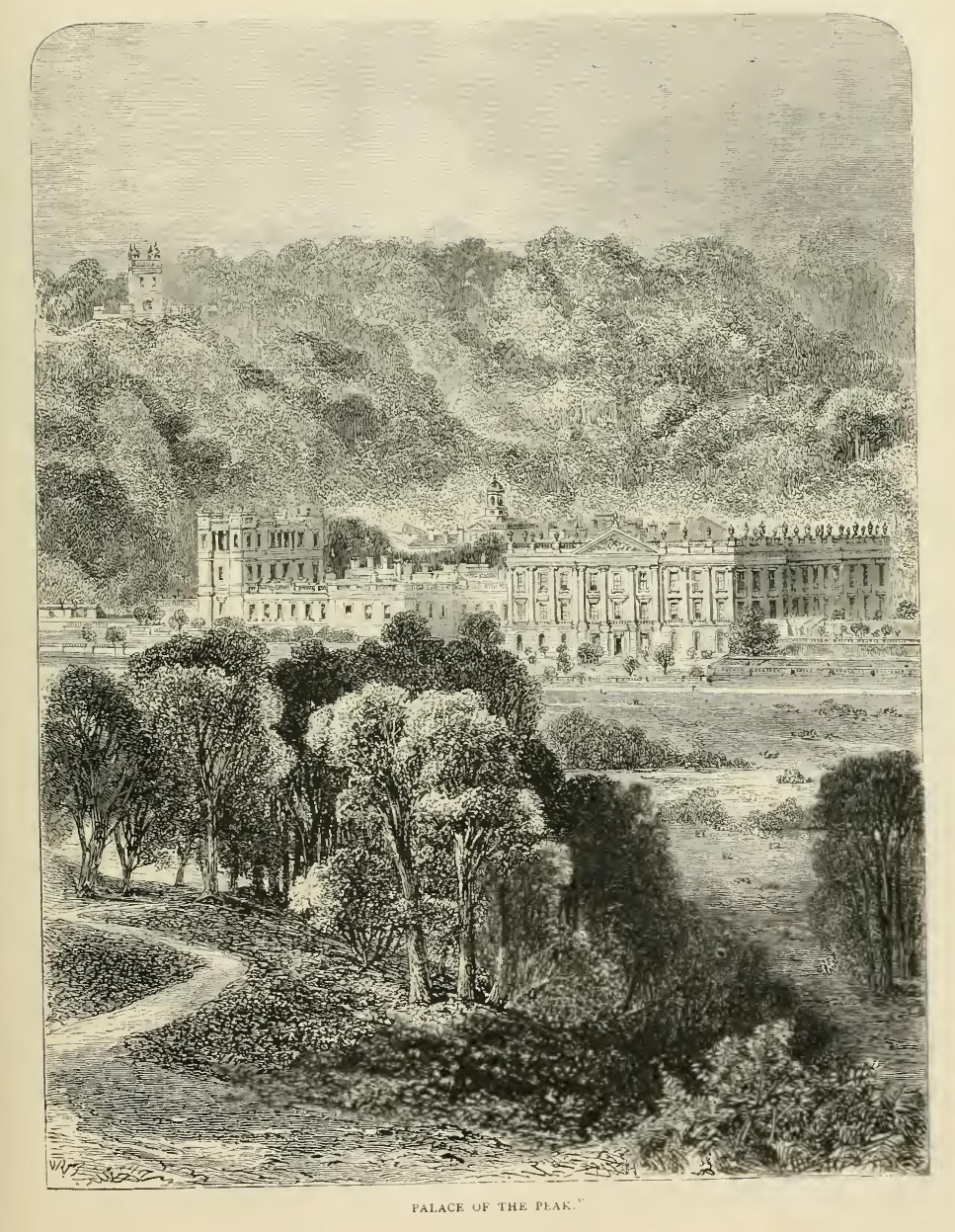
Still, most who are in search of the picturesque will prefer to seek it at Matlock Bath, where indeed they will not be left to discover it for themselves. In this famous spot the beauties of nature are all catalogued, ticketed, and forced on the attention by signboards and handbills. Here is the path to "the beautiful scenery" (admission so much); there "the Romantic Rocks" (again a fee); there the ferry to "the Lovers' Walk," a charming path by the river-side, overshadowed by trees, and so on.
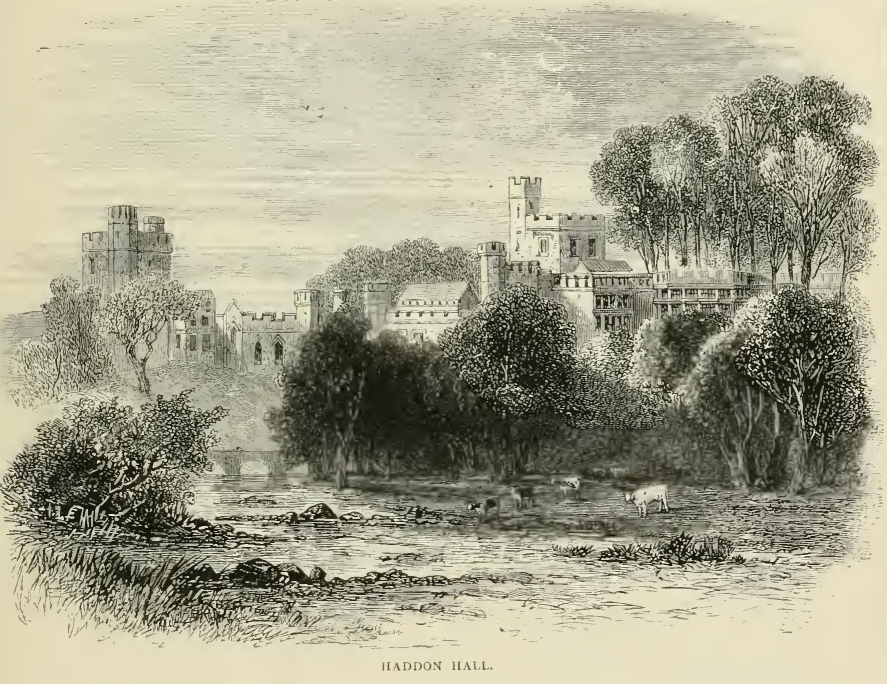
Petrifying wells offer their rival attractions, and caves in the limestone are repeatedly illuminated during the season for the delight of excursionists. The market for fossils, spar, photographs, ferns, and all the wonderful things that nobody buys except at watering-places, is brisk and incessant. But when we have added to all this that the heights are truly magnificent, the woods and river very charming, and the arrangements of the hotels most homelike and satisfactory, it will not be wondered at that the balance of pleasure remained largely in favour of Matlock.
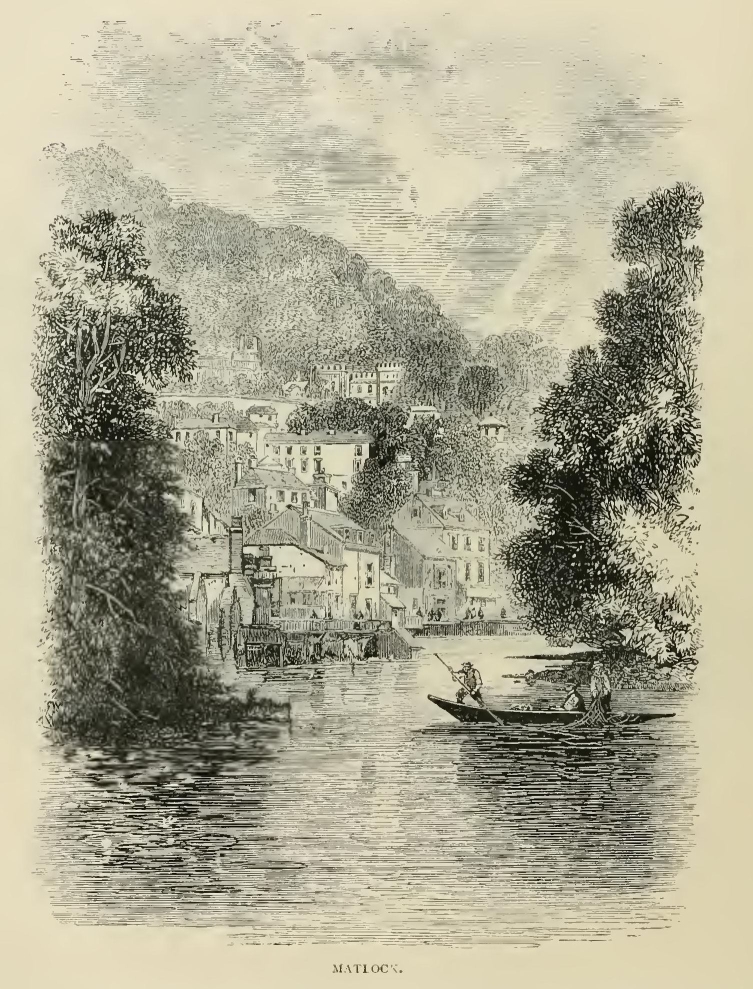
It would be certainly pleasanter to discover for one's self that here is "the Switzerland of England," than to have the fact thrust upon attention by placards at every turn; but perhaps there are those to whom the information thus afforded is welcome, while the enormous highly-coloured pictures of valley, dale and crag which adorn every railway station on the line, no doubt perform their part in attracting and instructing visitors. They need certainly be at no loss to occupy their time to advantage, whether their stay be longer or shorter.
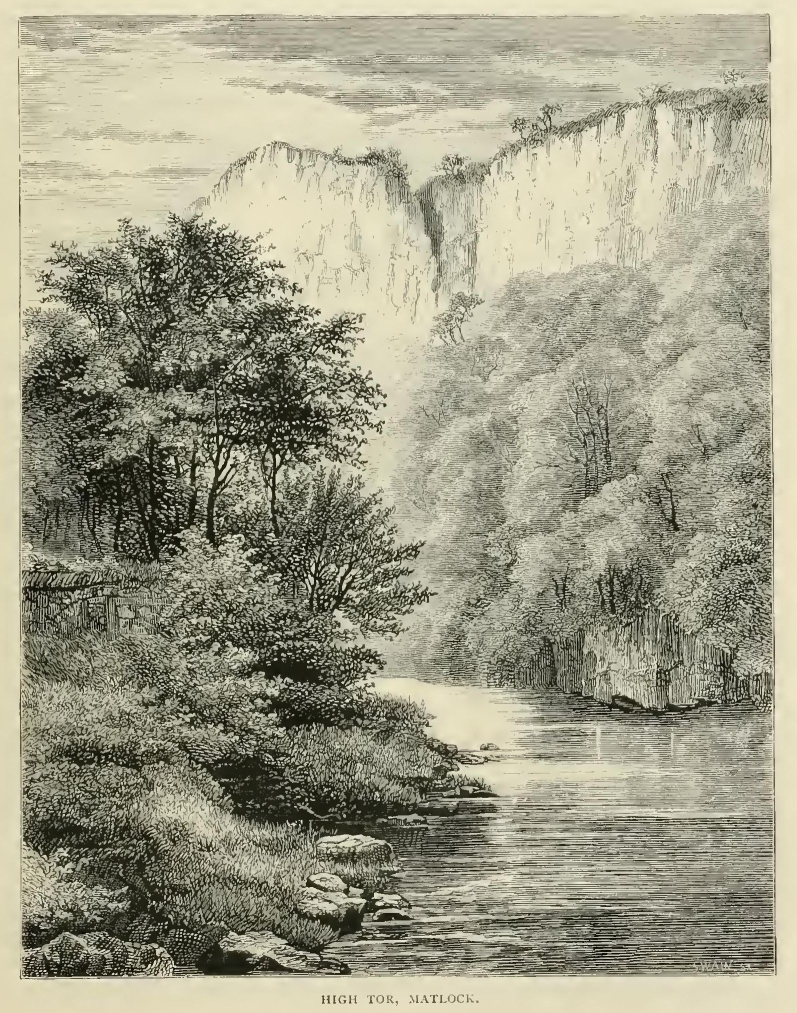
Everything is made easy for them. To all the noblest points of view, easy paths have been constructed: the fatigue of mountain-climbing is reduced to a minimum; and certainly the landscapes disclosed even from a moderate elevation by the judicious pruning and removal of intercepting foliage, are such as to repay most richly the moderate effort requisite for the ascent. Lord Byron writes, that there are views in Derbyshire "as noble as in Greece or Switzerland." He was probably thinking of the prospect from Masson, from which the whole valley, with its boundary of tors, or limestone cliffs, is outspread before the observer, while the river sparkles beneath, reflecting masses of foliage, with depths of heavenly blue between; and beyond the scarred and broken ramparts of the glen, purple moorlands stretch away to the high and curving line of the horizon.
The traveller southward, who has accompanied us thus far, if yet unsated with beauty, will be wise in taking the road from Matlock to Cromford, the next station, instead of proceeding by railway. The short walk or drive between the limestone cliffs, although the great majority of passengers pass it by unnoticed, is really, for its length, as magnificent as almost any of the dales in the higher part of the country. At Cromford there is the stately mansion of the Arkwrights, and a little beyond, on the other side of the railway, is Lea Hurst, the home of Miss Florence Nightingale, a name that will be gratefully enshrined in the memories of the English people, even when war shall be no more. From this spot the valley gradually broadens, still richly-wooded up the heights, with fair meadows on the river banks. And so we reach Ambergate, where we re-enter the busy world, bearing with us ineffaceable memories of the beauties and the wonders of "the Peak."
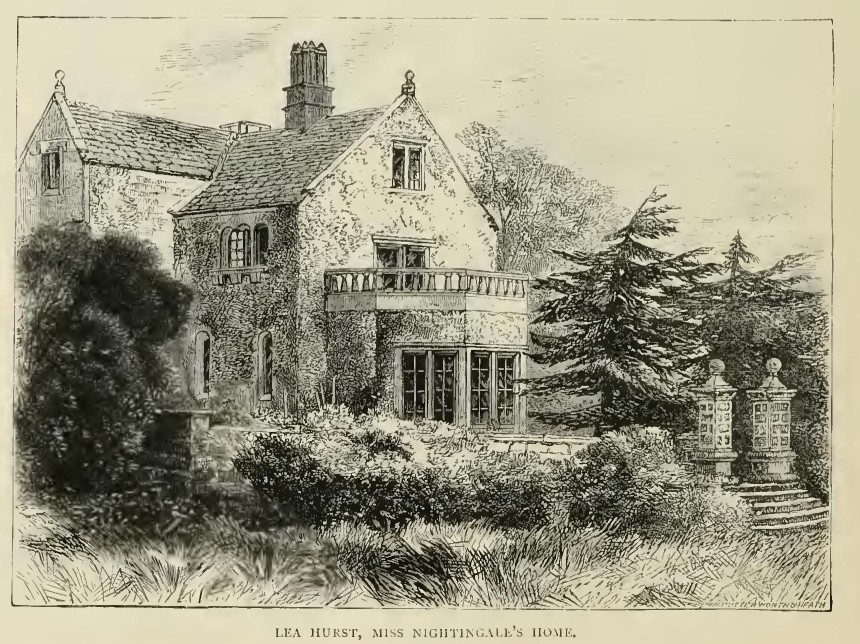
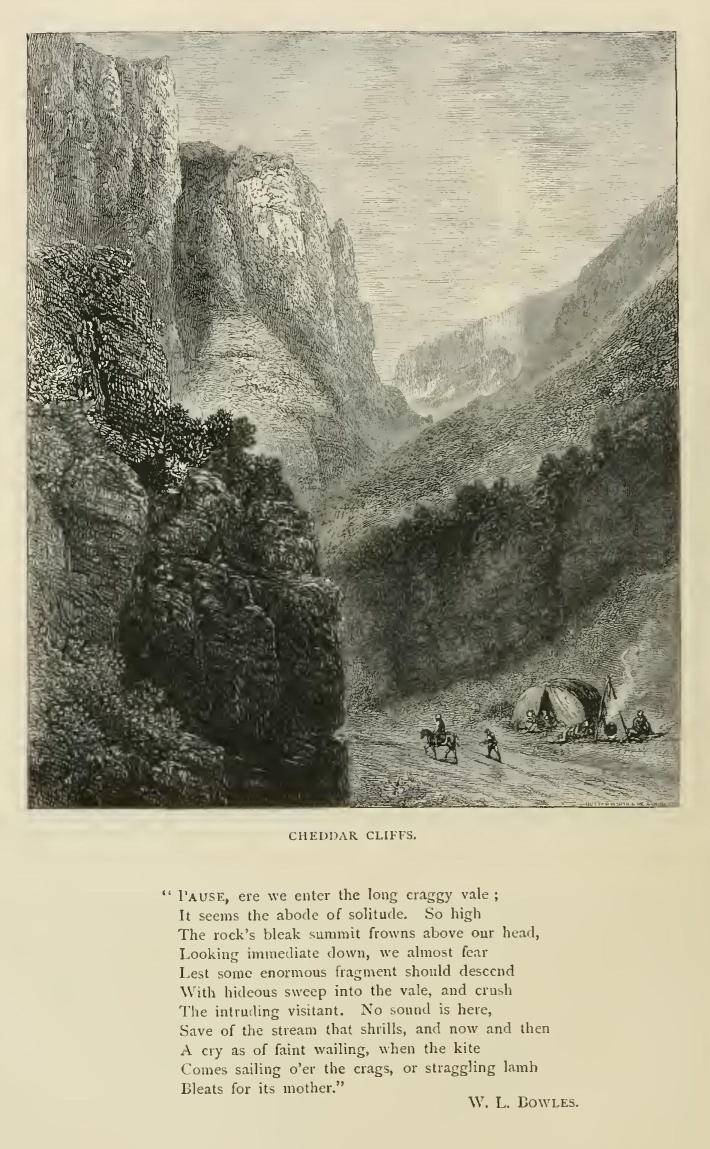
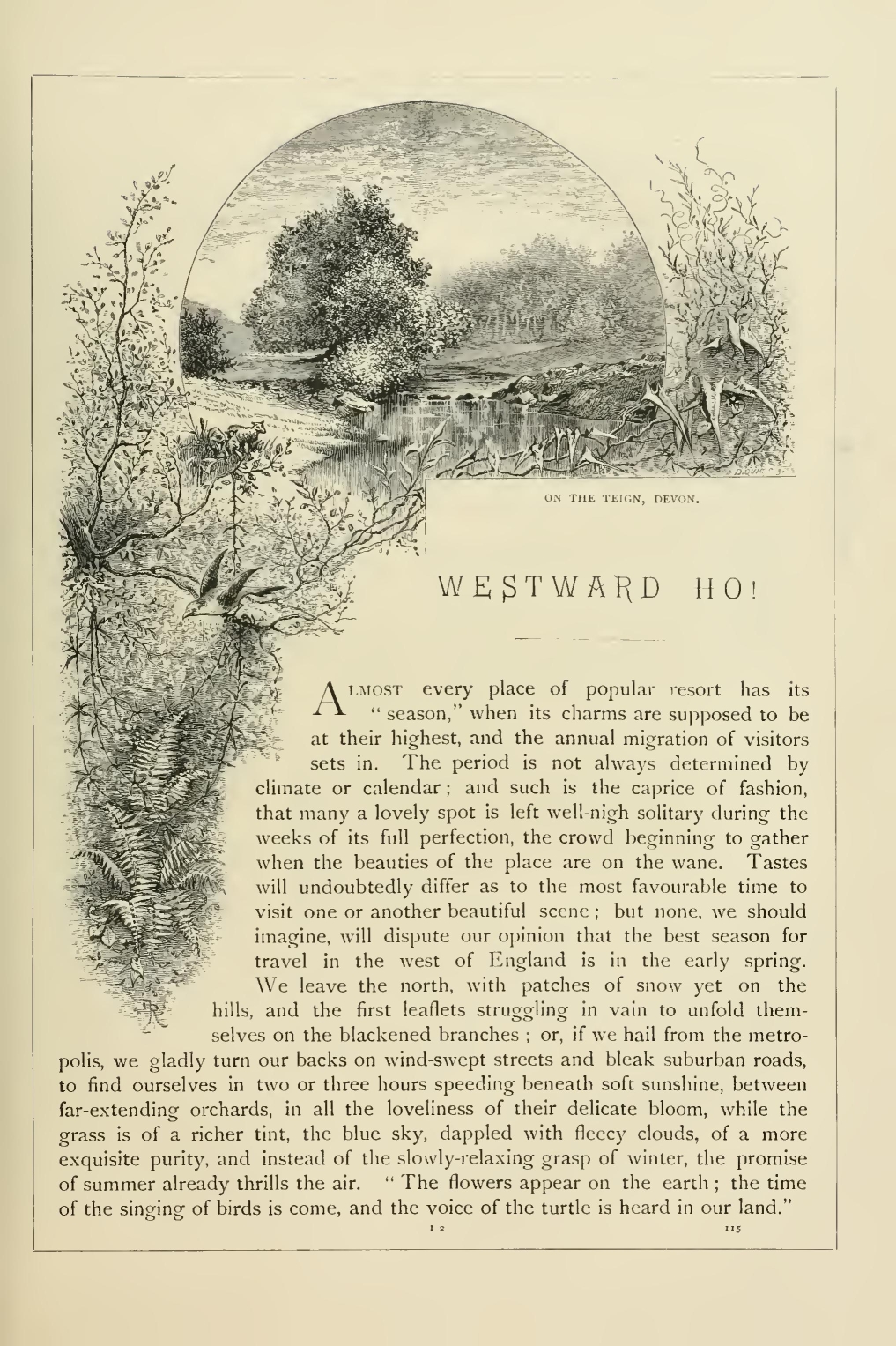
Almost every place of popular resort has its "season," when its charms are supposed to be at their highest, and the annual migration of visitors sets in. The period is not always determined by climate or calendar; and such is the caprice of fashion, that many a lovely spot is left well-nigh solitary during the weeks of its full perfection, the crowd beginning to gather when the beauties of the place are on the wane. Tastes will undoubtedly differ as to the most favourable time to visit one or another beautiful scene; but none, we should imagine, will dispute our opinion that the best season for travel in the west of England is in the early spring. We leave the north, with patches of snow yet on the hills, and the first leaflets struggling in vain to unfold themselves on the blackened branches; or, if we hail from the metropolis, we gladly turn our backs on wind-swept streets and bleak suburban roads, to find ourselves in two or three hours speeding beneath soft sunshine, between far-extending orchards, in all the loveliness of their delicate bloom, while the grass is of a richer tint, the blue sky, dappled with fleecy clouds, of a more exquisite purity, and instead of the slowly-relaxing grasp of winter, the promise of summer already thrills the air. "The flowers appear on the earth; the time of the singing of birds is come, and the voice of the turtle is heard in our land."
But whither shall we direct our steps? It is the perfection of comfort in travelling to have time at command. We need be in no haste to leave the apple-blossomy valleys of Somersetshire, even for the woods and cliffs of Devon; and if the tourist would visit a spot which, in its own way, is unique in England, let him turn aside, as we did, soon after leaving Bristol, to a rift in the Mendip Hills, and make his way through the pass between the Cheddar Cliffs. A more majestic scene it would be difficult to find. For actual magnitude is only one element of sublimity. The biggest mountain is not always the grandest, just as the finest landscape is not always that which embraces the greatest number of square miles. The Himalayas are said to be far less imposing than the Alps. The width of the valleys, the more gradual slope of the mountains, and the greater distance from the eye, detract from their apparent height as compared with Mont Blanc or the Matterhorn. This little gorge of the Mendips affords a striking illustration of the same kind. The cliffs are less than five hundred feet high; yet under certain conditions of atmosphere we have had as deep a sense of sublimity, and under others as keen a sense of beauty here, as in districts where the altitude is to be reckoned by thousands of feet instead of hundreds.
The approach to Cheddar is by a short railway from Yatton, on the Bristol and Exeter line, or by the road, which winds through a rich valley. The hills on either side are green to their very summits, from which fine views may be gained of the Bristol Channel, near Clevedon and Weston. One of them, Dolbury, is crowned by a remarkably fine British camp, enclosing within its ample area a Roman stronghold. Wrington, the birthplace of John Locke, is passed. Glastonbury Tor comes into view, and remains a conspicuous object for the rest of the journey.
Immediately behind the village of Cheddar rises the bare grey ridge of the Mendips. Cut sheer through it from summit to base is an extraordinary cleft. The road which winds along the bottom of the ravine is in some places only wide enough to allow two vehicles to pass abreast. On the right-hand side a perpendicular wall of rock rises to the height of about four hundred and thirty feet. Its surface is broken by enormous buttresses, like the towers of some Titanic castle, surmounted by spires and pinnacles, whose light airy grace contrasts finely with the massive walls on which they rest. Down the face of the cliff long festoons of ivy and creeping plants wave to and fro. The scanty soil on the ledges and in the fissures is bright with wild flowers. The yew and mountain ash, dwarfed into mere shrubs, seem to cling with a precarious foothold to the face of the rock. Far above us innumerable jackdaws and crows chatter noisily, and hawks, with which the district abounds, soar across the narrow strip of sky overhead. The opposite side of the ravine is less precipitous, though even here it is steep enough to task the energies of the climber, and grand masses of rock stand out from the hill-side. Conspicuous amongst these is the Lion Rock, so called from its extraordinary resemblance to a crouching lion. This district abounds in caverns, many of them of great extent and beauty, which will well repay a visit. Local tradition affirms that one reaches as far as Wookey Hole, a distance of ten miles.
The devoted and self-denying efforts of Mrs. Hannah More must not be forgotten in connection with Cheddar. When residing at Barley Wood, a few miles distant, about the end of the last century, she was dismayed at the ignorance and immorality of the villagers, who were "living like the brutes that perish," and indulging in gross vices. Scarcely even in the heart of Africa could more complete heathenism be found. As yet Sunday Schools, Tract Societies and all the means of usefulness, now so common, had no existence.
Her endeavours for the amelioration of the people were as experiments to be tried single-handed, under the most unpromising circumstances, and in the face of the most violent hostility and abuse.
Yet she did not shrink from the arduous duty which lay before her. A house was taken, a pious teacher appointed, and the school was opened. Gradually enemies were conciliated, as the happy effects of Christian teaching became apparent. Many of the children learned to know and love the Saviour. The influence spread from the children to the parents, and by the blessing of God the experiment, which at first seemed so hopeless, was crowned with a success beyond her utmost expectations. It was in connection with her evangelistic work at Cheddar that she wrote her first tract, Village Politics, by Will Chip. This led to the preparation of her Cheap Repository Tracts, to be followed in due time by the establishment of the Religious Tract Society, whose operations now extend throughout the whole world. On the completion of the series, Mrs. More wrote in her journal: "Bless the Lord, O my soul, that I have been spared to accomplish this work. Do Thou, O Lord, bless and prosper it to the good of many; and if it do good, may I give Thee the glory, and take to myself the shame of its defects. I have devoted three years to the work. Two millions of these tracts have been disposed of during the first year! God works by weak instruments, to show that the glory is all His own."
From Cheddar the traveller may either continue his journey by way of Wells, or may return at once to the main line, passing near the coast of the Bristol Channel, with a wide alluvial plain at his left, once covered by an arm of the sea, with islands, as Brent Tor and others, emerging from the waters, and reaching as far as Glastonbury or Avalon—"apple-island," famed in legend and song.
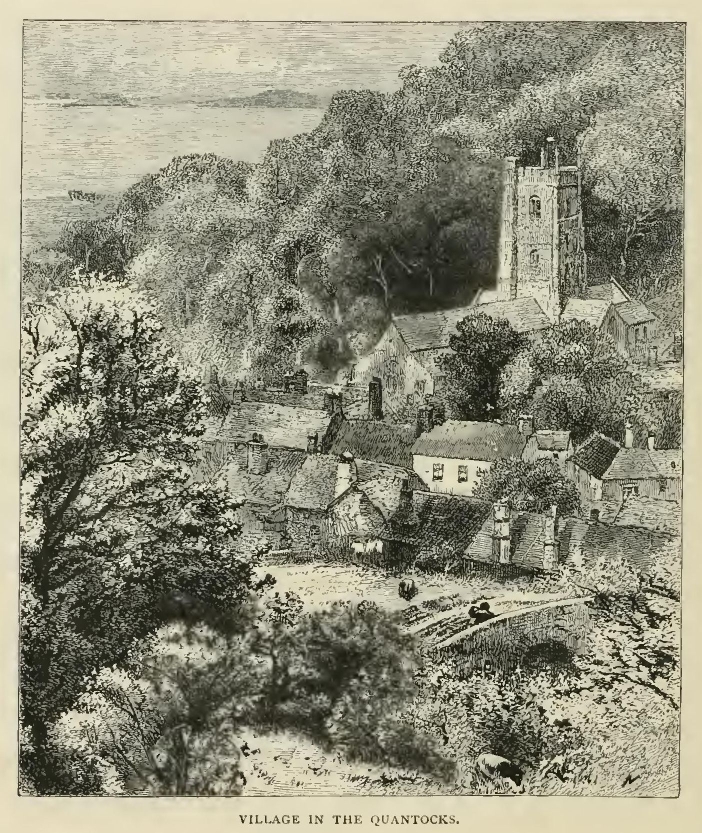
A little further, and the marshy plain of the Parret stretches away in one direction to Sedgemoor, scene of the "last battle fought on English ground," * that in which the ill-fated Duke of Monmouth suffered irretrievable defeat, and in another, to Athelney, the place of King Alfred's retreat and noble rally against the Danes. In memory of the stories that charmed our childhood, we could do no otherwise than take the branch line at Durston, whence a few minutes' run places us in the marshy unpicturesque scene so memorable in English story. The whole neighbourhood was evidently once covered with woods and morasses; good drainage has made it fertile now, but it must be confessed that it must depend for all its attractiveness on its associations. On or near the traditional site of the "neatherd's cottage," an unpretending stone pillar with a lengthy inscription preserves the memory of Alfred's sojourn.
* Macaulay. The date was July 6, 1685
Resuming the journey westward, we soon discern the towers of the Taunton churches, and may find a welcome night's rest in this bright and pretty town; or turning again off the main line, may pass north west, by a route full of interest, to the Ouantock Hills. On our way we pass Combe Florey, famous as the residence for a time of Sydney Smith, and as the scene of some of the most characteristic stories of his life. But we must not linger in the valley: at every point the wooded hill-slopes tempt us to climb upwards among shady groves of beech, over turf thick with primroses and bluebells, then out upon the furzy heights. It hardly matters which path we take, whether up Cothelstone, whence the view is perhaps most magnificent, or Will's Neck, highest point of all, or Hurley Beacon. From hilltop to hill-top we make our way, descending into mossy glens, where the hill stream trickles down in miniature waterfalls, or striking down some deep wooded combe, where the houses of a village nestle among the trees, and the spacious church tells of a time when the inhabitants far out-numbered the present scanty population. In the valley below, to the north-east, we descry the village of Nether Stowey, for some time the residence of Coleridge, and further to the north, at the foot of one of the loveliest of wooded combes, is Alfoxton, which was at the same time the home of Wordsworth. The two friends have told us how they used to meet and discuss high themes in many a charming stroll, their neighbours much wondering the while, and the government of the day suspecting their advanced opinions. The end was that they had to leave, not before they had made imperishable record of the beauties of the place. Thus Wordsworth writes to Coleridge, in the Prelude:
"Beloved Friend!
When looking back, thou seest in clearer view
Than any liveliest sights of yesterday
That summer, under whose indulgent skies
Upon smooth Quantock's airy ridge we roved
Unchecked, or loitered 'mid her sylvan combes:
Thou in bewitching words, with happy hearts
Midst chaint the vision of that ancient man;
The bright-eyed Mariner, and rueful woes
Didst utter of the Lady Christabel."
Coleridge, in a note to the Ancient Mariner, says, "It was on a delightful walk from Nether Stowey to Dulverton, with Wordsworth and his sister, in the autumn of 1797, that this poem was planned and in part composed."
The great hilly range to the west, in full view across the valley from the Ouantocks, is an outlying rampart of Exmoor, and the brown peak in the distance is Dunkery Beacon, the highest point in Somersetshire. Our road leads between these heights and the sea, by Dunster, with its great ivied castle overhanging the quaint feudal-looking little town, and Minehead, a cheerful unpretending watering-place, to Porlock, where the ascent of what the country people call a "terrŕble long hill," by a zigzag moorland road, leads to a height from which, on looking back, we have a prospect of surpassing grandeur. Let us gaze our fill: if the day be fine, and the atmosphere clear, we shall see nothing nobler in the west of England. To the south the huge masses of Dunkery, brown with heather, rise from a foreground of woods and glens; below, to the east, lies a fair valley, surrounded with hills of every picturesque variety in form, prominent among which is the rugged side of Bossington Beacon. Towards the south-east, heights on heights arise, some richly wooded, others majestic in their bareness; while to the north and north-east stretches the Bristol Channel, with the Welsh mountains dimly seen beyond.
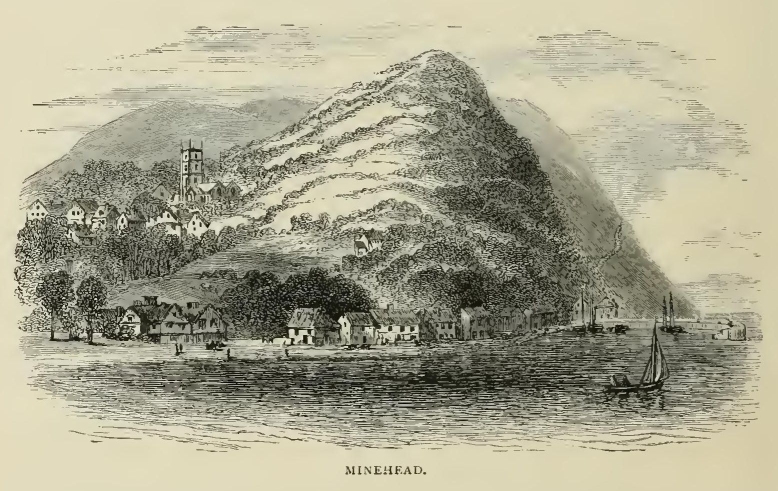
Then we go southwards over a reach of wild moorland, and come upon the indescribable loveliness of Lynmouth and Lynton. Far beyond railways, accessible only by long walking or driving over hilly roads, or by small boats from steamers on their way up and down the Channel, this fair spot can never attract the crowd; but those who have wandered by its streams, or climbed its heights, are singularly unanimous in pronouncing it the most charming spot in England. Lynmouth is in the valley, on the shore; Lynton on the height. The name is derived from the lyns, or torrents, which descend separately, each through a wooded gorge or combe, until they meet beside the sea. Great mossy rocks everywhere break the course of the torrents, and the luxuriant foliage which lines the banks, the ferns and flowers, with the overhanging trees, combine to make a succession of perfect pictures.
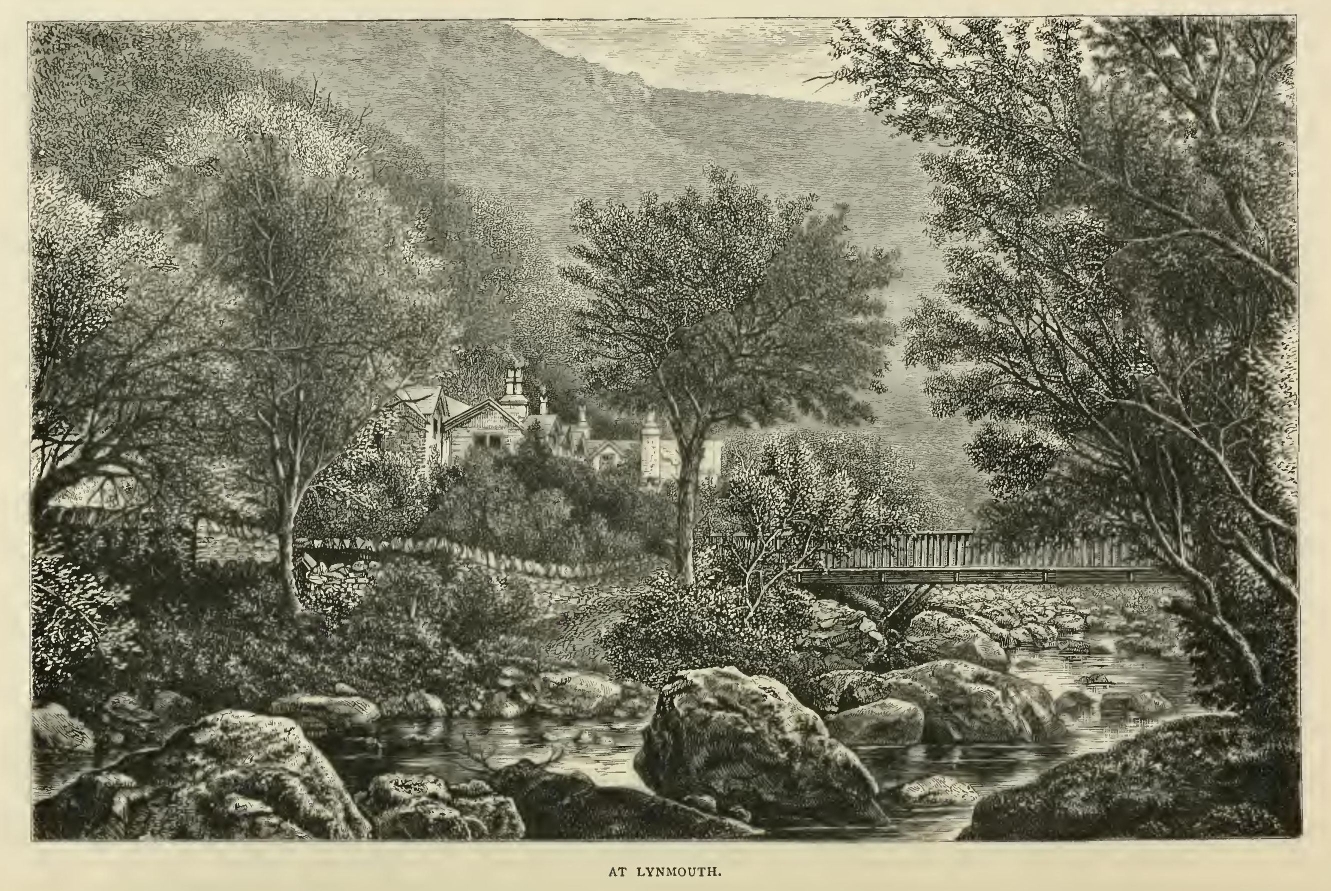
The traveller will, of course, go up Lyndale, the valley of the East Lyn, as far as Watersmeet, and will not omit to explore the quieter, more luxuriant, though less magnificent West Lyn. He will climb to the summit of Lyn Cliff, and will survey at ease the prospect from the summer-house; and will not omit the extraordinary Valley of the Rocks, reached by a grand walk along the face of the cliff, which overhangs the sea to the west of Lynton. At a break in this path he suddenly comes to a gigantic gateway, formed of two rocky pyramids, and enters upon a scene which, to his first view, appears strewn with the fragments of some earlier world. "Imagine," says Southey, "a narrow vale between two ridges of hills, somewhat steep: the southern hill turfed; the vale, which runs from east to west, covered with huge stones, and fragments of stone among the fern that fills it; the northern ridge completely bare, excoriated of all turf and all soil, the very bones and skeleton of the earth; rock reclining upon rock, stone piled upon stone, a huge terrific mass. A palace of the pre-historic kings, a city of the Anakim, must have appeared so shapeless, and yet so like the ruins of what had been shaped after the waters of the flood subsided.... I never felt the sublimity of solitude before."
The drive from Lynton to Barnstaple, though not long, being, we believe, somewhat under twenty miles, brought to us a crowd of half-forgotten associations of early days when coach-travelling was the chief means of locomotion. The coach itself was of the old build, spick and span in its neatness; the coachman was of old-fashioned ways; the four sleek horses were no mere omnibus hacks, but as they warmed to their work up and down hill, showed a mettle akin to that of roadsters in days long ago. Or perhaps we had only imagined until now that the old breed had deteriorated! The villages on the way had no sign of "Station" or "Station Hotel" about them; children ran from the cottage doors to shout after the coach, or to bring primroses and violets to the passengers; rustics gathered for a chat where the coachman pulled up, as he did tolerably often, for time seemed but a small object in that old-world region. And all around was outspread a landscape of rich, ever-changing loveliness, ruddy in soil, rich in verdure, as at one time we descended into lanes half-embowered by the already luxuriant hedgerows, and at another emerged on open moorland swept by soft breezes from the sea, and engirdled by the hazy forms of distant hills. At length the estuary of the Taw came into view, the houses of Barnstaple appeared, the coach drove into the station yard, and we were in the world again.
Another route might have been taken from Lynton to Ilfracombe, by way of Combe Martin, with its fine and rocky bay; but we were anxious to reach less crowded and familiar spots than the famous North Devon watering-place, though this also is in its way delightful. We must, however, see one or two further points on the coast before striking inland again; and accordingly, took up our night's quarters at Bideford, famed for the length of its bridge, and the steepness of its streets. Emerging early in the morning from the highest part of the town, we made our way to Westward Ho! that magnificent possibility, whose stately mansions and hotels, broad quays and pier, surrounded by vessels from all parts, with its broad level plain by the sea and noble background of wooded hills, had so often captivated us—in railway-station waiting-rooms. We found it all there, except the mansions, the quays, and the ships! The bay is glorious, the plain upon the shore stretches far and wide,—to the satisfaction of golfers, for whose favourite game no spot can be better adapted: there is a great pebble-ridge, a natural breakwater two miles long and fifty feet wide, composed of rounded pebbles of carboniferous "grit;" the background of wooded cliffs is magnificent, while a lonely pier, one commodious hotel, a bath-house on a splendid scale, some rows of villas, lodging-houses, and one or two educational establishments give promise of prosperity to come. A great sanatorium or hydropathic institution, to be called "the Kingsley," after the gifted man who has set the stamp of his genius on this whole neighbourhood, has been projected; and certainly for purposes of health as well as enjoyment, no place could be better adapted than the woodland terraces overlooking this most beautiful bay.
The mention of Charles Kingsley reminds us of Clovelly, his early home, and to the last his favourite spot. Early in the morning we started for this unique Devonshire village, with high expectations, and under the auspices of the British Government, as our chosen vehicle was the "mail-cart," in the shape of a very comfortable waggonette filled with pleasant chatty passengers, all the livelier, perhaps, from the good-humoured sense of merit which early-rising is apt to engender. The road was not particularly striking, save for glimpses of the channel seen through the light morning haze: the breath of spring was in the air, and when we alighted at the "Hobby" gate, we were fully prepared for the three miles' walk by which our breakfast was yet to be earned. The path, in reality a broad, well-kept drive, is carried along the face of the cliff, which shelves gradually, covered thickly with trees and brushwood, to the shore, while the bank towers above, soft with moss and beautiful with flowers. The cliff curves in and out irregularly; broken in one or two places by deep glens, over which the road is carried by rustic bridges. Long shadows lay, that morning, across the path; above and below, the tender budding foliage clothed the dark branches of oak and elm, hazel and beech, in every variety of shade; the air was musical with birds, and, stirred by the gentle morning breeze and the whisper of the boughs, blended with the distant murmur of the sea. It was a walk to be remembered. At length, at a turning of the road, Clovelly came into sight, about a mile distant—a seemingly confused heap of houses emerging on all sides from thick woodland, and slanting steeply down to a stone pier jutting out into a little bay. At the end of the Hobby walk, the summit of the village was gained, and we were soon descending its curious steep street, not without longing looks at the quaint little lodging-houses, all untenanted as yet.
Clovelly is a place to linger in, and to dream! The practical need of the hour, however, was breakfast, during the preparation of which meal it was pleasant to sit in the hotel balcony, and look out upon the bay, with its lines of light and shadow, and the long outline of Lundy Island showing clear in the distance; for now the morning mists had lifted, and the brightness of spring was over sea and land. A walk of marvellous beauty followed, into the park of Clovelly Court, over springy turf, through woodlands budding into leaf, and over a stretch of rugged wilderness, preserved with some art in its primitive simplicity. Thence, by a winding pathway, or over a steep grassy slope, the highest point may be reached, a noble cliff, called from some old local story Gallantry Bower. A little summer-house, nestling in the cliff-side, commands a grand range of cliffs, with their curved, contorted strata, peculiar to the carboniferous formation, while many a jutting or broken crag gives a castellated aspect to this magnificent rampart of the coast. Inland, the scene is full of beauties of hill and glen, in almost measureless variety; but we could not linger to survey them all; for our way lay in another direction, before we could feast again on the beauties of cliff and sea.
Hartland Point, a little farther on, is the true "Land's End" of Devonshire, the terminating promontory of Bideford Bay, a tongue of grassy land, not more than thirty or forty feet wide, at the summit of a tremendous precipice on either side, pointing, it is said, to a similar projection on the opposite Welsh coast, like twin pillars of Hercules, * guarding the estuary of the Severn.
* Ptolemy, the geographer (2nd cent.), is supposed to have
referred to Hartland Point, as the "Promontory of Hercules."
It would now have been easy to visit Bude Haven, and so to travel south and south-west along the cliffs which fringe the Atlantic, but our present plan was to strike inland to Dartmoor. The little town of Oke-hampton was therefore our first destination, reached by a somewhat dull route,—whichever road may be taken,—but, when gained, most interesting. The town lies in a valley, watered by a swift romantic river which, at one point, sweeping round a wooded hill, crowned by the ruins of an old castle, forms as lovely a picture as anything of the kind in England. Kingsley abuses Okehampton, unjustly, we think: but, whatever may be thought of the town and its immediate neighbourhood, there can be no doubt as to the wonderful interest of the excursions that may be taken from it as a centre. From the castle hill, as from other points in the town, the chief object that arrests the eye is the vast brown sweep of rising ground, suggestive of mysterious desolation beyond, which we know to be the boundary of Dartmoor. Ascending, we find ourselves at first on pleasant, breezy, though treeless heights, but keep to beaten paths, and pursue our onward journey. At length the moorland track over which we have passed seems to rise behind us and shut out the world; and as we gaze around, we feel that all pictures which we had framed to ourselves of wild deserted solitudes are surpassed. "Like the fragments of an earlier world," is the comparison that naturally rises to the lips. We are not unfamiliar with moorland scenery—with Rombald's Moor, for instance, in Yorkshire, beautiful in its variety of colour, from the tender green and softening greys and browns of spring, to the purple heathery splendours of the autumn, while the song of lark and linnet overhead, or the plaintive cry of the lapwing, gives animation to the scene. But at Dartmoor is a new experience of desolation. The stupendous mass of granite which here crops up from hidden depths is covered on its broken surface with thick peat, in whose depths the blackened trunks of trees occasionally give evidence of a time when the range was clothed with wood, but which, for the most part, bears only coarse grass and moss, with heather and whortleberry in the most favoured localities. Broad spaces are covered by morass and bog, dangerous to the unaccustomed pedestrian. Scanty streams break from the heights, and hurry in all directions down to the valley, swollen to wild fury after a storm. The "tor," or shapeless masses of rock, which stand out from the peaty surface in all directions, are but, as it were, the jagged projections from the interior rock-skeleton. Some may be readily ascended; Yes Tor (probably East Tor, pronounced Devonshire fashion) being the highest, and on many accounts the best worth climbing.
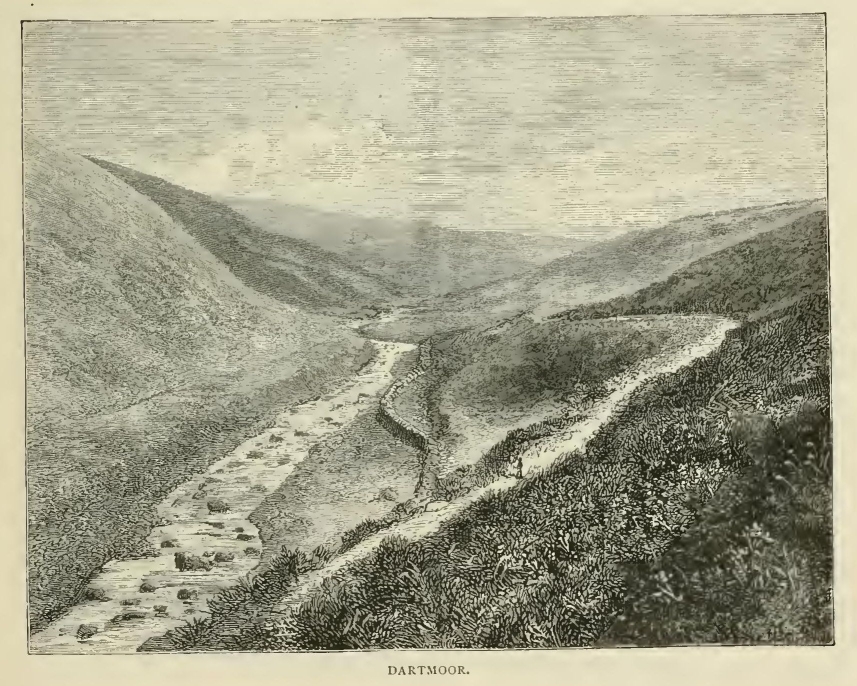
The prospect of the moor from this or any other commanding point can only be described as awful in its grim, monotonous, silent desolation, the only beauty being that of swelling distant outline, or frequently that of colour, when the atmosphere is clear between the frequent showers, and the rays of the sun light up the heather and the moss, diversifying the dark shadows of the tors with the various hues of green, with the ruddy gleam of withered fern, and rushes in many a morass. But let not the traveller be too hopeful of sunshine and clear air! For as the local rhyme says:
The south wind blows, and brings wet weather;
The north gives wet and cold together;
The west wind comes brimful of rain,
The east wind drives it back again.
Then, if the sun in red should set,
We know the morrow must be wet;
And if the eve is clad in grey,
The next is sure a rainy day."
Still, the slopes by which Dartmoor descends to the lowlands around are beautiful. In fact, the mighty granite mass is girdled by an investiture of fair glens and smiling villages, which make the circuit of it a succession of some of the brightest pictures that England can anywhere present in the same compass. The drive from Oke-hampton to Chagford, or to Moreton Hampstead, for instance, is of wonderful charm. Near the former village, the river Teign descends over rocks and boulders in a richly-wooded glen, as beautiful in parts as Dovedale.
The rivers, indeed, which come down on all sides from Dartmoor, are the glory of Devonshire. Beside the Teign, there is the Dart itself, one head-stream of which rises near the well-known prison at Prince Town, with the Taw, Tavy, Avon, Erme, Plym, and streamlets innumerable.
Travellers in favourable weather will do well to cross Dartmoor by the coach-road, from Moreton Hampstead to Tavistock, past the big, gloomy prison, appropriately placed in the very wildest and most desolate part of the whole region. Or, as we did, making Okehampton their headquarters, they may pass on by train by way of Lidford. The railway is carried in places at a great height, on the open edge of the moor, which it curiously fringes: it seems essentially a holiday line; there is no hurry, and the traveller, as he passes along, may leisurely survey the frowning heights above, or the fair valley below, according to his choice.
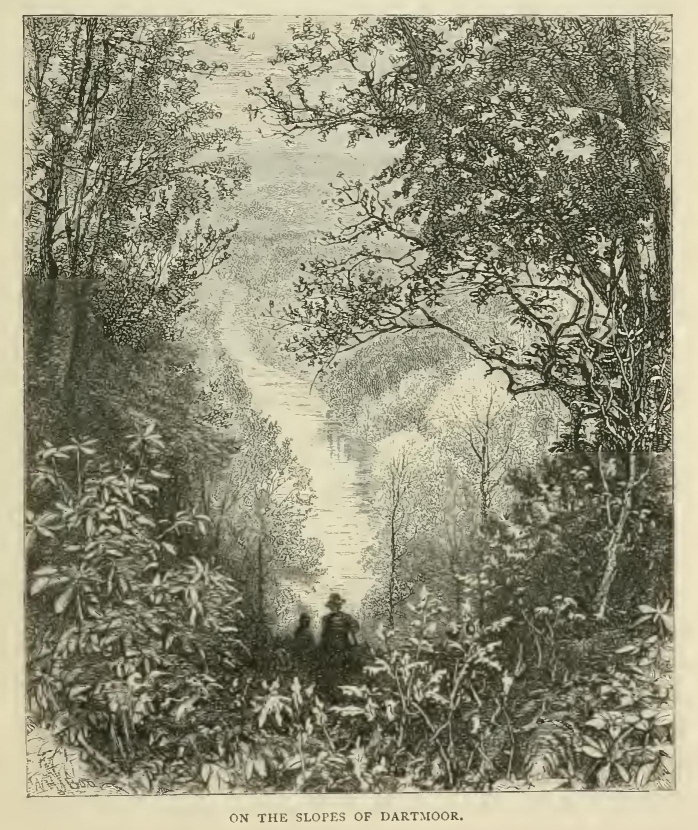
Lidford station being reached, we left the train, and found ourselves in an unfinished-looking spot, with little outwardly to attract. Having, however, received directions how to proceed, we crossed a farmyard, where some cattle with stupendous horns looked and lowed at us in a manner trying to the nerves, then, emerging near a river bank, made our way for less than a mile up the stream, on a grassy path beneath overhanging woods, when at a sudden turn up a glen that opened to the main stream, the gleam of waters caught the eye, at the first glance like some tall spirit of the dell, glimmering through the foliage that enshrouded it. A more beautiful cascade is hardly to be seen in England, when Dartmoor has had abundance of rain. At other times they say a friendly miller can turn on a supply of water, else thriftily economised for his needs. Happily, no such artificial arrangement was needful on the occasion of our visit; and we remained long admiring the lovely picture.
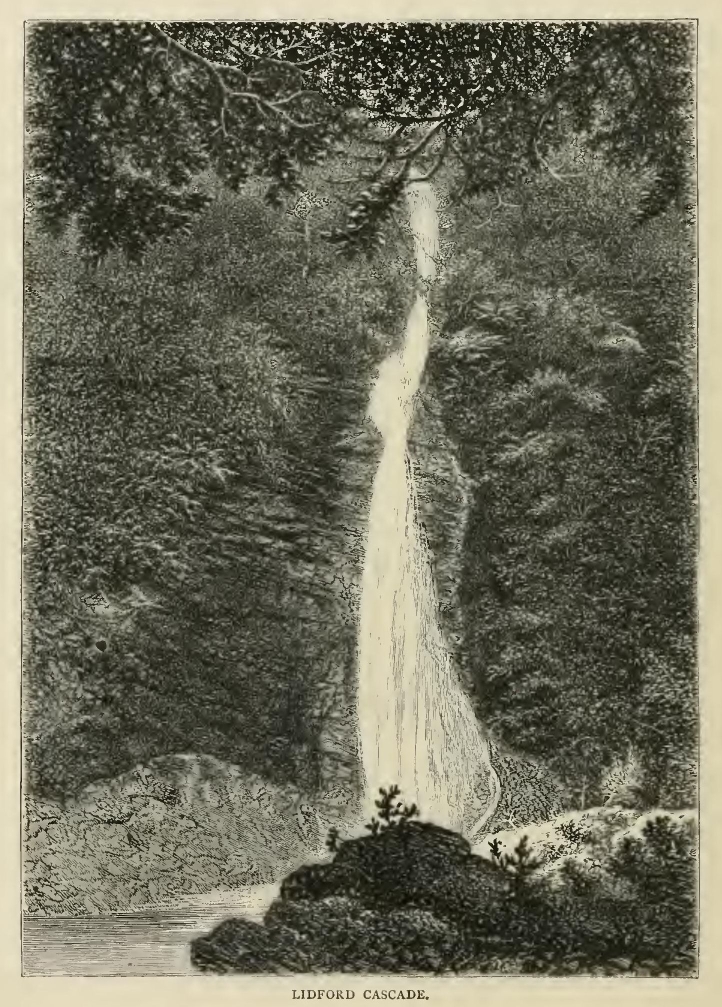
Retracing our steps, we climbed to the village, crossing on our way a commonplace-looking bridge, of a single arch, at a clip in the road, with the sound of a great rush of waters beneath.
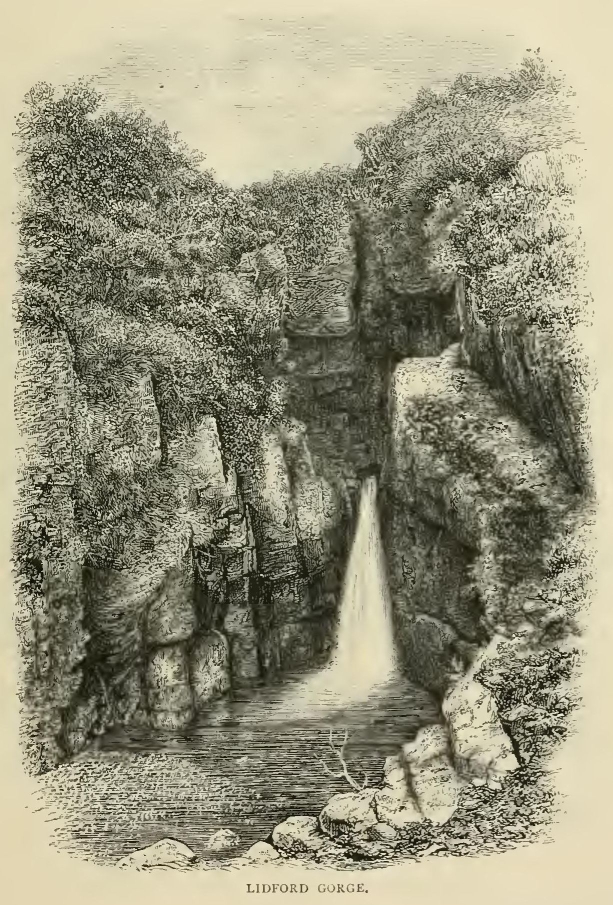
We looked over the parapet, but could discern nothing, owing to the mass of thick shrubs and foliage which overarched the stream, and made our way uphill to the village. Here the traveller is directed to the churchyard, to see a curious epitaph on a watchmaker, in which some rather obvious allusions to human life are borrowed from his craft. Students of mortuary inscriptions are thankful often for small mercies in the way of wit, and are not always careful to note where the humour degenerates into irreverence or worse. We were more sadly interested in the contrast, which we have also observed in other churchyards, between the old style and the new; the simple piety of our fathers and the mimic popery of some of their descendants. Both are very observable at Lidford. One ancient tombstone bore some pathetic lines, beginning,—
"Praise to our God, whose faithful love
Hath called another to His rest."
But the modern fashion was evidently to put up a flimsy cross, with the letters R.I.P., Requiescat in pace! a prayer for the dead, who are beyond our reach, safe in the endless rest, or in a darkness whither our prayers cannot avail them. We left the scene with the feeling deeper than ever, that there are growing up errors among us, against which it becomes all true men earnestly to strive.
Meanwhile we had learned something about the bridge that we had crossed just before, and the rush of waters below. Returning, therefore, and making application at the house close by, we were conducted down into a rocky gorge, through which rushes the Lid, one of the Dartmoor streams, a tributary of the Tamar. The cliffs, irregular and castellated, are seventy feet high; a narrow, dangerous path is carried along one side of the rock, and the wild foaming waters in the dark, narrow glen carry back the traveller's mind to Switzerland. Certainly there is nothing like "Lidford Bridge" elsewhere in England; the Strid in Bolton Woods may equal it in its rush of waters; but the rocks there lie in the open woodland, and the stream is but a few feet below their summit: here the beetling precipices almost meet above, as at the "Devil's Bridge" in Cardiganshire, and there are weird stories at both places of travellers on horseback who have leaped the bridge unconsciously by night, when broken down, only discovering their peril and their escape on the following day.
From Lidford to Tavistock was an easy ride, and we found this pleasant town a place every way suitable for a Lord's Day rest. Outwardly, the great charm of the locality is the meeting-place between the wildness of Dartmoor and the rich cultivation of the valley; while some walks by the river are of a tranquil and serene beauty, only as it seems to us to be found in England, and to be enjoyed on the day of rest. Perhaps our feeling is in a great measure due to association; but if so, we have to thank association for one of the happiest evenings we have known. Next morning we explored the remains of the Abbey—now put to heterogeneous uses—a public library, a Unitarian Chapel, and a hotel, with sundry ruins in the vicarage garden; then a short railway journey carried us across the Cornish border to Launceston, where a short climb through pretty pleasure grounds to the keep of the old castle on the knoll that rises steeply from the town gave us a fine view, from the bulky range of Dartmoor on the one side, to the craggy outline of the Cornish hills on the other.
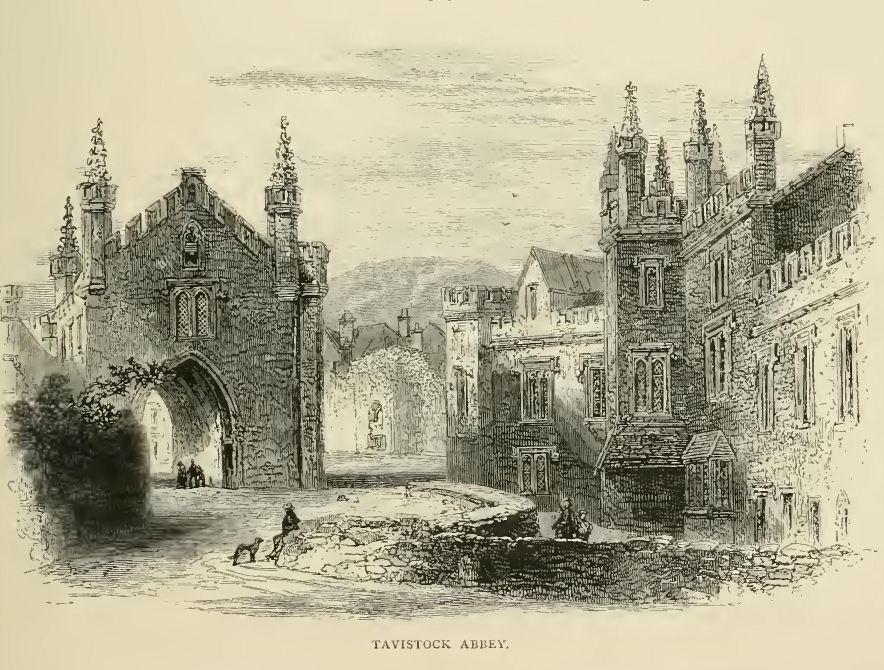
Our object, however, was now to reach the coast; and, as a good test of our pedestrian powers, already pretty well exercised in the course of this charming: tour, we determined to walk over the hills in the direction of the sea, knowing that even if our powers failed, some passing "van" would take us up, and convey us in a primitive fashion to the nearest town. But we persevered, and, when we had accomplished nine or ten miles of an undulating, monotonous road, were rewarded by the first glimpse of the Atlantic, with the cloud shadows lying afar upon the untroubled sapphire; while, though no breeze stirred, there was a sense of freshness in the air that encouraged us to press on to our journey's end. At length we reached it, in a village to name which is to raise in the minds of those who have visited it memories most delightful; while to the multitude it is and will probably remain unknown. We will not call it Trelyon, after the fashion of a popular novelist, who has given us some of the most charming word-pictures of this scenery which our literature contains. Nor is it unkindness to the happy few who already know Boscastle, and one delightful homelike retreat from the world which it contains, to raise the veil a little farther. That it is several miles distant from a railway station, that there is no public conveyance to it but the "vans" already referred to, that gas is a luxury unknown, are points in its favour to those who think, like the Frenchman:
"How sweet, how passing sweet, is solitude!
But give me just one friend in my retreat,
To whom to whisper, 'Solitude is sweet.'"
For society may be found at Boscastle—the society of the chosen few. The place itself is unique. Through tiny meadows a streamlet flows swiftly towards the sea, entering a fissure where the hills, swelling upward on either hand, rise to towering cliffs, inclosing a harbour, up which the tide surges restlessly to meet the stream, then as restlessly subsides. Behind the cliff on the western side, up a broad cleft from the brink of the rivulet to the hill-summit, runs the village, inhabited by a hardy, independent, self-contained race of Cornish people, proud of their scenery, as well they may be. The slate cliffs, in endless diversity of craggy pointed form, skirt the sea, which ever chafes against their bases; here and there a little inlet far below shows a surface of smooth white sand, inaccessible from the land, or to be reached only by the surefooted climber, familiar with every step. Broad grassy slopes crown the cliffs, and every turn discloses magnificent views of sea and shore. Our walk along the cliffs to Tintagel, starting from Willapark Point, the headland that rises so grandly to the west of the little bay, was of an interest which perhaps no other coast scene in England can fully match. First, Forrabury Church was passed, with its silent tower; the bells once destined for it lying, according to tradition, close by, at the bottom of the Atlantic. The ship that conveyed them was nearing the port. "Thank God for a fair voyage," said the pilot. "Nay," replied the captain, "thank the ship, the canvas, and the fair wind." It was in vain that the pilot remonstrated; but even while the ship was rounding the point a sudden storm gathered, the vessel was dashed upon the rocky coast, all perished save the pilot, and the bells sinking to the deep tolled solemnly, as if for the fate of those who would not acknowledge God. Still, it is said, when the storm rises high—
"'Those bells, that sullen surges hide,
'Peal their deep notes beneath the tide:
'Come to thy God in time!'—thus saith the ocean chime:
'Storm, billow, whirlwind past, come to thy God at last.'"
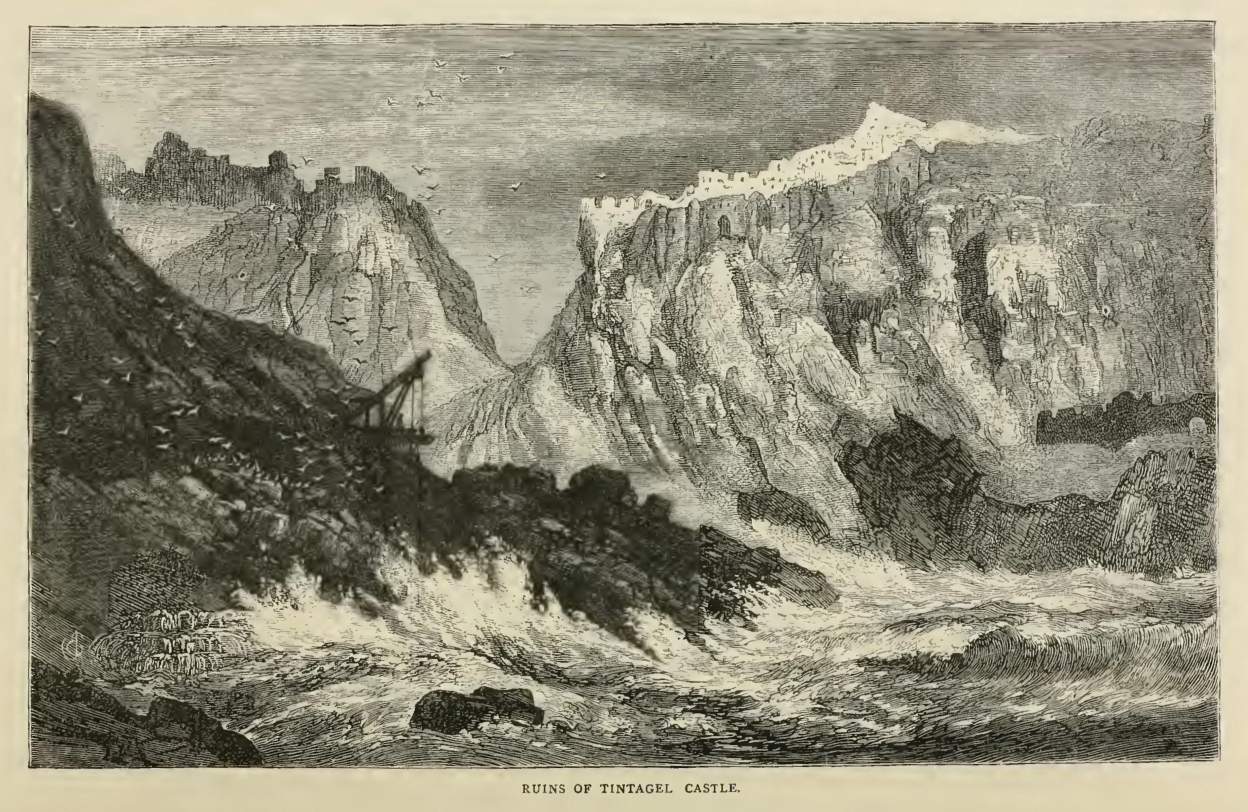
Such is a specimen of the tales told at many a Cornish fireside. As we pass on we feel more and more that we are in the country of legend and song. The rolling uplands that stretch inland, with the deep vales and furzy hollows that intersect them, are renowned as the realm of King Arthur, the hero of British history and fable. Here, on the shore of the Atlantic, he may have gathered his good knights around him, to stand with them against the heathen invader; or it may be that here he was born, according to the legend; while "the great battle of the west," in which the hero disappeared, is said to have been fought at Camelford, in the neighbourhood. Local legends are full of this royal name; and if, as some will have it, King Arthur never existed, the universality of the tradition is all the more remarkable. The impress of his memory and life is everywhere. Of a little cottage maiden who guided us, we ask her name. "Jinnifer," was the reply—an unconscious perpetuation of the name of Guinevere, Arthur's Oueen.
A lovely wooded glen breaks the cliff halfway to Tintagel, at the heal of which the explorer will find a waterfall, in a wild forest ravine, both on a somewhat miniature scale; but in the accessories of rock-hewn walks, with clinging shrubs and mountain spring-flowers, watered by the dashing spray, the dell was perfect. St. Nighton's Keive, or basin, as this romantic nook is called, is a sudden and welcome change from the wild sublimity of the rocks above, and the ceaseless thunder of the Atlantic. But we must reascend; and soon, from our turfy path upon the height we come into full view of a stupendous rock, standing a little way out to sea, the home of myriads of seabirds that circle the rock with weird cries, or, descending in flocks, skim the surface of the waves. They have evidently learned to fear the gun, and to distrust mankind.
Tintagel, now approached, is an irregular village, following the lines and descents of the cliff. The church is on a wind-swept headland to the west, and in its stormiest corner we found the grave and monument of Mr. Douglas Cooke, the first editor of the Saturday Review. It was curious to be reminded of the conflicts of literature at this meeting-place of storms.
Tintagel Castle itself we approached by a path that looked perilous, but was safe enough, descending from the cliff and rising steeply to a promontory or peninsula of slaty rock, on which the ruins stand. These are jagged, time-worn; little plan or order can be traced; such fragments of building as still exist are no doubt of much more recent origin than Arthur's time: the outward glory of the scene is all in the majestic sweep and serried outline of the stupendous cliffs, with the long roll of the sea breaking ceaselessly into billows at their base. The stillness is unbroken, save for this ocean music, with the hoarse cry of sea-birds, and the occasional bleating of the few sheep who pasture here. The sense of isolation becomes at last oppressive, and we gladly retrace our steps to the mainland.
Boscastle remains for a time our home: it is a never-ceasing delight to climb to some nook of the cliffs, east and west, which inclose the little harbour, or to stroll down to the little pier—a trying walk at certain seasons, because of a chemical manure manufactory on the way—or to ramble over the grassy slopes, inhaling the pure breezes of the Atlantic. The Sunday spent in the neighbourhood was one of peculiar delight. Wandering inland, we found a church, in the depths of a wood; the congregation seemed to emerge, we knew not how, from deep bowery lanes and by-paths among the trees; the service was none the less impressive for the singing of birds without and the fragrance of spring blossoms stealing through the open windows. The sermon, too, was appropriate, a tender, practical exhortation to "delight ourselves in God." In the evening of the same day, in the hush of twilight, taking our accustomed path over the cliffs, we came upon a group of people, old and young, who had evidently come thither after an early evening service at one of the chapels: they were holding a prayer-meeting in the rocky nook—singing a hymn as we approached, the burden of which was "Over there," while wistful eyes gazed across the now purple sea, to the splendours which lingered in the west after sunset, as though reminded by those tints of heavenly glory of the land that is very far off. It was good for the stranger to pause by the way, to join in that touching strain, and add his Amen to that Sabbath evening prayer.
Boscastle was so attractive that the rest of a long journey had to be performed in haste. Bodmin, Truro, Redruth, were all rapidly passed, and after climbing Carnbrea, near the latter town, and hearing some of the marvellous stories connected with that giant hill, we took rail for Penzance, anxious at least to visit St. Michael's Mount, the Logan Rock and the Land's End. But what impressed us most, when we reached that last and prettiest of Cornish towns, was the climate. We had believed it spring; but here it was already summer! The last struggle with wintry frosts was over, and the woods and fields were decked with all their wealth of verdure; the air had lost its sharpness, and the rich colouring of every part of the scene, from the golden furze upon the hills to the ruddy lichen on the rocks, seemed to reflect the genial glow. Mount's Bay, still and blue, was wonderful in its contrast with the Atlantic surges that we had just left on the opposite shore. We thought of the words with which Emerson begins one of his lectures: "In this refulgent summer it has been a luxury to live."
St. Michael's Mount, that extraordinary combination, geologically speaking, of granite and clay-slate, remarkable, too, in its correspondence with the much larger Mont St. Michel on the shore of Normandy, is as interesting a place to visit as it is beautiful to look upon. The views from its summit over sea and land are of surpassing loveliness, and to enjoy them to the full it is not necessary to make the hazardous attempt to sit in "St. Michael's Chair," the half, it is said, of an old stone lantern, but overhanging the precipice in a very perilous way. The villagers round the bay will tell you that the archangel himself appears in this "chair" when a storm is raging, and firmly believe that he is the guardian spirit of these seas.
The Logan Rock, to which we next directed our steps, was disappointing in more ways than one: the finest part of the cliff-scenery being the great granite headland, which visitors are apt to pass unnoticed, in searching for the natural curiosity, and in recalling the story of its fall and reinstatement. There are, in fact, many "logan" or logging rocks in granite districts, locally called Tolmęns; one formerly in the parish of Constantine, between Penrhyn and Helston, being larger than this on the coast, though without its magnificent accessories. Their peculiar position is caused by the influence of air and moisture, wearing a fissure in the rock, until a detached upper portion rests only on a small central base. The wonder is in the bigness of the rock thus balanced, and in the evenness of the process of disintegration all around: the vast majority of boulders worn away by such agencies being of course over balanced, so as to fall on one side.
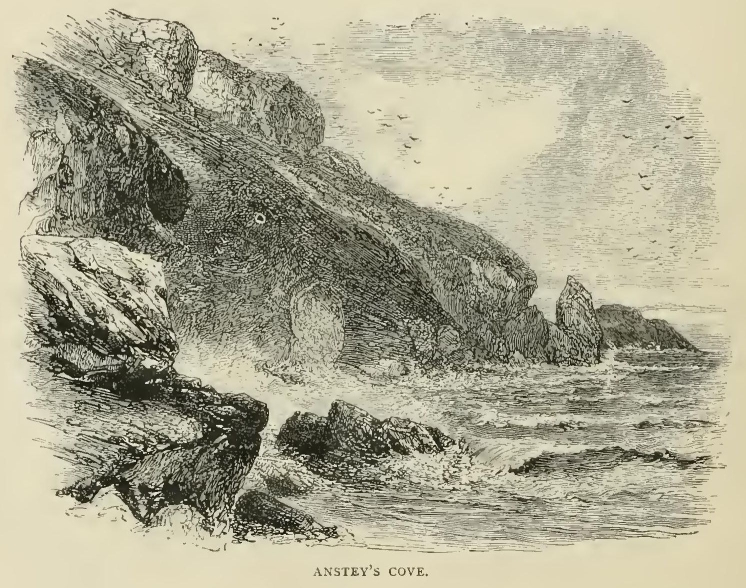
The mechanical restoration of this Logan Rock to its position, and the appliances necessary to keep it in balance, give an artifical air to the whole, and we were glad to turn away to the stupendous cliff scenery, pursuing a path along the rocks to the Land's End, where every point has its old Cornish name, and where the combinations of form and outline, if less imposing than on the northern shore, are still very fine. The granite of which this southern line of coast is composed is more rugged and massive, if less variously picturesque, and the admirer of coast scenery who has explored the two districts—from Boscastle to Tintagel, and from the Logan Rock to the Land's End—has little' more to see or to learn.
The great western promontory has been so often described that we need but refer to our artist's delineation. The low descending promontory, from the great cliff rampart behind, the narrowness of the "neck of land" between "two unbounded seas,"—to adopt the phrase of Charles Wesley's well-known hymn, here written,—the rocky islands near, on which the lighthouse stands, and the ever-chafing restless surge, make up a picture which fills the imagination in many after days.
From this point "the vast expanse of ocean is at all times a grand spectacle; it is terrible when a fierce westerly gale levels before it the whole flow of the sea, driving forward one blinding sheet of foam, even to the summit of the Land's End precipice; but it is yet more solemn in its quieter mood, when, with little wind stirring, the vast billows, propagated from some centre of storms far in the Atlantic, come slowly to break on the rocks in measured cadences of thunder, the very types of enormous power in repose."
But it was now time to turn our thoughts and our course homeward.
Very reluctantly, we left the south of Cornwall unvisited—the Lizard Point, Kynance Cove, and the magnificent harbour of Falmouth, with its flanking castles of Pen-dennis and St. Mawes.
Then there were the great southern towns of Devonshire, with their beauties manifold,—Plymouth and Torquay, with the lovely little watering-places of Teignmouth and Dawlish, and stately Exeter itself. On previous occasions we had visited them all, had spent long dreamy hours in Anstey's Cove, then comparatively unvisited by excursionists, had tenanted humble lodgings at Babbicombe Bay, before the villas were built, and had sailed down the lovely winding Dart to Dartmouth, with its harbour among the hills. The natural beauties are still there, though art has done much of its best or its worst with them since those days. But we must now pass them all by, only in imagination breathing their soft southern airs, or casting hasty glances at one or other of them from the carriage windows of the romantic South Devon Railway. For we have tarried amid the attractions of the far west until the latest possible moment. At six in the morning we leave Penzance; at six in the evening we are in London.
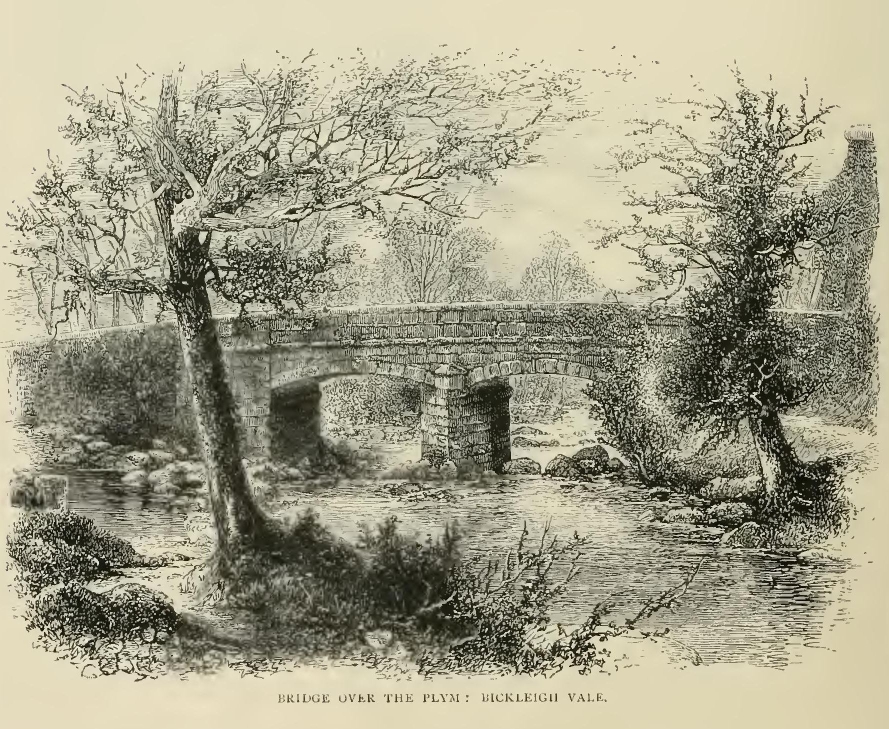
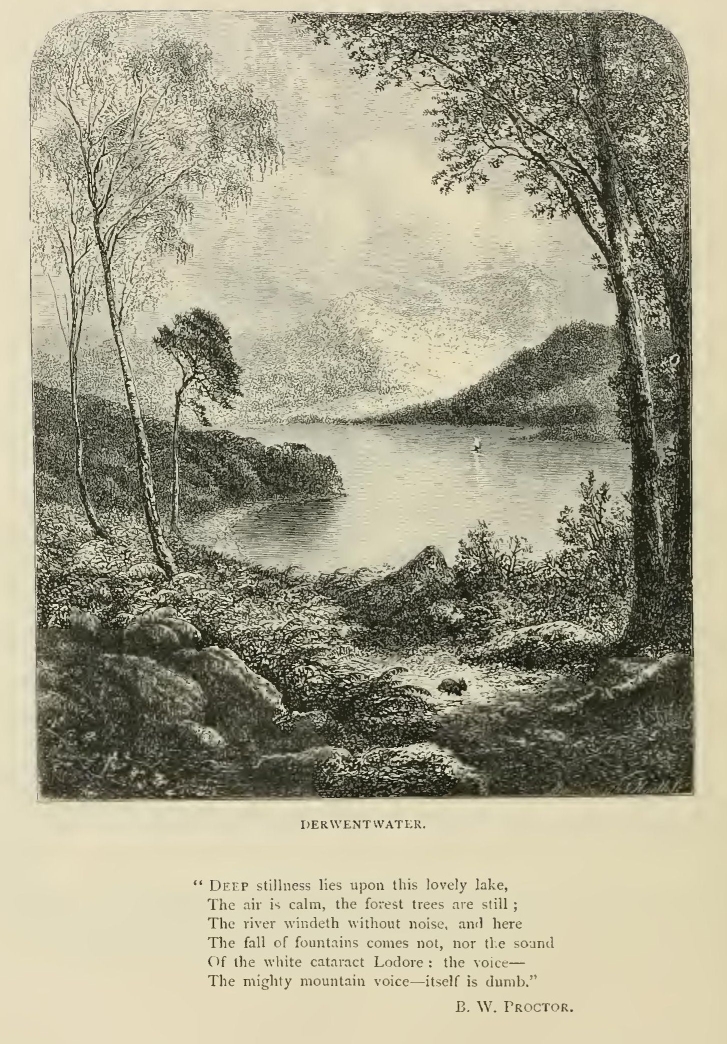
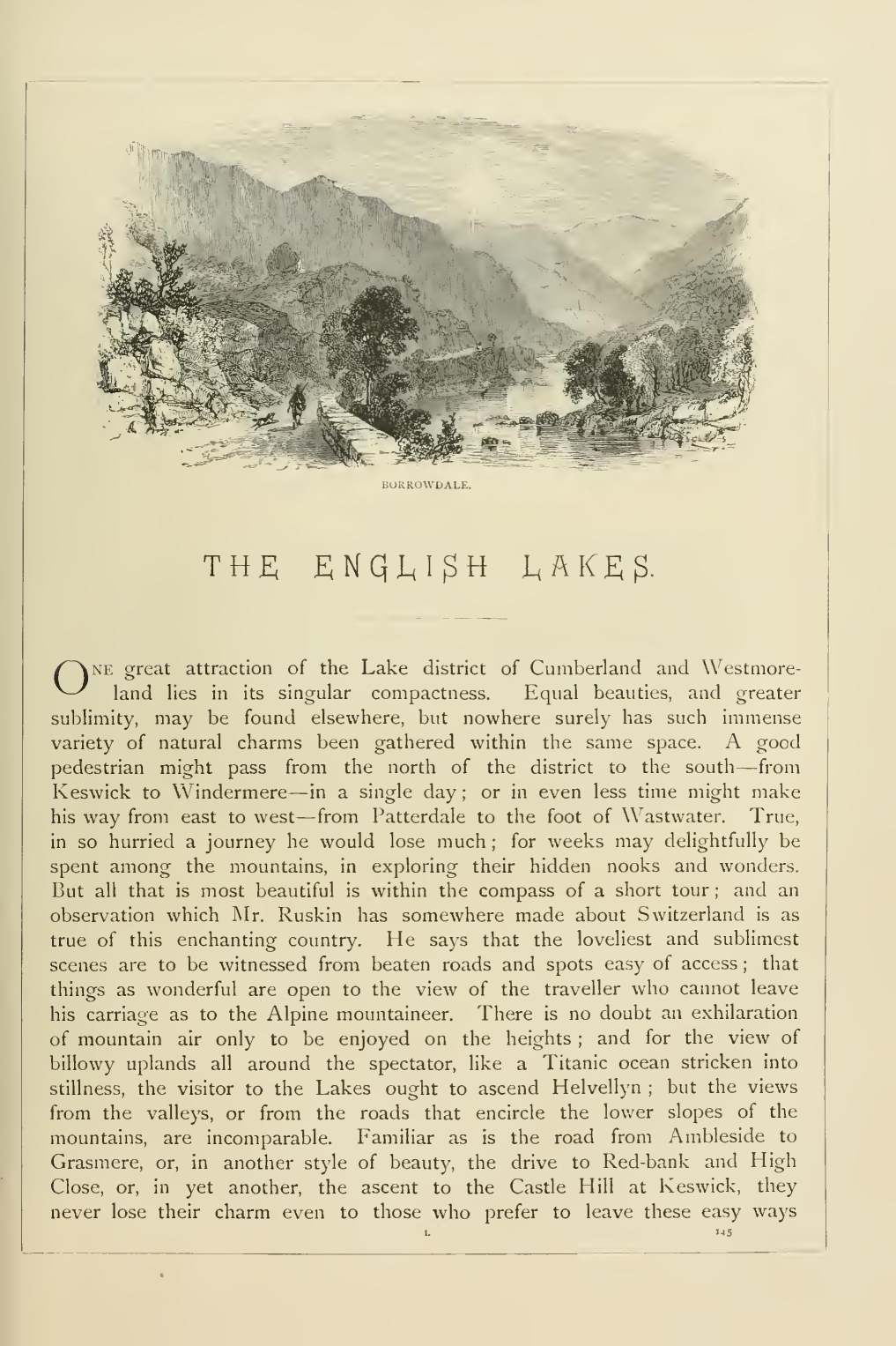
ONE great attraction of the Lake district of Cumberland and Westmoreland lies in its singular compactness. Equal beauties, and greater sublimity, may be found elsewhere, but nowhere surely has such immense variety of natural charms been gathered within the same space. A good pedestrian might pass from the north of the district to the south—from Keswick to Windermere—in a single day; or in even less time might make his way from east to west—from Patterdale to the foot of Wastwater. True, in so hurried a journey he would lose much; for weeks may delightfully be spent among the mountains, in exploring their hidden nooks and wonders. But all that is most beautiful is within the compass of a short tour; and an observation which Mr. Ruskin has somewhere made about Switzerland is as true of this enchanting country. He says that the loveliest and sublimest scenes are to be witnessed from beaten roads and spots easy of access; that things as wonderful are open to the view of the traveller who cannot leave his carriage as to the Alpine mountaineer. There is no doubt an exhilaration of mountain air only to be enjoyed on the heights; and for the view of billowy uplands all around the spectator, like a Titanic ocean stricken into stillness, the visitor to the Lakes ought to ascend Helvellyn; but the views from the valleys, or from the roads that encircle the lower slopes of the mountains, are incomparable. Familiar as is the road from Ambleside to Grasmere, or, in another style of beauty, the drive to Red-bank and High Close, or, in yet another, the ascent to the Castle Hill at Keswick, they never lose their charm even to those who prefer to leave these easy ways for the toilsome walk over the Stake or Sty Head Pass, or up the shaley steeps of Scafell or the tremendous grassy slopes of Skiddaw. The glories of this district are, in a word, for all who have eyes to see and hearts to feel.
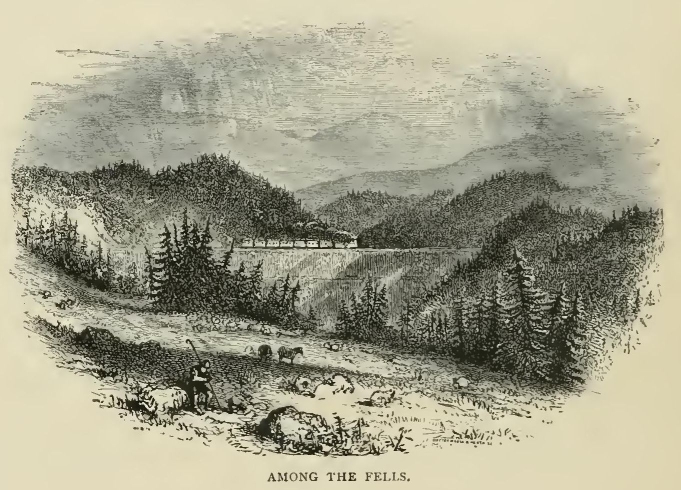
First impressions have great effect, especially in the approach to beautiful scenery; and there are at least three ways to the Lake district from the south which compete one with another in their interest. The first is by rail, northwards from Lancaster to Penrith, passing by the outside or eastern edge of the fells which bound the mountain region. This journey throughout is of wonderful beauty, especially where the broad grassy fells rise steeply on one side of the line, and on the other the hill abruptly descends to the river Lune, here little more than a mountain streamlet, eddying and sparkling through wooded dells. From Penrith, a branch line to Keswick passes in the latter part of its course through an exquisite glen, watered by the streams that come down from the great Blencathara ridge, with many a glimpse of picturesque crags clothed with fern, shrubs and flowers jutting from the mountain's base. All this well prepares the traveller for the glorious view that greets him when he emerges from the station at Keswick, and looks forth upon the amphitheatre of mountains.
Another method of approach is by leaving the Lancaster and Carlisle Railway at the junction for Kendal, so proceeding to the Windermere terminus, situated on a height commanding a magnificent view of the upper part of the lake. The suddenness with which this scene is disclosed, as well as the completeness of its beauty, makes it to many the favourite mode of access. It is also perhaps the most convenient, conveyances to every part of the district being ready as the trains come in. The traveller, however, should it be his first visit, will do well to go up to Orrest' Head, behind the hotel, from which the whole of Windermere, with its islands and the mountains beyond, form a truly enchanting prospect, suggesting to the delighted spectator the wonders beyond.
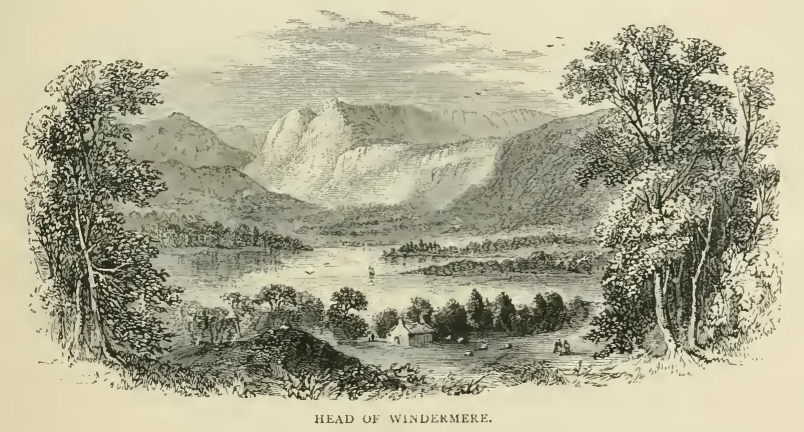
But there is another way of entering this fairy region, by which its beauties are not suddenly disclosed, but grow one by one upon the sight. Still, perhaps, the unique and impressive character of the approach gives this method of access the advantage over every other. So we say to every reader who has not as yet visited the Lakes, Go by the over-land railway along the edge of Morecambe Bay: and to those who have visited it by other routes, Go again by this! The line crosses two estuaries, of the Kent and of the Leven. When the tide is up, the effect of passing through a wide expanse of sea rising to within a few feet of the embankment on both sides is wonderfully striking; and at low water the great reaches of sand are scarcely less impressive. Morecambe Bay, with its curving shore and many inlets, is at all times beautiful, and the mountain ranges are seen dimly in outline across its waters. At several points the railway embankment seems to have effected a change in the sea-level; fields now fertile being fringed on the side farthest from the bay by low cliffs, the bases of which were evidently at no remote period washed by the waters. A vast additional area might, one would think, be still reclaimed by engineering skill without any serious cost. But we pass on to Ulverston, where we change carriages, rather than proceed at present to Furness* and Coniston; the direct entrance to the district being by a short recently-constructed railway along the shore of the Leven up to the foot of Windermere. We pass through a pretty wooded valley beside the bright, swiftly-descending stream, and at the terminus, on the brink of the lake, find a little steamer ready to pass upward. At first the charms of Windermere resemble those of some fair broad river, flowing between ranges of low wood-crowned hills; but the lake soon opens, and after we have passed Belle Isle, opposite Bowness, any disappointment we may have felt at first yields to unbounded admiration. The mountains at the head of the lake disclose their grand outlines, appearing to change their relative positions at every turn of the steamer; and some persons acquainted with mountain scenery in many lands pronounce the view of these heights a little before sunset in summer time to be unsurpassed in beauty. Wansfell Pike on the right, Fairfield in front, and the Langdale Pikes in the distance on the left, with the broken lines and broad uplands of Loughrigg Fells between, all invested with the shadowy tints of evening, form a picture which in its tender aerial loveliness seems ready to vanish while we gaze.
* There is another way of entering the district, by the
Furness Railway, and along the west coast, as far as the
station at Seascales or Drigg: thence to Wastwater, and
Wastdale Head. The traveller will thus plunge at once into
the wildest and most desolate part of the Lake country,
emerging into fairer scenes.
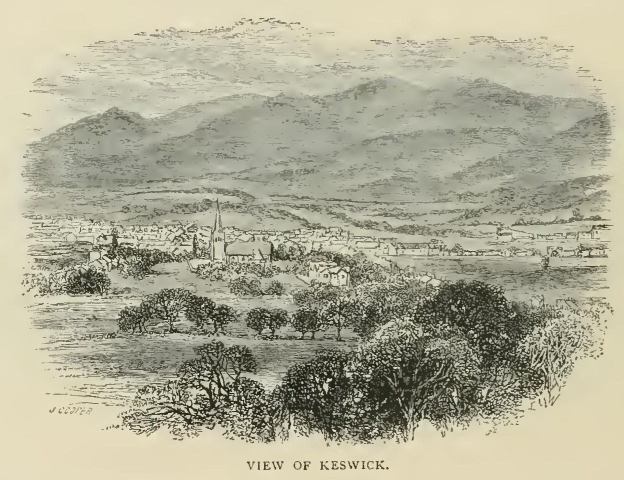
If the ways of entering this fair district are manifold, so are the method and order in which its attractions may be viewed. These must be studied in the guide books, and every traveller will shape his route for himself. In this, much will depend on the time at command. We have spent three days among the Lakes, and again a week, again a month; and while the shorter period enabled us to see much, the longer did but prove to us that the beauties were inexhaustible. Some visitors take Ambleside as their headquarters, some Grasmere, some Keswick; others, happier in their decision, have no headquarters at all, but range from place to place. As a centre, we should prefer Grasmere; but every one will have his own preference. It may almost be said that the Lake country has its controversies and sects, with as many divisions of opinion on the question which part is the fairest, as on more important matters. Some give the palm to Ullswater among the lakes, an equal number to Denventwater, a minority to Windermere, while there are those who prefer the silent and gloomy Wastwater. Then who shall say whether the view from Helvellyn, Skiddaw, or Scafell is the most marvellous in its beauty? Our advice is to join none of the sects, to take no part in the controversy, to climb all three of the mountains, and to visit, if possible, all the lakes! After this our advice may be thought to savour of partisanship, when we say that the visitor who wishes to know the full and perfect beauty of this region, whether he enter from the north, or west, or south, must on no account neglect to visit Keswick and Skiddaw.
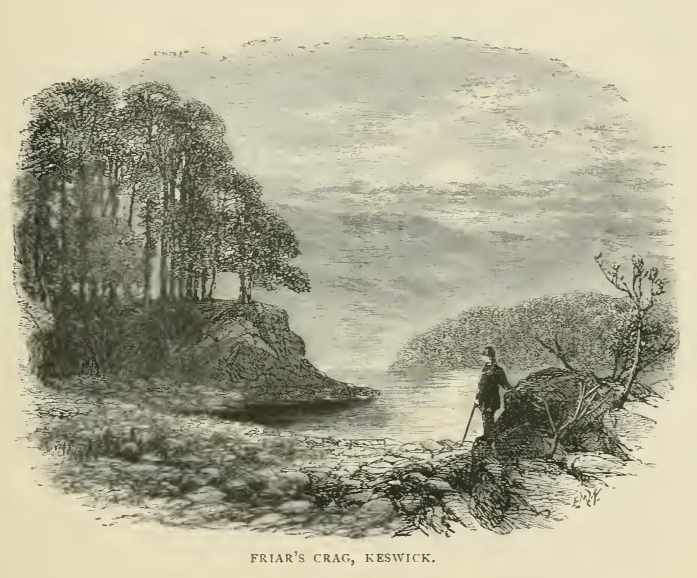
The lovely lake of Derwentwater is so near to the little town, there are so many points, as Friar's Crag, Castle Crag, and Latrigg, accessible by the most moderate walking, and the days' excursions from the place are so various and delightful, that none will feel our counsel to be out of place. Not to mention that, in the by no means rare or improbable event of a rainy day, there are the pencil factories and the models of the Lake district. The latter should be seen alike by those who have traversed the region, and by those who have not; the former will be interested in recognising the places that they have visited, and the latter, in making out their intended tours.
The great excursion from Keswick is one which is made by multitudes on foot or in carriages; and for variety of charm within a comparatively short compass its equal is hardly to be found. First the road leads between the lake and an almost perpendicular crag, wooded to the summit. Barrow Falls, in the pleasure-grounds of a mansion, may be visited on the way; and few will omit to see Lodore, at the other end of the lake. The charm here is that of a steep and rocky glen: rarely indeed does the "water come down," at least in the summer-time, after the fashion described in Southey's famous lines.
Then the grandeurs of Borrowdale unfold themselves, and Rossthwaite, in the heart of this valley, is the very ideal of sequestered loveliness. The road, turning to the right at Seatoller, climbs a long steep hill beside a dashing torrent. A little way beyond the summit is Honister Crag, most magnificent of inland cliffs; and so, amid wild rock-scenery on either hand, we descend to Buttermere. The drive now discloses a grand amphitheatre of mountains, whose summits form a rugged ever-changing line against the sky. Soon the little inn is reached; but we would advise no tourist so to occupy himself with the welcome refreshment, though flavoured with that "best sauce," a sharp-set appetite, or even with the ever-amusing "Visitors' Book," as to neglect rowing across Crummock Water, when a walk of about a mile will take him to Scale Force, in its deep rocky glen, the loftiest and noblest, as well as the most secluded of the lake waterfalls. The drive back from Buttermere to Keswick, by the Newland Valley, or the Vale of Lorton, with its old yew tree, is full of interest, from the bold mountain forms ever in view, but has not the wonderfully varied beauty of the Borrowdale and Seatoller route.
Everybody, as we have said, takes this drive: but there is an excursion known to comparatively few, not a very long one, but "beautiful exceedingly."
Should a morning at Keswick be unemployed, or if the question should arise in the interval of wider explorations: "What shall I do to-day?" our advice is to go up to Watendlath. This is a narrow upland valley, extending from the head of the stream that supplies Barrow Fall, to that which comes down at Lodore, then up by the latter to the tarn from which it flows. It may be reached by one of two or three routes from below, and after a short ascent the traveller finds himself, as it were, in the very heart of the hills; a still and lovely world, above the beaten ways, with nature's fragrance and music all around. We have suggested "a morning" for the excursion, but it is still better to proceed leisurely; resting on some turfy bank beside the path, in happy talk with congenial friends; or, if alone, in quiet communion with our own souls and with Him who has made the world so beautiful. In the earlier parts of the walk the occasional views over Derwentwater, and down to Bassenthwaite, with Skiddaw towering grandly in one direction, and the Borrowdale Mountains in another, are magnificent; but in the heart of the glen, leading up beside the Lodore torrent, these are gradually left behind. When the hamlet, and the tarn with its bright rippling waters, at length are reached, and the torrent has been crossed by a little rustic bridge, Ross-thwaite is descried below, and may be reached by a steep descent; or the stout pedestrian may strike boldly over Armboth Fall for Thirlmere at the foot of Helvellyn, or if he please may climb still higher by the side of the Lodore stream until he reaches Blea Tarn, high up among the fells.
Which of the three great mountains of the Lake district to choose in preference for an ascent, it would be hard to say. On the whole, our own associations would lead us to select Skiddaw; but if Helvellyn and Scafell can also be ascended, so much the better. The distant views from Skiddaw of the Solway Firth and the Scottish hills are very fine in clear weather; but undoubtedly the wild magnificence of the mountain groups as seen from Helvellyn is incomparable. The majesty of Scafell is the majesty of desolation. Carlyle says:—
"From this centre of the mountain region, beautiful and solemn is the aspect to the traveller. He beholds a world of mountains, a hundred savage peaks—like giant spirits of the wilderness; there in their silence, in their solitude, even as on the night when Noah's deluge first dried." *
* Sartor Resartus.
But of all mountain scenes, that which most abides in our memory is that which was suddenly outspread before us one summer evening, a little before sunset, in descending Skiddaw. The afternoon had brought swirling blinding mists about our upward path; we had reached the summit with difficulty, only to find ourselves enveloped on all sides in a white chilly sea of cloud. Passing breezes and sweeping sheets of vapour had created the hope that the mists would soon pass away; but it seemed in vain to wait, and we began descending. Then as we reached a little knoll on the mountain's side, the mist parted before us, and in an instant had rolled far back on either side. Through its vast shadowy portal, it was as if Paradise were unveiled! The atmosphere below was perfectly transparent and still; the rays of the sun were reflected in crimson glory from the lake, so as in an instant to bring to the mind of every member of our party the Apocalyptic vision of the "sea of glass mingled with fire." The splendour lighted up every mountain side where it fell, their crags were gold and purple, the verdure of the upland slopes and thick woods, with the living green of the woods and meadows, gleamed with a more than tropical brilliancy; and the long dark shadows which everywhere lay athwart the scene only set in brighter contrast the surrounding glory. The mists fleeted, vanishing as they ascended the mountain side; the magnificence of colouring soon subsided into quiet loveliness, then into a sober grey; the vision had faded, leaving deep suggestions of those possibilities of beauty everywhere latent in this fair creation, perhaps to be fully disclosed when the new heavens and earth shall appear.
Space fails us now to speak of the rival beauties of Ullswater, where the surrounding mountains are closer and grander than in any other part of the district. Every competent pedestrian we would advise to walk to this lake, from the border of Thirlmere, and over the summit of Helvellyn. Should this be too great a tax on the tourist's powers, he will find the way by Griesdale, a pass between Fairfield and Helvellyn, a very practicable walk amid grand scenery. And when Ullswater is reached, what more charming nook can there be than Patterdale, deep set among the hills? After a little time spent there, we pant perhaps for more open scenery and a more stimulating atmosphere; and there is the climb over Kirkstone Pass to meet our desire, and to carry us back to beautiful Windermere, our first love and our last, in all this haunted realm!
We have pursued for the most part a beaten track, verily believing, as we said at the outset, that here the choicest beauties are to be found. But there is many a hidden little-visited nook where the superadded charm of solitude seems to enhance all the rest; and we shall be indignantly told by many that we have left the loveliest spots without a mention. What can be more perfectly beautiful than the view's from the hill-sides above the head of Coniston Water? What valley can vie, in its combination of lofty cliff, green slopes, richly varied woodland, and gleam of rushing waters, with the approach from Coniston to Little Langdale? The few who in another part of the district follow the Liza down to Ennerdale will have it that there is a wild beauty in this glen which gives it a charm beyond all others. And so is it on the other side, with the scarcely larger band of visitors to secluded Mardale and wild and lonely Haweswater. Then, as to mountain passes, the climber sneers at Griesdale, calls Kirkstone a "Turn-pike-road," thinks there is nothing worth an effort but the Stake, between Langdale and Borrowdale, Sty Head, between Langdale and Wastdale, or Black Sail and Scarf Gap, from Wastdale to Buttermere. And even these passes are not Alpine. Go in a fault-finding mood, and you will discover that the torrents are without volume, that the mountains lack elevation, that the lakes are insignificant in size. But the man whose eye and heart are open to the impression of beauty will be indifferent to these comparisons, will rather rejoice in the limitations which permit every element of grandeur and loveliness to be gathered into so small a space; and for ourselves we may say that we have never appreciated the charm of the English Lakes so truly as when we have visited them after a tour amid the mightier wonders of Switzerland.
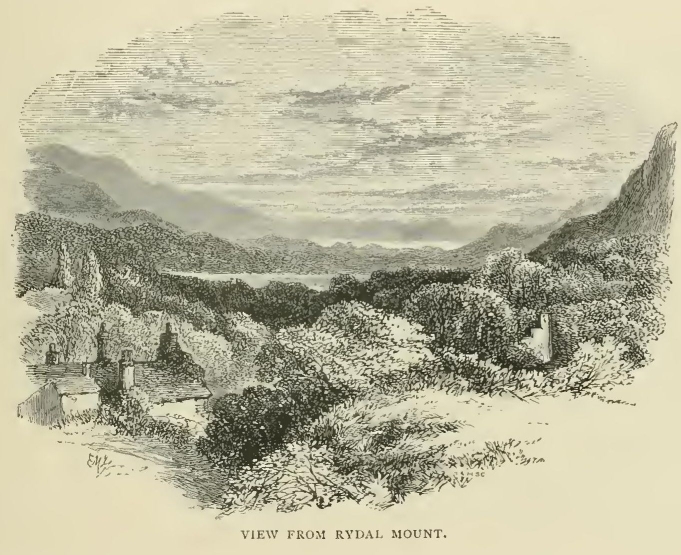
At Ambleside there is many a pleasant resting-place in which to recall the pleasures and sum up the impressions of the journey, and to dwell, as many love to do, upon the associations of one and another great name by turns with almost every part of the district. First and foremost is Wordsworth, the poet of nature;—the great "Lake Poet," only because nature here is at her loveliest,—who from his home at Grasmere, and afterwards at Rydal Mount, gave utterance, more richly, truly, deeply, than any writer of his generation, of man's delight in the Creator s work. The association of his name with his beloved lake country is imperishable. Many years ago De Quincey wrote, with reference to Wordsworth's earlier poems, "The very names of the ancient hills—Fairfield, Seat Sandal, Helvellyn, Blen-cathara, Glaramara; the names of the sequestered glens—such as Borrowdale, Martindale, Mardale, Wastdale, and Ennerdale; but, above all, the shy pastoral recesses, not garishly in the world's eye, like Windermere or Der-wentwater, but lurking half unknown to the traveller of that day—Grasmere, for instance, the lovely abode of the poet himself, solitary, and yet sowed, as it were, with a thin diffusion of humble dwellings—here a scattering, and there a clustering, as in the starry heavens—sufficient to afford, at every turn and angle, human remembrances and memorials of time-honoured affections, or of passions (as the 'Churchyard amongst the Mountains' will amply demonstrate), not wanting even in scenic and tragical interest—these were so many local spells upon me, equally poetic and elevating with the Miltonic names of Valdarno and Vallombrosa." *
* Works, vol. ii. p. 124.
The spell remains, though some of the aspects of the scenery have changed. Grasmere, for instance, is no longer a "shy pastoral recess," but the stream of life that daily pours through the valley cannot impair its beauty. This of all the lakes possesses, when the wind is still, the supreme charm of perfect stillness and transparency. We have seen it when it was absolutely impossible to distinguish its richly-wooded banks, or the island near its centre, from their reflection in the unrippled water. The unclouded blue of the heavens was mirrored, as in fathomless depths. It was a "sea of glass like unto crystal." It may be hoped that this loveliness will be uninvaded by anything which would mar its perfection. We know that Wordsworth pathetically protested against the invasion of the railway; but on the height which the Windermere station occupies, at the very portal of this beautiful land, it in no degree interferes with the enjoyment of the scenery, while facilitating the access of multitudes who could not otherwise share the delight. The railway station at the foot of the lake, that on the border of Coniston, and even that at Keswick, are, so to speak, outside the magic circle; but we can fully sympathise with Mr. Ruskin and others who have employed such strenuous efforts to resist every threatened or possible inroad. The very compactness of the region, and the ease with which, when once reached, it may be traversed throughout, might lead the most impatient traveller to be satisfied with the existing means of swift access. When the border is gained, let him proceed leisurely, and enjoy. If young, the stagecoach travelling, which is here so common, may yield him an unfamiliar, though old-fashioned kind of delight. To judge from our own youthful recollections, as well as from the literature of a past generation, there was, in favourable circumstances of scenery and weather, an exhilaration in such journeys which never is or can be known in the rapid rush through railway cuttings, and over high embankments, behind the "Erebus" or "Phlegethon," at the rate of fifty miles an hour! And many an elderly or middle-aged man almost unconsciously exults in the renewal of his youth in that grand coach-drive from Windermere over Dunmail Raise to Keswick.
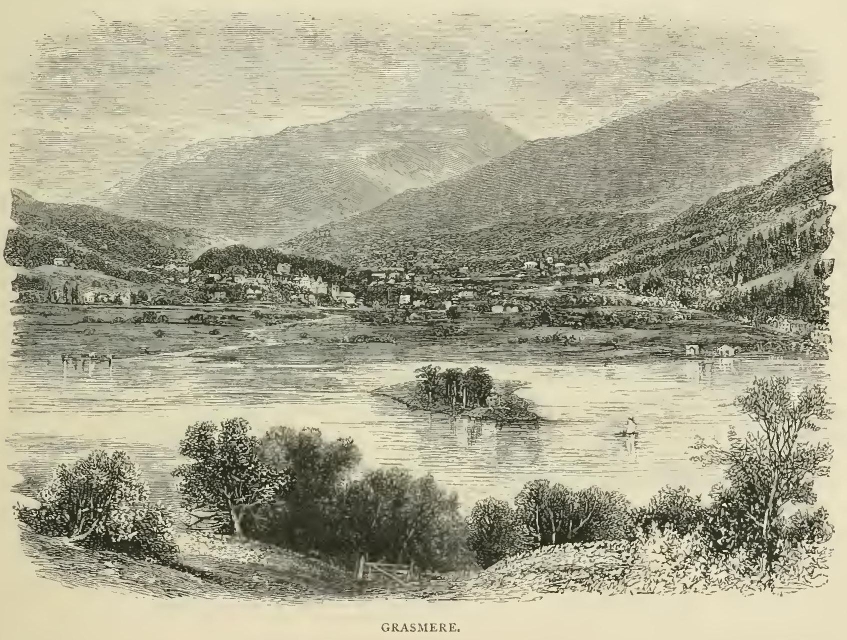
But we return for a moment to the personal associations of this region. Southey has often been classed with Wordsworth as belonging to a school of "Lake Poets." Nothing could be more erroneous, as De Quincey pointed out long ago. It is true that these poets both lived by the lakes; but there is no sense in which they can be described as of the same "school." In fact, they are curiously unlike in many of their chief characteristics; although they esteemed each other truly; and very noble are the lines which Wordsworth has dedicated to the memory of his friend:
"Wide were his aims; yet in no human breast
Could private feelings find a holier nest.
His joys, his griefs, have vanished like a cloud
From Skiddaw's top; but he to heaven was vowed,
Through a life long and pure, and Christian faith
Calmed in his soul the fear of change and death." *
* From the Epitaph on Southey, by Wordsworth, in Crosthwaite
Church, Keswick.
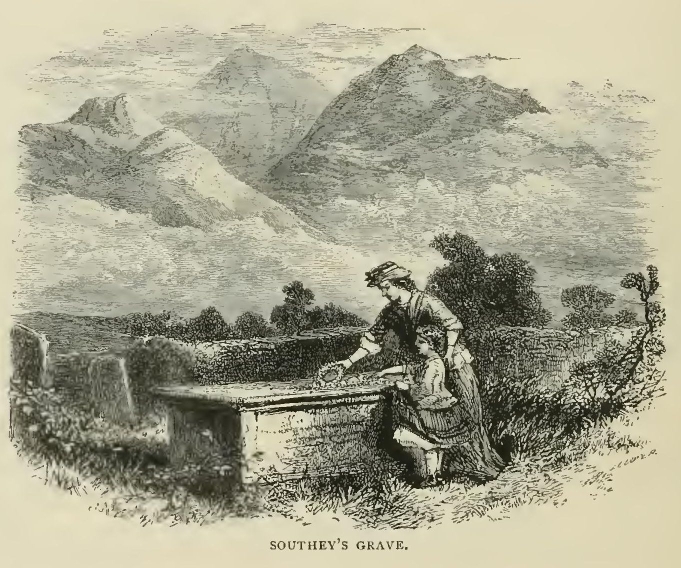
Other names arise to mind. Close under Orrest Head was Elleray, once the beautiful home of Professor Wilson, the "Christopher North" whose "recreations" were to describe, in language of a rich and gorgeous luxuriance which the present generation is scarcely able to enjoy, but which the readers of a past age dwelt upon with rapture, the glories of mountain, lake, and sky. Fox How and the Knoll, between Windermere and Rydal Water, bring to mind two very different names, each of great influence in their generation. At the former, Dr. Arnold, of Rugby, passed his happy vacations; in the latter, Miss Harriet Martineau endeavoured—with what success we attempt not here to judge—to work out her theory of life. The name of Coleridge also connects itself with this region; not of the philosophic teacher and wonderful talker, though we have known the mistake to be made by people well informed. Samuel Taylor Coleridge, as Carlyle says, "sat on Highgate Hill having left the lakes for the great city, never to return." It was his son Hartley whose brilliant gifts, in their fitful and broken splendour, have caused the name of Coleridge to be remembered, and repeated with pitying affection, all through the Grasmere Vale.
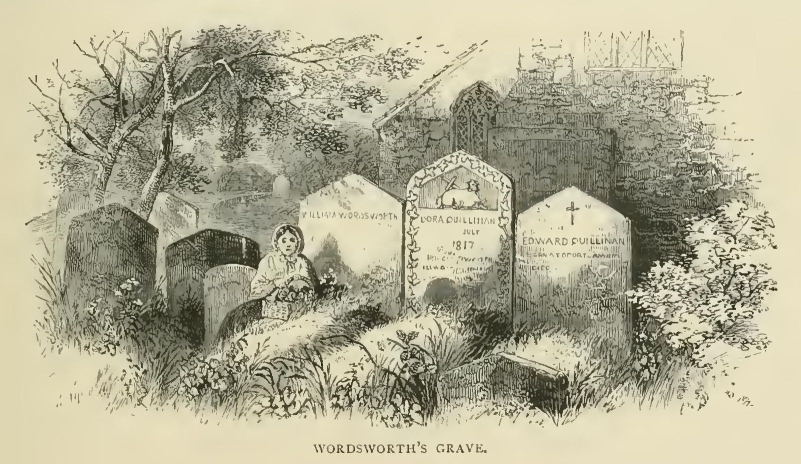
We turn reluctantly from this world of beauty, happy in the remembrance of what we have seen and felt, happier perhaps that so much remains unvisited in a region where every by-way and secluded dell has its own peculiar loveliness, and that we may hope to return again and yet again to explore its wonders. For the mountain climber, are there not Great Gable, Bowfell, Fairfield, Pillar Mountain in Ennerdale, steepest of all, Blen-cathara, otherwise Saddleback, with its unequalled view of Derwentwater, and Coniston Old Man, with its grand prospects over land and sea? These six are scarcely inferior in height to the imperial three,* whose names and forms are most familiar. Then the Langdales should be climbed; one or both, as a position below the loftiest in a mountain land affords the best point of view from which to apprehend the grandeur of the surrounding hills. And after the greater lakes have been duly visited, what wealth of hidden beauty is there in those retired valleys, where rivulets suddenly expand into fair still sheets of water, reflecting the mountains at whose base they lie; and what lonely grandeur in the tarns high among the hills, rarely visited by human foot, and, like Scales Tarn on Blencathara, so surrounded by wild crags as hardly ever to admit the sunlight! Excursion after excursion may be made, not only by the angler, but by those who have no taste for such sport, to these lofty miniature lakes.
Or, if the tourist delights in waterfalls, let him seek out Dungeon Ghyll in Langdale, or go up behind the inn at Ambleside to Stock Ghyll, or stop on his way through the valley to admire the two picturesque Falls at Rydal, or ramble through Gowbarrow Park, near Ullswater, as far as Airey or Ara Force, which "by Lyulph's Tower speaks from the woody glen," or let him make a special excursion to Eskdale to see Stanley Ghyll, described by some tourists as the most beautiful of all. The beauty of these cascades, and of others less famed, arises not from the volume of water, but from the picturesqueness of the glens in which they lie; these being, in almost every case, deep and narrow fissures in the rock, covered with ferns, mosses and shrubs in the utmost luxuriance. The varied tints of the rocks and of the foliage by which they are clothed give richness of colouring to the picture; and when the sunlight falls upon the dashing spray, and rainbow tints hang over the fall, the surpassing loveliness of the scene is even enhanced by the smallness of its scale.
It would hardly be possible to omit, in any notice of the Lake district, however incomplete, a reference to the great uncertainty of the weather. In the deeper valleys, especially, as Wastdale and Buttermere, the traveller is often sorely disappointed by incessant rain. Yet even this has its compensation in the increased translucency of the air, the beauty of the mountain streams and cascades, with the incomparable splendours of the parting clouds, when the sunlight has smitten them apart, and their white trains vanishing up the mountain-side are as the robes of angels. When the summer airs elsewhere are stifling, and the ground is parched, the effect of the frequent mists and showers is fully seen. For then the whole lake country is as green as an emerald; and, except in the deepest valleys, the wearied brain and limbs are refreshed by stimulating mountain airs. Such seasons perhaps are the best for a visit to the Lakes; but they are beautiful in winter too, when the snows linger on the heights, and in the early spring, when the greensward is carpeted with wild flowers, and in the autumn, when the purple, gold, and crimson clothe the woods in a royal array, while the withered Reaves elsewhere strew all the ground. "Those only know our country," say the dwellers among the lakes, "who live here all the year round." Be it so. It is good to carry in memory, into the busy, more prosaic walks of life, the glimpse, if it be no more, of all this beauty; and, after all, it is the "still sad music of humanity" that thrills the soul more deeply than the music of the whispering woods, or of the torrent down the mountain side. It was the Poet of the Lakes and Mountains who closed one of the noblest of his odes by the words:
"Thanks to the human heart by which we live,
Thanks to its tenderness, its joys, its fears;
To me, the meanest flower that blows can give
Thoughts that do often lie too deep for tears."
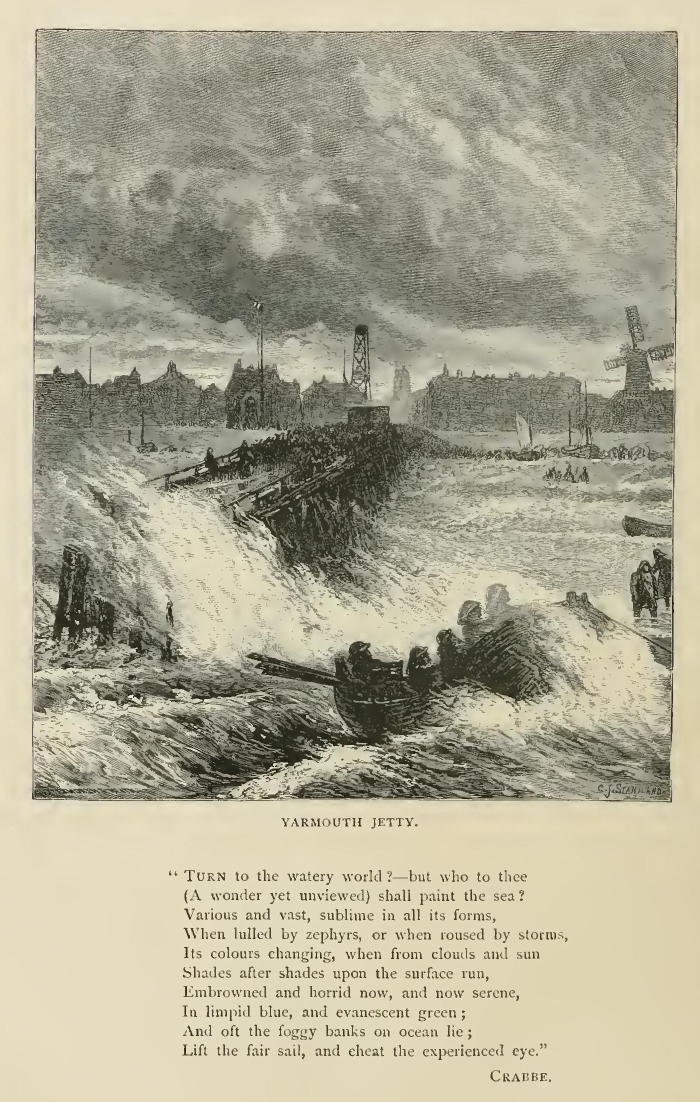
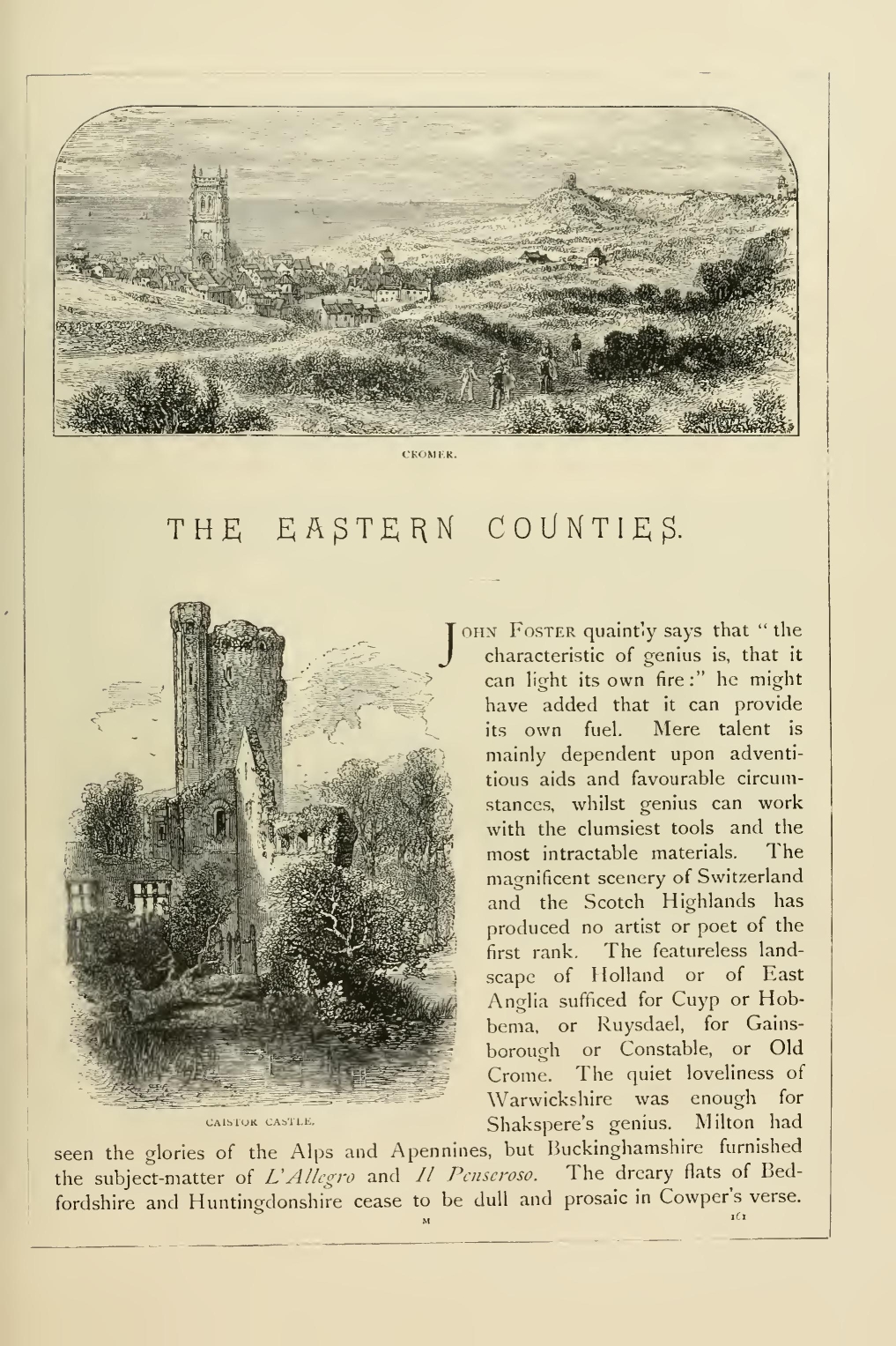
John Foster quaintly says that "the characteristic of genius is, that it can light its own fire:" he might have added that it can provide its own fuel. Mere talent is mainly dependent upon adventitious aids and favourable circumstances, whilst genius can work with the clumsiest tools and the most intractable materials. The magnificent scenery of Switzerland and the Scotch Highlands has produced no artist or poet of the first rank. The featureless landscape of Holland or of East Anglia sufficed for Cuyp or Hobbema, or Ruysdael, for Gainsborough or Constable, or Old: Crome. The quiet loveliness of Warwickshire was enough for Shakspere's genius. Milton had seen the glories of the Alps and Apennines, but Buckinghamshire furnished the subject-matter of L'Allegro and Il Penseroso. The dreary flats of Bedfordshire and Huntingdonshire cease to be dull and prosaic in Cowper s verse.
The themes of Tennyson's earlier poems were drawn from the fens and meres and melancholy swamps of Lincolnshire. The truth is, that the eye makes its own pictures, and sees just what it has the power of seeing.
"O Lady! we receive but what we give,
And in our life alone does nature live:
Ours is her wedding-garment, ours her shroud!
And would we aught behold, of higher worth,
Than that inanimate cold world allowed
To the poor, loveless, ever-anxious crowd,
Ah! from the soul itself must issue forth
A light, a glory, a fair luminous cloud
Enveloping the Earth—
And from the soul itself must there be sent
A sweet and potent voice, of its own birth,
Of all sweet sounds the life and element."*
* Coleridge's Sybilline Leaves.
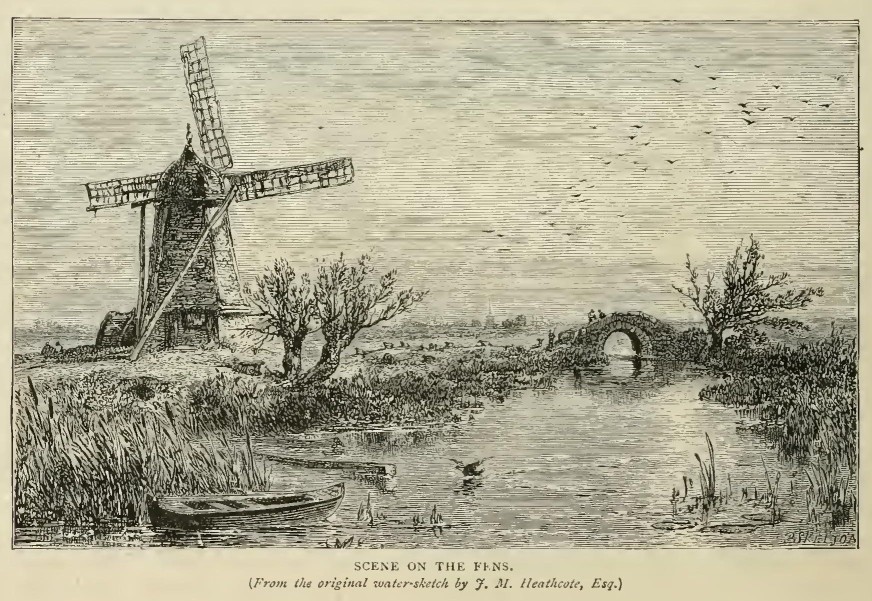
It must, however, be confessed that it would be difficult at the present day to find poetry or beauty in the Fen country. The meres have been drained, the swamps have been reclaimed. The profusion of aquatic plants and wild-fowl has disappeared. Whittlesea Mere and Ramsey-Mere have been brought under the plough. Even the picturesque old windmills have given place to the hideous chimney-shafts of pumping stations worked by steam. We may almost parody the famous chapter of Olaus Magnus on "Snakes in Iceland," and say—there are no fens in the fen country. If we would know what the fens were once like, we must, read some of Tennyson's earlier poems, or better still perhaps, one of Kingsley's prose Idylls:
"A certain sadness is pardonable to one who watches the destruction of a grand natural phenomenon, even though its destruction bring blessings to the human race. Reason and conscience tell us, that it is right and good that the Great Fen should have become, instead of a waste and howling wilderness, a garden of the Lord, where
'All the land in flowery squares,
Beneath a broad and equal-blowing wind,
Smell of the coming summer.'
And yet the fancy may linger, without blame, over the shining meres, the golden reed-beds, the countless water-fowl, the strange and gaudy insects, the wild nature, the mystery, the majesty—for mystery and majesty there were—which haunted the deep fens for many a hundred years. Little thinks the Scotsman, whirled down by the Great Northern Railway from Peterborough to Huntingdon, what a grand place, even twenty years ago, was that Holme and Whittlesea which is now but a black, unsightly, steaming flat, from which the meres and reed-beds of the old world are gone, while the corn and roots of the new world have not as yet taken their place.
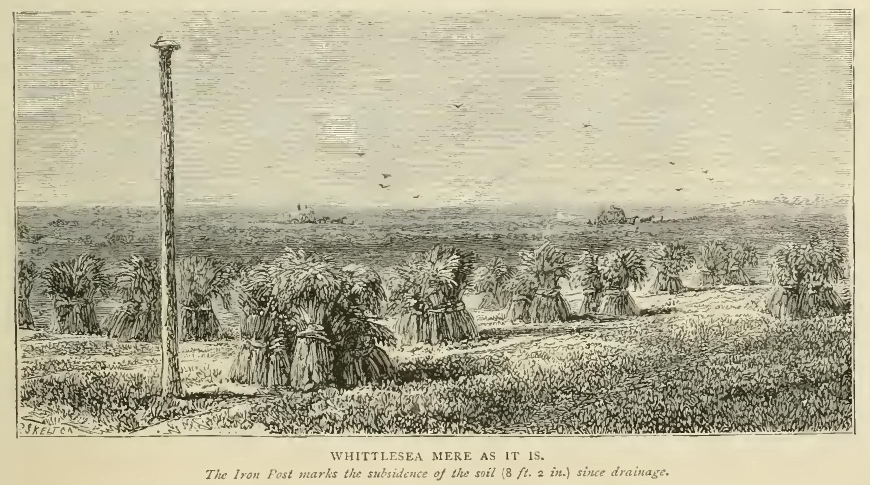
"But grand enough it was, that black ugly place, when backed by Caistor Hanglands and Holme Wood, and the patches of the primeval forest; while dark-green alders, and pale-green reeds, stretched for miles round the broad lagoon, where the coot clanked, and the bittern boomed, and the sedge-bird, not content with its own sweet song, mocked the notes of all the birds around; while high overhead hung motionless hawk beyond hawk, buzzard beyond buzzard, kite beyond kite, as far as the eye could see. Far off, upon the silver mere, would rise a puff of smoke from a punt, invisible from its flatness and its white paint. Then down the wind came the boom of the great stanchion-gun; and after that sound another sound, louder as it neared; a cry as of all the bells of Cambridge, and all the hounds of Cottesmore; and overhead rushed and whirled the skein of terrified wildfowl, screaming, piping, clacking, croaking, filling the air with the hoarse rattle of their wings, while clear above all sounded the wild whistle of the curlew, and the trumpet note of the great wild swan.
"They are all gone now. No longer do the ruffs trample the sedge into a hard floor in their fighting-rings, while the sober reeves stand round admiring the tournament of their lovers, gay with ears and tippets, no two of them alike. Gone are ruffs and reeves, spoonbills, bitterns, avosets; the very snipe, one hears, disdains to breed. Gone, too, not only from Whittlesea but from the whole world, is that most exquisite of English butterflies, Lycaena dispar—the great copper; and many a curious insect more. Ah, well, at least we shall have wheat and mutton instead, and no more typhus and ague; and, it is to be hoped, no more brandy-drinking and opium-eating; and children will live and not die. For it was a hard place to live in, the old Fen; a place wherein one heard of 'unexampled instances of longevity,' for the same reason that one hears of them in savage tribes—that few lived to old age at all, save those iron constitutions which nothing could break down." *
* Prose Idylls, New and Old, by Rev. Charles Kingsley.
One of the most characteristic walks in the Fen country is that from Peakirk (St. Pega Kirk), a station on the Peterborough and Spalding line, to Crowland. The road runs along the top of a high bank, raised so as to be above the reach of the inundations. On either hand a flat and dreary plain stretches to the horizon. It is intersected by ditches filled with black stagnant water and fringed by aquatic plants, amongst which the yellow iris is prominent. Here and there a farm-house, approached by an avenue of pollard-willows, and surrounded by a few acres of well-cultivated land, breaks in upon the monotony of the scene. Elsewhere the vegetation is rank and coarse but abundant, upon which droves of horses and cattle thrive. A perpetual chorus of croaking from innumerable frogs in the marshes accompanies the pedestrian on his way, to which the sweet notes of the sedge-warbler and other small birds form an exquisite accompaniment.
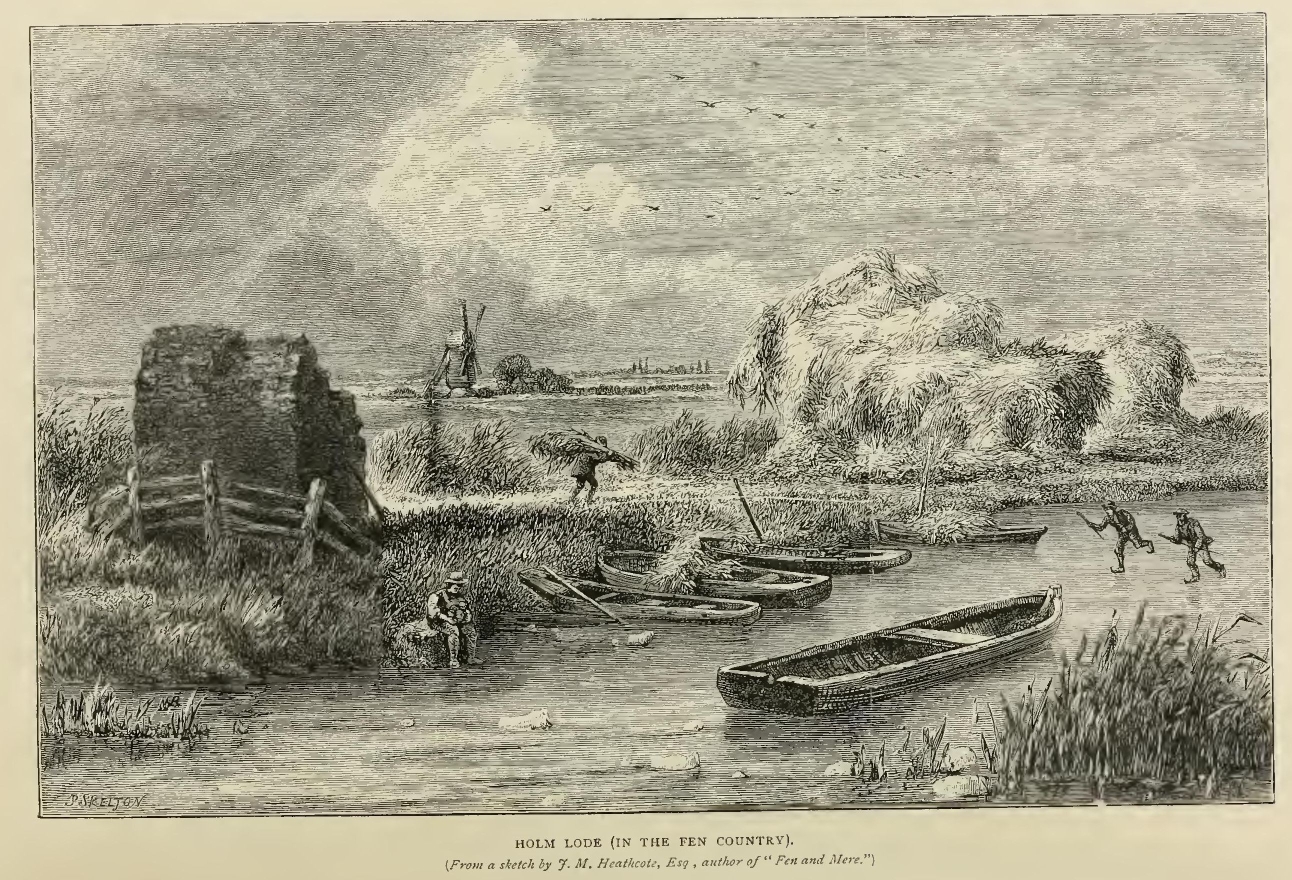
In the winter, when the fens are flooded and frozen over, the scene is one of rare interest and excitement. The clear sharp ring of the skates on the ice, the merry shouts of the skaters, the stir and bustle of a district usually so dull and stagnant, the feats of agility and skill displayed by a peasantry to skate a mile in two minutes, but without success, though he is said to have only exceeded the two minutes by two seconds.
The ordinary pace of a fast skater is one mile in three and a half or four minutes." He who is so fortunate as to see one of the great skating-revels of these eastern counties under the glowing light of a sunrise or a sunset will not easily forget it—for the sunrises and sunsets of the Fen country are of incomparable splendour. It is an error to suppose that the dry pure atmosphere of Southern Europe is favourable to these magnificent effects of colour. Some of the finest sunsets I have ever seen have been when walking westward along Oxford Street on a frosty evening. The clouds of smoke and mist hanging over the great city have become suffused with a glory of crimson and purple and amber with which no Italian sky can compare. So in the Fen country, the clouds and fogs driven inland from the sea, and the humid vapours exhaled from the soil, glow with all imaginable hues in the light of the setting sun. The cold colourless landscape reflects the radiance and is tinged with the colours of the sky; the skaters as they glide swiftly past through the golden haze seem like actors in some fairy spectacle.
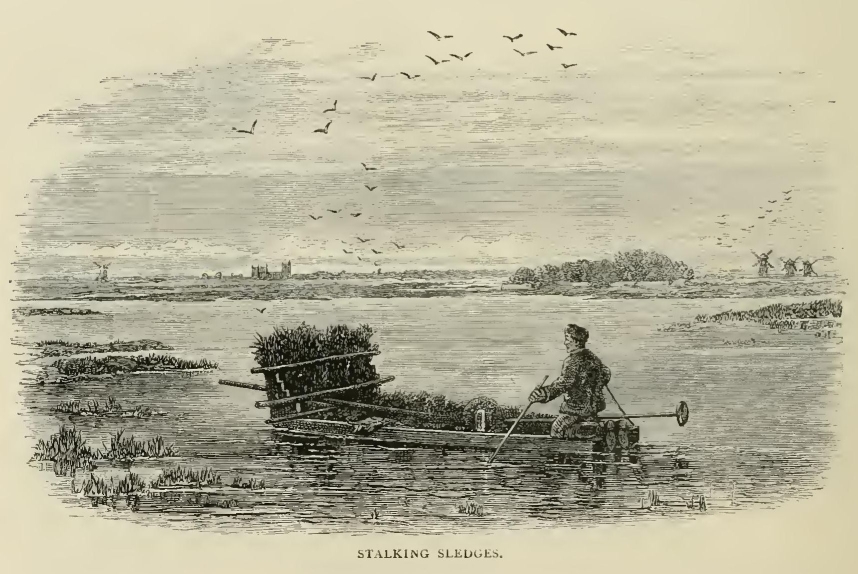
Before the reclamation of the fens, the swamps and meres which covered so large a portion of the soil were the haunt of innumerable wild fowl, which were the source of considerable profit to the fensmen. Of late years their numbers have greatly diminished, but the London market is still largely supplied from this district. Flat-bottomed boats screened by reeds so as to resemble floating islands are fitted with heavy duck-guns, from a single discharge of which dozens of birds sometimes fall. One of the best duck-decoys remaining in East Anglia lies at a short distance from the road midway between Peakirk and Crowland. A small mere a few acres in extent forms the scene of operations. From this run eight ditches, or "pipes," as they are locally called, ten or twelve feet wide at the entrance, and about a hundred feet long, diminishing to a narrow gutter at the end. They curve round so that only a small part of the whole is visible from any point. They are inclosed by walls of matted reeds and roofed over by nets. Tame ducks are trained to lead the way into the mouths of the pipes, and are followed by the wild fowl. Little dogs, of a white or red colour, enter the pipes through holes made in the reed screens, gambol about inside for a minute or two, come out again, and again show themselves a little higher up the pipe. The wild fowl, though easily alarmed, are very curious and inquisitive. They swim or fly forward to investigate this strange phenomenon till they have gone too far to recede, when the net closes upon them, and the whole flock is taken.
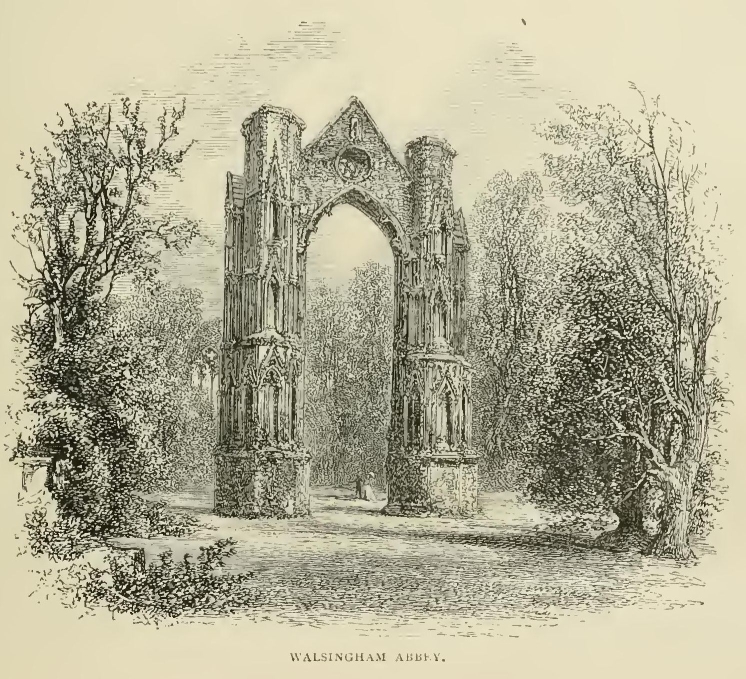
In the days of yore, when this district resembled a great lake studded with numerous islands fringed with willow groves, it was the seat of numerous ecclesiastical establishments of great wealth and influence—Peterborough, Crowland, Ely, Thorney, Spalding, Ramsey and others. The insulated sites were favourable to the seclusion of the cloister, the patches of land were exceedingly fertile, and the water abounded with fish and wild fowl. On one of these Fen islands rose the great Abbey of Crowland, the ruins of which come into view some miles before we reach it. Its foundation goes back to Saxon times, and it was repeatedly sacked by the Danes. Turketul, grandson of King Alfred, who through four successive reigns had rendered important services to the nation by his valour in the field and his wisdom in counsel, returning from a journey to the North, found the abbey a ruin. Of the once flourishing community only three monks remained to tell the story of the massacre of their brethren and the destruction of their abbey by the invaders. They accommodated their illustrious visitor to the best of their ability amongst the fire-scathed walls of the church, and entreated his intercession with the king for assistance. The interview made a deep impression on his mind, and, reaching home, he astonished his royal master by avowing his intention to become a monk. Accordingly he caused proclamation to be made by public crier that he was anxious to discharge his debts, and if he had wronged any man would restore fourfold. Resigning all his offices, Turketul repaired to the Fens, devoted himself to the rebuilding of the abbey and the restoration of its fallen fortunes, became abbot, and there spent the remainder of his days.
A curious structure, known as Crowland Bridge, which stands in the centre of the town, has greatly perplexed archaeologists, and given rise to various legends. It consists of three semi-arches whose bases stand equi-dis-tant from each other in the circumference of a circle and unite in the centre. At the foot of one of the arches is a mutilated statue, apparently holding an orb in the right hand. Local tradition declares that three rivers ran through the three arches into an immense pit dug to receive them, and that the statue represents Oliver Cromwell with a penny roll in his hand! The most probable explanation of the remarkable structure is that it was a high cross built to form a trysting-place for the fens-men, who, when the Fens were flooded, might bring hither their produce for sale in boats, and that the figure is St. Guthlac, the founder and patron of the abbey.
If East Anglia possesses little natural beauty, it is rich in historical associations. Reference has already been made to the many noble ruins of ancient ecclesiastical buildings throughout the Fen country. Their traditional reputation has been handed down in an old rhyming legend:
"Ramsey, the rich of gold and of fee,
Thorney, the flower of many a fair tree,
Crowland, the courteous of their meat and drink,
Spalding, the gluttons, as all men do think,
Peterborough the proud, as all men do say,
Sawtrey, by the way, that old abbey,
Gave more alms in one day than all they."
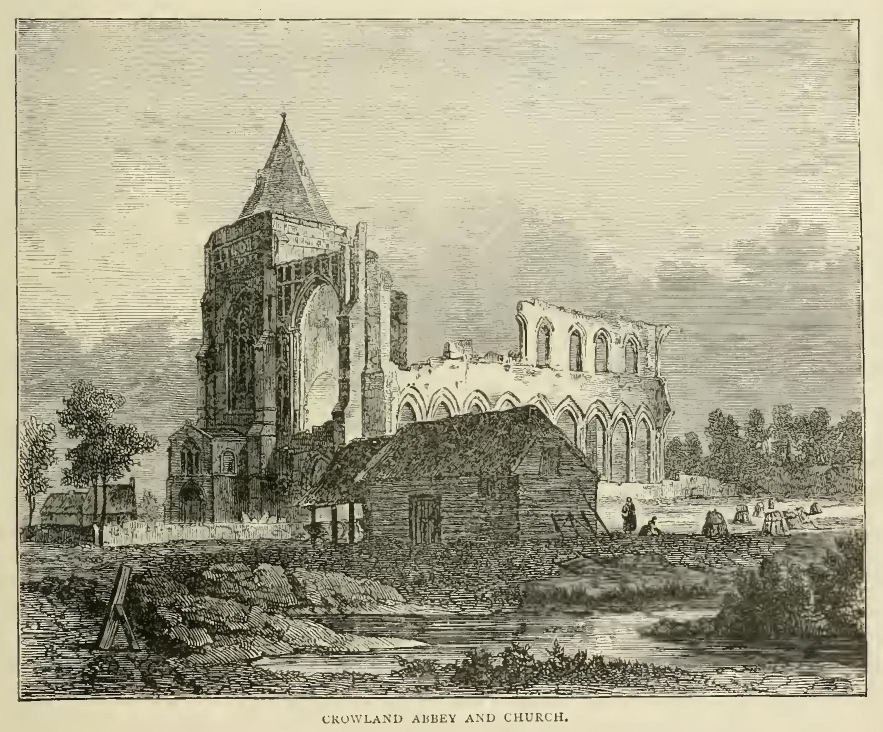
It maybe doubted whether in any part of the world four such cathedrals can be found in the same compass as Lincoln, Peterborough, Ely, and Norwich. And it is certain that with the single and doubtful exception of Oxford, no such magnificent collection of collegiate edifices exists as those of Cambridge. "That long street which, beginning from the Trumpington Road, skirts the magnificent Fitzwilliam Museum and the Pitt Press; which passes by ancient Peterhouse and quaint St. Catherine on one side; which is there known as King's Road and fronts the glories of King's College, the Senate House, the Library, and Caius College; which then in a darkening and narrow street, almost a very gorge, skirts the old historic gateways of Trinity and St. John's, and afterwards emerges past the chapel which is the latest architectural glory of Cambridge, opposite the venerable round church and near the new buildings of the Union—certainly in its long broken wavering line, this street may enter into formidable competition with the High Street of Oxford or any of the streets of the world.
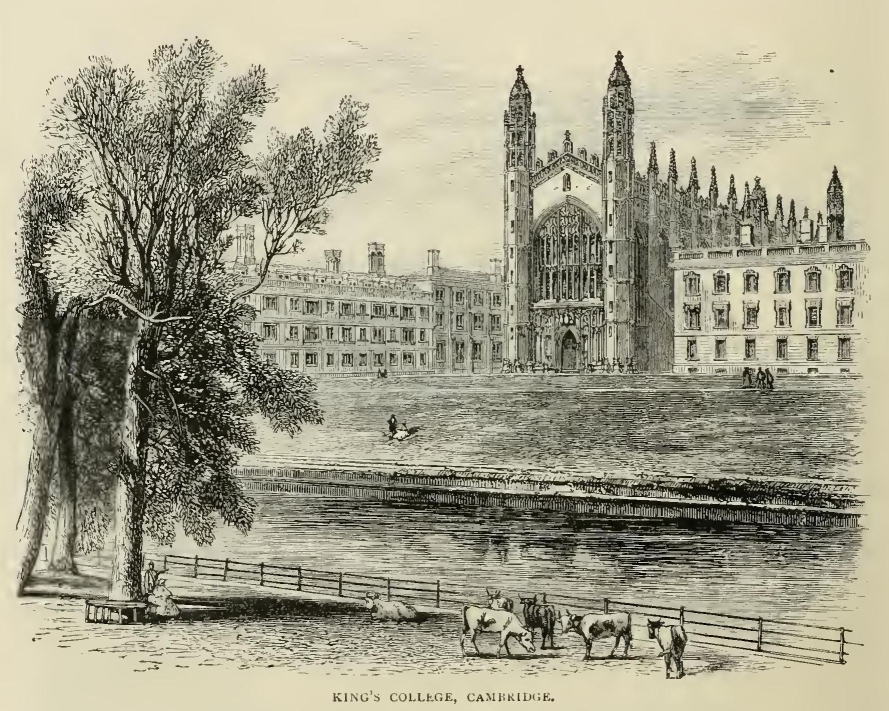
There are, moreover, several distinct features in which Cambridge is unsurpassable. The wide silent old court of Trinity, with its babbling fountain; the glorious structure of King's College; above all, that exquisite scenery, a composition made up of many varying beauties known as the "backs of the colleges are separate features to which Oxford can hardly offer a parallel. As an Oxford poet has said:—
"Ah me! were ever river banks so fair,
Gardens so fit for nightingales as these?
Were ever haunts so meet for summer breeze,
Or pensive walk in evening's golden air?
Was ever town so rich in court and tower
To woo and win stray moonlight every hour?" *
* From Oxford and Cambridge, their Memories and
Associations. Religious Tract Society.
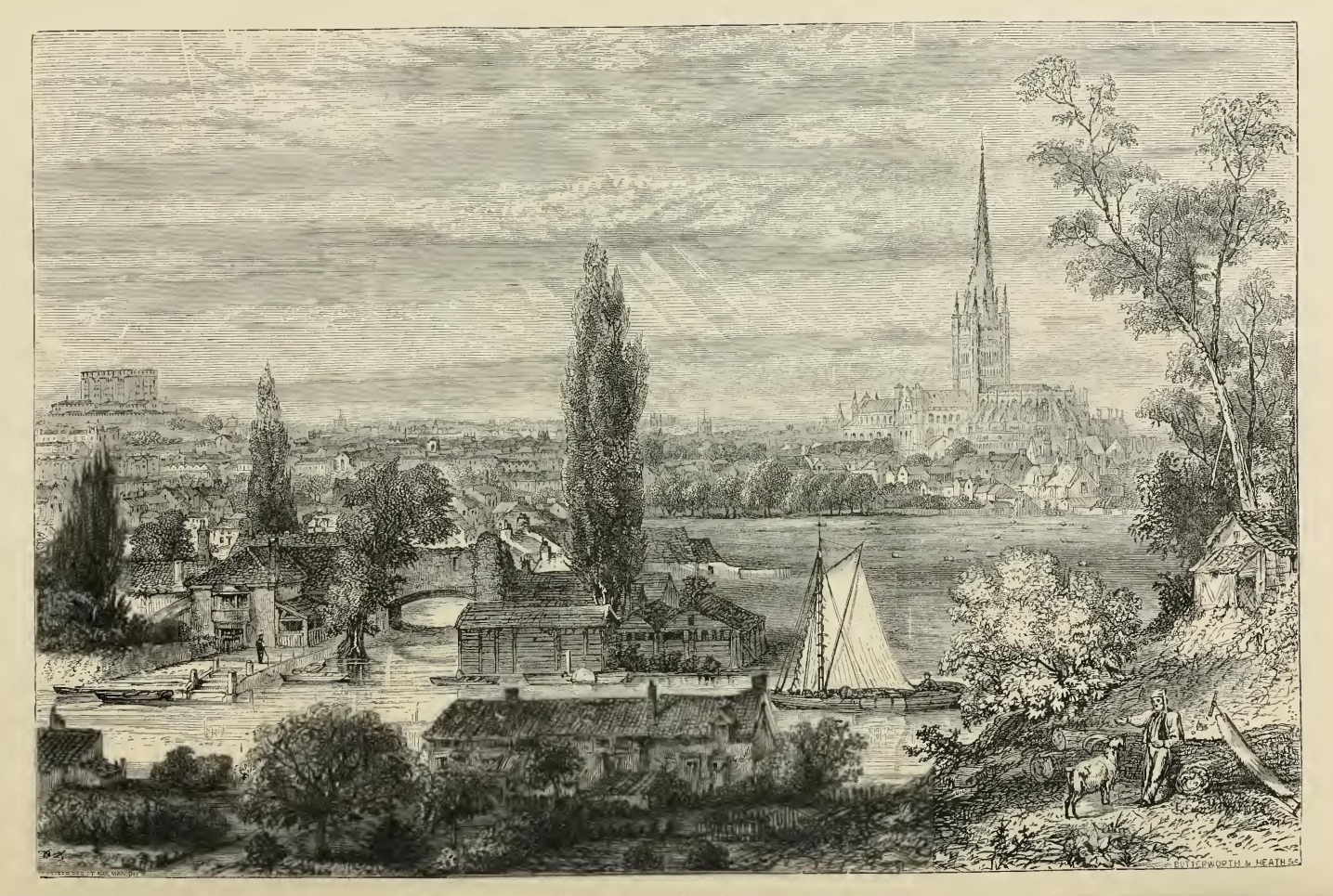
Among the cities of East Anglia, Norwich claims special mention. Though a local couplet declares that—
"Caistor was a city when Norwich was none.
And Norwich was builded with Caistor stone."
Yet the parvenu upstart goes back to the time of the Roman occupation of the island. It was the capital of the Saxon kingdom of East Anglia, and for many centuries afterwards it held a prominent place in our history. So early as the reign of Edward III. it was one of the great centres of our manufacturing industry; the Flemish settlers having here introduced or developed the woollen trade. In pre-reformation days it was a stronghold of the Wyckliffites or Lollards, many of whom here sealed their testimony with their blood. In 1531, Thomas Bilney was added to the list of worthies who make up the Norwich Martyrology. Probably no other provincial town in England has given so many eminent names to the literature, science, and art of our country, from Sir Thomas Browne, author of the Religio Medici, down to Harriet Martineau. Even apart from these interesting associations, Norwich itself deserves and will well repay a visit.
Surrounded by wooded slopes and pleasant meadows and winding streams, its streets full of quaint picturesque architecture, and dominated by its noble castle and cathedral, few or none of our English cities offer a more pleasing combination of urban and rural beauty.
The tourist in search of the picturesque in East Anglia will do well to include Yarmouth among his wanderings.
Its surroundings indeed are as flat and uninteresting as possible. The readers of David Copperfield will remember his description: "As we drew a little nearer and saw the whole adjacent prospect lying in a straight line under the sky, I hinted to Peggotty that a mound or so might have improved it; and also that if the land had been a little more separated from the sea, and that the town and the tide had not been quite so mixed up like toast and water, it would have been nicer. But Peggotty said with greater emphasis than usual, that we must take things as we found them; and that for her part she was proud to call herself a Yarmouth Bloater."
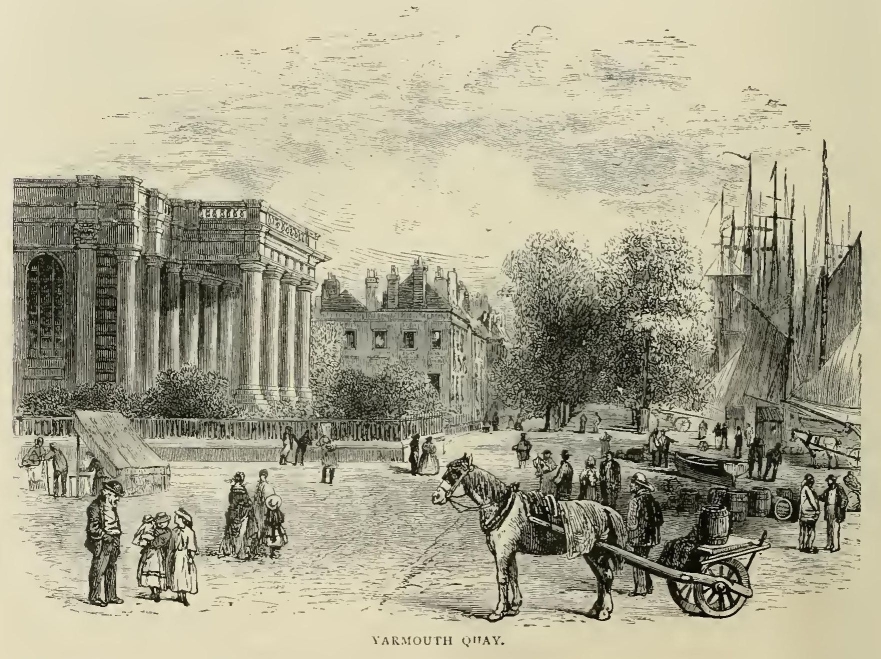
But the town is a curious combination of English bustle and Dutch quaintness. Its quay reminds the traveller of the Boomptjies of Rotterdam; its "rows," only a few feet wide, with a narrow riband of sky overhead, recall the narrow streets of Genoa; its vast fleet of herring-boats discharging their silvery "harvest of the sea" at the wharves, offer a spectacle almost unique in the world. Unlike Norwich and many other neighbouring towns, Yarmouth has been the scene of no important event in our history, nor has it contributed any illustrious name to our list of worthies. A stained glass window in the parish church, however, perpetuates the earthly memory of one whom Scripture declares shall be "had in everlasting remembrance"—Sarah Martin, the prison visitor. She was a poor dressmaker, without wealth or social position, earning with difficulty a scanty subsistence by her needle, yet doing a work comparable to that of John Howard or of Elizabeth Fry. The great lesson of her life has been admirably inculcated by an eloquent American preacher:
"Here, on a lowly bed, in an English village by the sea,—fades out the earthly life of one of God's humblest but noblest servants. Worn with the patient care of deserted prisoners and malefactors in the town gaol for twenty-four years of unthanked service, earning her bread with her hands, and putting songs of worship on the lips of these penitent criminals,—Bible and Prayer-book in his feeble hand, saying, at the end, 'I have been the happiest of men, yet I feel that death will be gain to me, through Christ who died for me.'
"Blessed be God for the manifold features of triumphant faith!—that He suffers His children to walk toward Him through ways so various in their outward look—Sarah Martin; from her cottage bed, Earl Spencer from his gorgeous couch, little children in their innocence, unpretending women in the quiet ministrations of faithful love, strong and useful and honoured men, whom suffering households and institutions and churches mourn. All bending their faces towards the Everlasting Light, in one faith, one cheering hope, called by one Lord, who has overcome the world, and dieth no more! The sun sets; the autumn fades; life hastens with us all. But we stand yet in our Master's vineyard. All the days of our appointed time let us labour righteously, and pray and wait, till our change come, that we may change only from virtue to virtue, from faith to faith, and thus from glory to glory!"
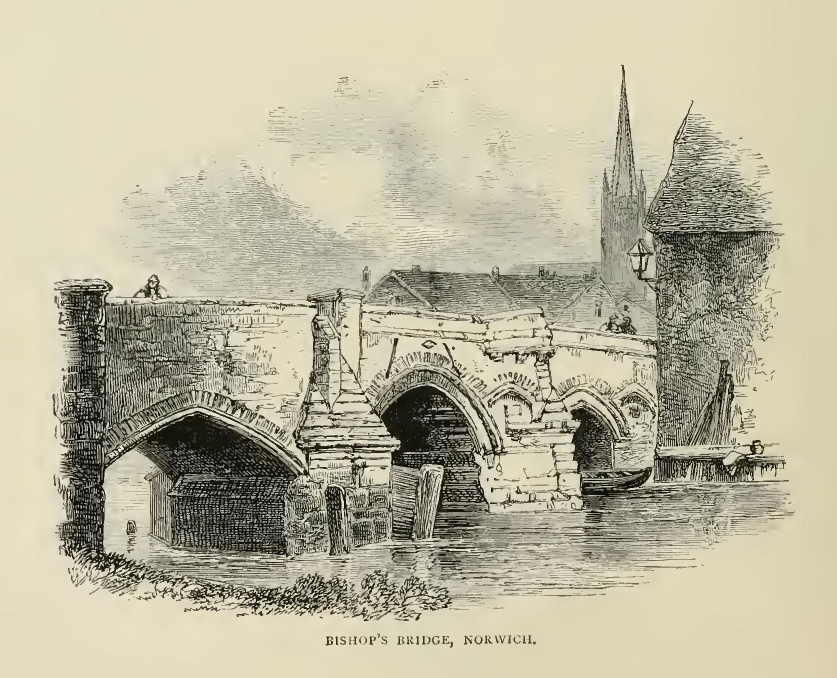
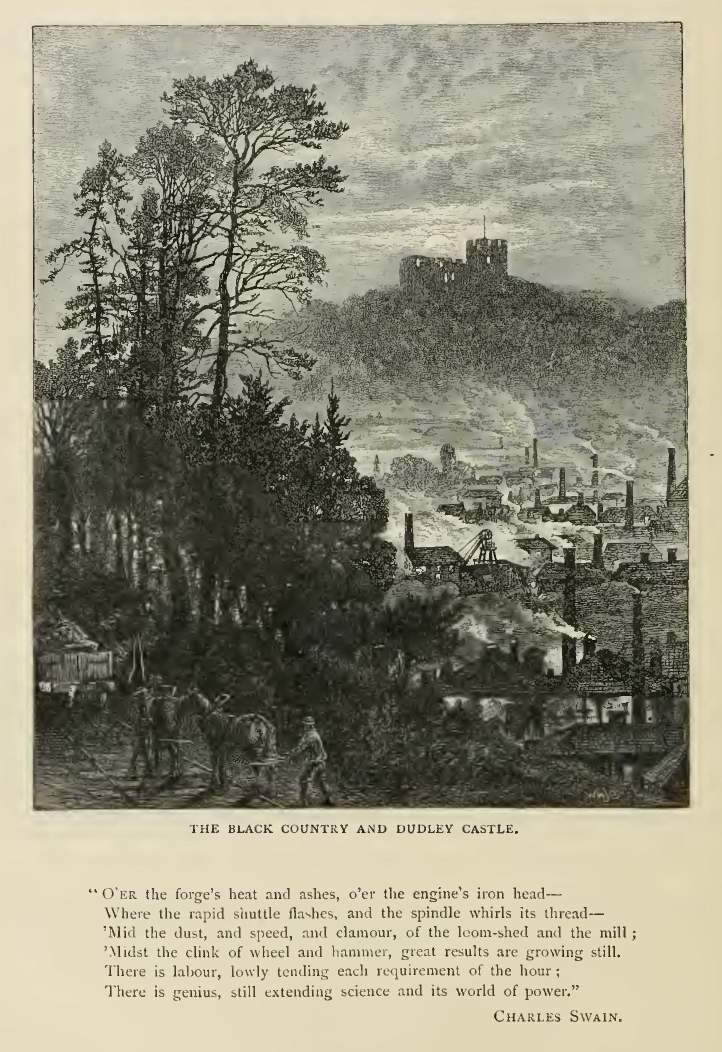
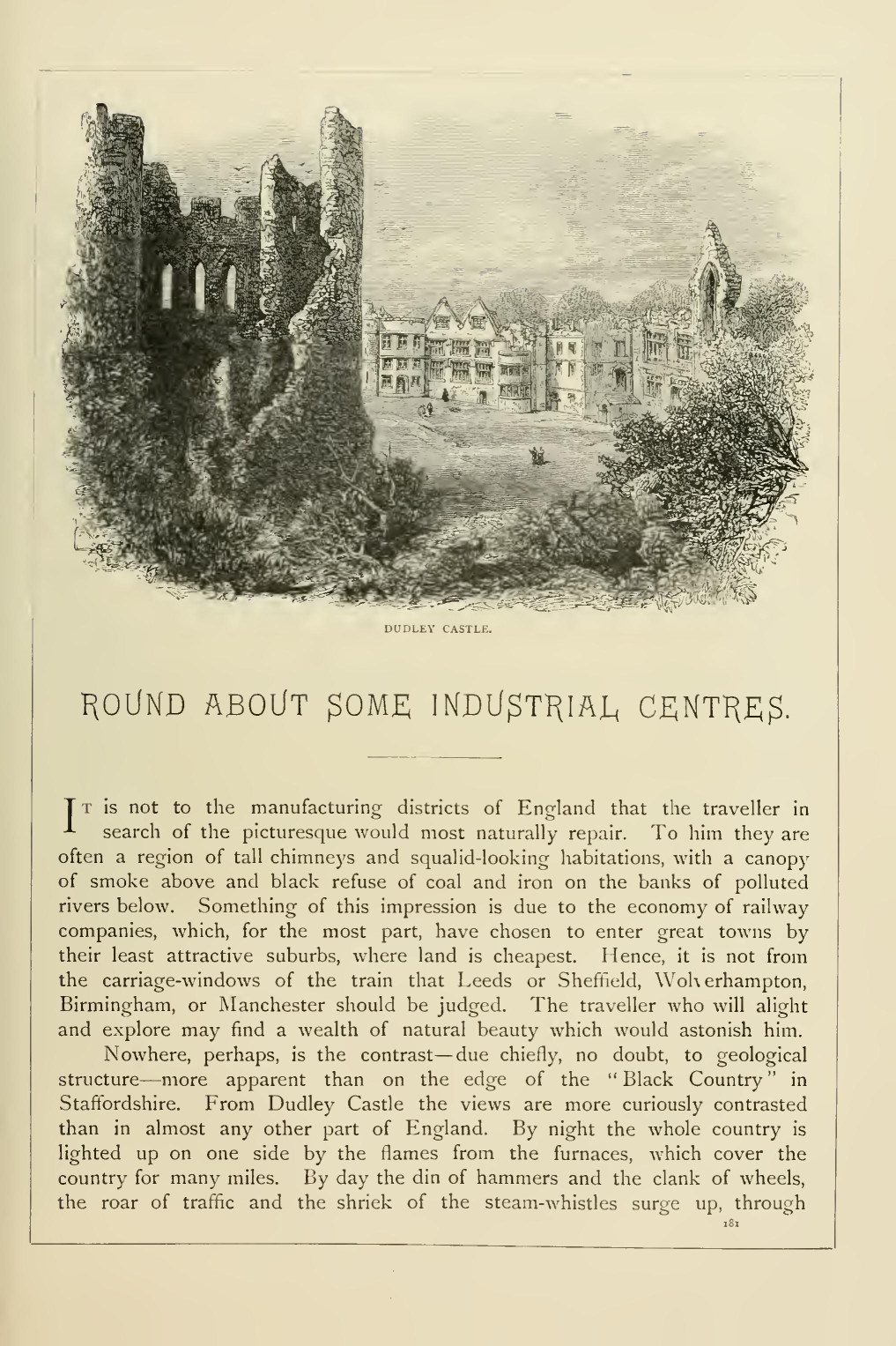
IT is not to the manufacturing districts of England that the traveller in search of the picturesque would most naturally repair. To him they are often a region of tall chimneys and squalid-looking habitations, with a canopy of smoke above and black refuse of coal and iron on the banks of polluted rivers below. Something of this impression is due to the economy of railway companies, which, for the most part, have chosen to enter great towns by their least attractive suburbs, where land is cheapest. Hence, it is not from the carriage-windows of the train that Leeds or Sheffield, Wolverhampton, Birmingham, or Manchester should be judged. The traveller who will alight and explore may find a wealth of natural beauty which would astonish him.
Nowhere, perhaps, is the contrast—due chiefly, no doubt, to geological structure—more apparent than on the edge of the "Black Country" in Staffordshire. From Dudley Castle the views are more curiously contrasted than in almost any other part of England. By night the whole country is lighted up on one side by the flames from the furnaces, which cover the country for many miles. By day the din of hammers and the clank of wheels, the roar of traffic and the shriek of the steam-whistles surge up, through the pall of smoke, upon the ear. Descend, and between the ironworks and coalpits the ground is unsightly with refuse heaps, while its frequent inequalities, and the bending, tottering buildings, show it to be honeycombed with mines. Vegetation is rare; what there is, is blackened and stunted; black also are the outsides of churches, chapels, schools. For inhabitants of such a district to gain any sense of natural beauty, they must be able at frequent intervals to escape; and, happily, to do this is within the reach of most. Railway communication with every part of England is constant and easy; and to know the difference that a few miles' journey will make in the scene, one has only to reascend to Dudley Castle, where it lies in the midst of its fair wooded domain.. Look from it to the north, east, or south, and all is smoke and flame; but turn to the west, and though the traces of unresting labour are still discernible, they soon give way to a country of richly diversified charm: glimpses are obtained of the beautiful valley of the Severn, the Wrekin towers grandly not many miles away, and the Malvern hills are dim and blue in the distance.
In other manufacturing centres, if the contrast is not so marked, yet there is a similar accessibility to many a sequestered and lovely scene. The nearness of the wildest and grandest Derbyshire scenery to busy, unromantic Manchester has been pointed out in a previous chapter; and the neighbourhood of the great Yorkshire centres of industry is full of picturesque beauty. A little way out of Leeds, for instance, where the Liverpool Canal passes over an embankment near to the river Aire, may be found the scene of one of Turner's most charming sketches; and though the locality bears evident marks of the great industrial invasion, much of the beauty still remains. In the same valley, not far off, are the stately ruins of Kirkstall Abbey, while the broad reach of river that encloses it, and the green meadows on the bank, with the low wooded heights on either side of the valley, suggest the memories of a day when the surroundings of the old ecclesiastical building were such as the monks most dearly loved; while Esholt Hall, some few miles higher up the river, at the extremity of a noble avenue of elm trees, was, in its time, a nunnery on low-lying ground, circled by an amphitheatre of hills, in a vale even now rich and beautiful, and which once must have seemed the very abode of tranquillity and peace.
It is, indeed, no small boon to the artizans of Leeds, Bradford, and many other crowded hives of industry in this part of England, that they are within so easy a distance of scenes which, in natural beauty, may vie with almost any in the land. Ivirkstall, as we have said, is close by the former town; and its grounds are thronged on every holiday by busy workers, who, whether intent or not on learning the appropriate lesson from the mouldering walls and tower, are at least fully alive to the advantages of fresh air, and of wide scope and range for healthful amusement. The like may be said of other places, lying only a little further off. There is Roundhay Park, for instance, one of the most splendid domains in England, now, through the wise liberality of the Leeds Corporation, the property of the people; while the public parks of many other towns, as Bradford, Halifax, Barnsley, with Manchester, Liverpool, Blackburn, gratify not only the instinct for recreation, but the desire for beauty.
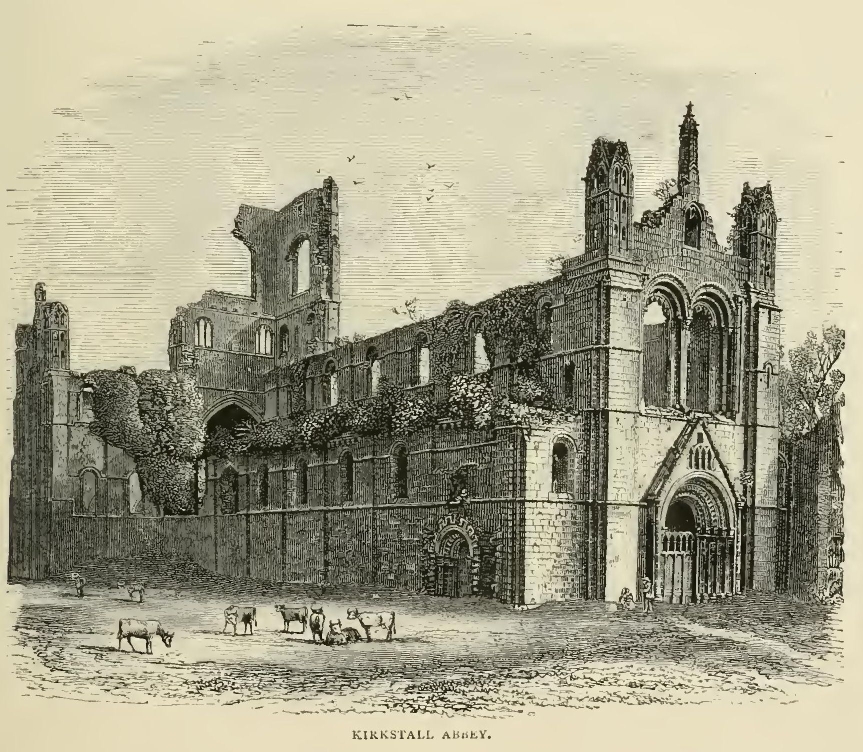
Or again, our traveller, in his pause at Leeds, may take the opportunity of visiting Ilkley, with its fine open moorland, where the brain-wearied worker may range at will. Then, a little way beyond Ilkley, lie the fair woods and noble heights encircling Bolton Abbey, where the Wharfe comes down, as yet unpolluted, from the moorland beyond; while the form of the White Doe of Rylstone, or the memory of the ill-fated heir of Egremont, seems yet to haunt the scene.
A little further again, our astonished friend comes upon a Clapham Junction, but it is amid the silence of the hills! Ingleborough, with its marvellous caves, too little known, with its companion heights, Pen-y-gant and Whernside, rise from the valley: and every path is full of beauty, especially that which leads into the heart of Craven, where bold limestone scars, deep glens, and upland moors, with one deep, lonely tarn, dear alike to dreamers and to anglers, yield a succession of pictures, of which, among their many charms, not the least is their easy accessibility from the neighbourhood of clanking mills and inky streams. For Ilkley, Bolton, Harrogate, Craven, Clapham may all be reached by the busy worker of Leeds or Bradford, and much of their beauty enjoyed, in the leisure of a summer Saturday afternoon, or on a "Bank holiday." He who would be free from excursionists, with their loud talk, their demonstrative ways, their baskets and their bottles, must go another time; but even in those holiday-hours there is much to interest. The "trippers" may be an interruption to the dreamer, an annoyance to the sensitive; but it is good that people whose lives are usually so hard-pressed and monotonous should have the means of ennobling enjoyment within easy reach; and though occasionally there may be an element of roughness or even intemperance in the recreation, we should be unjust were we not to record our impression, from what we have often seen, that there is a decided improvement in these respects, and that the free access to hill and moor, to fine scenery and pure air, has its part in checking those vices which spring up like evil weeds in the unwholesome dwellings of a crowded population.
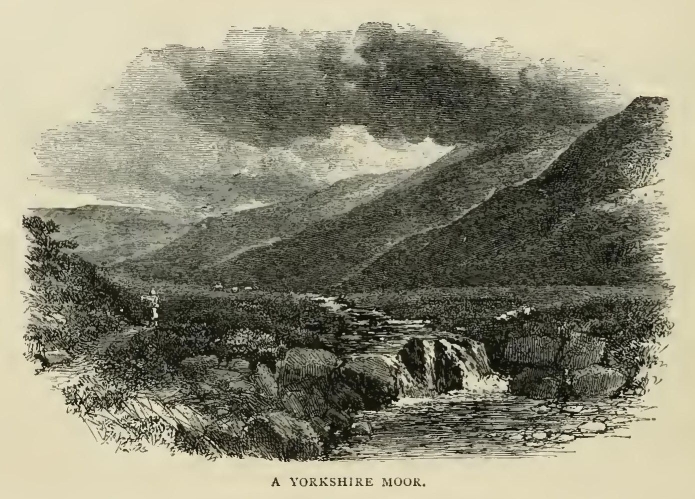
The "Excursion Season," no doubt, has its drawbacks in Lancashire, Yorkshire, London, and everywhere else. There are holidays that depress rather than invigorate: the spirit of self-indulgence may adopt the pretext of needed recreation, and the Lord's day is too often heedlessly or wilfully disregarded; but on the whole it is good that God's fair world should be thrown open to all who can enjoy its beauties; and that, as we have seen, some of its richest beauties should lie at the very threshold of the hardest workers in the most unromantic scenes.
The topic is almost inexhaustible; and the selection of places to be visited in reasonable time, from these "centres of industry," would be invidious to make. A little way beyond Leeds, as every one knows, lies Harrogate, the high table-land where medicinal waters have for long generations given to the place the fame of a true "city of Hygeia," while we ourselves would still give the chief credit to the invigorating, stimulating air, and to the almost inexhaustible interest of the neighbourhood, occupying the mind of the visitor with a round of healthful delights. The visit to Studley Park and Fountains Abbey will probably rank among the chief of these. Again, as in the cases of Kirkstall and Bolton, reverting to the past, we admire the taste and wisdom shown by the cowled brotherhoods in medićval times, in their choice of dwelling-places. Something, indeed, of the beauty which we now see may have been the result of their assiduous culture. It was part of their work to "make the wilderness to smile;" but they had a rare faculty for lighting upon scenes which, if not already beautiful, possessed an evident capability for becoming so. At Fountains both nature and art seem to vie with each other; and in the modern arrangement of the domain, the art may occasionally be the more apparent. The artistic yields to the artificial; the ruins have been maintained at the due stage of picturesqueness by careful oversight and repair; and the carefully prepared "surprise," which awaits the visitor at one stage of his progress through the grounds, is too theatrical to permit even one of the fairest of pictures to have its full effect. But, perhaps, all this is hypercritical, and, with every deduction, this old Cistercian abbey is one of the most beautiful, as it is one of the most complete medićval monastic buildings in England. The tower, unlike that of its sister abbey at Kirkstall, is little impaired by the ravages of time, the plan of the edifice is easy to be traced; and the light pillars and lofty arches of the Ladye Chapel give to the whole a finishing touch of stateliness and grace. Then how pleasant to wander through the noble avenues of Studley, to gaze upwards to the gigantic spruce firs, or to climb the mound where linger the decaying forms of the rugged yew trees—remnants, it is said, of the "seven sisters" that spread their shade over the founders of the abbey, more than six hundred years ago!
Still pursuing our way northwards, we reach the country of the Yorkshire Dales, where the Swale, passing by Richmond, the Tees, on the edge of Durham, and many smaller streams, descend from the eastern slope of the Westmoreland moors. Both abound in wild and charming scenery: the upper Tees-dale especially is singularly impressive. The river runs in its deep rocky bed through alpine-looking green meadows, with clean whitewashed cottages scattered here and there. Trees there are few or none, except a small kind of fir; and in place of hedges, low stone walls mark the boundaries of the fields. About five or six miles below its source, there forms the striking waterfall "High Force," tumbling over a black basaltic precipice, fifty feet high; while yet higher up the stream, where it issues from a gloomy tarn on the edge of the Westmoreland moors, descending for some two hundred feet over a steep, irregular staircase, so to speak, of basalt, the weird wildness of the scene, in the midst of its hilly amphitheatre, approaches sublimity. Caldron Snout is the quaint name of this unique rapid, and the curious in geology, as well as the lover of the picturesque, will be well repaid by a visit.
But by this time we have wandered some distance from our manufacturing centres. If, however, we have left the Yorkshire district behind, we are approaching the yet more black and busy coal districts.
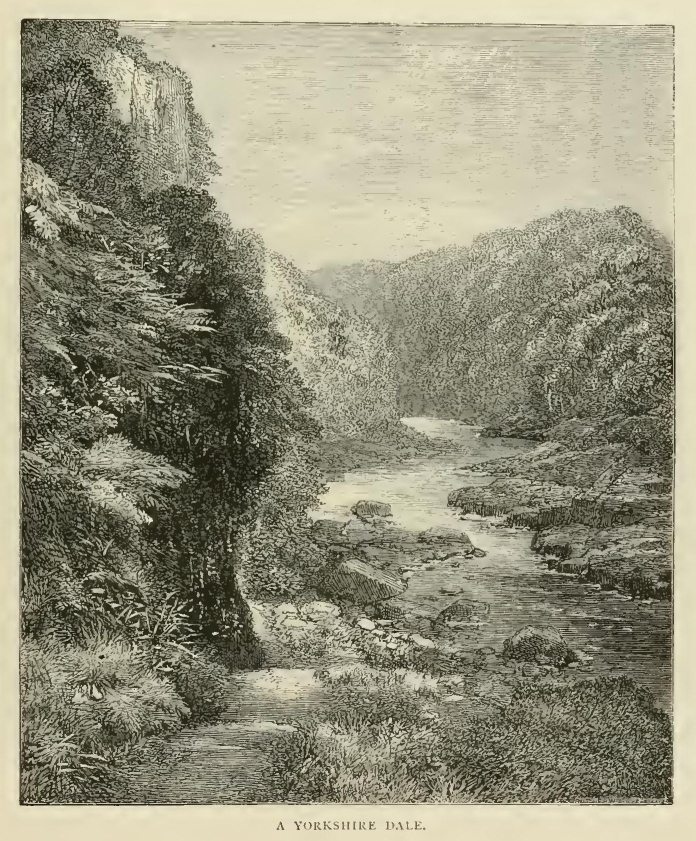
Teesdale itself has two sets of associations, and the same stream, whose rocks and dales are so romantic in its earlier course, becomes, by the time it reaches Stockton, a broad and inky flood, and so passes by Middlesborough—that wonderfully progressive seat of the iron manufacture—to the sea. We now pass on from town to town along the coast, each busier, blacker than the last, but with glimpses of rich beauty between, while the city of Durham, as seen from the rail, is one of the noblest views of rock and river, cathedral, castle, and town, on which the traveller's eye has ever rested. This river is the Weir; then the Tyne is reached, and Newcastle, the "capital of the north," is entered over its splendid High-Level Bridge.
We can imagine no better route for a pedestrian excursion than the way from Denton Hall to Thirlwall Castle—about thirty-four miles; or, if the tourist wishes to see the whole, let him put Dr. Bruce's Condensed Guide and an Ordnance map into his knapsack, devote a week to the exploration, and proceed by leisurely stages from Wallsend, on the Tyne, to Bowness, on the Solway, a distance of seventy-three miles and a half.
But our chief object in visiting these great centres of industry is to explore their neighbourhoods. Few towns in England are better worth a prolonged visit than Newcastle-upon-Tyne; but its attraction to us now is, that we can, at so short a distance from its busy streets, place ourselves amid rural scenes of surpassing interest, as well on their own account as for their historical associations.
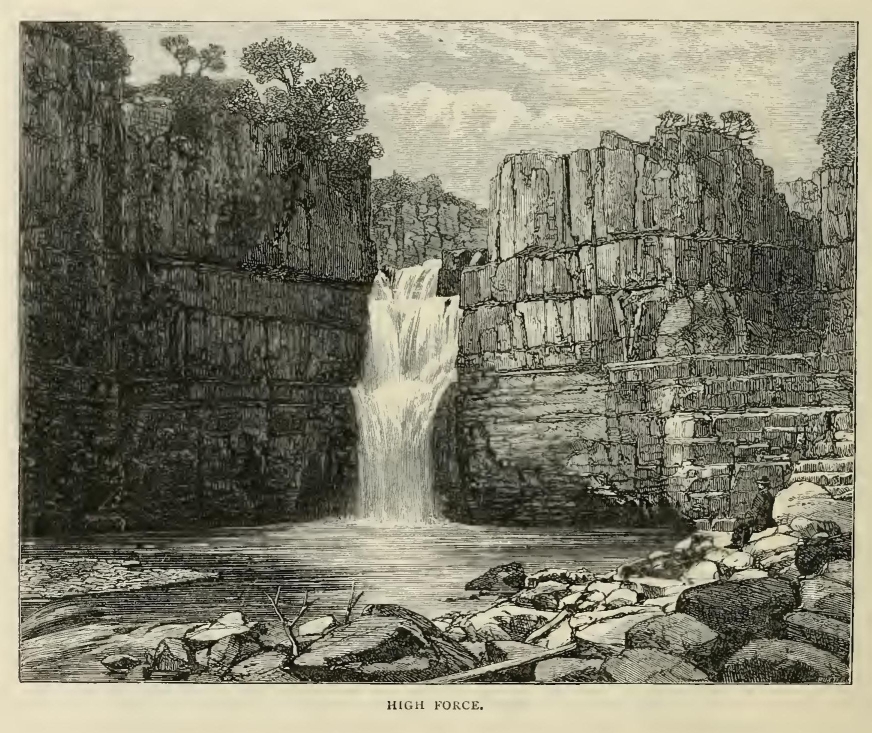
First and foremost, of course, there is the Roman Wall, with its long line of remains, still magnificent, and so varied from place to place, while the scenery that surrounds them is so striking, that sea to sea classic ground.

A stranger might suppose that, after the lapse of long centuries, all these works, granting their existence once, must have disappeared. It is not so: save in the western portion, there is scarcely an acre without distinct traces; in many places all the lines sweep on together, parts in wondrous preservation; while many of the recent excavations present structures several feet high, giving one the idea of works in progress, so fresh that we are tempted to think of the builders as away but for an hour, perhaps to the noonday meal. To traverse the line of the wall is to pass along one continuous platform, whence the visitor revels in a succession of glorious panoramas.
Returning to the busy east coast, very charming is the transition from the Tyne to the Coquet, loveliest of Northumbrian streams, as it flows down, interesting glimpses into the past opened up at every stage. Few persons, indeed, who have not visited the scene, have any notion of the variety and value of the remains which have withstood the wear and tear of sixteen centuries, during a great part of which period the wall was used as a quarry by the dwellers in the district.
In many places the traveller, especially if aided by some competent guide, may discern the whole outline of the structure. It consisted of seven parts, viz., the Roman Wall proper, comprising ditch on the extreme northern side; (1) the military road; then the earthwork, consisting of (2) a wall; then (3) a space more or less wide from thirty feet to half-a-mile, middle of vallum, along of (4) a mound, or rampart, the largest of three; (5) a second ditch; (6) another mound, the smallest; and (7) yet another mound. The following section exhibits all in one view. Nor is this all, at every three or four miles we have fortified camps of several acres each, at every mile a castle, and between the castles watch-towers. Moreover, there are roads and bridges, traces of villas, gardens, and burial-places, making almost every inch from Thirlmoor, on the verge of the Cheviots, at the foot of heathery hills and through richly wooded vales, to Rothbury—already a famous place of resort from the district, and evidently destined to become more frequented from its surpassing beauty of situation, encircled by romantic hills, with the bright river running swiftly between.
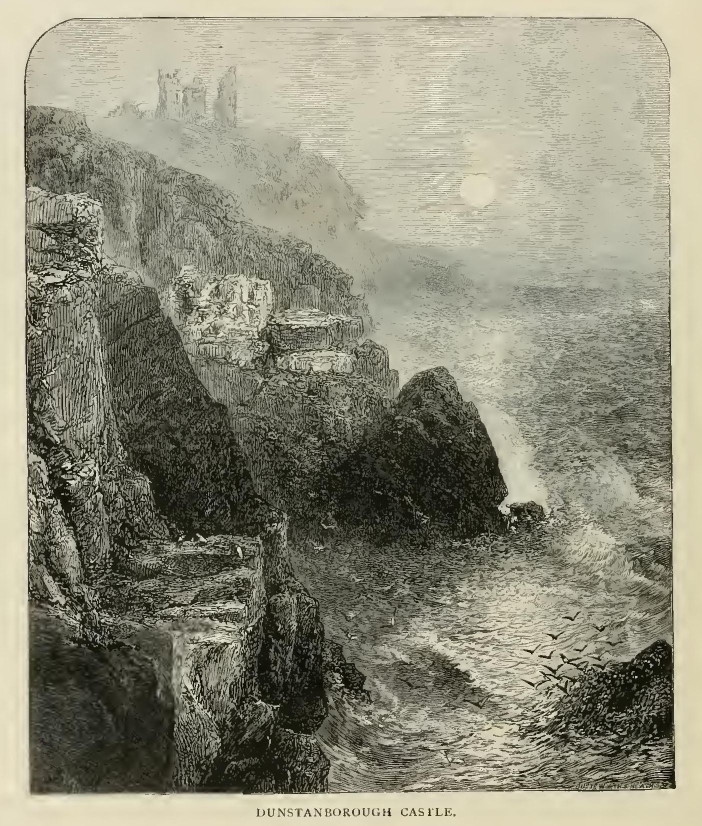
Thence the Coquet descends in many a winding by scenes of the richest sylvan loveliness to Warkworth, renowned for its hermitage, which is still, as the old Percy ballad describes it, "deep hewn within a craggy cliff, and overhung with wood." And so we reach the sea, where Coquet Island, with its lighthouse, lies amid the gleaming waters, scarcely suggesting, as we gaze upon it in the fair sunshine, how terribly the storm sometimes there rages, or how those dark rocks are chafed by the angry billows!
But for the full splendour of cliff and ocean scenery we journey still a little northward, and come to Dunstanborough Castle. Here a dark ridge of basalt rises in pillared form sheer from the sea, and in the words of Alarmion, "the whitening breakers," surging with ceaseless thunder into the caves which pierce the cliffs, "sound near,"
"As boiling through the rocks they roar
On Dunstanborough's caverned shore."
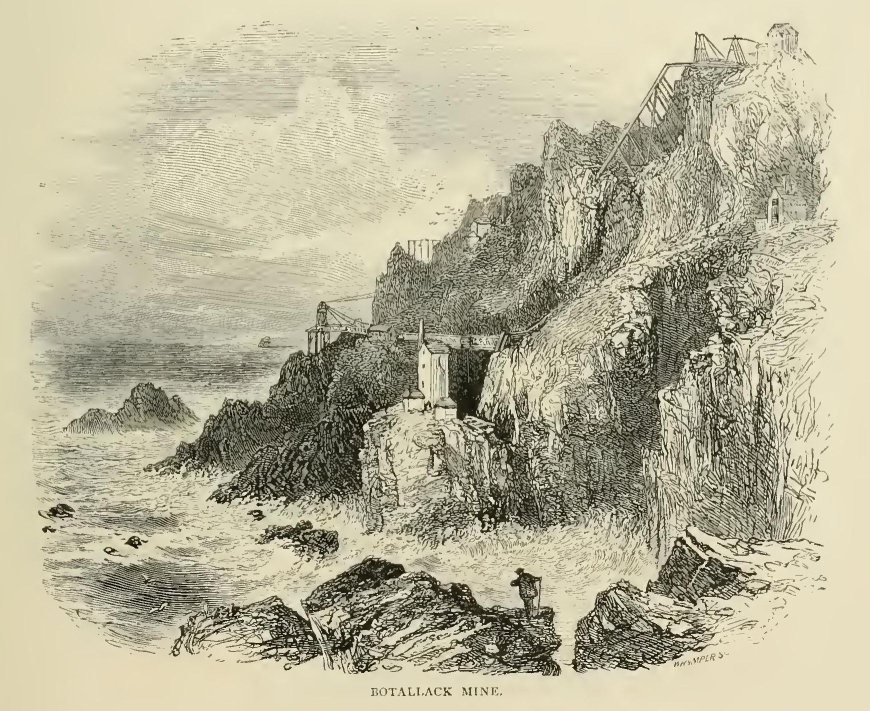
The view from the "Lilburn's Tower" in this ruined castle, commanding landwards the broad purple moors, extending in many an undulation to the rounded Cheviots, glimmering blue in the distance, and looking seawards over the restless ocean, beating ever at the foot of the black columns, while sea-birds are ceaselessly wheeling in mid air with shrill outcries, not unfairly vies with the wild magnificence of Tintagel, as described in our earlier pages.
The two coast scenes are, perhaps, unequalled in the British Islands: the difference is that, while the Cornish scene lies in far-away seclusion, this of Northumberland is close by one of the chief lines of traffic, and within accessible distance of crowded populations. Yet even Cornwall is a great industrial centre. Its mining industries are never far away from us. Its wildest cliffs are pierced by shafts and adits leading down, as in the Botallack Mine, to labyrinthine passages far under the bed of the sea, where the miners can hear overhead the rush of the waves and the grinding together of the huge boulders.
We have now reached the limit of our purpose, which was to show how near to the doors of the million is some of the most striking scenery of our land. Else from Dunstanborough Castle we could have pursued our way northwards at least as far as Bamborough Castle, not so much for the sake of admiring its noble ramparts and towers—once a fortress, now a temple of charity—or of gazing again upon the glories of cliff and sea, as of looking out across the waters to those rocky isles which, in our own time, have witnessed one of those deeds of unconscious heroism which do honour to our nature. For it was from one of those sea-beaten crags that, on the 5th of September, 1838, Grace Darling set forth upon her errand of mercy amid the raging waters, to rescue the survivors of the shipwrecked Forfarshire. "Her musical name," it has been said, "is the burden of a beautiful story of that love of man which is the love of Christ translated into human language and deeds." Four years after that great exploit the brave and gentle maiden died of consumption, brought on, it is said, by a visit to her brother, keeper of the lighthouse on Coquet Island: but she has left among our island race an imperishable name. Let us conclude these random rovings by a visit to her monument in Bamborough churchyard. Her figure lies as it were in slumber, an oar upon her shoulder, beneath a Gothic canopy, within sight and hearing of the waves. On the bright day of our visit the waves were murmuring and sparkling far below: the craggy islets in the distance were touched with sunlight, and we turned away, reminded less of the heroism that braved the storm, than of the heavenly home and the everlasting rest. "I saw a new heaven and a new earth, for the first heaven and the first earth were passed away; and there was no more sea."
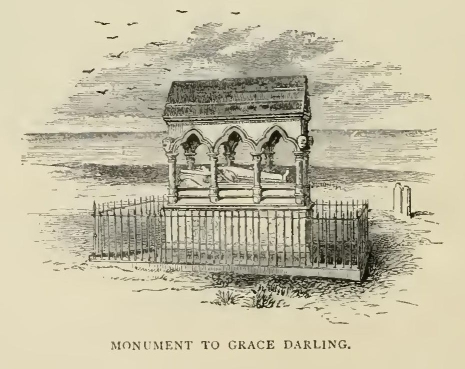
Some of the holiday excursions which live most pleasantly in memory, are those short "runs" of three or four days, to the mountain or the sea, which, it may be, some unexpected holiday has enabled us to take, or some "happy thought" has suggested as likely to be beneficial to mind and body. The amount of enjoyment that can be compressed into so brief a space of time is quite wonderful, provided only the place of visit be wisely chosen, the days long, and the weather suitable.
In one such little tour, so full of interest that it is hard to believe it to have extended only from Tuesday morning to Friday afternoon, we, some years ago, made our first acquaintance with Snowdon. Starting from Caernarvon before breakfast, we walked to Llanberis, by a road leading gradually upwards beside a wild mountain torrent, till the lake from which it issues was reached, and the impression of the mountain grandeur first fully felt.
The ascent of Snowdon has been so often described, that we need only say it was unexpectedly easy. The beauty of the path with which it began, up the bank of a mountain torrent ending in a strange and lovely waterfall, beguiled the first portion of the way, and the latter part opened up continually such glorious views, that the fatigue was lightened, if the progress was a little impeded, by long pauses of admiration. At length we reached Moel-y-Wyddfa, "the far-seen summit," and were upon the highest spot in England and Wales.
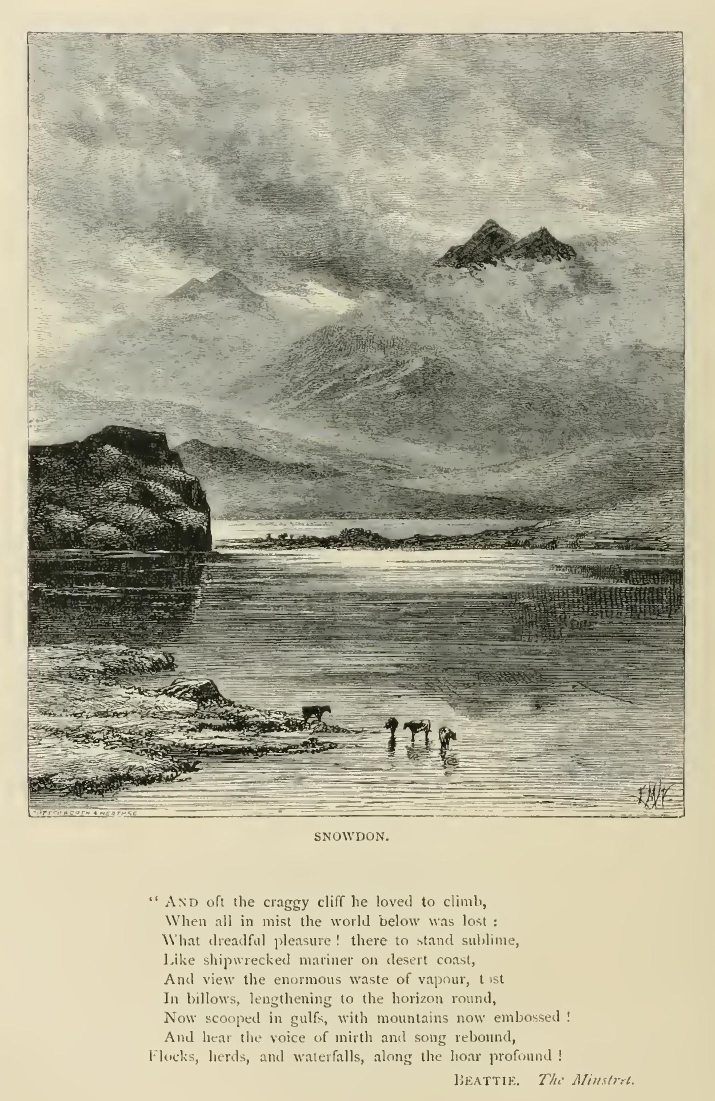
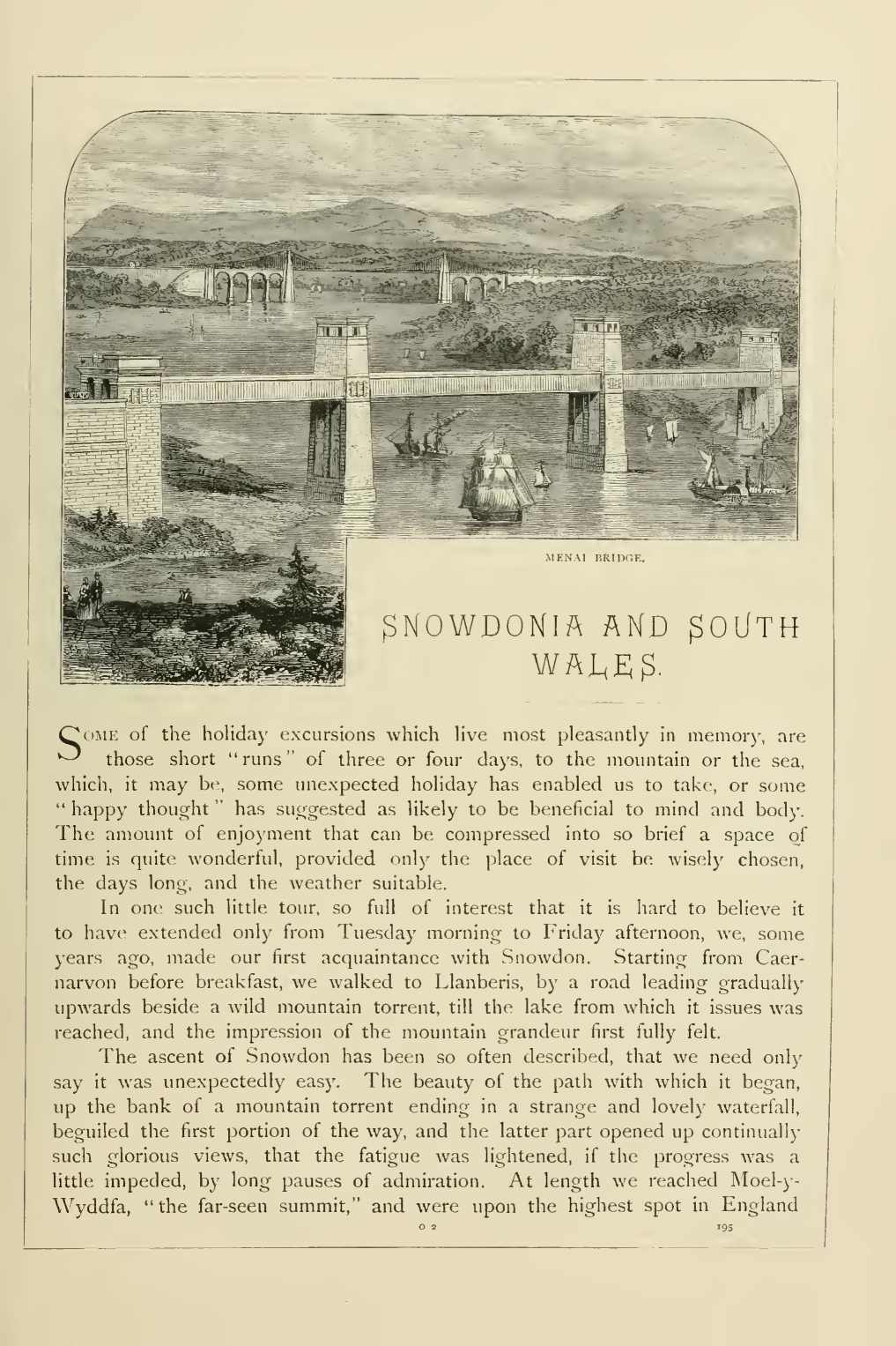
Of the near prospect the chief wonder, to us, was the number of lakes, or llyns, visible. For this we were unprepared, and the endlessly diversified outline of these gleaming pools contrasted strikingly with the dark mountain masses amid which they lay. The distant views were at first very clear—Skiddaw (so said our guide) in the north, the Isle of Man in the west, appearing like a shadow on a sunlit sea, Cader Idris and Plinlimmon in the south, with the valleys lying green among the hills, and here and there the line of some sparkling stream, while the habitations of man were dwarfed to insignificance, or indicated only by dim patches, as of smoke hanging in the air. Suddenly a chilling breeze passed across the mountain top, and we were glad to find shelter in one of the little huts which crown—we will not say adorn—the peak. As the mists now began to gather, it was judged time to descend. The path, little more than eight feet wide, lay along one of the narrowest spurs of the mountain, while on both sides are tremendous precipices. To walk over this path in clear, calm weather would be a trial to the nerves; but now the mists were seething and whirling below, ever and anon rapidly parting, so as to disclose glimpses of bare rocks apparently rising out of an ocean of cloud, or miniature meadows of sunny green at unknown depths, or, strangest of all, leaden-coloured lakelets, each enclosed by its bank of fog. It was a weird scene, and though the path itself was tolerably free from mist, the sight of these abysses on either hand, suggesting the consequences of a slip, kept us all very quiet, very wary in our steps; and we were thankful when we reached the point where the mountain spur expands into a broad, safe, though steep and rugged, hill. Here we descended swiftly, and soon found ourselves upon the turnpike road to Beddgelert, our destination.
This level dell, set in the midst of mountains, which rise on all sides, clothed at their base with rich woods, and then towering upwards, bare and rugged against the sky, surpassed all our expectations by the magnificence of its environment. The faithful hound, so well known in the stories of many lands, has here a tomb, in the very midst of the valley, overhung by a group of willows. Perhaps the legend is but a myth; it exists, we are told, in Persian, and in the dialects of India. The story as it stands is not only affecting, but contains a noble lesson; and it was in no sceptical spirit that we read Southey's fine ballad over again, at the traditionary scene of the incident. We ended the day by a stroll up to Pont Aberglaslyn, that most romantic of defiles, the only defect of which is, that it is too short. The road leads on one side by the "blue torrent," which dashes through the pass with headlong, tremendous force; on the other by towering mountain sides, clothed with lichen and a scanty covering of mosses and shrubs. A marked feature in these rocks is the evident trace of glacier action, to which Dr. Buckland has called attention by a memorandum in his own handwriting, framed and glazed, in the hotel. The bridge at the extremity of the pass, carrying the old road to Tan-y-bwlch, has been thus described by Miss Costello: "There, forty feet above the river, hangs in air apparently, just touching the two mountains, a one-arched bridge, clothed with a robe of ivy, whose festoons wave to and fro, as if the action of her leap had disturbed the drapery of some nymph, whose form had hardened into stone as she performed the wondrous feat. Below, beyond, around, the waters rave and foam and rush, and here for the first time I recognised the beautiful colour, familiar to my eye in the Pyrenees, which has given the name of the 'Blue Pool' to this lovely spot." The scene was one in which to rest and muse after the exertions and excitements of the morning; the only disturbance of the quiet being the pertinacity of the little sellers of spar and rock fragments, or these failing, of woollen socks, with equal readiness to sing us a song, if no purchasers could be found for their other wares! It must in fairness be added that the song was "sweet and low," and harmonised well with the now gathering twilight, and the sound of rushing waters.
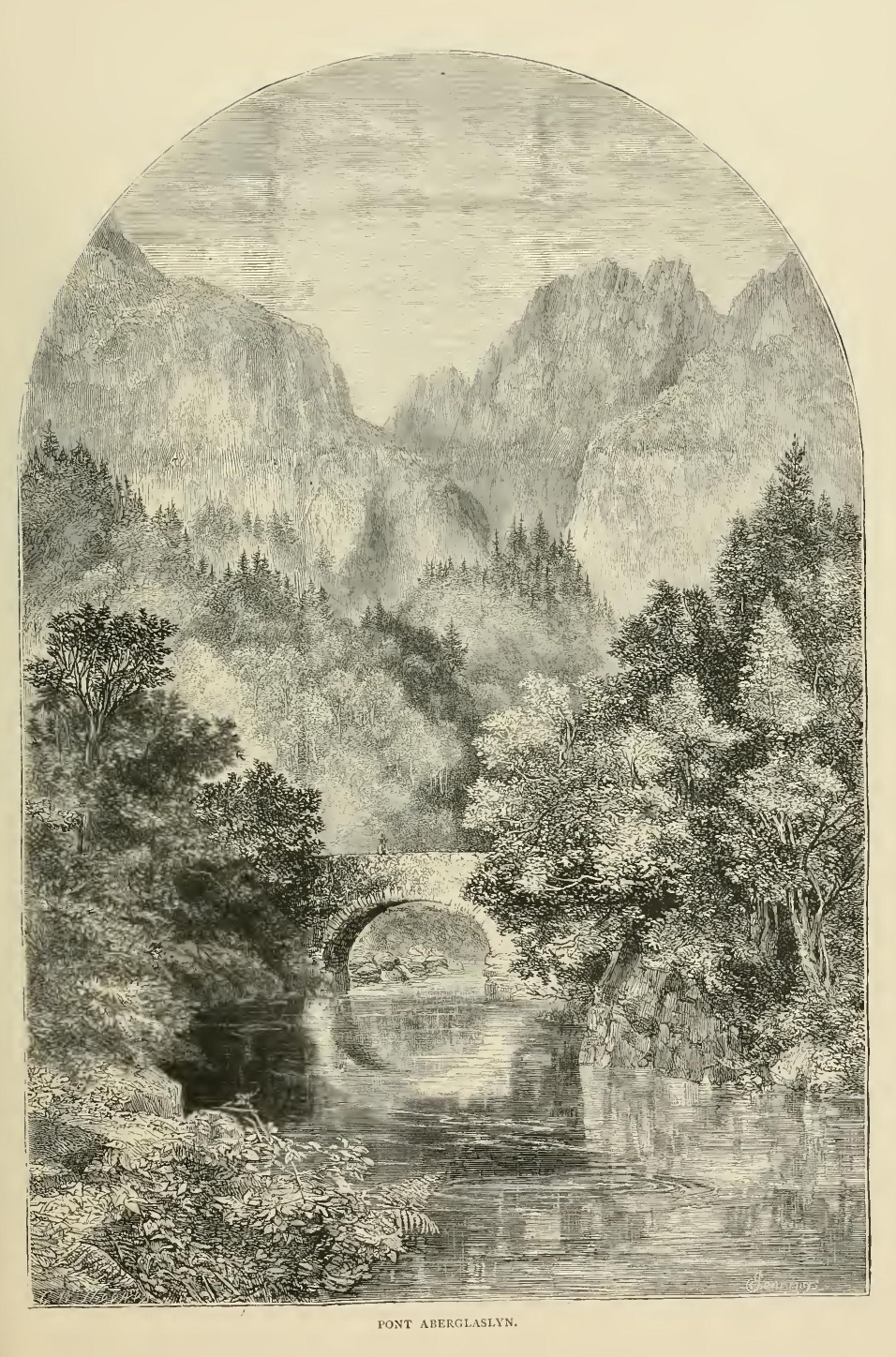
The next day's expedition must be more briefly narrated. Somewhat tired by the mountain climbing, we were content with a quiet walk up Nant Gwynant, descending by the eastern half of the Pass of Llanberis to Cape! Curig, and thence, beside the river Lugwy, to Bettws-y-Coed. Two lakes, passed soon after leaving Beddgelert, are of the most exquisite beauty, and the views of Snowdon, opened up a little beyond them, are of splendour unsurpassed.
Reaching Pen-y-gwryd a little below the head of the Llanberis Pass, we pursued a route of a totally different character to Capel Curig. For the luxuriant beauty of Nant Gwynant we had now the sublimity of bare rock and crag; but there was something, we must suppose, uncongenial with our mood in the bleakness of the scene; at any rate, this part of the pass disappointed us. We have since found that the true grandeur of the defile is in the other, or western part, between Pen-y-gwryd and Llanberis. The rest at Capel Curig was specially welcome, and thence there was no want of interest in the route, on the bank of the romantic Lugwy. The Swallow waterfall must by all means be visited, repelled as is the true lover of nature by all those little arrangements that make the place a show—the urchin who points out the locked gate, for fear it should be missed, the keen-eyed dame with the keys, the guide to the torrent s brink, apparently solicitous lest any visitor should discover for himself the chief points of view, the miscellaneous guard of children, with a general expectancy of coppers.
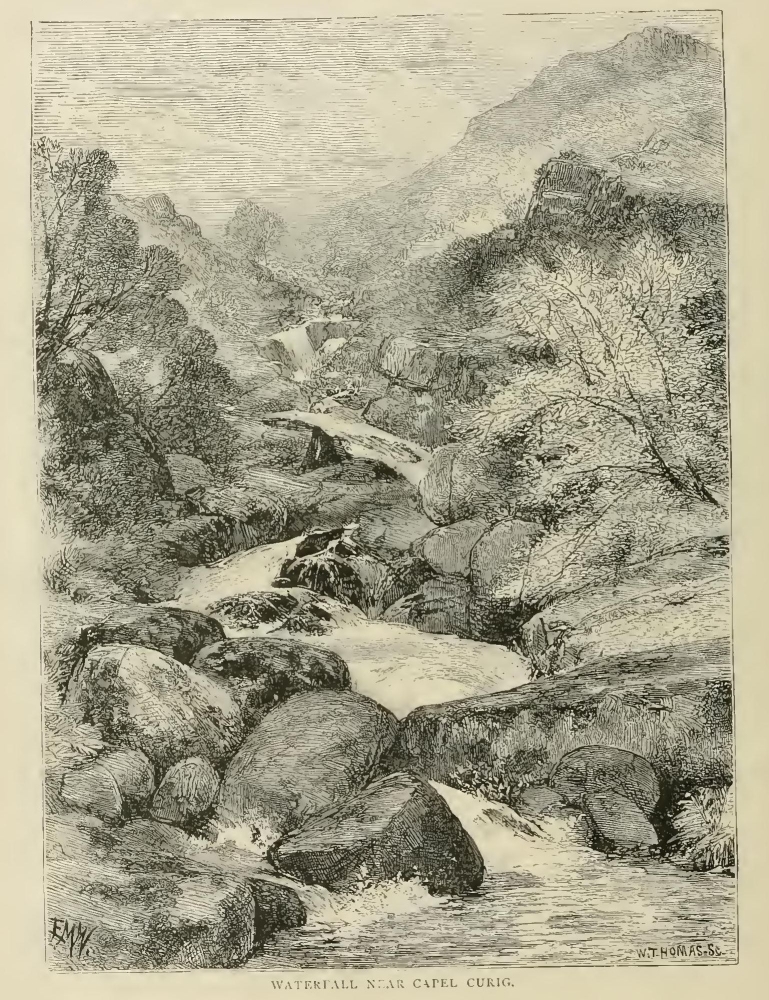
All this we did not like; and yet nothing could well be finer than the plunge of the river, with roar and foam, over the vast mass of rocks, slanting in rugged, picturesque confusion from the summit to the foot of the fall, and breaking the stream in its descent into numberless cascades and tiny rapids. The picture is one of marvellous diversity, and when the river is swollen by rain the rush and roar are tremendous.
Our day's journey was nearly over, and another hours walk, or a little mure, brought us to that "paradise of painters," the Royal Oak at Bettws y-Coed. Happily there was room for us, though the inn seemed crowded by artists—many of them men of world-wide reputation—who come again and again to this fair valley, always to find something new in form or colour, light or shade. The next day was spent in rambling about the neighbourhood; and almost everywhere we found artists at work with easel and umbrella. Pont-y-pair was to us as an old friend, so often had we seen its semblance in exhibition-rooms and books of "landscape scenery." Few subjects, indeed, could be more adapted to the painter.
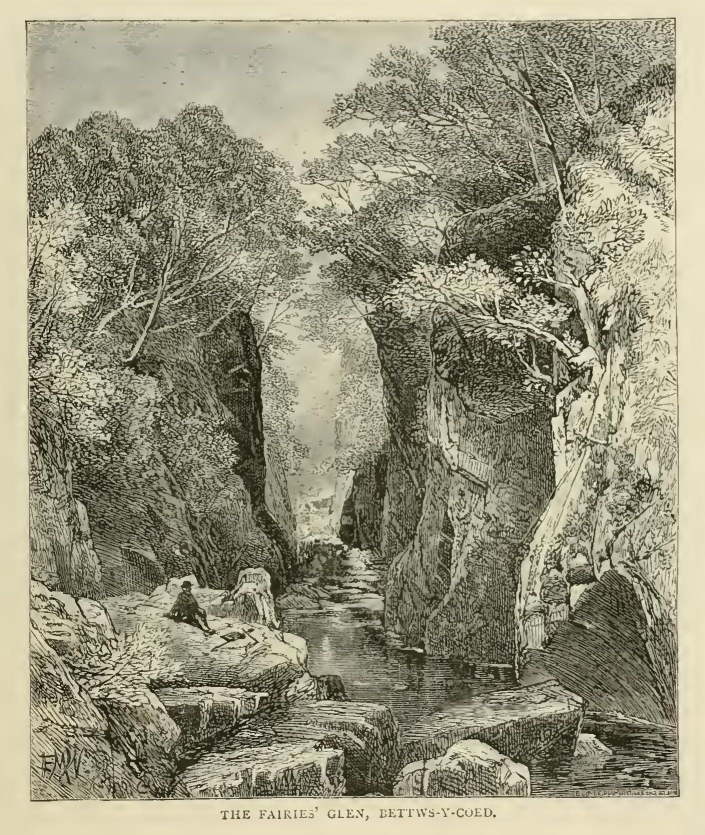
But if this bridge, with its many lovely points of view, struck us with a sense of familiarity, we were startled, as well as delighted, by the exceeding beauty of the Fairies' Glen. A tributary stream here comes down to the Lugwy between high wooded banks, and over mossy rocks, which at many points can easily be crossed; the course of the rapid crystal stream for a long distance is almost straight, and the perspective from below is singularly fine.
The holiday, rich as it had been in delights, was now almost over, and the last day was mainly spent in a water excursion, which a railway, since constructed, has rendered less familiar, but which even yet we venture to commend. The pretty little town of Llanrwst being passed, we pursued a pleasant road between the river Conway on one side and bosky cliffs on the other, as far as Trefriw, where a small steamer was waiting the turn of the tide to proceed down the river to Conway town. The sail on a fine day is one of the most charming of excursions, the scenery on both sides being of much interest, and the quiet rest on board the steamer being very agreeable after three days' walking and climbing.
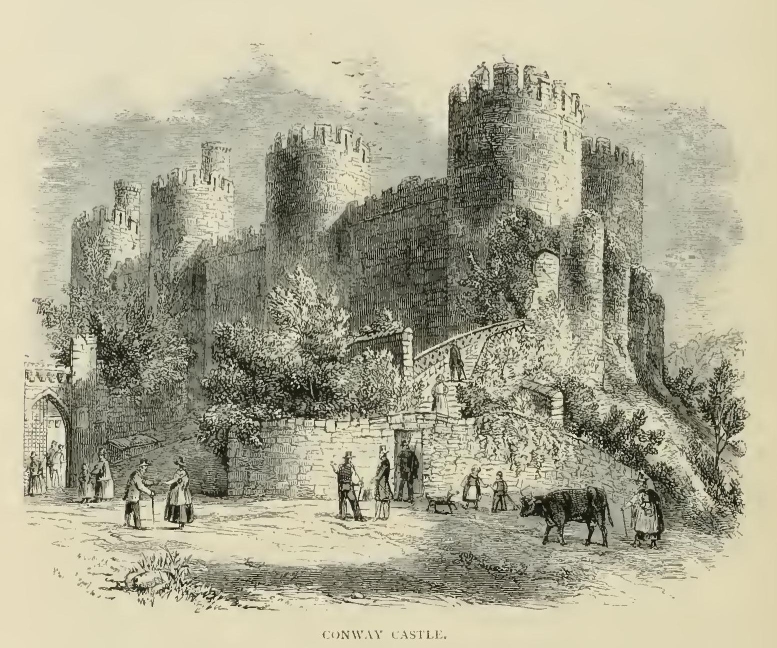
From Trefriw, we were told, a very short excursion, up to Llyn Geirionydd, would have brought us to one of the very finest points of view in all North Wales, the range of Snowdon, and the scarcely less imposing Moel Siabod, being thence seen in all their majesty. But it is always at once a regret and an alleviation, in leaving beautiful scenes, that much is left unvisited—regret that so many fair scenes have been missed, alleviation, because the very fact may form so good a reason some day for revisiting the place! As it was, with some time at our disposal after reaching Conway, we visited the splendid ruins of the castle, then went by rail to Llandudno, and after a hasty glance at the promenade by the bay, finished the memorable four days' visit to Wales by a bracing walk of six miles, round the Great Orme's Head on the path overlooking the sea.
The holiday had been so successful, that on the next similar opportunity it occurred to us to spend the few days at command in South Wales. We are bound, however, to confess that the charm was felt to be inferior.
Possibly we expected another Snowdonia, and so deserved to be disappointed. Nature does not repeat herself, and though the heights of Plinlimmon are commanding when attained, we do not recommend the traveller whose time is precious to traverse the intolerably circuitous path, amid bogs and morasses, which leads him wearily at last to the summit. The fresh breeze, and the wide prospect from the mountain's top are, to some extent, a compensation for the toil; while it is interesting to explore the sources of some of the many rivers which descend from the mighty store of waters embosomed in this hill—the Severn and the Wye being chief. But the longing for the beautiful was unsatisfied until we reached Pont-y-Mynach, the Monk's P>ridge; better known, perhaps, as "the Devil's Bridge." The former name denotes the fact that the monks of Strata Florida Abbey constructed the bridge: the latter, we suppose, expresses the simple wonder of the rustics, who could not conceive the daring work as wrought by any power less than supernatural. Why should they have taken for granted that the power was evil? We presume that the explanation is to be found in the sense of terror excited by the fury and the roar of the torrent. There is an awe akin to joy: a solemn yet glad uplifting of the soul, as at the sight of the starry heavens; and who could attribute the splendours of the firmament to any but a beneficent Creator? But amid the wilder scenes of this earth, there is not only the mere feeling of danger, but a dread which oppresses the spirit—a "fear that hath torment,"—an instinctive sense of sin, which has led men in such localities to imagine a malignant spirit at work.
A little way beyond the bridge are the falls of the Rheidol—a series of cascades, perhaps the most picturesque in Wales, not from the mass of water so much as from the magnificence of the narrow, rocky ravine, with its wealth of foliage. Perhaps the charms of this fair glen, with the comforts of the splendidly-placed hotel above, were heightened by the recollection of the long morning among the morasses of Plinlimmon; but our feeling as we sat at eventide watching the sunset, and listening to the roar of waters, was to surrender all the rest of our brief excursion, and to give ourselves there to the dolce far niente of three long summer days!
South Wales is so conveniently intersected with railways, that it is almost too easy for the tourist to pass from point to point. The preceding day, on a south-easterly slope of Plinlimmon, we had stood at the source of the Wye, and the desire possessed us to trace the progress of that river for awhile, to see if in its early meanderings it had the beauty which we knew so well to belong to it in its later and more familiar course. The excursion was not a disappointing one. It leads through some of the most primitive of Welsh districts: Builth, which in due time we reached, appeared quaint and attractive, and Talgarth, where our long walk was finished, might have tempted us, under other circumstances, to a longer stay, to explore the "Black Mountains," a wonderfully fine range of hills, girt with woods, pierced by lovely glens, and extending in ranges of lofty moorland for many miles.
A short railway journey now brought us to Brecon, so nobly placed in the midst of its mountain amphitheatre as to invite a longer stay: but we had to hurry on, anxious to reach the far-famed Vale of Neath. A very wild walk led upwards for many weary miles, as it seemed, from Brecon to Maen Llia, the "Llia Stone," near which is the source of the Llia, one of the streams whose confluence form the Neath. Descending rapidly, we soon came to the point where the Llia is joined from the north-east by the Dringarth, another confluent.
At Y-strad-fellte, a little further on, the glory of the mountain vale began to open out. We passed under the shadow of the crags to the east, as far as to the spot where, at a break in the rocky rampart, the Hepste, another tributary, hurries to meet the stream, forming a fine waterfall. At Crag-y-Dinas, a huge limestone rock, commanding from its summit both the upper glen and the lower valley as far as Swansea Bay, the beauty of the scene is at its height. Hardly any combination of scenery could be richer in its exquisite variety. The road now lay between these united streams and the Neath proper, which soon is joined from the western side by the Pyrrdin, up whose rocky glen we turned for the sake of its two charming cascades, the "Lady's" and the "Crooked" Fall.
In fact, the whole neighbourhood teems with cataracts, many of exceeding beauty, and a day might well be spent in exploring the rocky dingles, through which the hurrying streams descend, until at Pont-Nedd-fechan, "the Little Bridge of Neath," they meet and mingle in one.
The bridge is of one arch, thrown across the ravine near the point of confluence; it is festooned with drooping ivy, which almost reaches the surface of the stream, and in its secluded loveliness this little Welsh Lauterbrunnen, a village of many waters among the hills, may fairly compare with many scenes far better known to fame.
The route down the valley to the town of Neath and the port of Briton Ferry, is rich in varied beauty. The river runs between the high road and the railway, with, in some part of its course, a canal. The surrounding hills are lovely in outline and richly wooded; and until we reach the seats of industry near the port, the water, lying in long reaches, or hurrying over its rocky bed, is crystal-clear. At a former time Briton Ferry was lovely beyond almost any other seaside resort. The river, here expanded to a noble breadth, flowed between lofty wooded cliffs to an open bay. The surrounding hills were crowned with noble oaks, and the romantic little village, protected from the north and east, had all the attractions not only of its own exceeding beauty, but of a mild climate, and of air exceptionally pure. All this is changed!
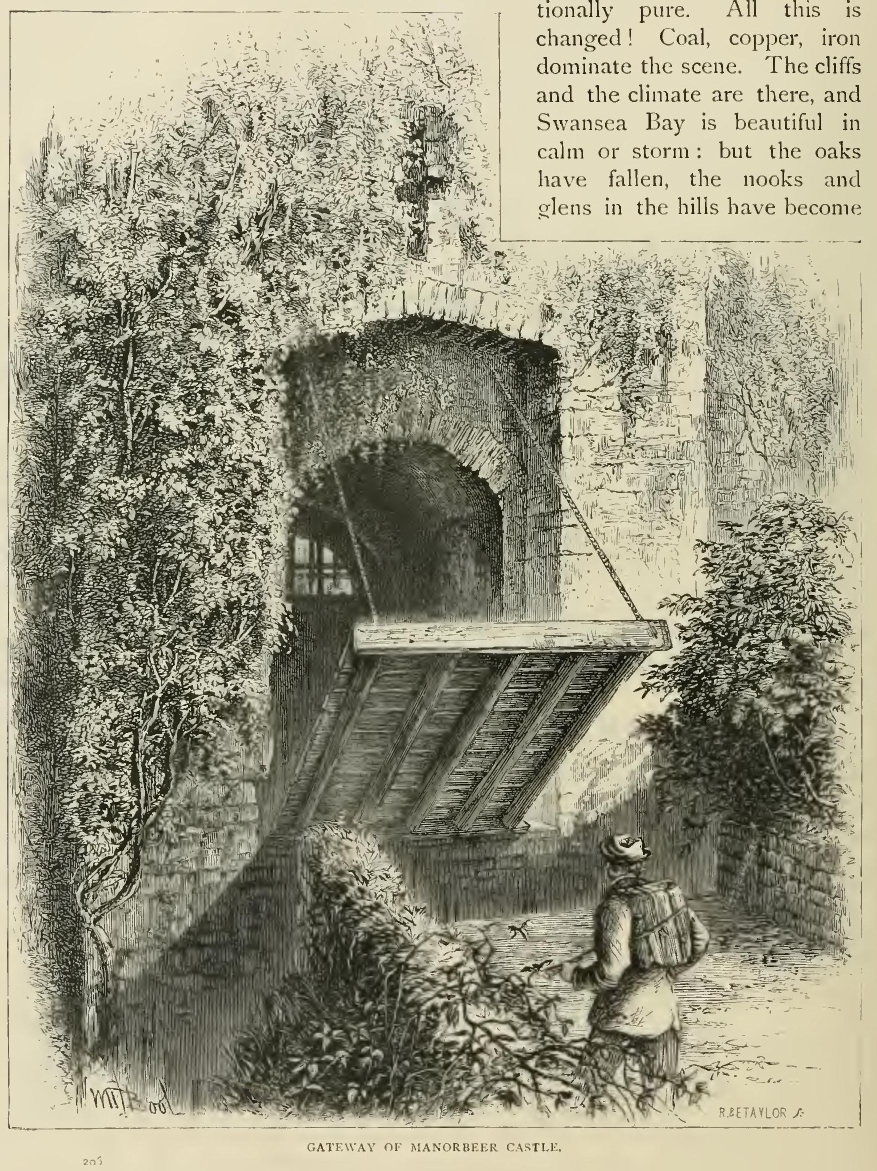
Coal, copper, iron dominate the scene. The cliffs and the climate are there, and Swansea Bay is beautiful in calm or storm: but the oaks have fallen, the nooks and elens in the hills have become squalid in their bareness, the streams are polluted, the air is murky; but the docks are admirable, and the place is "rising rapidly." There is a divineness in man's industry, as well as in nature's beauty.
"The old order yieldeth, giving place to new,
And God fulfils Himself in many ways."
We hurry away from the coalfields to where Carmarthen stands high on Towy bank, grandly overlooking the course of the river to the sea. Of the bay named from this ancient capital, the most beautiful part, perhaps, is where Tenby, from its rocky promontory, overlooks the sea. As we terminated our little tour in North Wales at Llandudno, so here at Tenby we bade farewell to the southern part of the Principality. But before leaving there was time for one little excursion along the coast, superb beyond all our expectation, especially for the first few miles, where the mountain limestone fronts the sea with bold, cave-pierced cliff. Our ramble terminated at Manor-beer Castle, one of the most extensive and complete of feudal fortresses in Great Britain. Perhaps there is no ruin of the kind in which the arrangements for residence as well as for defence can be so clearly traced, and certainly there are few which more nobly command the shore below.
But our brief excursion was over. Some of the most picturesque parts of South Wales were, perforce, left unvisited—especially Tintern, that loveliest of British abbeys. Yet much had been seen to quicken the sense of beauty; while the glimpse of busy industry given us along the south coast, had quickened our desire to learn something more of the great population gathered by its docks and ports, its mines and furnaces. For it is the human interest which, wherever we may travel, must gradually become supreme, and nowhere more truly than in South Wales. The heroism often manifested in the midst of lowliest toil was never more strikingly illustrated than in a recent incident which has made the name of Pontypridd a household word in England. All know the story of the imprisoned miners, and the men who bravely volunteered to rescue them, daring the peril of compressed air, inflammable gas, and the pent-up floods of water. "Four men"—let the tale never be forgotten at British firesides!—"from one o'clock in the afternoon of Thursday the 19th of April, 1877, until three o'clock in the afternoon of the next day, worked on amid all these accumulated dangers until the rescue of their comrades was complete. Twenty-two others were only second to those four men—eleven in taking an actual share in the work of cutting through the barrier of coal, and eleven others in constant presence and superintendence. It was an intense exercise of self-devotion, patience, and deliberate courage—a concentration, as it were, of qualities which could only be acquired by the habitual exercise of these qualities in every-day life, and perhaps their cultivation through many generations." Happily they were successful, and the nation feels it to be but a worthy recognition of such heroism, that a new order of merit, instituted to do honour to gallantry in saving life on land, has been inaugurated by the gift of "the Albert Medal" to those Welsh colliers. Never has decoration been better earned! "Not the least satisfaction, however, of those who receive it ought to be, that they have been the means of drawing public attention and public honour to the whole class of brave and unselfish deeds of which they have furnished one of the most conspicuous of instances. There are no signs that the struggle of civilisation with nature will cease to demand its victims. The progress of mankind still depends, and must long depend, upon the bravery and unselfishness with which unknown perils are encountered; and, perhaps, as science opens up further fields of experiment and investigation, still bolder adventures may be demanded. It was but right that the stamp of national honour should be formally placed upon all such deeds; and the Welsh miners deserve the thanks, not merely of their comrades, but of their country, for having established in public esteem a new and permanent order of merit." *
* The Times, August 8, 1877.
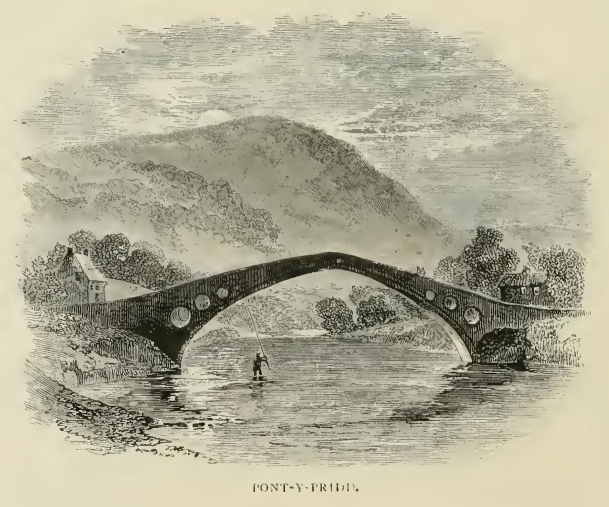
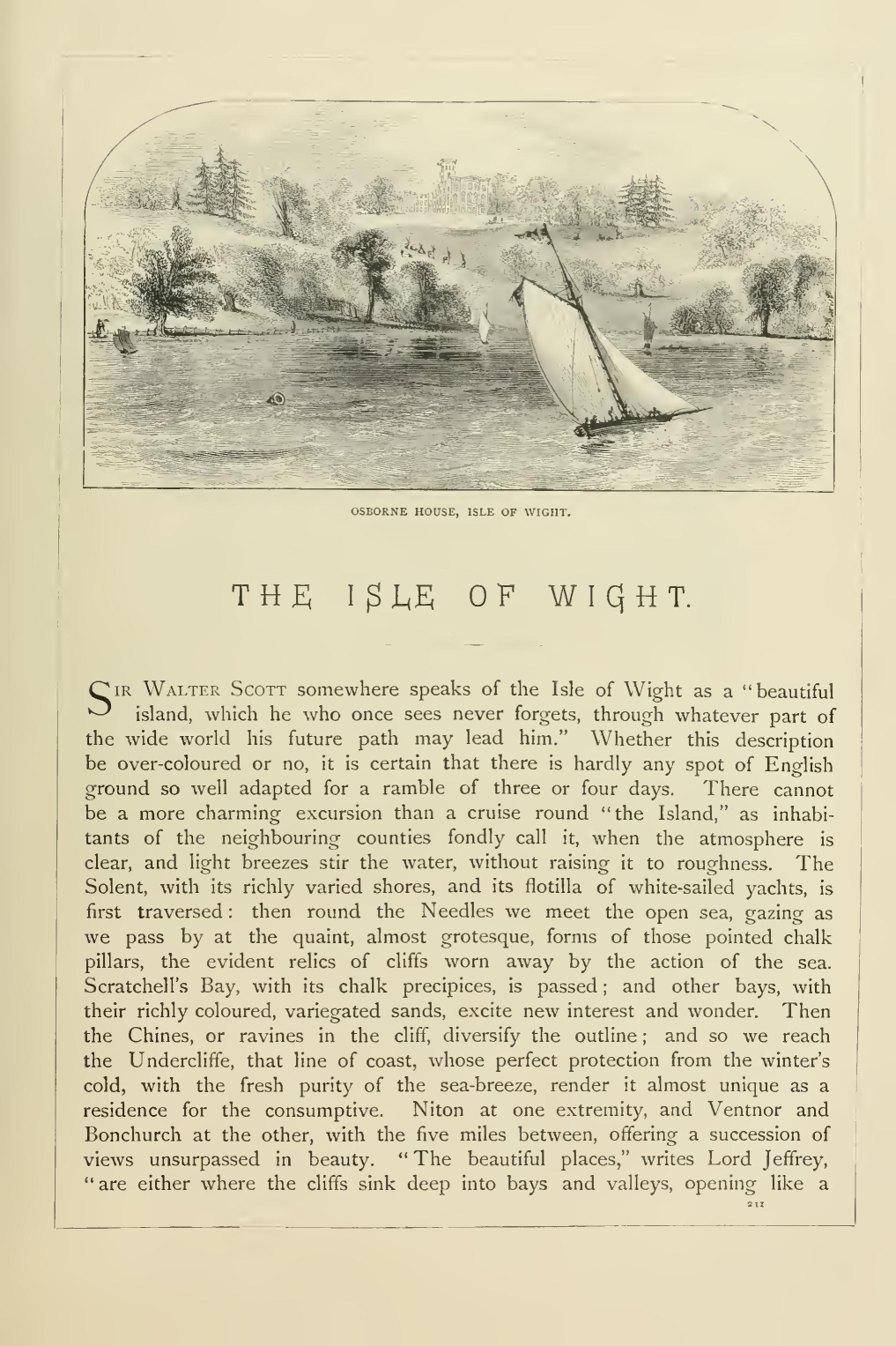
SIR Walter Scott somewhere speaks of the Isle of Wight as a "beautiful island, which he who once sees never forgets, through whatever part of the wide world his future path may lead him." Whether this description be over-coloured or no, it is certain that there is hardly any spot of English ground so well adapted for a ramble of three or four days. There cannot be a more charming excursion than a cruise round "the Island," as inhabitants of the neighbouring counties fondly call it, when the atmosphere is clear, and light breezes stir the water, without raising it to roughness. The Solent, with its richly varied shores, and its flotilla of white-sailed yachts, is first traversed: then round the Needles we meet the open sea, gazing as we pass by at the quaint, almost grotesque, forms of those pointed chalk pillars, the evident relics of cliffs worn away by the action of the sea. Scratchell's Bay, with its chalk precipices, is passed; and other bays, with their richly coloured, variegated sands, excite new interest and wonder. Then the Chines, or ravines in the cliff, diversify the outline; and so we reach the Undercliffe, that line of coast, whose perfect protection from the winter's cold, with the fresh purity of the sea-breeze, render it almost unique as a residence for the consumptive. Niton at one extremity, and Ventnor and Bonchurch at the other, with the five miles between, offering a succession of views unsurpassed in beauty. "The beautiful places," writes Lord Jeffrey, "are either where the cliffs sink deep into bays and valleys, opening like a theatre to the sun and the sea, or where there has been a terrace of low land formed at their feet, which stretches under the shelter of that enormous wall like a rich garden plot, all roughened over with masses of rock fallen in distant ages, and overshadowed with thickets of myrtle and rose and geranium, which all grow wild here in great luxuriance and profusion."
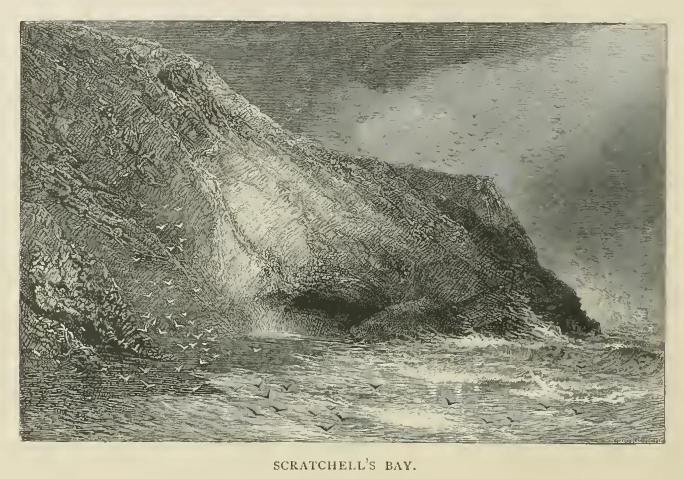
After leaving Bonchurch, Shanklin Chine, Sandown Bay, terminated on the north by the magnificent chalk headland called Culver Cliff, or the Cliff of the White Dove, terminate the most beautiful part of this little voyage. After rounding one or two more headlands, Ryde comes into sight, and loyal travellers begin to look out for Whipping-ham church tower, and the woods and palace of Osborne; soon after passing which Cowes is reached, and the excursion is over.
The interior of the island has many points of interest, but three or four days are sufficient for their exploration. A most interesting excursion is that to Newport and Carisbrooke Castle, so closely connected with the annals of Charles I. The visitor to Blackgang Chine will probably come to the conclusion that this and similar fissures in the chalk cliffs have been extolled beyond their deserts. There are combes in Devonshire, unknown to fame, far superior to either Blackgang or Shanklin, and at the latter especially, the elaborate artificiality of the whole scene is a little repellant, while the celebrated waterfall is commonly but a trickling rill. Blackgang is finer as a chasm, but the cascade is equally insignificant. The charm of "the Island" is, after all, in the climate, the colouring, and the glorious sea.
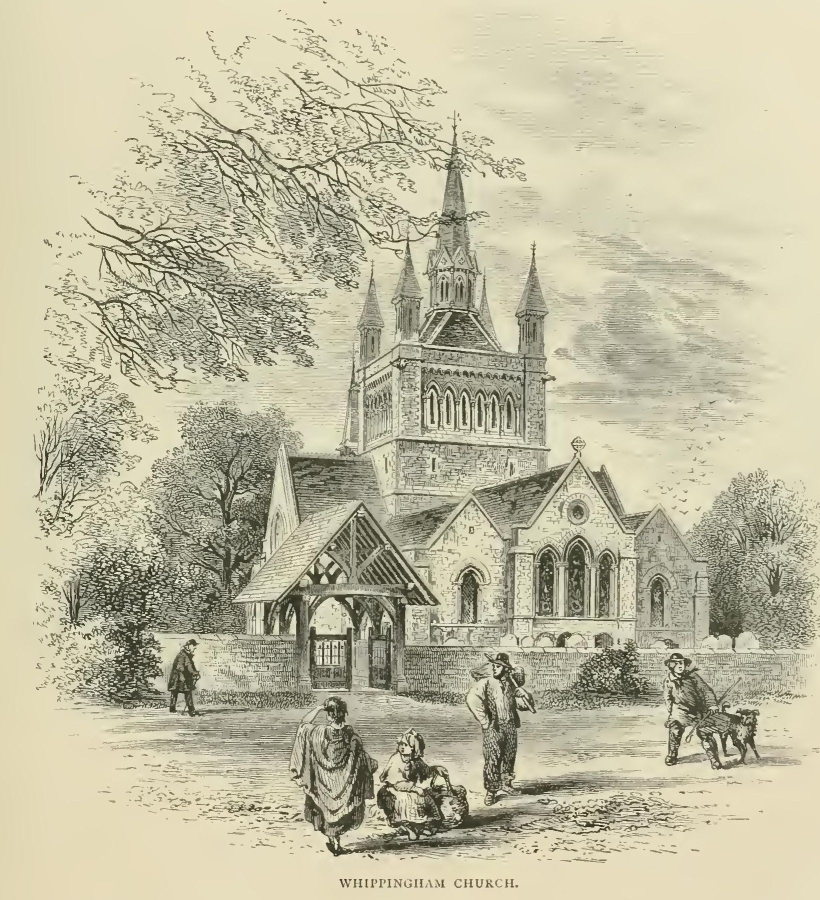
Few walks of richer or more luxuriant beauty can be found within the same compass than that from Blackgang Chine to Ventnor. First we reach the Sandrock Spring, a chalybeate fountain in a cliff; the water, it is said, contains alum and iron in an unexampled proportion. There is a cottage, hard by, displaying a few tumblers, but customers do not seem to be many. As a spa, Sandrock is too plainly a failure; and for real invigoration to health and spirits, we would rather try the pure ozone on the summit of St. Catherine's Cliff, than imbibe any quantity of the chalybeate. Let the visitor stay long and inhale the glorious sea-breeze. He will indeed have pure air below, that is, unless the breezes, as is their wont sometimes, are stirring the chalk in dust clouds—a kind of white simoom!
But at the best, the air of the Undercliffe is soft and languid, suggestive to the robust of delicate lungs; while yet those who are thus afflicted cannot be too thankful for a shelter where the atmosphere is as mild as it is pure, and the scene at every point, by land and sea, most beautiful.
We descend from St. Catherine's down to Niton, and thence pursue our way by Puckaster and Mirables Lawrence, where the church was once accounted the smallest in England (twelve by twenty feet in the interior), but is now enlarged by the addition of a chancel.
"Improvement" has been direfully at work since first we visited this little village and drank of the cool waters of "St. Lawrence's Well." The white, well-kept road is more level than the old picturesque path; instead of ivied cottages there are now shining villas with green blinds, walls for hedgerows, and, worst of all, the gushing spring flows somewhere in an inclosure to which there seems no access. It is a pity to have thus modernised so rustic and lovely a spot. But the flowers are still there, perfuming the air; and the myrtles and the fuchsias are not shrubs, but trees, and the luxuriance of southern climes surrounds us. As we walk along we speculate on the convulsions of nature that have prepared for us this little paradise. The undulating ground at our feet is evidently formed of vast masses of chalk and clay, which, at former periods, have broken bodily from the face of the cliff, slipped forward, and sunk down. The surface, disintegrated by aqueous and atmospheric action, has formed a kind of irregular terrace, the soil of which is most favourable to vegetation. The ground is now firm, the process of disintegration from above seems almost arrested; but there are even yet memories of landslips on a large scale, of which the traces are still visible.
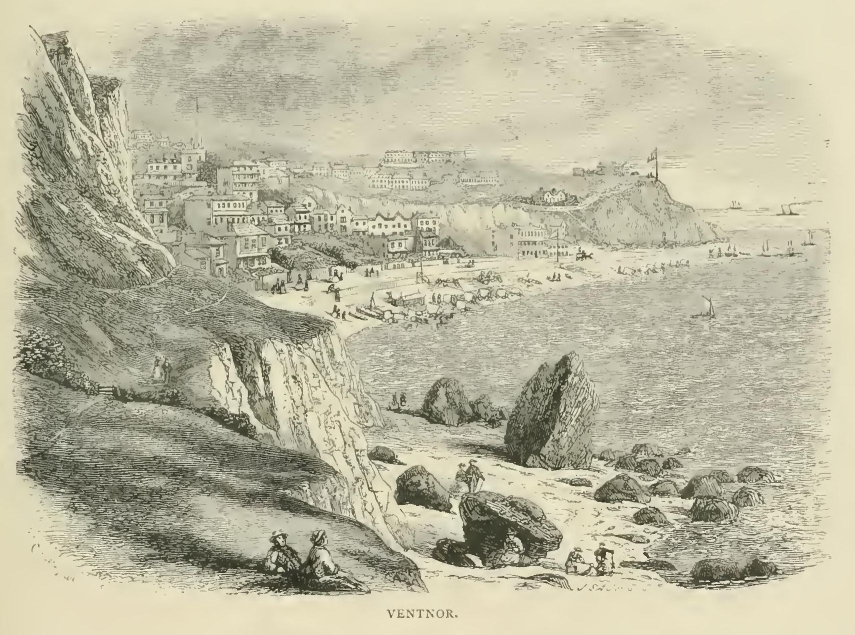
There is one walk in the island which no tolerable pedestrian should omit—that from Newport to Freshwater, or Alum Bay. Leaving the main road at Carisbrooke, a footpath leads upwards through fields richly cultivated and gay with wild flowers. The open down which forms the backbone of the island is soon reached. Keeping along the ridge the tourist will for some miles enjoy a scene almost unique in its beauty. The soft delicate curves and undulations which characterise the chalk downs, and which the unobservant traveller so often overlooks, may be seen in perfection. Nestling in many a sheltered nook are farm-houses, hamlets, and churches, embosomed in trees. Patches of fern, gorse, and heather diversify the landscape. And far below, on either side, is the sea—on the right hand the Solent, on the left the English Channel. After a while Freshwater comes into view, with its | line of cliffs rising sheer from the waves, and about half-a-mile inland the sheltered nook which has been made a classic spot as the home of the Poet Laureate. His description of it will be familiar to many readers.
"Where, far from smoke and noise of town,
I watch the twilight falling brown
All round a careless ordered garden.
Close to the ridge of a noble down.
You'll have no scandal while you dine,
But honest talk and wholesome wine,
And only hear the magpie gossip
Garrulous under a roof of pine.
For groves of pine on either hand,
To break the blast of winter, stand;
And further on, the hoary Channel
Tumbles a breaker on chalk and sand."
A couple of miles more and we reach Alum Bay and the Needles, spoken of on a preceding page.
Half a century ago few contributions to our religious literature were more widely and deservedly popular than Legh Richmond's "short and simple annals of the poor." Though of late years they have lost something of their popularity, yet many visitors to the island make a pilgrimage to Brading, with which the name of the devout author is inseparably connected. The grave of little Jane, the Young Cottager, is in the churchyard here: that of the "Dairyman's Daughter," Elizabeth Vallbridge, is at Arreton, three or four miles away towards the interior.
Here for the present our rambles must end.
It is impossible to retrace them without feeling how very beautiful England is. Some of her beauties are little known. Others are not appreciated as they deserve. Many an obscure and unvisited nook has a loveliness or a grandeur or a picturesqueness beyond that of the most famous show-places. But the glory of our island is that so many of its loveliest spots are associated with the memory of great names and noble deeds. The glory of England is in its people; but its people may well, in turn, exult and give thanks to God that He has given them so fair and splendid a home.
End of Project Gutenberg's English Pictures, by Samuel Manning and S. G. Green
*** END OF THIS PROJECT GUTENBERG EBOOK ENGLISH PICTURES ***
***** This file should be named 45065-h.htm or 45065-h.zip *****
This and all associated files of various formats will be found in:
http://www.gutenberg.org/4/5/0/6/45065/
Produced by David Widger from page images generously
provided by The Internet Archive
Updated editions will replace the previous one--the old editions
will be renamed.
Creating the works from public domain print editions means that no
one owns a United States copyright in these works, so the Foundation
(and you!) can copy and distribute it in the United States without
permission and without paying copyright royalties. Special rules,
set forth in the General Terms of Use part of this license, apply to
copying and distributing Project Gutenberg-tm electronic works to
protect the PROJECT GUTENBERG-tm concept and trademark. Project
Gutenberg is a registered trademark, and may not be used if you
charge for the eBooks, unless you receive specific permission. If you
do not charge anything for copies of this eBook, complying with the
rules is very easy. You may use this eBook for nearly any purpose
such as creation of derivative works, reports, performances and
research. They may be modified and printed and given away--you may do
practically ANYTHING with public domain eBooks. Redistribution is
subject to the trademark license, especially commercial
redistribution.
*** START: FULL LICENSE ***
THE FULL PROJECT GUTENBERG LICENSE
PLEASE READ THIS BEFORE YOU DISTRIBUTE OR USE THIS WORK
To protect the Project Gutenberg-tm mission of promoting the free
distribution of electronic works, by using or distributing this work
(or any other work associated in any way with the phrase "Project
Gutenberg"), you agree to comply with all the terms of the Full Project
Gutenberg-tm License available with this file or online at
www.gutenberg.org/license.
Section 1. General Terms of Use and Redistributing Project Gutenberg-tm
electronic works
1.A. By reading or using any part of this Project Gutenberg-tm
electronic work, you indicate that you have read, understand, agree to
and accept all the terms of this license and intellectual property
(trademark/copyright) agreement. If you do not agree to abide by all
the terms of this agreement, you must cease using and return or destroy
all copies of Project Gutenberg-tm electronic works in your possession.
If you paid a fee for obtaining a copy of or access to a Project
Gutenberg-tm electronic work and you do not agree to be bound by the
terms of this agreement, you may obtain a refund from the person or
entity to whom you paid the fee as set forth in paragraph 1.E.8.
1.B. "Project Gutenberg" is a registered trademark. It may only be
used on or associated in any way with an electronic work by people who
agree to be bound by the terms of this agreement. There are a few
things that you can do with most Project Gutenberg-tm electronic works
even without complying with the full terms of this agreement. See
paragraph 1.C below. There are a lot of things you can do with Project
Gutenberg-tm electronic works if you follow the terms of this agreement
and help preserve free future access to Project Gutenberg-tm electronic
works. See paragraph 1.E below.
1.C. The Project Gutenberg Literary Archive Foundation ("the Foundation"
or PGLAF), owns a compilation copyright in the collection of Project
Gutenberg-tm electronic works. Nearly all the individual works in the
collection are in the public domain in the United States. If an
individual work is in the public domain in the United States and you are
located in the United States, we do not claim a right to prevent you from
copying, distributing, performing, displaying or creating derivative
works based on the work as long as all references to Project Gutenberg
are removed. Of course, we hope that you will support the Project
Gutenberg-tm mission of promoting free access to electronic works by
freely sharing Project Gutenberg-tm works in compliance with the terms of
this agreement for keeping the Project Gutenberg-tm name associated with
the work. You can easily comply with the terms of this agreement by
keeping this work in the same format with its attached full Project
Gutenberg-tm License when you share it without charge with others.
1.D. The copyright laws of the place where you are located also govern
what you can do with this work. Copyright laws in most countries are in
a constant state of change. If you are outside the United States, check
the laws of your country in addition to the terms of this agreement
before downloading, copying, displaying, performing, distributing or
creating derivative works based on this work or any other Project
Gutenberg-tm work. The Foundation makes no representations concerning
the copyright status of any work in any country outside the United
States.
1.E. Unless you have removed all references to Project Gutenberg:
1.E.1. The following sentence, with active links to, or other immediate
access to, the full Project Gutenberg-tm License must appear prominently
whenever any copy of a Project Gutenberg-tm work (any work on which the
phrase "Project Gutenberg" appears, or with which the phrase "Project
Gutenberg" is associated) is accessed, displayed, performed, viewed,
copied or distributed:
This eBook is for the use of anyone anywhere at no cost and with
almost no restrictions whatsoever. You may copy it, give it away or
re-use it under the terms of the Project Gutenberg License included
with this eBook or online at www.gutenberg.org
1.E.2. If an individual Project Gutenberg-tm electronic work is derived
from the public domain (does not contain a notice indicating that it is
posted with permission of the copyright holder), the work can be copied
and distributed to anyone in the United States without paying any fees
or charges. If you are redistributing or providing access to a work
with the phrase "Project Gutenberg" associated with or appearing on the
work, you must comply either with the requirements of paragraphs 1.E.1
through 1.E.7 or obtain permission for the use of the work and the
Project Gutenberg-tm trademark as set forth in paragraphs 1.E.8 or
1.E.9.
1.E.3. If an individual Project Gutenberg-tm electronic work is posted
with the permission of the copyright holder, your use and distribution
must comply with both paragraphs 1.E.1 through 1.E.7 and any additional
terms imposed by the copyright holder. Additional terms will be linked
to the Project Gutenberg-tm License for all works posted with the
permission of the copyright holder found at the beginning of this work.
1.E.4. Do not unlink or detach or remove the full Project Gutenberg-tm
License terms from this work, or any files containing a part of this
work or any other work associated with Project Gutenberg-tm.
1.E.5. Do not copy, display, perform, distribute or redistribute this
electronic work, or any part of this electronic work, without
prominently displaying the sentence set forth in paragraph 1.E.1 with
active links or immediate access to the full terms of the Project
Gutenberg-tm License.
1.E.6. You may convert to and distribute this work in any binary,
compressed, marked up, nonproprietary or proprietary form, including any
word processing or hypertext form. However, if you provide access to or
distribute copies of a Project Gutenberg-tm work in a format other than
"Plain Vanilla ASCII" or other format used in the official version
posted on the official Project Gutenberg-tm web site (www.gutenberg.org),
you must, at no additional cost, fee or expense to the user, provide a
copy, a means of exporting a copy, or a means of obtaining a copy upon
request, of the work in its original "Plain Vanilla ASCII" or other
form. Any alternate format must include the full Project Gutenberg-tm
License as specified in paragraph 1.E.1.
1.E.7. Do not charge a fee for access to, viewing, displaying,
performing, copying or distributing any Project Gutenberg-tm works
unless you comply with paragraph 1.E.8 or 1.E.9.
1.E.8. You may charge a reasonable fee for copies of or providing
access to or distributing Project Gutenberg-tm electronic works provided
that
- You pay a royalty fee of 20% of the gross profits you derive from
the use of Project Gutenberg-tm works calculated using the method
you already use to calculate your applicable taxes. The fee is
owed to the owner of the Project Gutenberg-tm trademark, but he
has agreed to donate royalties under this paragraph to the
Project Gutenberg Literary Archive Foundation. Royalty payments
must be paid within 60 days following each date on which you
prepare (or are legally required to prepare) your periodic tax
returns. Royalty payments should be clearly marked as such and
sent to the Project Gutenberg Literary Archive Foundation at the
address specified in Section 4, "Information about donations to
the Project Gutenberg Literary Archive Foundation."
- You provide a full refund of any money paid by a user who notifies
you in writing (or by e-mail) within 30 days of receipt that s/he
does not agree to the terms of the full Project Gutenberg-tm
License. You must require such a user to return or
destroy all copies of the works possessed in a physical medium
and discontinue all use of and all access to other copies of
Project Gutenberg-tm works.
- You provide, in accordance with paragraph 1.F.3, a full refund of any
money paid for a work or a replacement copy, if a defect in the
electronic work is discovered and reported to you within 90 days
of receipt of the work.
- You comply with all other terms of this agreement for free
distribution of Project Gutenberg-tm works.
1.E.9. If you wish to charge a fee or distribute a Project Gutenberg-tm
electronic work or group of works on different terms than are set
forth in this agreement, you must obtain permission in writing from
both the Project Gutenberg Literary Archive Foundation and Michael
Hart, the owner of the Project Gutenberg-tm trademark. Contact the
Foundation as set forth in Section 3 below.
1.F.
1.F.1. Project Gutenberg volunteers and employees expend considerable
effort to identify, do copyright research on, transcribe and proofread
public domain works in creating the Project Gutenberg-tm
collection. Despite these efforts, Project Gutenberg-tm electronic
works, and the medium on which they may be stored, may contain
"Defects," such as, but not limited to, incomplete, inaccurate or
corrupt data, transcription errors, a copyright or other intellectual
property infringement, a defective or damaged disk or other medium, a
computer virus, or computer codes that damage or cannot be read by
your equipment.
1.F.2. LIMITED WARRANTY, DISCLAIMER OF DAMAGES - Except for the "Right
of Replacement or Refund" described in paragraph 1.F.3, the Project
Gutenberg Literary Archive Foundation, the owner of the Project
Gutenberg-tm trademark, and any other party distributing a Project
Gutenberg-tm electronic work under this agreement, disclaim all
liability to you for damages, costs and expenses, including legal
fees. YOU AGREE THAT YOU HAVE NO REMEDIES FOR NEGLIGENCE, STRICT
LIABILITY, BREACH OF WARRANTY OR BREACH OF CONTRACT EXCEPT THOSE
PROVIDED IN PARAGRAPH 1.F.3. YOU AGREE THAT THE FOUNDATION, THE
TRADEMARK OWNER, AND ANY DISTRIBUTOR UNDER THIS AGREEMENT WILL NOT BE
LIABLE TO YOU FOR ACTUAL, DIRECT, INDIRECT, CONSEQUENTIAL, PUNITIVE OR
INCIDENTAL DAMAGES EVEN IF YOU GIVE NOTICE OF THE POSSIBILITY OF SUCH
DAMAGE.
1.F.3. LIMITED RIGHT OF REPLACEMENT OR REFUND - If you discover a
defect in this electronic work within 90 days of receiving it, you can
receive a refund of the money (if any) you paid for it by sending a
written explanation to the person you received the work from. If you
received the work on a physical medium, you must return the medium with
your written explanation. The person or entity that provided you with
the defective work may elect to provide a replacement copy in lieu of a
refund. If you received the work electronically, the person or entity
providing it to you may choose to give you a second opportunity to
receive the work electronically in lieu of a refund. If the second copy
is also defective, you may demand a refund in writing without further
opportunities to fix the problem.
1.F.4. Except for the limited right of replacement or refund set forth
in paragraph 1.F.3, this work is provided to you 'AS-IS', WITH NO OTHER
WARRANTIES OF ANY KIND, EXPRESS OR IMPLIED, INCLUDING BUT NOT LIMITED TO
WARRANTIES OF MERCHANTABILITY OR FITNESS FOR ANY PURPOSE.
1.F.5. Some states do not allow disclaimers of certain implied
warranties or the exclusion or limitation of certain types of damages.
If any disclaimer or limitation set forth in this agreement violates the
law of the state applicable to this agreement, the agreement shall be
interpreted to make the maximum disclaimer or limitation permitted by
the applicable state law. The invalidity or unenforceability of any
provision of this agreement shall not void the remaining provisions.
1.F.6. INDEMNITY - You agree to indemnify and hold the Foundation, the
trademark owner, any agent or employee of the Foundation, anyone
providing copies of Project Gutenberg-tm electronic works in accordance
with this agreement, and any volunteers associated with the production,
promotion and distribution of Project Gutenberg-tm electronic works,
harmless from all liability, costs and expenses, including legal fees,
that arise directly or indirectly from any of the following which you do
or cause to occur: (a) distribution of this or any Project Gutenberg-tm
work, (b) alteration, modification, or additions or deletions to any
Project Gutenberg-tm work, and (c) any Defect you cause.
Section 2. Information about the Mission of Project Gutenberg-tm
Project Gutenberg-tm is synonymous with the free distribution of
electronic works in formats readable by the widest variety of computers
including obsolete, old, middle-aged and new computers. It exists
because of the efforts of hundreds of volunteers and donations from
people in all walks of life.
Volunteers and financial support to provide volunteers with the
assistance they need are critical to reaching Project Gutenberg-tm's
goals and ensuring that the Project Gutenberg-tm collection will
remain freely available for generations to come. In 2001, the Project
Gutenberg Literary Archive Foundation was created to provide a secure
and permanent future for Project Gutenberg-tm and future generations.
To learn more about the Project Gutenberg Literary Archive Foundation
and how your efforts and donations can help, see Sections 3 and 4
and the Foundation information page at www.gutenberg.org
Section 3. Information about the Project Gutenberg Literary Archive
Foundation
The Project Gutenberg Literary Archive Foundation is a non profit
501(c)(3) educational corporation organized under the laws of the
state of Mississippi and granted tax exempt status by the Internal
Revenue Service. The Foundation's EIN or federal tax identification
number is 64-6221541. Contributions to the Project Gutenberg
Literary Archive Foundation are tax deductible to the full extent
permitted by U.S. federal laws and your state's laws.
The Foundation's principal office is located at 4557 Melan Dr. S.
Fairbanks, AK, 99712., but its volunteers and employees are scattered
throughout numerous locations. Its business office is located at 809
North 1500 West, Salt Lake City, UT 84116, (801) 596-1887. Email
contact links and up to date contact information can be found at the
Foundation's web site and official page at www.gutenberg.org/contact
For additional contact information:
Dr. Gregory B. Newby
Chief Executive and Director
gbnewby@pglaf.org
Section 4. Information about Donations to the Project Gutenberg
Literary Archive Foundation
Project Gutenberg-tm depends upon and cannot survive without wide
spread public support and donations to carry out its mission of
increasing the number of public domain and licensed works that can be
freely distributed in machine readable form accessible by the widest
array of equipment including outdated equipment. Many small donations
($1 to $5,000) are particularly important to maintaining tax exempt
status with the IRS.
The Foundation is committed to complying with the laws regulating
charities and charitable donations in all 50 states of the United
States. Compliance requirements are not uniform and it takes a
considerable effort, much paperwork and many fees to meet and keep up
with these requirements. We do not solicit donations in locations
where we have not received written confirmation of compliance. To
SEND DONATIONS or determine the status of compliance for any
particular state visit www.gutenberg.org/donate
While we cannot and do not solicit contributions from states where we
have not met the solicitation requirements, we know of no prohibition
against accepting unsolicited donations from donors in such states who
approach us with offers to donate.
International donations are gratefully accepted, but we cannot make
any statements concerning tax treatment of donations received from
outside the United States. U.S. laws alone swamp our small staff.
Please check the Project Gutenberg Web pages for current donation
methods and addresses. Donations are accepted in a number of other
ways including checks, online payments and credit card donations.
To donate, please visit: www.gutenberg.org/donate
Section 5. General Information About Project Gutenberg-tm electronic
works.
Professor Michael S. Hart was the originator of the Project Gutenberg-tm
concept of a library of electronic works that could be freely shared
with anyone. For forty years, he produced and distributed Project
Gutenberg-tm eBooks with only a loose network of volunteer support.
Project Gutenberg-tm eBooks are often created from several printed
editions, all of which are confirmed as Public Domain in the U.S.
unless a copyright notice is included. Thus, we do not necessarily
keep eBooks in compliance with any particular paper edition.
Most people start at our Web site which has the main PG search facility:
www.gutenberg.org
This Web site includes information about Project Gutenberg-tm,
including how to make donations to the Project Gutenberg Literary
Archive Foundation, how to help produce our new eBooks, and how to
subscribe to our email newsletter to hear about new eBooks.